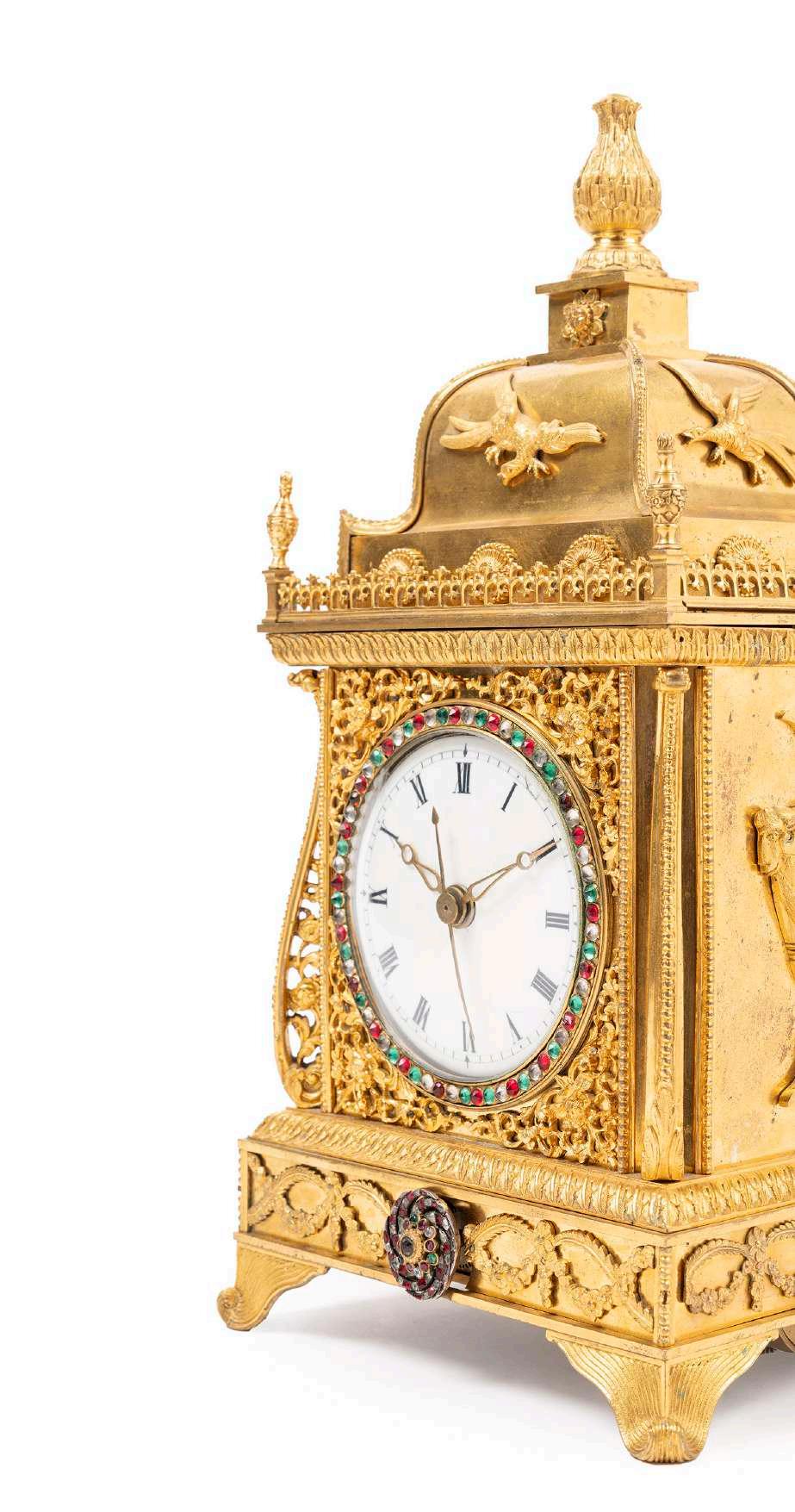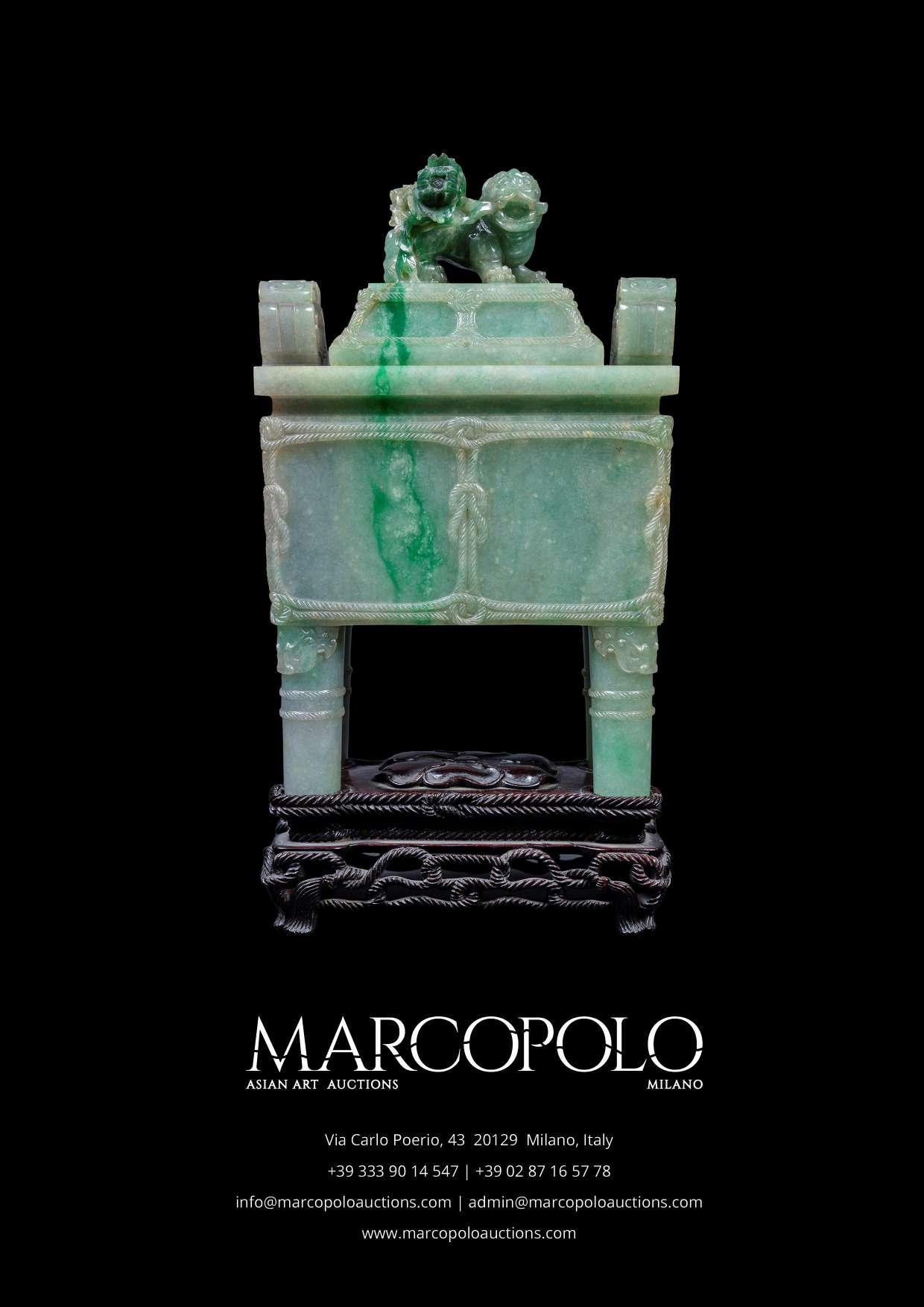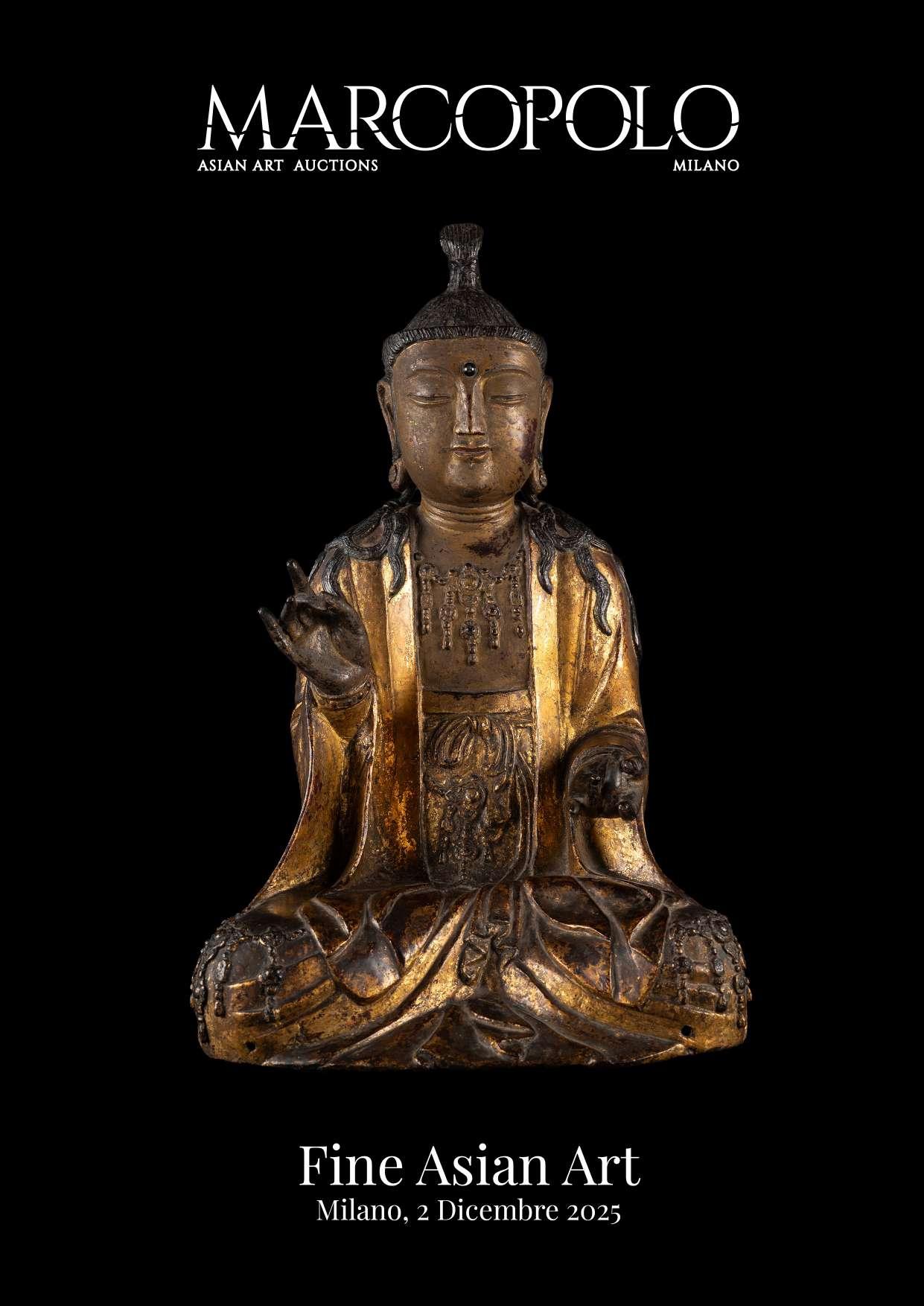

Fine Asian Art
2 Dicembre 2025, Milano


IMPORTANT NOTICE TO BUYERS
Deposit and other pre-registration requirements
Marcopolo Asian Art requires an amount of €5.000 as a deposit to authorise you to bid on lots. Marcopolo Asian Art also reserves the right to request higher and cumulative amounts for lots marked in the catalogue as PREMIUM lots, lots for which only telephone and room bids will be accepted. Furthermore, the auction house may, at its discretion, request additional guarantees for one or more lots. Therefore, the customer is requested to contact the auction house at least 4 days before the auction date to allow for proper pre registration and to know the amount of the deposit to be paid, making sure that this amount arrives at least 3 working days before the sale.
It will not be possible for the auctioneer to obtain financial references on weekends or public holidays. The required deposit must be paid in Euro by bank transfer, credit/debit card payment or in the form of a pre-authorisation of € 5.000 in order to be accepted to participate in the auction after registration.
In the case of cash payments, amounts not exceeding € 5.000 will be accepted, in accordance with the regulations in force regarding cash circulation limits. The payment of the auction invoice, as stated in the conditions of sale, shall be made within 7 days from the date of the auction. If the customer has not paid the balance within this deadline or does not express an intention to pay their invoice otherwise, the auction house reserves the right to:
-charge the pre-authorisation made by credit card, made at the time of approval and registration for the auction, as the invoice balance (if the amount due is less than the authorised deposit) or as an advance to the invoice itself if the amount due is higher.
-withhold the bank deposit (in case of deposit payment by bank transfer) as partial or full invoice payment . In the latter case, the excess will be refunded.
In both cases, after a further 7 days, the auction house may cancel the sale and retain the entire deposit as a penalty for the failed sale, reserving all rights to open a dispute to recover the full amount due. The auctioneer shall not accept any objection to such handling of the unpaid amount.
In the event that a customer is not awarded a lot, Marcopolo Asian Art will re-issue a refund (subject to the right of set-off) for the amount of the deposit paid by the customer without interest within 3 business days from the date of the sale. Any exchange losses or fees associated with the refund will be borne by the customer.
For more information, please refer to the General Sales Conditions.
¤ Lots marked with this symbol are provided with a CITES appraisal or certification and may be subject to import and export restrictions under CITES regulations of certain non-EU countries.
INDICAZIONI IMPORTANTI PER I COMPRATORI
Condizioni di vendita
La Marcopolo Asian Art richiede un importo di € 5.000 a titolo di deposito cauzionale per autorizzare l’utente a presentare offerte suI lotti. La Marcopolo Asian Art si riserva inoltre di richiedere importi superiori e cumulativi per i lotti contrassegnati in catalogo come lotti PREMIUM, lotti per i quali saranno accettate soltanto offerte telefoniche e in sala. Inoltre la casa d’aste potrà, a sua discrezione, chiedere ulteriori garanzie per la partecipazione alla gara d’asta per uno o più lotti. Pertanto è richiesto al cliente di mettersi in contatto con la casa d’aste almeno 4 giorni prima della data d’asta per consentire una corretta pre-registrazione e per conoscere l’ammontare della somma da versare a titolo di deposito, premurandosi di fare arrivare tale cifra entro 3 giorni lavorativi prima della vendita.
Non sarà possibile per la casa d’asta ottenere referenze finanziarie durante i fine settimana o i giorni festivi. Il deposito richiesto dovrà essere versato in Euro tramite bonifico bancario, pagamento tramite carta di credito/debito o sotto forma di pre autorizzazione di € 5.000 per essere accettati a partecipare all’asta dopo la registrazione.
In caso di versamento in contanti si accettano importi non superiori a € 5.000 come previsto dalla normativa vigente in materia di limiti di circolazione del denaro contante. Il pagamento della fattura di aggiudicazione, come riportato nelle condizioni di vendita, dovrà avvenire entro 7 giorni dalla data dell’asta. Qualora il cliente non abbia effettuato il pagamento a saldo entro tale termine o non manifesti l’intenzione di pagare la propria fattura diversamente, la casa d’asta si riserva di:
-addebitare la pre-autorizzazione fatta con carta di credito, effettuata al momento dell’approvazione e registrazione all’asta, a titolo di saldo fattura (qualora l’importo dovuto sia inferiore al deposito autorizzato) o in acconto alla fattura stessa se l’importo dovuto fosse superiore.
-trattenere il deposito bancario (in caso di versamento del deposito con bonifico bancario) a titolo di pagamento fattura parziale o totale. In quest’ultimo caso verrà rimborsata la parte eccedente.
In entrambi i casi, trascorsi ulteriori 7 giorni, la casa d’asta potrà annullare la vendita e trattenere l’intero deposito cauzionale a titolo di penale per la mancata vendita riservandosi ogni diritto di aprire una controversia per il recupero dell’intera cifra dovuta. La casa d’aste non accetterà nessuna contestazione a tale gestione dell’impagato.
Nel caso in cui un cliente non sia aggiudicatario di un lotto, la Marcopolo Asian Art provvederà a riemettere rimborso (fatto salvo il diritto di compensazione) per l’importo del deposito versato dal cliente senza interessi entro 3 giorni lavorativi dalla data della vendita. Eventuali perdite di cambio o commissioni associate al rimborso saranno a carico del cliente.
Per altre informazioni si rimanda alle Condizioni Generali di vendita.
¤ I lotti contraddistinti da questo simbolo sono provvisti di perizia o di certificazione CITES e potrebbero essere soggetti a restrizioni di importazione ed esportazione a seguito della regolamentazione CITES di alcuni Paesi extra UE
马可波罗亚洲艺术中心要求您交纳5.000欧元的保证金,以授权您竞拍拍品。马可波罗亚洲艺术中心还保留对目录中标明为 “重要 “的拍 品要求更高保证金的权利,这些拍品只接受电话和现场竞价。
此外,拍卖商可酌情要求为一件或多件拍品提供额外的担保。
因此,请客户至少在拍卖日期前4天与拍卖行联系,以便进行适当的预先登记,并了解应支付的保证金数额,确保该数额不迟于拍卖前3个 工作日到达。
拍卖师不可能在周末或公共假期获得财务证明。客户在注册登记之后,必须通过银行转账、信用卡/借记卡付款或预授权形式以欧元支付 所需的 5.000 欧元保证金,才能参加正式拍卖。
在现金支付的情况下,将接受不超过5.000欧元的金额,这是现行的有关现金流通限额的规定。拍卖条件中规定的付款期限,得标买家应 在拍卖结束之日起7天内完成付款。如果客户没有在此期限内支付发票,或没有表达以其他方式支付发票的意向,拍卖行保留以下权利。收取在批准和登记参加拍卖时通过信用卡作出的预授金额,作为发票付款金额(如果应付金额低于授权的保证金),或作为发票本身的预 付款 (如果应付金额更高)。 -扣留银行押金(在通过银行转账支付押金的情况下)作为部分或全部发票付款。在后一种情况下,超出部 分将被退还。
在以上两种情况下,7天之后拍卖行有权决定处理办法,并保留全部保证金作为失败拍卖的惩罚,同时保留所有的权利来开 启争端,以收回 全部应付款项。拍卖行不接受对这种处理未付款项方式的异议。
如果客户未能成功出售拍品,Marcopolo亚洲艺术公司将在出售之日起的3个工作日内重新发放客户已付定金的退款(不影响抵销权), 不计利息。与退款有关的任何交换损失或费用将由客户承担。
欲了解更多信息,请参考一般销售条款和条件。
¤ 这些标有此符号的拍品附有CITES鉴定或认证,可能会受到某些非欧盟国家CITES法规的进出口限制。

Fine Asian Art
2 December 2025 - 11:00 CET
EXHIBITION
Thursday 27 November 10.00-18.00
Friday 28 November 10.00-18.00
Saturday 29 November 10.00-18.00
Sunday 30 November 10.00-18.00
Giovedì 27 Novembre 10.00-18.00
Venerdì 28 Novembre 10.00-18.00
Sabato 29 Novembre 10.00-18.00
Domenica 30 Novembre 10.00-18.00
11 月 27 日星期四 10.00-18.00
11 月 28 日星期五 10.00-18.00
11 月 29 日星期六 10.00-18.00
11 月 30 日星期日 10.00-18.00
The exhibition will be held at Marcopolo Asian Art in Milan, located at 43 Carlo Poerio Street (corner of Nino Bixio Street). The auction will be held in Milan at the Worldhotel Cristoforo Colombo, located at 3 Corso Buenos Aires.
L’esposizione si terrà presso i locali della Marcopolo Asian Art a Milano in via Carlo Poerio 43 (Angolo via Nino Bixio). L’asta si terrà a Milano presso il Worldhotel Cristoforo Colombo in Corso Buenos Aires 3
预展将在米兰的马可波罗亚洲艺术中心举行,地址:via Carlo Poerio 43(via Nino Bixio 拐角处) 拍卖会在米兰 Corso Buenos Aires 3 号 World hotel Cristoforo Colombo (哥伦布世界酒店)举行
CONDITION OF LOTS
Potential buyers are encouraged to inspect the objects during pre-sale exhibitions. For information only, Marcopolo Asian Art can provide a condition report. The absence of references to the condition of a lot in the catalogue description does not imply that the lot is free of defects or imperfections. Please refer to condition 4 of the General Conditions of Sale.
CONDIZIONE DEI LOTTI
I potenziali acquirenti sono incoraggiati a ispezionare gli oggetti durante le mostre pre-vendita. A titolo puramente indicativo, la Marcopolo Asian Art può fornire un condition report. L’assenza di riferimenti alle condizioni di un lotto nella descrizione del catalogo non implica che il lotto sia privo di difetti o di imperfezioni. Si prega di fare riferimento alla condizione 4 della Condizioni Generali di Vendita.
拍品状况
拍卖行郑重建议准买家于拍卖进行之前亲自检查及鉴定其有兴趣竞投之物品。Marcopolo Asian Art 可以提供状况报告,仅作为一种参 考。
目录描述中没有提及批次的条件并不意味着该批次没有缺陷或缺陷。 请参阅本目录中印刷的一般销售条件的条件 4。
Contacts
Davide Salvatore Chiara Chief Executive Officer ds.chiara@marcopoloauctions.com
Min Zhou Asia Market Development m.zhou@marcopoloauctions.com
Oriana Focaraccio Back Office info@marcopoloauctions.com
Veronica Maria Piras Social Media
Giulia Domeniconi Operations
For condition report conditionreport@marcopoloauctions.com
Carlo Santi Asian Art Director | Business Development c.santi@marcopoloauctions.com
Manfredi Rovella Business Development m.rovella@marcopoloauctions.com
Simone Andrea Chiara Bid Office
CATALOGUE
Matias Reyes
Graphic Designer | Webmaster m.reyes@graphics.marcopoloauctions.com
Alice Turchini Photographer
Federica Mungo Photo Assistant
Marcopolo Auctions - Asian Art Auctions Milano
Via Carlo Poerio, 43 20129 Milano, Italy
Tel +39 333 90 14 547
+39 02 87 165 778 www.marcopoloauctions.com
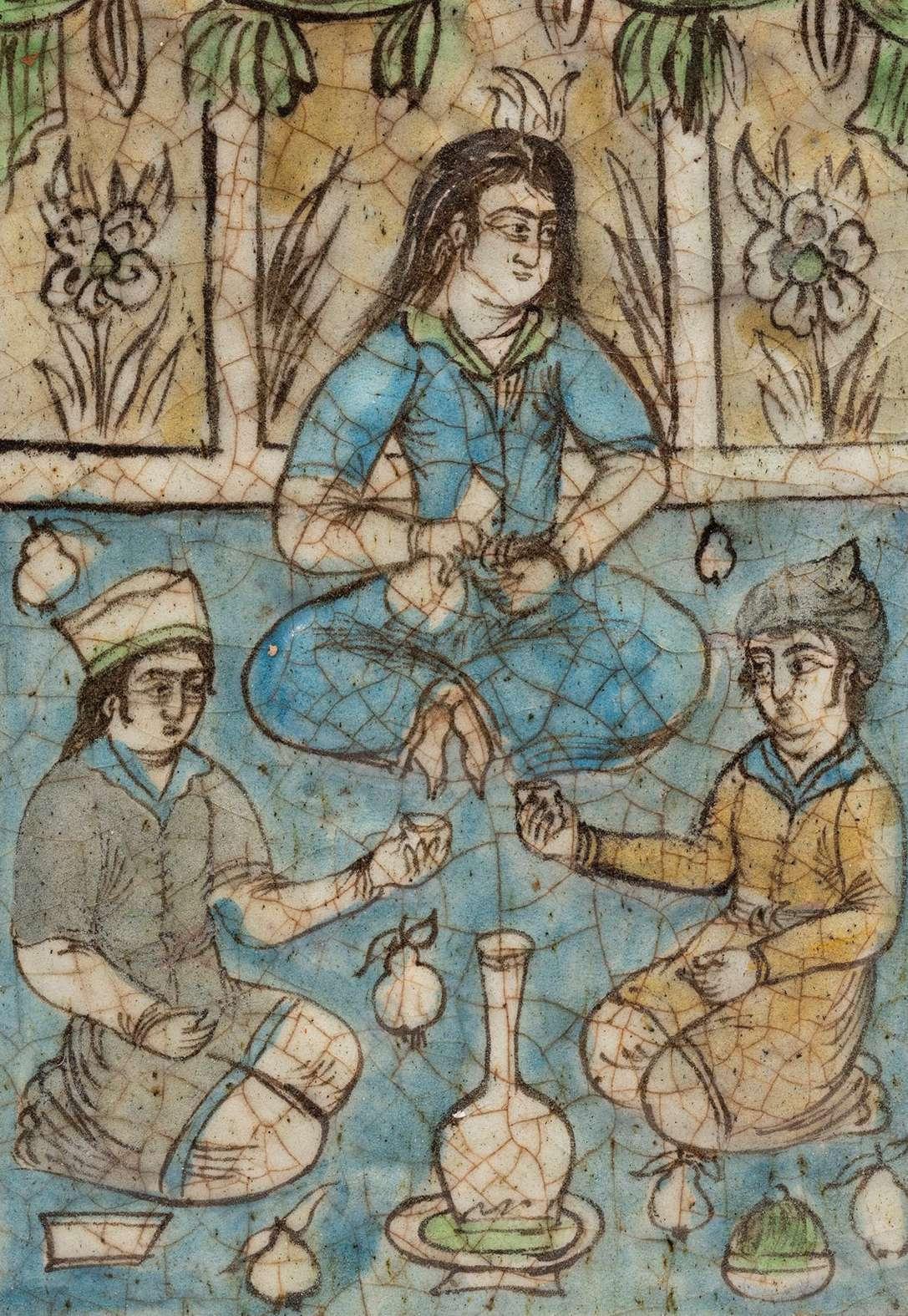
Departments
CHINESE
ART
info@chinese.marcopoloauctions.com
Carlo Santi
Head of the Chinese Art Department
c.santi@marcopoloauctions.com
William Arthur Martindale
Senior Specialist Chinese Jades and Stone Carvings
JAPANESE ART
info@japanese.marcopoloauctions.com
Andrea Mastromauro
Head of the Japanese Art Deparment
Filippo Comisi Senior Specialist Himalayan Art
INDIAN AND SOUTH EAST ASIAN ART
info@indian.marcopoloauctions.com
Renzo Freschi
Head of the Indian Art Department
ISLAMIC ART
info@islamic.marcopoloauctions.com
Aila Santi
Head of the Islamic Art Department
DECORATIVE ARTS WUNDERKAMMER
info@decorative.marcopoloauctions.com
Angelo D’Andrea
info@wunderkammer.marcopoloauctions.com
Head of the Decorative Arts Department Blerjan Gjergji
Head of the Wuderkammer Department
Evelina Scalia Department Assistant

First session
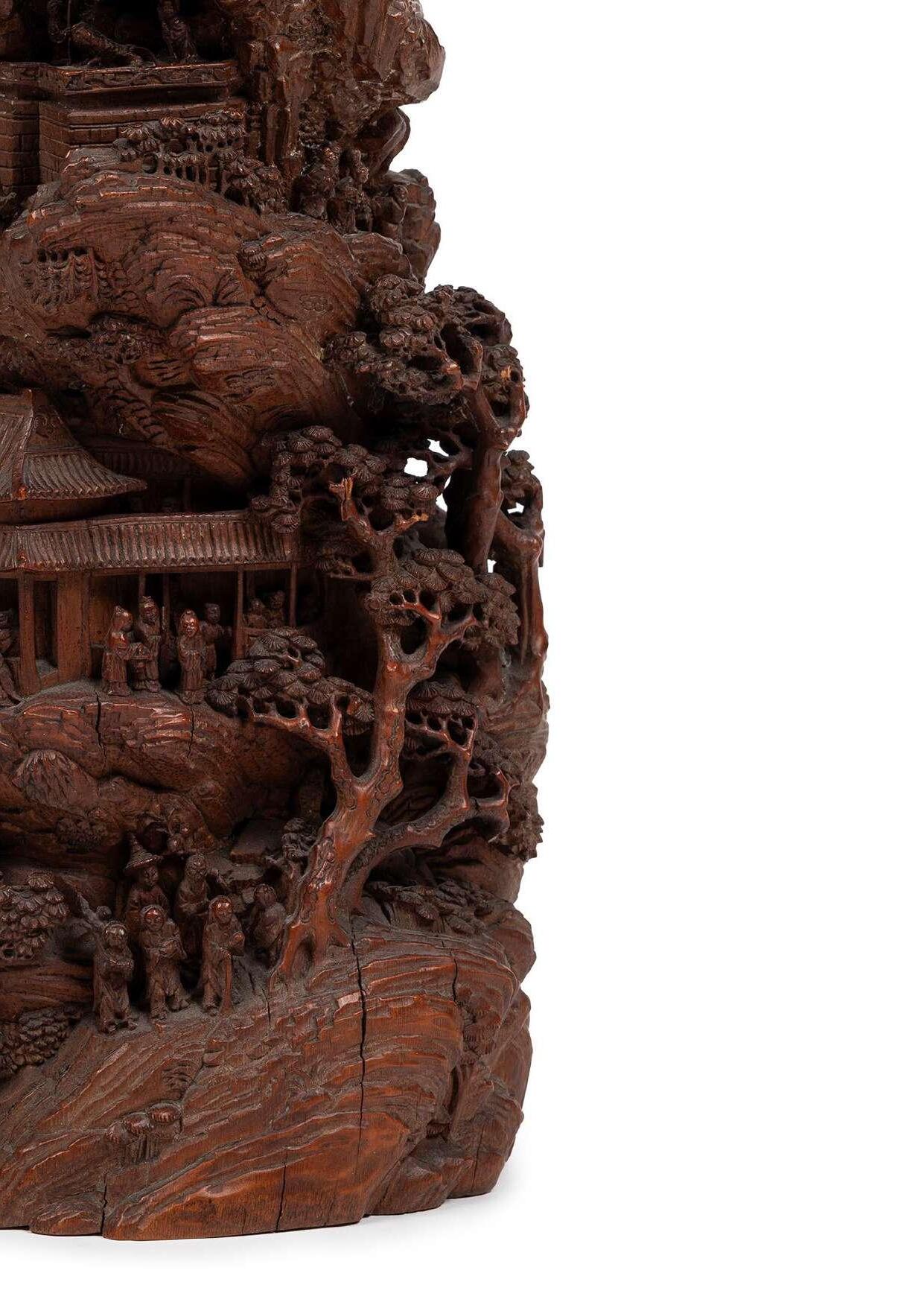
Chinese Art
Buddhist Art
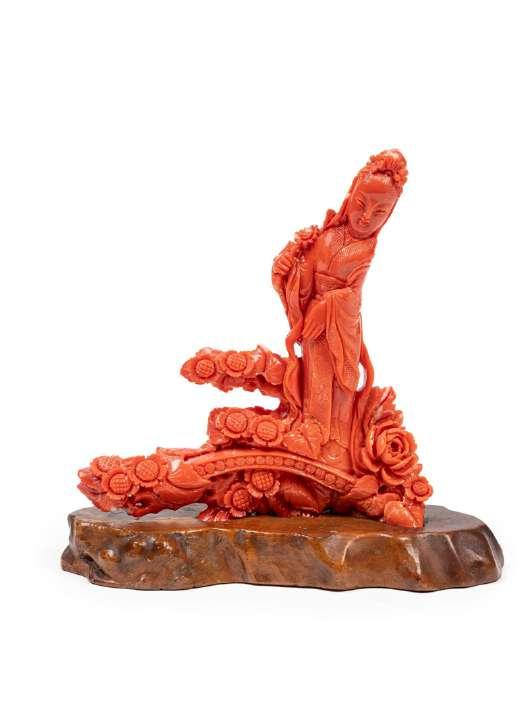

☼A CORAL SCULPTURE, China, early 20th century
h cm 14,5 x l cm 13,5
€ 2.000 / 2.500
It depicts an elegantly dressed lady walking on a bridge richly decorated with floral motifs. Total weight: 235 g.
☼FIGURA IN CORALLO ROSSO MOMO O CERASUOLO, Cina, inizio XX secolo
Raffigura una dama elegantemente vestita mentre passeggia su un ponte riccamente decorato con motivi floreali. Peso g 235.
20世纪 珊瑚雕刻摆件 重235 g
☼A RED CORAL SCULPTURE, China, early 20th century
h cm 4,5 x l cm 10
€ 1.000 / 1.500
Depicting three rodents playing among leaves and clusters of grapes. Weight: 173 g.
☼SCULTURA IN CORALLO ROSSO MOMO O CERASUOLO, Cina, inizio XX secolo
Raffigura tre roditori che giocano tra foglie e grappoli d’uva. Peso: 173 g.
20世纪 珊瑚雕摆件 重173克 1 2
☼A CORAL SCULPTURE, China, early 20th century
h cm 10 x l cm 12,5
€ 2.000 / 3.000
Finely carved, depicting three children holding flowering branches. Weight 149 g.
☼SCULTURA IN CORALLO MOMO O CERASUOLO, Cina, inizio XX secolo
Finemente intagliata, raffigurante tre bambini che reggono dei rami fioriti. Peso g 149.
☼A CARVED RED MOMO CORAL SCULPTURE, Japan, early 20th century
h cm 19
€ 1.000 / 1.500
It depicts two children embracing a flowering trunk adorned with Noh theater masks. Weight g 372.
☼SCULTURA IN CORALLO ROSSO MOMO O CERASUOLO, Giappone, inizio XX secolo
Raffigura due bambini che abbracciano un tronco fiorito, decorato con maschere del teatro Noh. Peso g 372. 民国
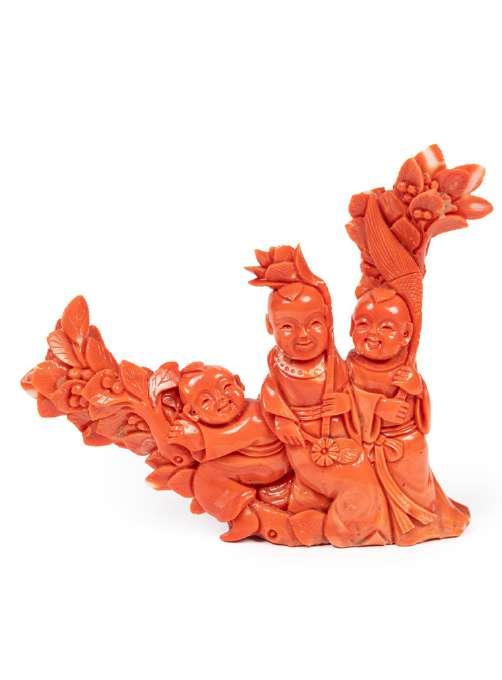
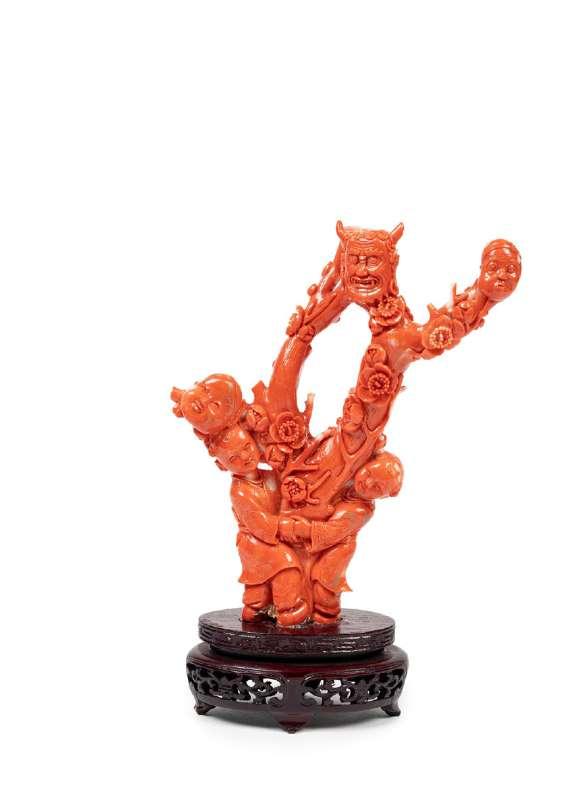

☼A MOMO CORAL SCULPTURE,
China, early 20th century
h cm 22,5
5 € 4.000 / 6.000
Finely carved, depicting a lady elegantly dressed with a refined hairstyle, holding a basket and a flowering staff in her hands. Total weight g 684.
☼SCULTURA IN CORALLO ROSSO MOMO O CERASUOLO, Cina, inizio XX secolo
Finemente scolpita, raffigura una dama elegantemente vestita con un’acconciatura raffinata, che regge tra le mani un cestino e un bastone fiorito. Peso tot. g 684.
20世纪 珊瑚雕仕女立像 总重684g

☼A LARGE RED MOMO CORAL SCULPTURE,
China, early 20th century
h cm 21 x l cm 29,5
6 € 6.000 / 10.000
Finely carved, it depicts a group of five elegantly dressed ladies in a floral landscape with small birds.
Weight 1010 g.
☼GRANDE SCULTURA IN CORALLO ROSSO MOMO O CERASUOLO, Cina, inizio XX secolo
Finemente intagliata, raffigura un gruppo di cinque dame elegantemente vestite in un paesaggio floreale con uccellini. Peso g 1010.
20世纪 珊瑚雕侍女摆件 重1010g.
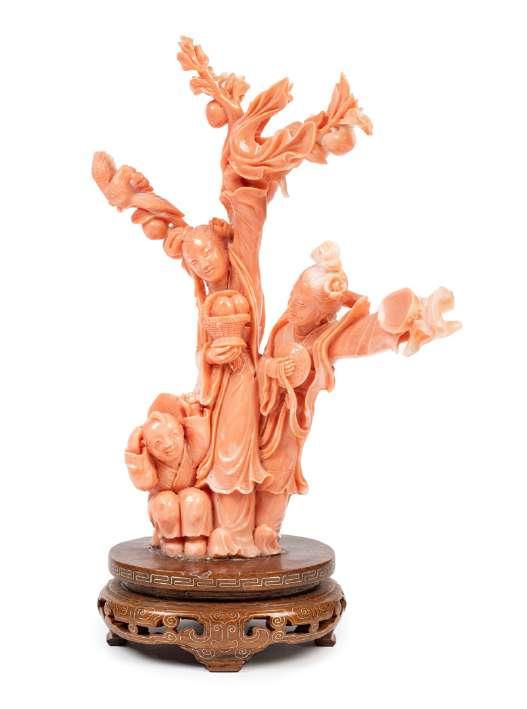

☼A CORAL SCULPTURE, China, early 20th century
h cm 20,5
€ 1.000 / 2.000
Carved depicting two elegantly dressed ladies holding a basket of fruit and musical instruments, accompanied by a crouching child. Total weight 573 g.
☼SCULTURA IN CORALLO, Cina, inizio XX secolo
Intagliata raffigurante due dame elegantemente vestite mentre sorreggono un cesto di frutta e strumenti musicali, accompagnate da un bambino accovacciato. Peso tot. 573 g.
20世纪 珊瑚雕人物摆件 总重573g
7 8
☼A MOMO CORAL SCULPTURE, China, early 20th century
h cm 17
€ 550 / 600
The figure depicts an elegantly dressed lady in a long gown, from which a rich floral motif adorned with small birds emanates. Weight: 502 g.
☼SCULTURA IN CORALLO ROSSO MOMO O CERASUOLO, Cina, inizio XX secolo
La figura rappresenta una dama elegantemente vestita con un lungo abito da cui si diparte un ricco motivo floreale arricchito da piccoli uccellini. Peso: 502 g.
20世纪 珊瑚雕刻仕女立像 重502g
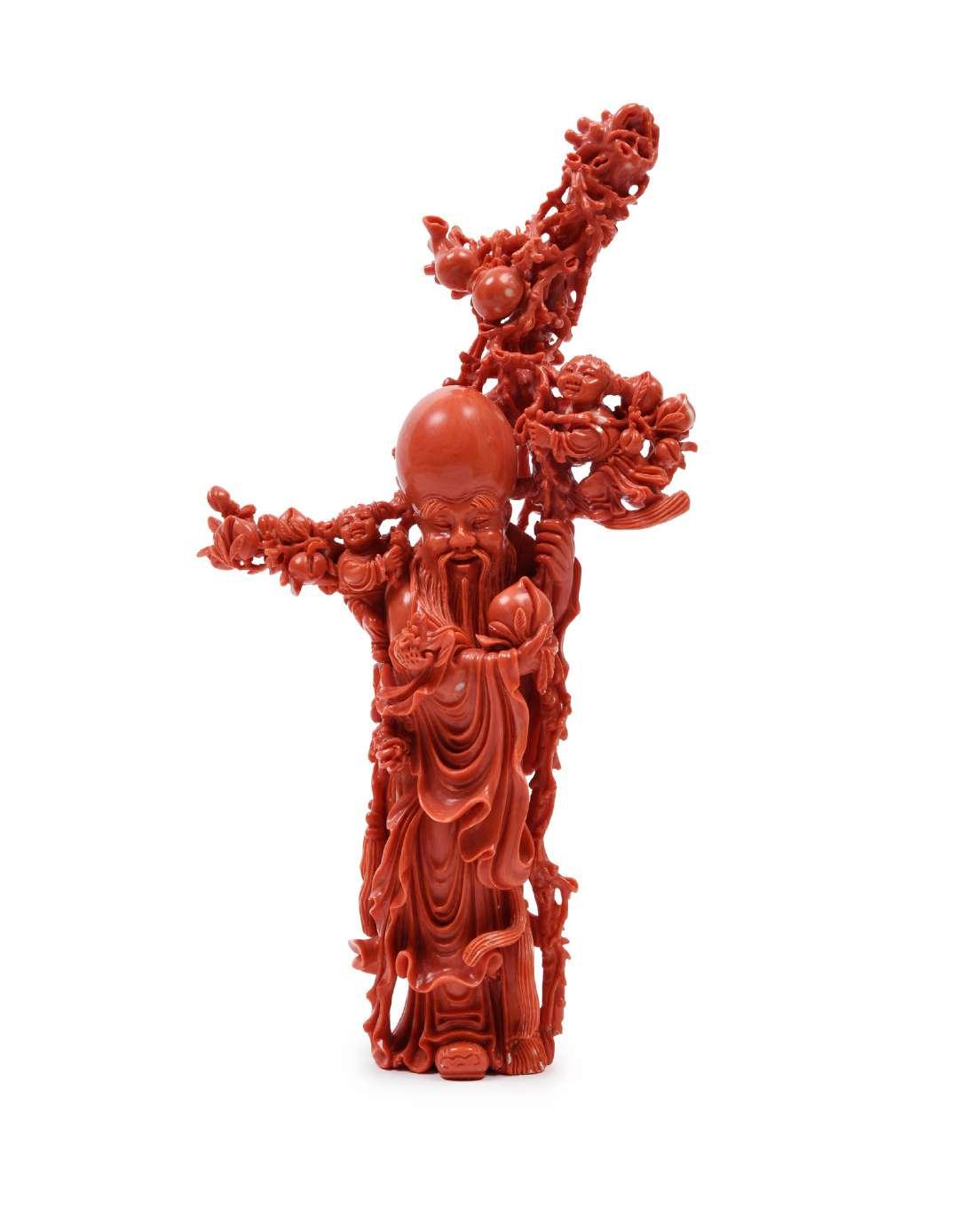
☼A LARGE
RED MOMO
CORAL SCULPTURE, China, late 19th / early 20th century
h cm 26,8
9 € 6.000 / 12.000
Finely carved, depicting Shoulao dressed in traditional robes, holding the peach, symbol of longevity, and a flowering staff adorned with a double-gourd flask and children playing among intricate floral motifs. Weight 732.
☼GRANDE FIGURA IN CORALLO ROSSO MOMO O CERASUOLO, Cina, fine XIX / inizio XX secolo
Finemente intagliata, raffigura Shoulao vestito con abiti tradizionali, nell’atto di reggere la pesca, simbolo di longevità, e un bastone fiorito ornato da una fiasca a doppia zucca e da bambini che giocano tra intricati motivi floreali. Peso g 732.

☼A RED MOMO CORAL FIGURE, China, late 19th / early 20th century
h cm 19,5
€ 2.000 / 4.000
Finely carved, depicting an elegantly dressed lady with her head adorned with a headdress decorated with shells, accompanied by three children holding musical instruments and a parasol. Weight 335 g.
☼FIGURA IN CORALLO ROSSO MOMO O CERASUOLO, Cina, fine XIX / inizio XX secolo
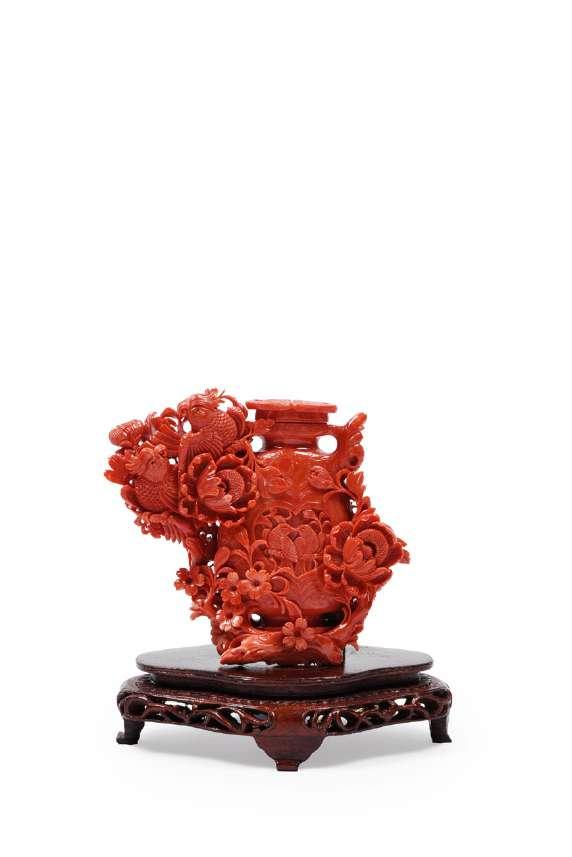
Finemente intagliata, raffigura una dama elegantemente vestita, con il capo ornato da un copricapo decorato con conchiglie, accompagnata da tre fanciulli che portano strumenti musicali e un parasole. Peso g 335.
19 / 20世纪 珊瑚雕刻仕女摆件 重 335 g
11
☼A RED MOMO CORAL CARVING, China, late 19th / early 20th century
h cm 11
€ 3.000 / 6.000
Well carved in the form of a vase with cover, finely carved and engraved, the body decorated with a reserve depicting two small birds, from which elegant floral motifs and two parrots emerge. Weight g 506.
☼INTAGLIO IN CORALLO ROSSO MOMO O CERASUOLO, Cina, fine XIX / inizio XX secolo
Ben scolpito a forma di vaso con coperchio, è finemente intagliato e inciso con il corpo decorato con una riserva raffigurante due uccellini, da cui si sviluppano eleganti motivi floreali e due pappagalli. Peso g 506.
19 / 20世纪 珊瑚雕刻花瓶摆件 重 506 g 10
☼AKA CORAL NECKLACE, Japan, early 20th century
l cm 41
€ 12.000 / 18.000
Irregular shaped amber snuff bottle with metal holder.
☼COLLANA IN CORALLO AKA, Giappone, inizio XX secolo
Weight: 207.50 g.
日本AKA珊瑚项链 重207.5g
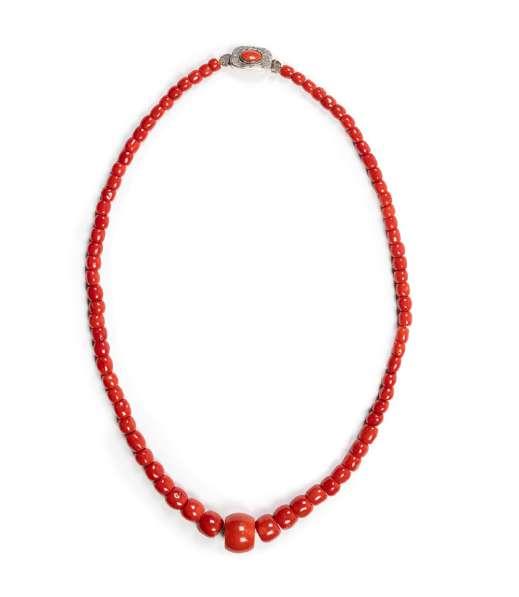
☼AKA CORAL NECKLACE, Japan, early 20th century
l cm 54,5
€ 4.500 / 5.000
Weight: 84.50 g.
☼COLLANA IN CORALLO AKA, Giappone, inizio XX secolo
Peso g 84,50.
日本AKA珊瑚项链 重84.5g

AN AMBER NECKLACE, China, early 20th century
d cm 21
€ 150 / 200
Weight g 62.
COLLANA IN AMBRA, Cina, inizio XX secolo
Peso g 62.
二十世纪初 蜜蜡项链
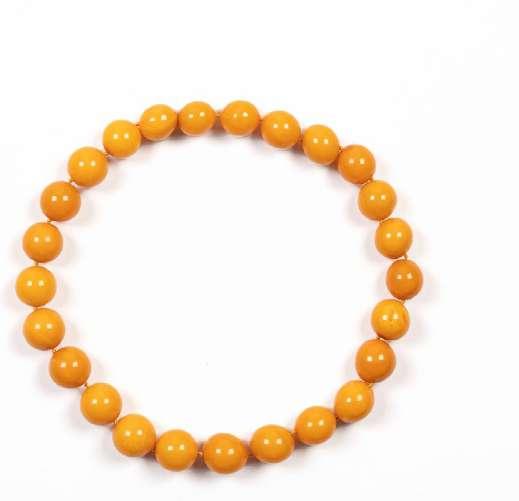
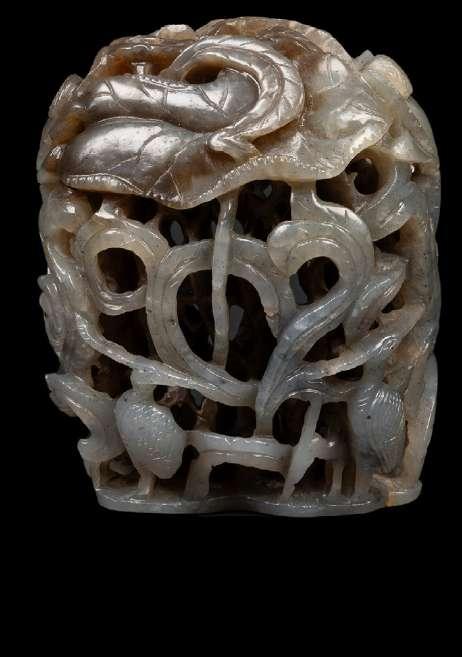
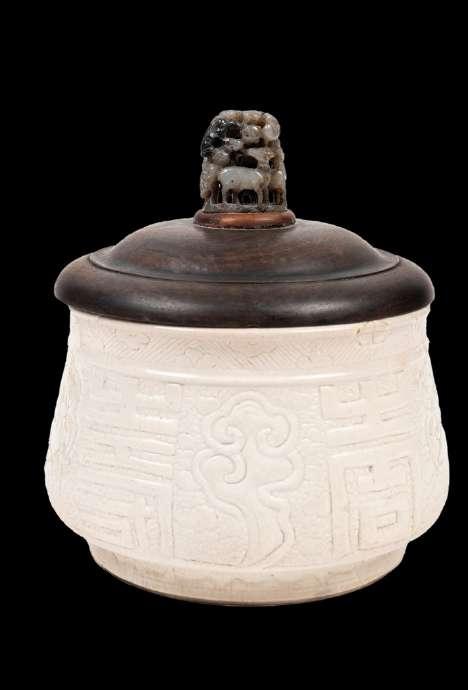
A CELADON JADE GROUP, China, 19th / 20th century
h cm 7,5
€ 3.000 / 5.000
Well carved with cranes among branches and lotus flowers.
GRUPPO IN GIADA CELADON, Cina, XIX / XX secolo
Ben intagliata con gru tra rami e fiori di loto.
19/20世纪
A WHITE AND GRAY JADE FINIAL HAT, China, Yuan Dynasty (1279 - 1368)
h cm 3
€ 3.000 / 5.000
Finely carved with deer among pine trees. The lot is presented together with a stoneware censer decorated in relief with stylized clouds and Chinese characters
FINALE DI CAPPELLO IN GIADA GRIGIA, Cina, Dinastia Yuan (1279-1368)
Finemente intagliato con cerbiatti tra alberi di pino. Il lotto è presentato insieme ad un incensiere in gres decorato a rilievo con nuvole stilizzate e caratteri cinesi, dinastia Qing.
17
A JADE LIBATION CUP, China, Ming dynasty, 17 century
h cm 4 x l cm 11
€ 300 / 500
Oval-shaped with qilong dragon handles and a studded body.
COPPA DA LIBAGIONE IN GIADA, Cina, dinastia Ming (1368-1644)
Di forma ovale con i manici a forma di drago qilong e il corpo borchiato.
明 玉乳钉纹双耳杯
18
A JADE AND RUSSETT ‘QILONG’ LIBATION CUP, China, Ming dynasty (1368-1644)
h cm 5,6 x l cm 12
€ 500 / 800
Oval-shaped is encircled by two finely carved qilong dragons that join together to form the handle. Their elegantly rendered tails extend along one side of the vessel. The jade, of celadon tone, displays light russet inclusions and natural mottling.
COPPA DA LIBAGIONE IN GIADA, Cina, dinastia Ming (1368-1644)
Di forma ovale, è avvolta da due draghi qilong finemente scolpiti, che si uniscono a formare l’impugnatura. Le code, elegantemente intagliate, si estendono lungo il corpo su un lato della coppa. La giada presenta leggere inclusioni in ruggine chiaro e screziature naturali.
明 青白玉螭龙双耳杯
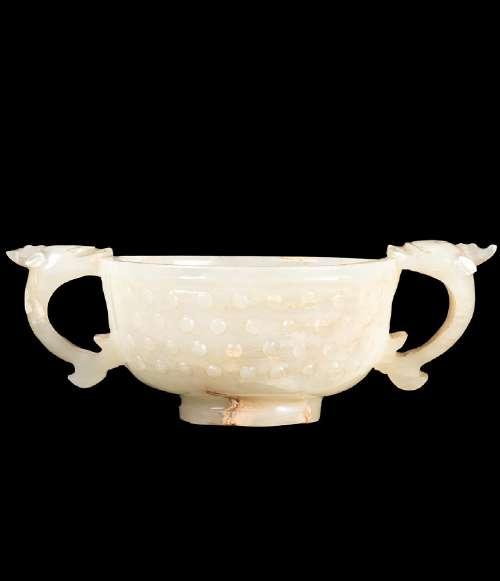
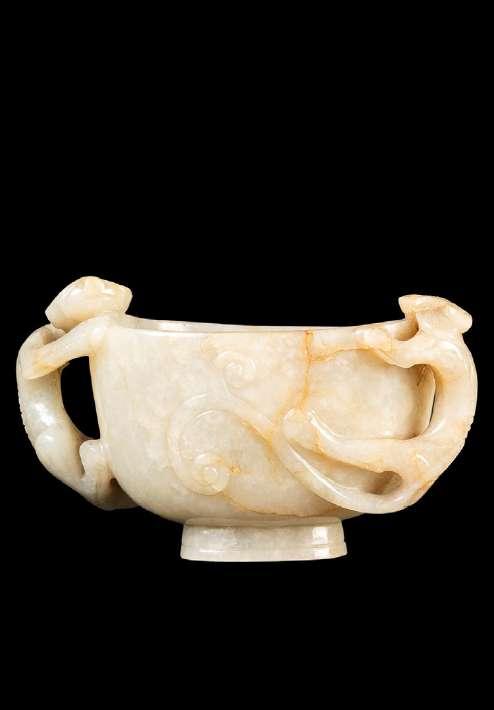
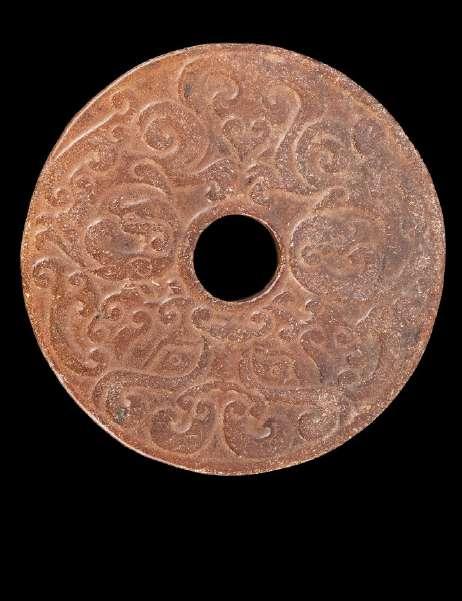
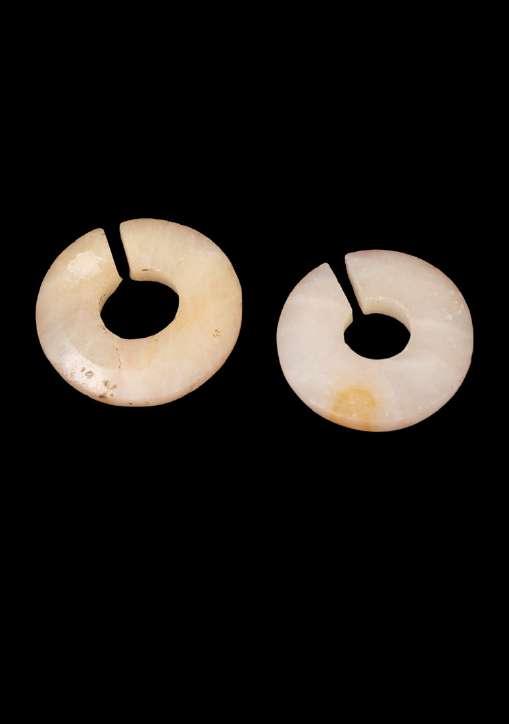
A JADE BI DISC, China, 19th / 20th century
d cm 9,9
Of circular form, it is carved on both sides with taotie masks and phoenixes among stylized clouds.
DISCO BI IN GIADA, Cina, XIX / XX secolo
Dalla forma circolare è intagliato su entrambi i lati con maschere taotie e fenici tra nuvole stilizzate.
19/20世纪 玉壁
TWO WHITE OPAQUE JADE SLIT RING, China, Qing dynasty (1644-1911)
Of circular form, with a narrow slit and slightly rounded inner edges.
DUE ANELLI FESSURATI IN GIADA BIANCA OPACA, Cina, dinastia Qing (1644-1911)
Di forma circolare, con una sottile fessura e i bordi interni leggermente ricurvi.
A
JADE BELT HOOK, China, Qing dynasty (1644-1911)
l cm 7 x w cm 5,5
€ 800 / 1.200
Well carved with two qilong among leafy scrolls.
FIBBIA IN GIADA, Cina, dinastia Qing (1644-1911)
intagliata con due qilong tra ramages fogliacei.
清 龙纹玉带板
A JADE MIRROR, China, Qing dynasty, 18th / 19th century
h cm 26,4
€ 1.500 / 2.000
With a pierced relief dragon decoration on the handle and a low-relief engraved scene of figures in a landscape on the plaque. The edge on the back of the mirror is decorated with babao motifs and semi-precious stones.
SPECCHIO IN GIADA, Cina, dinastia Qing, XVIII / XIX secolo
Con decorazione a rilievo traforato di drago sul manico e decorazione incisa a basso rilievo di figure in un paesaggio sulla placca. Il bordo del retro dello specchio è decorato con motivi babao e pietre dure.
清18/19世纪 嵌白玉龙钩手镜
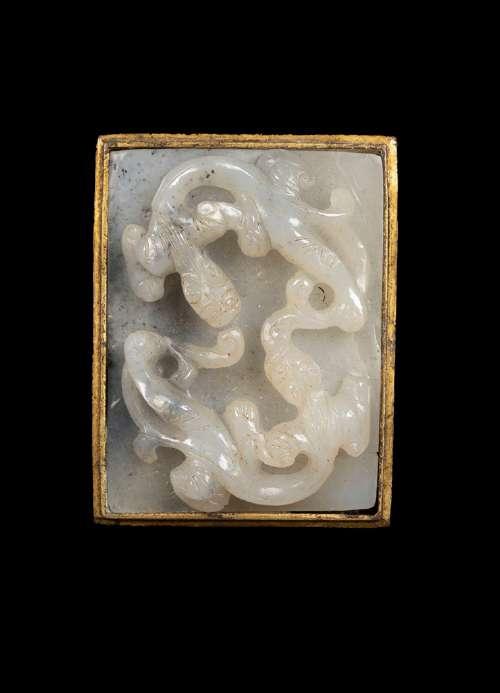
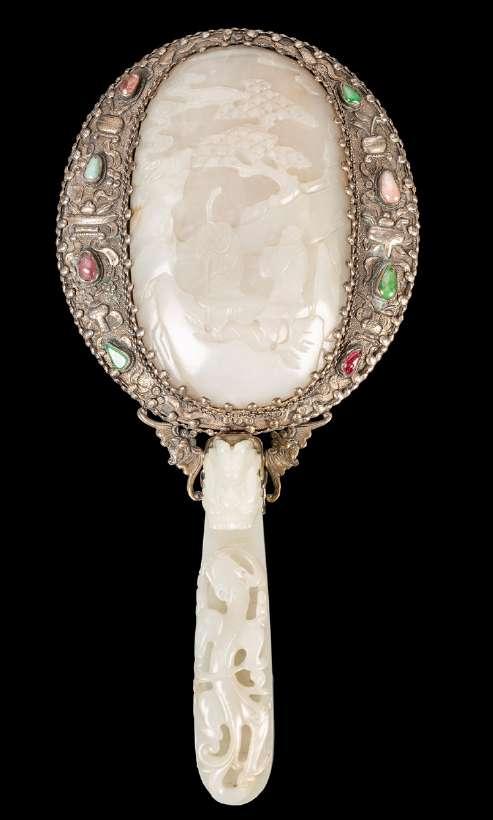
Ben

A WHITE JADE FIGURE, China, Qing dynasty, 18th century
€ 800 / 1.200
Finely carved, it depicts a youthful figure dressed in a cloak and draped garment, playing with two animals.
FIGURA IN GIADA BIANCA, Cina, dinastia Qing, XVIII secolo h cm 9
Finemente intagliata, raffigura una giovane figura vestita con mantella e abito drappeggiato, intenta a giocare con due animali.
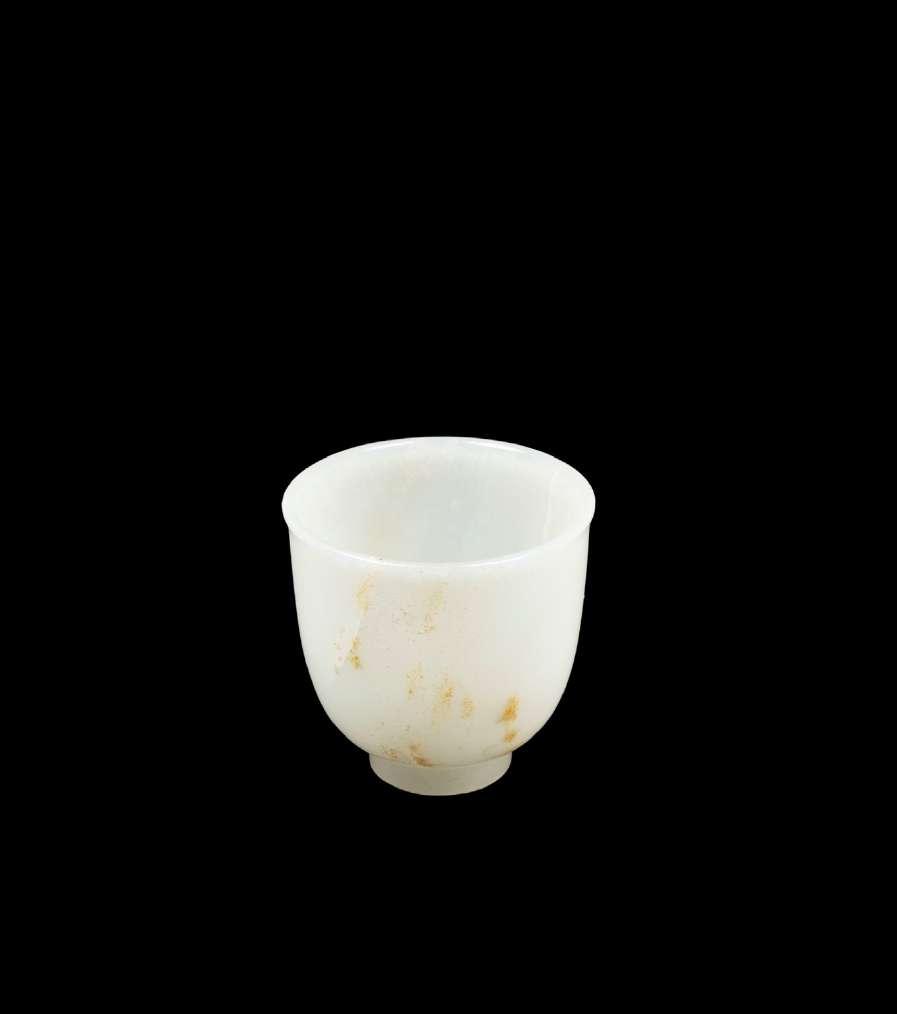
A WHITE AND RUSSETT JADE CUP, China, Qing dynasty, 18th / 19th century
COPPETTA IN GIADA BIANCA E RUGGINE, Cina, dinastia Qing, XVIII / XIX secolo h cm 6,6
Supported on a short straight foot, the plain sides terminated in a slightly flared mouth rim.
Catalog notes: A similar cup is in the Palace Museum in Beijing, see the following link: https://intl.dpm.org.cn/Jade/142866.html?l=en.
Sostenuto da un breve piede dritto, i fianchi lisci terminano in un bordo leggermente svasato.
Note di catalogo: Una coppetta simile si trova nella collezione del Palace Museum di Pechino, si veda il seguente link: https://intl.dpm.org.cn/Jade/142866.html?l=en.
清 白玉杯, 北京故宫博物院藏有一件类似的杯子 链接: https://intl.dpm.org.cn/Jade/142866.html?l=tc. 24 € 1.000 / 1.500
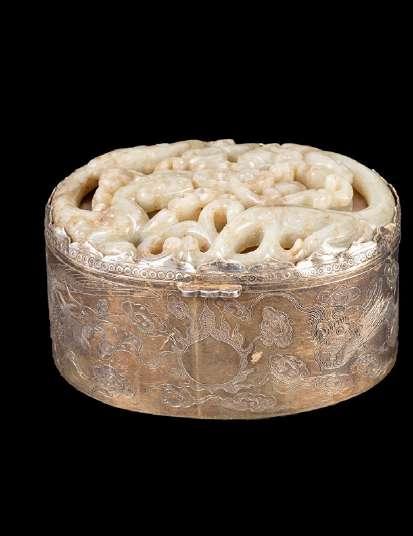
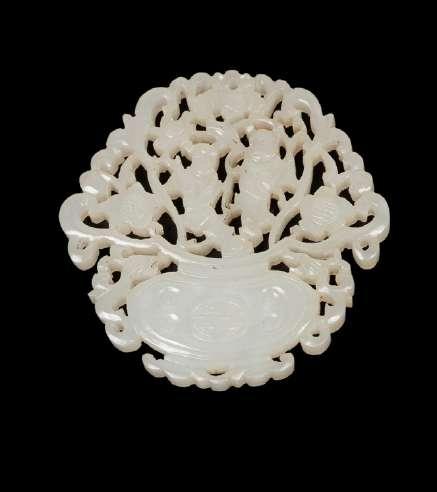
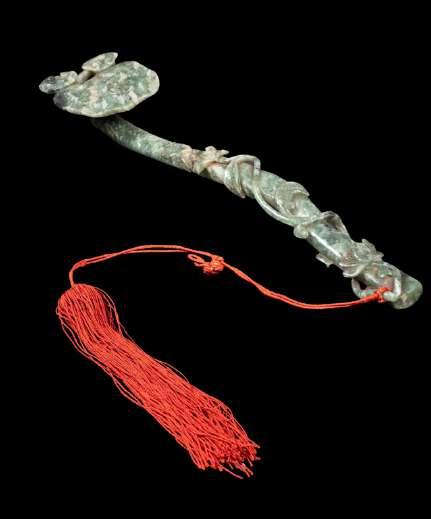
A SILVER BOX WITH A MOTTLED JADE PLAQUE AS COVER, China, Qing dynasty, 19th century
h cm 5,8 x l cm 10,2
€ 500 / 800
The 800 silver box with a vermeil interior, is finely engraved with dragons and phoenixes flying among stylized clouds while chasing the pearl; the lid is celadon jade, carved and pierced with two qilong dragons amid floral motifs.
SCATOLA IN ARGENTO
E COPERCHIO IN GIADA, Cina, dinastia Qing, XIX secolo
La scatola in argento 800 con interno in vermeil è incisa con motivi di draghi e fenici che volano tra nuvole stilizzate mentre inseguono la perla; il coperchio in giada celadon intagliato e forato con due draghi qilong tra motivi floreali.
清19世纪 嵌玉银盒子 重 434g
€ 200 / 300
Carved and pierced, it depicts a vase from which two figures emerge amid floral motifs and bats.
PLACCA IN GIADA BIANCA TRAFORATA, Cina, dinastia Qing, XIX secolo
Raffigura un vaso da cui emergono due figure tra decori floreali e pipistrelli.
清19世纪 镂空透雕白玉佩
A SMALL CARVED WHITE JADE, China, Qing dynasty, 19th century A MOTTLED JADE RUYI SCEPTER, China, Qing dynasty (1644-1911)
l cm 5,2 l cm 31,2
€ 1.900 / 3.000
Carved in the form of a gnarled branch with a lingzhi-shaped head, the branch is adorned with raised floral motifs; the head of the scepter is further decorated with lingzhi and two small bats.
SCETTRO RUYI IN GIADA SCREZIATA, Cina, dinastia Qing (1644-1911)
Intagliato a forma di ramo contorto con testa a forma di lingzhi, il ramo è ornato da motivi floreali a rilievo; la testa dello scettro è ulteriormente decorata con lingzhi e due piccoli pipistrelli.
清 玉如意摆件

SIX LACQUERED
WOOD WALL
PANELS WITH JADE AND HARDSTONE INLAYS, China, late 19th / early 20th century
Panel h cm 190 x l cm 38
€ 10.000 / 15.000
Of rectangular form, finely carved on the wooden frame with lotus scroll and shou; inlaid with archaistic jade, bone and hardstone objects. The backside is decorated with landscape.
SEI PANNELLI IN LEGNO LACCATO CON INTARSI IN GIADA E PIETRE DURE, Cina, fine XIX / inizio XX secolo
Di forma rettangolare sono finemente intagliati sulla cornice in legno con tralci di fiori di loto, foglie e shou; intarsiati con oggetti antichi in giada, osso e pietre dure. Il retro presenta raffigurazioni di paesaggi.
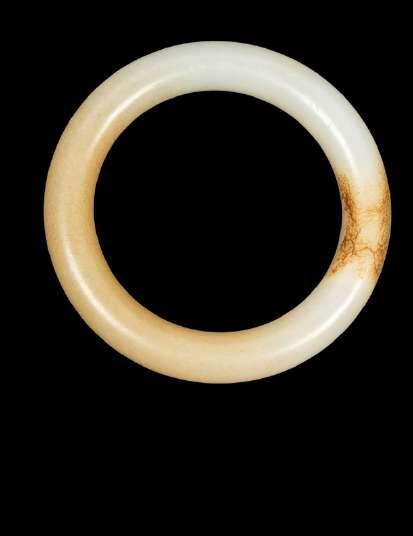
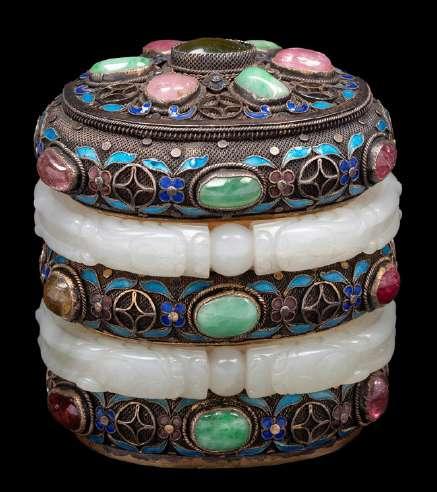

A WHITE AND RUSSETT JADE BANGLE, China, 19th / 20th century
d cm 8
400 / 600
Of circular shape and russett spots.
BRACCIALE IN GIADA BIANCA E RUGGINE, Cina, XIX / XX secolo
Dalla forma circolare, con tracce color ruggine.
19/20世纪 玉镯
A JADE SILVER AND HARDSTONE BOX, China, Qing dynasty, 19th century
h cm 9
600 / 800
Decorated with enamel and semi-precious stones and two jade rings from the 18th / 19th century in the shape of dragon heads holding the pearl. Total weight g 248.
SCATOLA IN ARGENTO GIADA E PIETRE DURE, Cina, dinastia Qing, XIX secolo
19/20世纪 嵌白玉镯银盒 重248g
A JADEITE BANGLE, China, 19th century
d cm 8,3
200 / 300
Of cylindrical shape.
BRACCIALE IN GIADEITE, Cina, dinastia Qing, XIX secolo
Abbellita con smaltature e pietre dure e due anelli in giada del XVIII / XIX secolo a forma di teste di drago che tengono la perla. Peso tot. g 248. Di forma cilindrica.
19世纪 翠玉手镯
TWO APPLE-GREEN JADEITE PINS, China, 19th / 20th century
The larger l cm 7,3
€ 300 / 500
Carved with floral motifs, featuring butterflies and bats.
DUE SPILLE IN GIADEITE VERDE MELA, Cina, XIX / XX secolo
Intagliate con motivi floreali con farfalle e pipistrelli.
清 翡翠胸针(两枚)
A CARVED OPENWORK JADEITE PENDANT, China, 19th / 20th century
d cm 5,7
€ 300 / 500
Carved and pierced representing birds among foliate motifs.
CIONDOLO IN GIADEITE TRAFORATA, Cina, fine XIX secolo / inizio XX secolo
Intagliata e forata con uccellini tra decorazioni fogliacee.
19/20世纪 镂空透雕花鸟翡翠吊坠

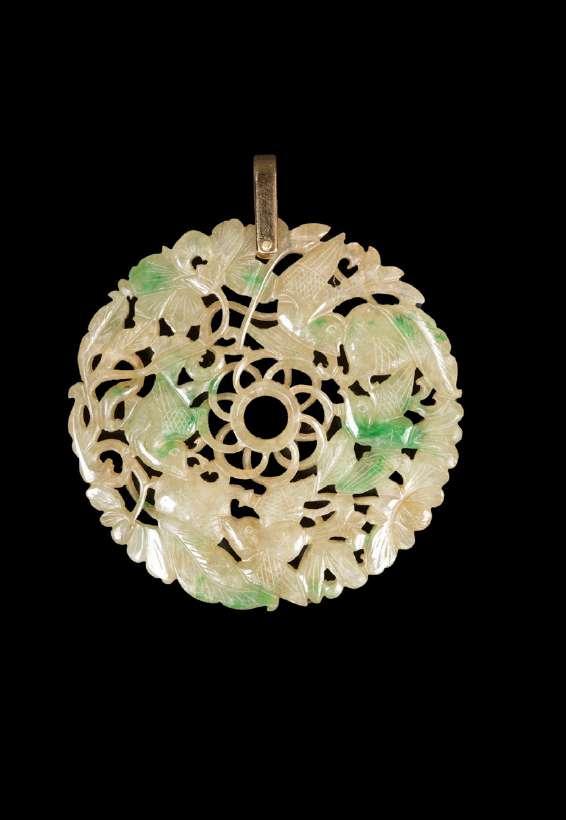
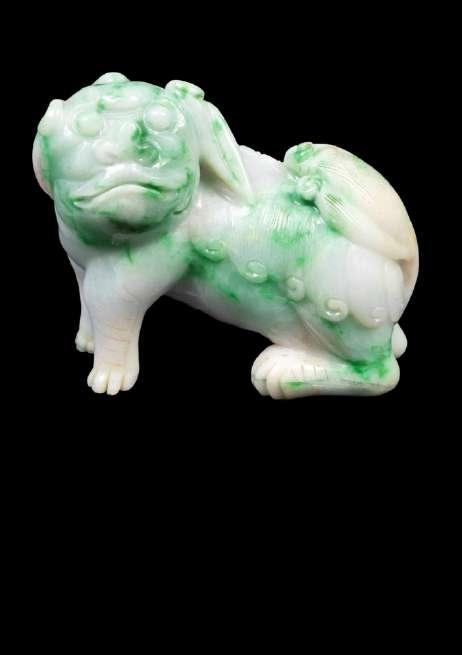
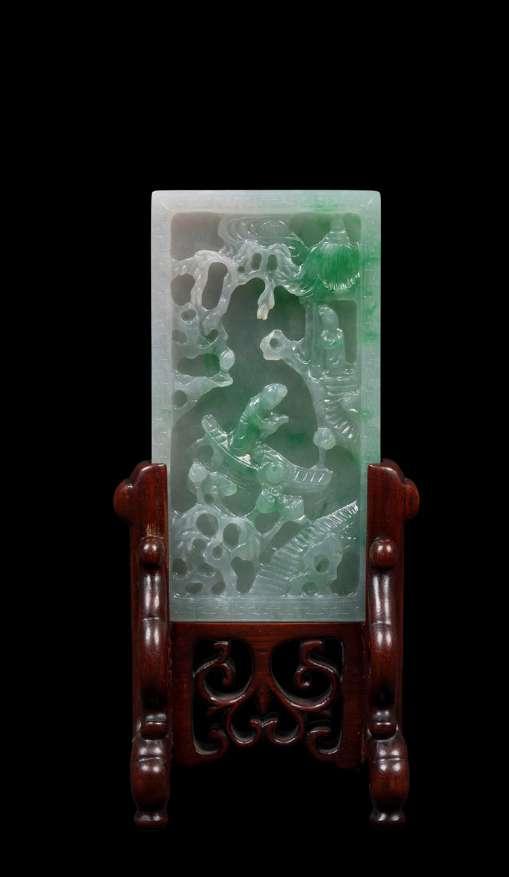
A JADEITE CARVING, China, 19th / 20th century
Carved in the form of a Foo dog.
INTAGLIO IN GIADEITE, Cina, XIX / XX secolo
Intagliata a forma di cane di pho.
A JAIDEITE RECTANGULAR PLAQUE, China, early 20th century
One side depicting two figures in a river landscape with boats and pagodas, the reverse inscribed with Chinese characters.
PLACCA RETTANGOLARE IN GIADEITE, Cina, inizio XX secolo
Presenta su un lato due figure in un paesaggio fluviale con imbarcazioni e pagode, e sull’altro un’iscrizione in caratteri cinesi.
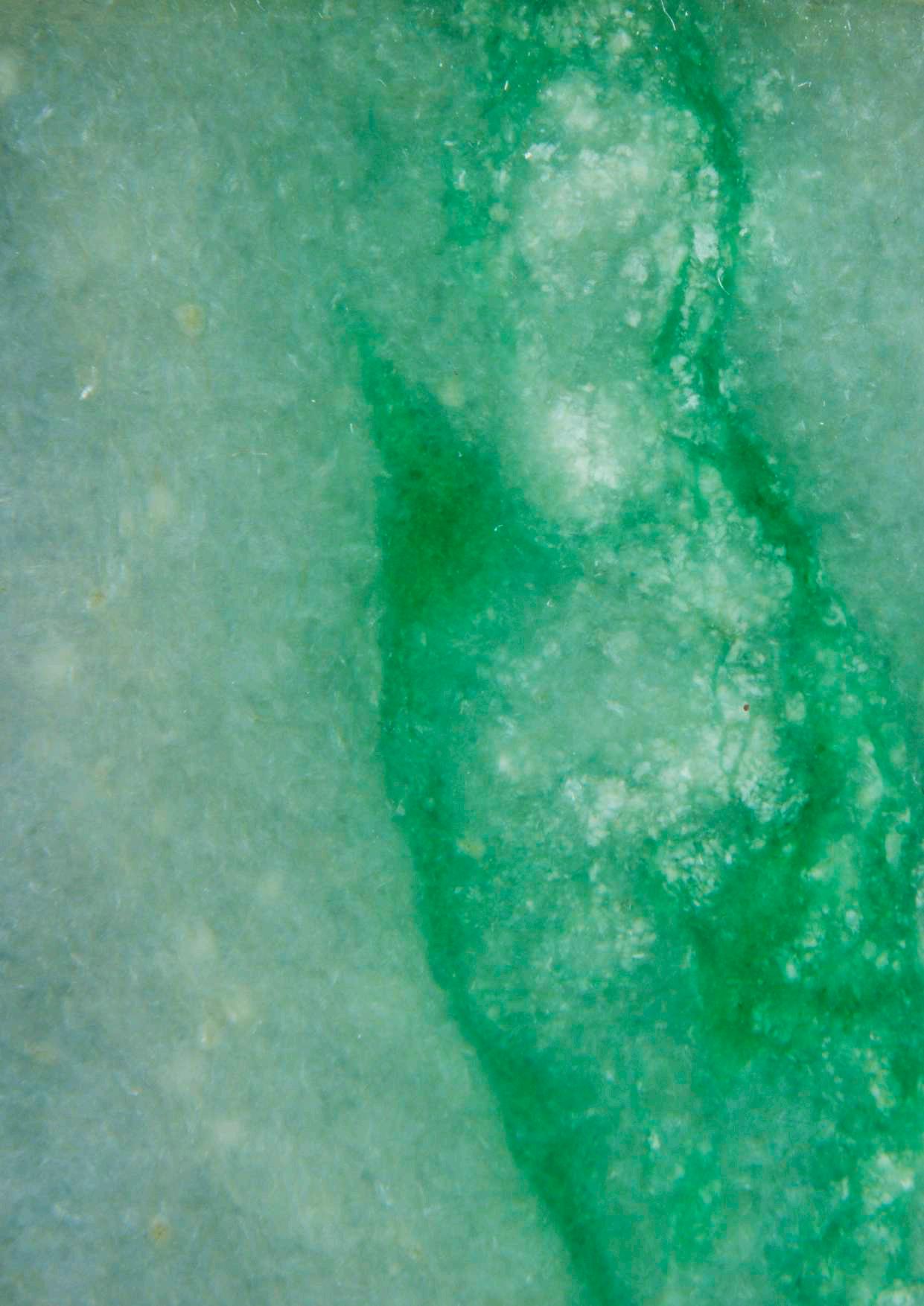
A RARE MOTTLED APPLE GREEN
JADEITE CENSER AND COVER, FANGDING, China, Qing dynasty, possibly Qianlong
h cm 19,6
€ 2.000 / 3.000
It rests on four tall cylindrical legs finely carved with two cord bands above which stand out taotie masks. The rectangular-section body is adorned with intricate double interlaced cord decorations running along the borders, corners, and the center of each of the four sides. Two openwork handles in the shape of ruyi are carved in relief, while the cover echoes the interlaced cord motif of the body and is surmounted by a finial sculpted as a lion grasping a peony branch in its mouth. The piece is set on a finely carved wooden base featuring a central flower and rope motifs that recall those of the vessel itself.
Provenance: Bulgari Collection, Rome, no. I0IN. Private collection, Rome.
Catalogue Notes: It is very rare to find a jadeite vessel decorated with a rope motif. This ornamental element originated in the Neolithic period, when cords were wrapped around vessels for practical purposes, and it had already become a decorative motif in antiquity (see the Warring States bronze vessel at the Palace Museum, Beijing, inventory no. 新00076872) and was revived during the Qianlong period, as the emperor was an ardent admirer of archaistic style. This censer, which combines a Shang form with a Neolithic motif, would reflect the Emperor’s typical taste. Jade objects featuring rope decoration were produced during this period, as evidenced by the green jade vase and snuff bottle at the Palace Museum, Beijing, inventory nos. 故00092702 and 故00093252, respectively. Compare also the nearly identical white jade fangding censer of Qianlong period with the same rope decoration and wooden base, sold at Sotheby’s, Important Chinese Art including Jades from the De An Tang Collection and Gardens of Pleasure –Erotic Art from the Bertholet Collection, 29 April 2022, Hong Kong, lot no. 3632.
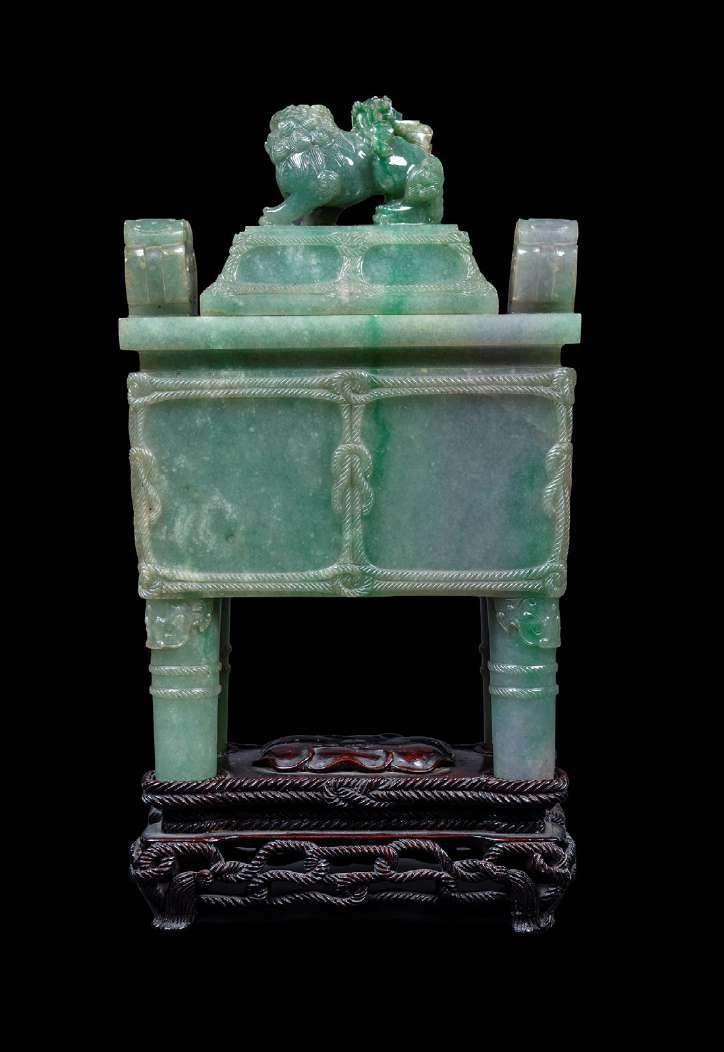
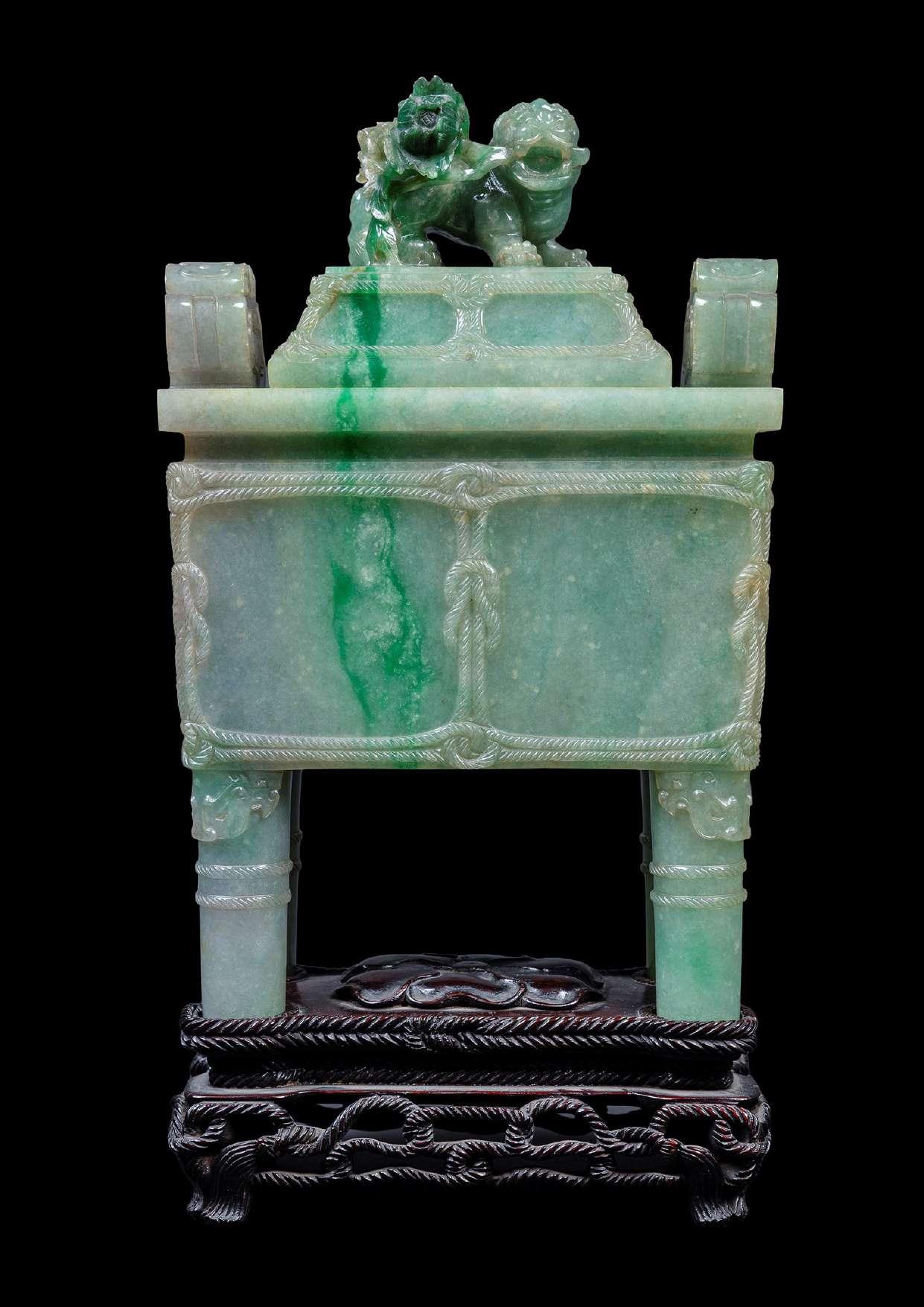
RARO INCENSIERE IN GIADEITE VERDE MELA CON COPERCHIO, Cina, dinastia Qing, probabilmente Qianlong
Dalla forma arcaistica fangding, si poggia su quattro alti piedi cilindrici, finemente intagliati con due corde sopra alle quali spiccano maschere taotie. Il corpo a sezione rettangolare è ornato con raffinate decorazioni a doppie corde intrecciate che corrono lungo i bordi, gli angoli e al centro di ciascuna delle quattro facce. Sono presenti due anse intagliate e forate a forma di ruyi, mentre il coperchio riprende la decorazione a corde intrecciate del corpo ed è sormontato da una presa scolpita a forma di leone che tiene in bocca un ramo di peonia. La base in legno finemente intagliata con un fiore centrale e motivi a corda che richiamano il corpo.
Provenienza: Collezione Bulgari, Roma, n° I0IN. Collezione privata, Roma.
Note di catalogo: È molto raro trovare un vaso in giadeite decorato con un motivo a corda. Questo elemento ornamentale trae origine dal periodo neolitico quando le corde venivano intrecciate attorno ai recipienti per uso pratico ed è diventato motivo di decorazione già nell’antichità (si veda il vaso in bronzo degli Stati Combattenti al Palace Museum di Pechino, numero d’inventario 新00076872) e ripreso durante il periodo Qianlong, essendo l’imperatore un amante dello stile arcaizzante. Questo incensiere, che combina una forma Shang con un motivo neolitico, rispecchierebbe il gusto tipico dell’Imperatore. Oggetti in giada con motivo a corda furono prodotti in questo periodo, come si può vedere dal vaso e dalla snuff bottle in giada verde al Palace Museum di Pechino, rispettivamente numero di inventario 故00092702 e 故00093252. Si veda l’incensiere fangding quasi identico in giada bianca marcato e del periodo Qianlong con stessa decorazione a corda e stessa base lignea venduto da Sotheby’s, Important Chinese Art including Jades from the De An Tang Collection and Gardens of Pleasure – Erotic Art from the Bertholet Collection, 29 Aprile 2022, Hong Kong, lot. n° 3632.
清 翡翠狮纽绳纹方鼎(可能乾隆年间 ) 来源: – 宝格丽收藏,罗马,编号 I0IN。 – 私人收藏,罗马 图录注释:饰以绳纹的翡翠器皿极 为罕见。绳纹起源于新石器时代,当时人们出于实用目的将绳索缠绕在器皿上。在古代,绳纹已发展成为一种装饰纹样(参见北京故宫博 物院藏战国时期青铜器,藏品编号新00076872)。乾隆年间,由于乾隆皇帝崇尚古朴风格,绳纹再次复兴。乾隆时期也出现了饰以绳纹 的玉器,例如北京故宫博物院藏绿玉瓶和鼻烟壶,藏品编号分别为故00092702和故00093252。
此外,还有一件乾隆时期的白玉方鼎香 炉,与此香炉的绳纹装饰和木底座几乎完全相同,曾在2022年4月29日香港苏富比拍卖行“重要中国艺术品,包括德安堂玉器收藏及贝尔 托莱收藏的专场拍卖会上售出,拍品编号为3632。为罕见。绳纹起源于新石器时代,当时人们出于实用目的将绳索缠绕在器皿上。在古 代,绳纹已发展成为一种装饰纹样(参见北京故宫博物院藏战国时期青铜器,藏品编号新00076872)。乾隆年间,由于乾隆皇帝崇尚古 朴风格,绳纹再次复兴。乾隆时期也出现了饰以绳纹的玉器,例如北京故宫博物院藏绿玉瓶和鼻烟壶,藏品编号分别为故00092702和故 00093252。
此外,还有一件乾隆时期的白玉方鼎香炉,与此香炉的绳纹装饰和木底座几乎完全相同,曾在2022年4月29日香港苏富比拍 卖行“重要中国艺术品,包括德安堂玉器收藏及贝尔托莱收藏的专场拍卖会上售出,拍品编号为3632。
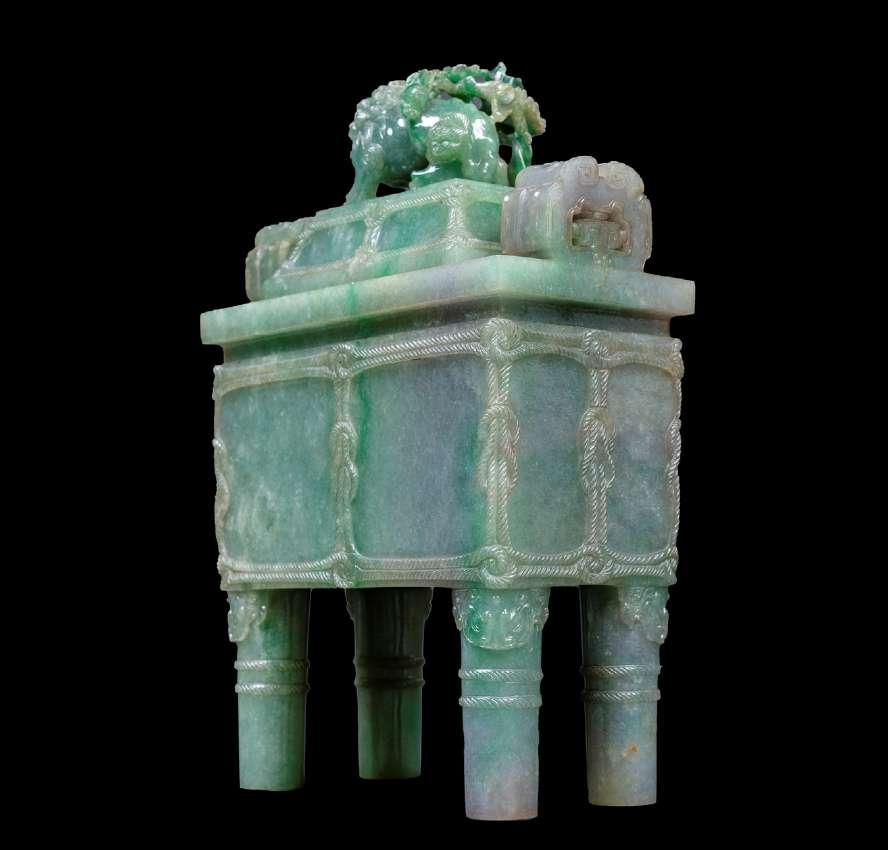

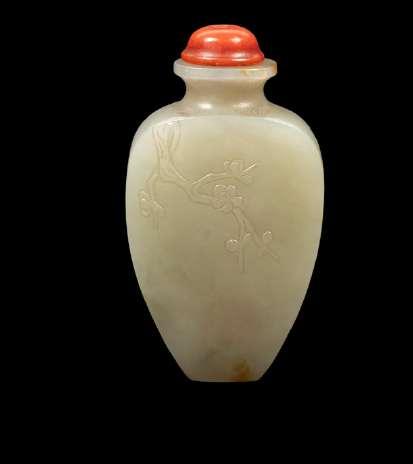

A JADE SNUFF BOTTLE, China, 19th century
h cm 6,2
€ 400 / 600
Finely carved in relief on the body with a blossoming prunus tree.
SNUFF BOTTLE IN GIADA, Cina, XIX secolo
Finemente intagliata a rilievo sul corpo con un albero di pruno fiorito.
清19世纪 玉雕梅花纹鼻烟壶
AN
AGATE SNUFF BOTTLE, China, Qing dynasty, 19th century
h cm 8,3
€ 200 / 300
Of flattened form with twin handles, set on a carved wooden base.
SNUFF BOTTLE IN AGATA, Cina, dinastia Qing, XIX secolo
Dalla forma schiacciata e biansata, con base in legno intagliato.
19世纪 玛瑙鼻烟壶

ELEVEN SNUFF BOTTLES, China, 19th / 20th century
The larger cm 8,3
Of various forms and materials: two in porcelain with erotic subject, one bearing an apocryphal iron-red four-character Qianlong mark to the base; three in agate; four in glass, three of which carved in relief with qilong; one in amber finely decorated with floral and foliate motifs; and one in hardstone with stopper carved with a bat.
UNDICI SNUFF BOTTLES, Cina, XIX / XX secolo
Di forme e materiali differenti: due in porcellana a soggetto erotico, una recante alla base un marchio apocrifo in rosso ferro a quattro caratteri dell’Imperatore Qianlong; tre in agata; quattro in vetro, tre delle quali intagliate a rilievo con qilong; una in ambra finemente decorata con motivi floreali e fogliacei; e una in pietra dura con tappo scolpito a pipistrello.
A SILVER AND ENAMEL DOUBLE GOURD SNUFF BOTTLE, China, early 20th century
h cm 6,6
€ 200 / 300
Finely decorated on both sides with a naturalistic landscape depicting a tree and a bird against a pale blue ground. The neck is encircled by a band of ruyi motifs, while the stopper is adorned with hardstones and surmounted by a turquoise.
SNUFF BOTTLE IN ARGENTO E SMALTO, Cina, inizio XX secolo
A forma di doppia zucca, decorata su entrambi i lati con un paesaggio naturalistico raffigurante un albero e un uccellino su un fondo azzurro. Il collo è ornato da una fascia di motivi ruyi, mentre il coperchio è impreziosito da pietre dure e sormontato da un turchese.
民国 银胎珐琅鼻烟壶
AN
UNDERGLAZE BLUE AND COPPER-RED PORCELAIN SNUFF BOTTLE, China, Qing dynasty, 19th century
h cm 12,5
€ 500 / 700
Finely painted with the zodiac signs; on the base, a small mouse is depicted on a rock beneath a tree. Provenance: Private collection, Tuscany. Catalogue notes: A similar snuff bottle was sold at Sotheby’s, A Journey Through China’s History: The Dr Wou Kiuan Collection Online, Part III, 8–15 May 2024, London, lot no. 115.
SNUFF BOTTLE IN PORCELLANA BLU E ROSSO SOTTO COPERTA, Cina, dinastia Qing, XIX secolo
Finemente dipinta coi segni zodiacali, sulla base mostra un topolino raffigurato su una roccia sotto a un albero. Provenienza: collezione privata, Toscana. Note di catalogo: Una snuff bottle simile è stata venduta da Sotheby’s, A Journey Through China’s History. The Dr Wou Kiuan Collection Online. Part III, 8-15 Maggio 2024, Londra, lot. n° 115.
清19世纪 青花釉里红鼻烟壶


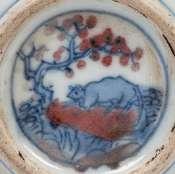

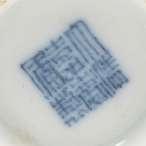
A
BLUE AND WHITE
PORCELAIN
WINE CUP, China, Jiaqing mark (1796-1820) and of the period
h cm 7,5 x d cm 6,5
42 € 300 / 500
Finely painted with a dancing figure and poetic inscriptions; the base bearing a six-character seal mark of the Jiaqing Emperor in underglaze blue.
COPPETTA IN PORCELLANA BIANCA E BLU, Cina, marchio e periodo Jiaqing (1796-1820)
Ben dipinta con una figura sul fronte e iscrizioni poetiche sul retro; alla base reca il marchio sigillare in blu sottocoperta a sei caratteri dell’Imperatore Jiaqing.
A BLUE AND WHITE PORCELAIN
OVOID
JAR,
China, Qing dynasty, Kangxi period (1661-1722)
h cm 16,5
€ 150 / 250
Decorated with blossoming plum flowers on a crackled-ice patterned ground. The base bears a double circle in underglaze blue. Wooden cover. Provenance: Private collection, Tuscany. Catalogue notes: A very similar vase is in the Keramiekmuseum Princessehof, inventory no. GAM 0829. See also a related vase sold at Christie’s, live auction 3949, Christie’s Interiors, 11 May 2011, London, lot no. 484.
VASO IN PORCELLANA BIANCA E BLU, Cina, dinastia Qing, periodo Kangxi (1661-1722)
Decorato con fiori di pruno in fiore su fondo a motivi ghiaccio screpolato. La base presenta un doppio cerchio in blu sotto coperta. Coperchio in legno. Provenienza: collezione privata, Toscana. Note di catalogo: Un vaso molto simile si trova al Keramiekmuseum Princessehof, numero di inventario GAM 0829. Si veda anche un vaso venduto da Christie’s, asta live 3949, Christie’s Interiors, 11 Maggio 2011, Londra, lot. n° 484.
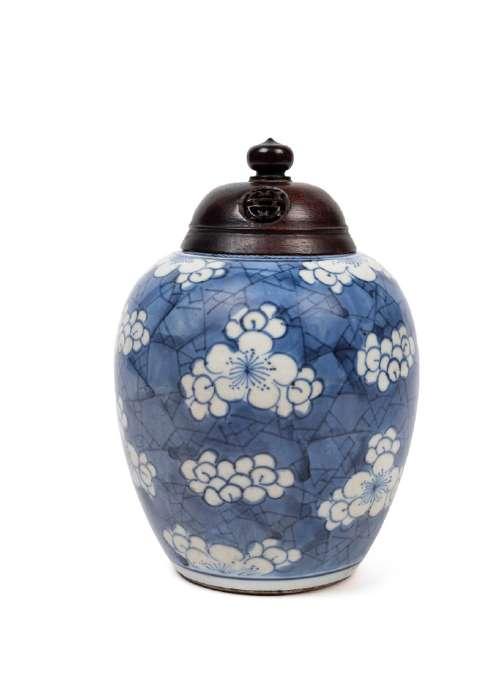
TWO BLUE AND WHITE PORCELAIN VASES,
China, Qing dynasty, Kangxi period (1661-1722)
The larger h cm 24,1
€ 1.000 / 1.500
Bottle-shaped, with marine monster-shaped handles featuring rings, decorated in reserve with naturalistic landscapes including flowering trees and rocks.
DUE VASETTI IN PORCELLANA BIANCO E BLU, Cina, dinastia Qing, periodo Kangxi (1661-1722)
Di forma a bottiglia, con anse a forma di mostri marini con anelli, decorati a riserva con paesaggi naturalistici comprendenti alberi in fiore e rocce.
清康熙 青花罐 清康熙
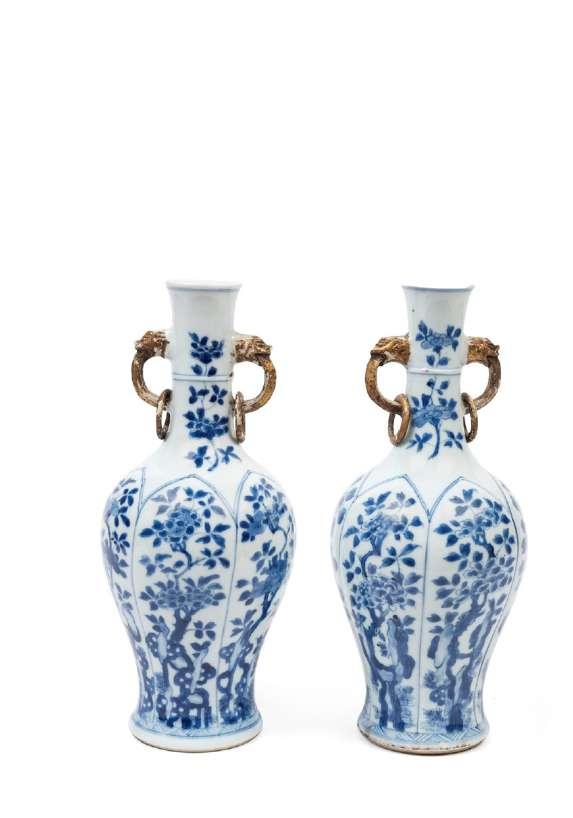
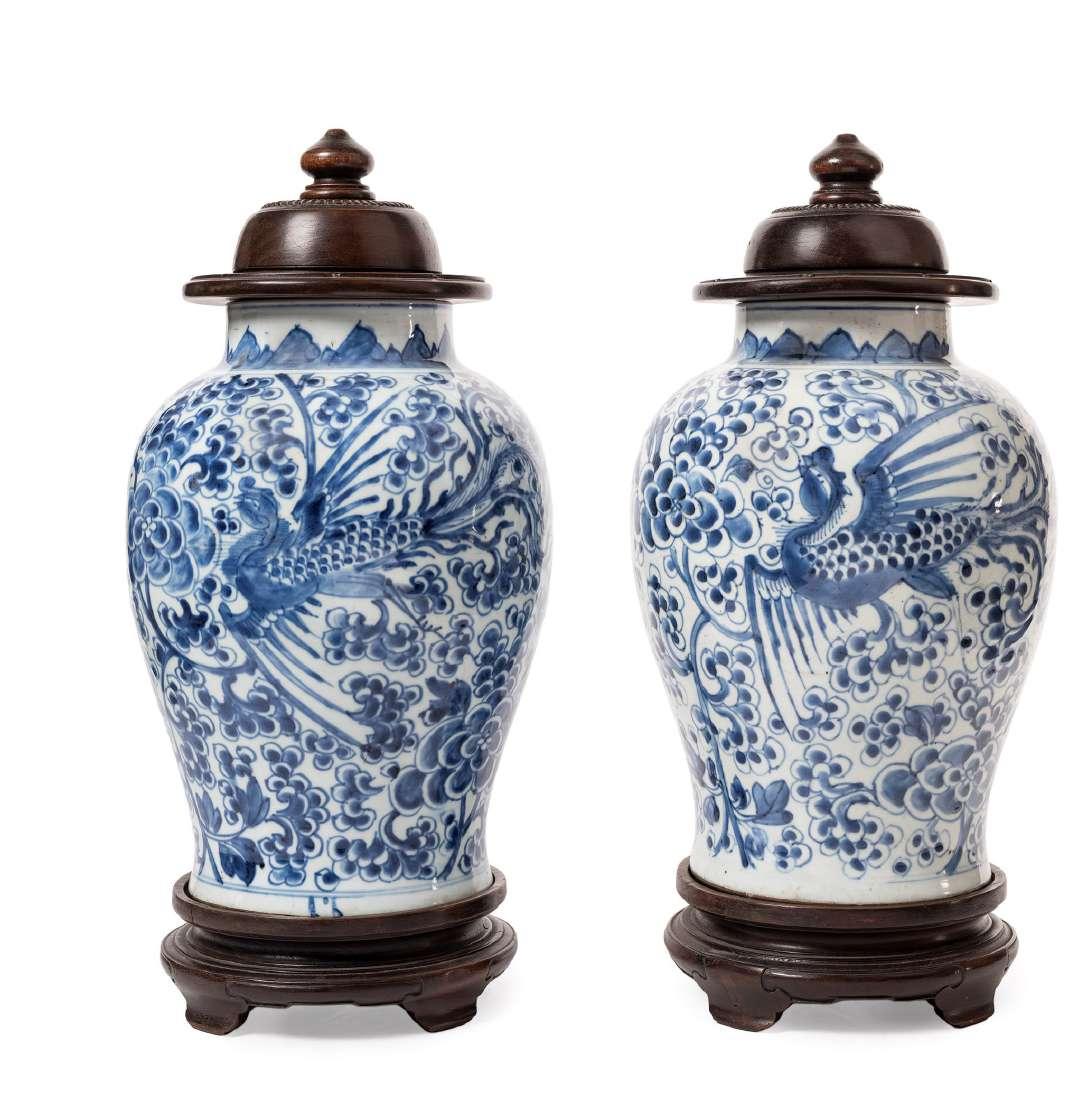
A
PAIR
OF BLUE AND WHITE
PORCELAIN VASES, China, Qing dynasty, Kangxi period (1661-1722)
h cm 32,7
€ 1.200 / 1.500
Decorated with phoenixes flying over a floral landscape with peonies. With carved wooden lids, wooden stands.
COPPIA DI VASI IN PORCELLANA BIANCA E BLU, Cina, dinastia Qing, periodo Kangxi (1661-1722)
Decorati con fenici che volano in un paesaggio floreale con peonie. Con coperchi in legno intagliato e basi in legno.
A BLUE AND WHITE ‘YENYEN’ PORCELAIN VASE,
China, Qing dynasty, Kangxi period (1661-1722)
h cm 52
€ 1.500 / 2.000
Entirely painted with petal-shaped reserves enclosing mountainous landscapes, interspersed with bands of prunus motifs; the base of the flaring neck is adorned with a refined diamond-patterned band.
VASO “A CODA DI FENICE” IN PORCELLANA BIANCA E BLU, Cina, dinastia Qing, periodo Kangxi (1661-1722)
Interamente dipinto con riserve a forma di petalo decorate da paesaggi montuosi, intervallati da fasce con motivi di pruno; la base del collo svasato è decorata con una raffinata fascia a motivo geometrico.
清康熙 青花瓷花觚
A BLUE AND WHITE OGEE BOWL,
China, Yongzheng mark and period (1723-1735)
d cm 22,6
€ 100 / 200
The tall foot rising to a wide everted rim, the central medallion with a webbed star surrounded by six ruyi heads, the reverse finely painted with a continuous floral band around the Eight Buddhist Emblems, bajixiang. The base bears a six-character underglaze blue mark of the Yongzheng Emperor.
PIATTO IN PORCELLANA BIANCO E BLU, Cina, marchio e del periodo Yongzheng (1723-1735)
Con piede alto che si apre in un ampio bordo svasato, il medaglione centrale è decorato con una stella reticolata circondata da sei teste di ruyi. Il retro è finemente dipinto con una fascia floreale continua che avvolge gli Otto Simboli Buddhisti (bajixiang). La base reca marchio a sei carattere in blu sotto-coperta dell’Imperatore Yongzheng.
清雍正 青花八吉祥紋盘

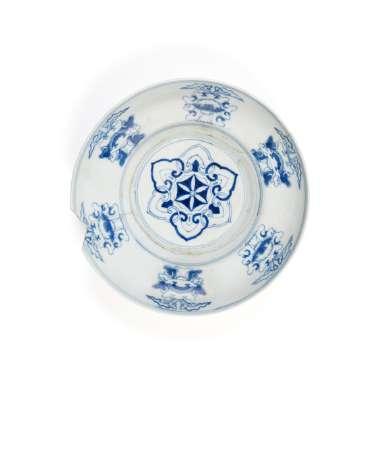

A VERY RARE PAIR OF HUGE BLUE AND WHITE HEXAGONAL BALUSTER-SHAPED PORCELAIN VASES, China, Qing dynasty, 18th / 19th century
h cm 102
€ 70.000 / 100.000
The body raised on a high, flaring foot is decorated with a dense pattern of scrolling leaves and composite flowers, between a band of overlapping petals above the foot and borders of ruyi heads, key-fret, and upright leaves around the shoulder. The foot, neck, and cover are further adorned with floral motifs, while the cover is surmounted by a seated figure of Guanyin. Set on openwork wooden stands carved with floral designs.
RARA COPPIA DI ENORMI VASI IN PORCELLANA BIANCA E BLU, Cina, dinastia Qing, XVIII / XIX secolo
ll corpo a sezione esagonale a forma di colonna di balaustro sostenuto da un alto piede allArgato è decorato con un fitto motivo di volute di foglie e fiori compositi, tra una fascia di petali sovrapposti sopra il piede e fasce con motivi di teste di ruyi, greca e foglie verticali sulla spalla; il piede, il collo e il coperchio sono ulteriormente ornati con motivi di fiori, mentre il coperchio è sormontato da una figura di Guanyin seduta. Basi in legno decorate a traforo con motivi floreali.
清18/19世纪 青花西番纹花卉观音钮六角大方瓶一对
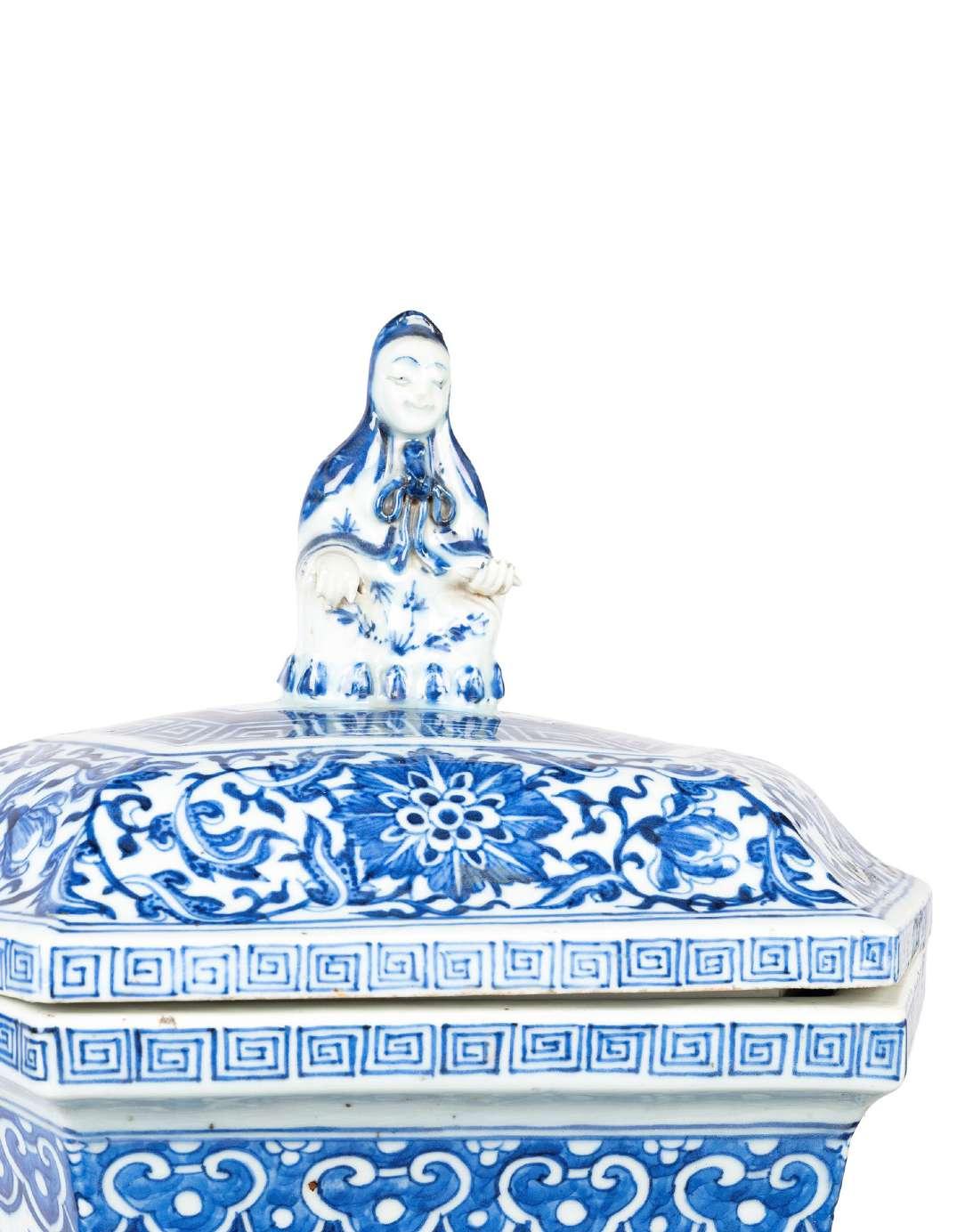
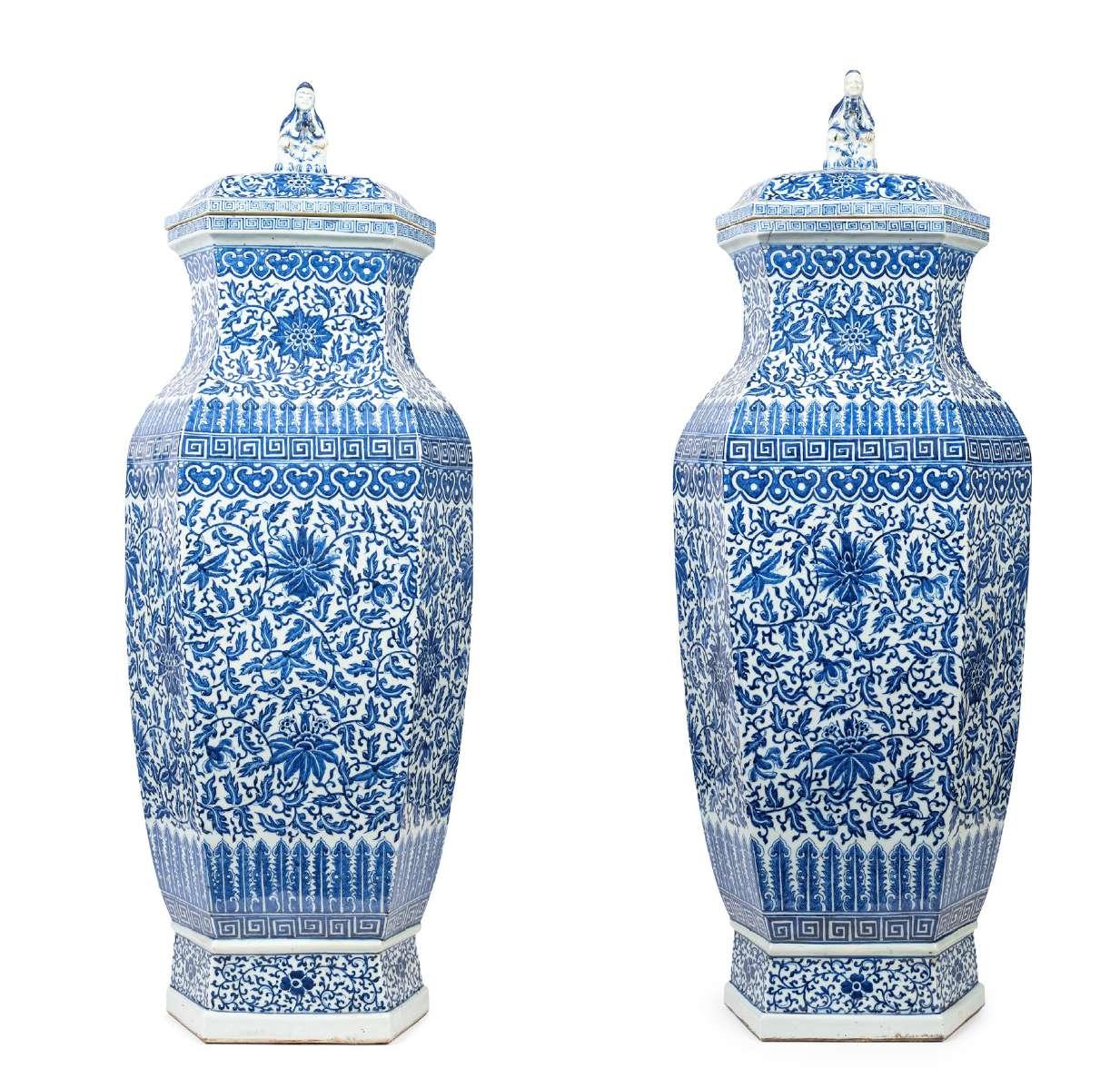
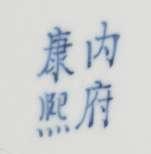

A LARGE YEN-YEN BLUE AND WHITE PORCELAIN VASE,
China, late 19th / early 20th century
h cm 54,2
49 € 800 / 1.000
The body is finely decorated with a naturalistic landscape depicting peony trees, rocks, and birds. The base bears a four-character apocryphal underglaze-blue mark of the Kangxi Emperor.
GRANDE VASO “A CODA DI FENICE” IN PORCELLANA BIANCA E BLU,
Cina, fine XIX secolo / inizio XX secolo
Il corpo è decorato con un paesaggio naturalistico raffigurante alberi di peonie, rocce e uccelli. Alla base reca un marchio apocrifo a quattro caratteri in blu sotto coperta dell’Imperatore Kangxi.
19/20世纪 青花雉鸡牡丹纹凤尾尊

A LARGE BLUE AND WHITE BALUSTER-SHAPED PORCELAIN VASE, China, Qing dynasty, 19th century
h cm 66,5
50 € 6.000 / 8.000
With raised foot, globular body, long neck flanked by two dragon-shaped handles, and a flared rim; finely painted in rich underglaze blue with qilong dragons floating among scrolling lotus and leafy tendrils, interspersed with bands of ruyi and stylized petals. The base bears an apocryphal six-character mark of the Qianlong Emperor within a double circle, in underglaze blue.
GRANDE VASO IN PORCELLANA BIANCO E BLU,
Cina, dinastia Qing, XIX secolo
A forma di colonna di balaustro con piede rialzato, corpo globulare e collo lungo con due anse a forma di drago e svasato con bordo ricurvo, è ben dipinto con un blu intenso sotto coperta raffigurando qilong che fluttuano tra volute di foglie e fiori di loto, intervallati da fasce di ruyi e petali stilizzati; sulla base reca il marchio apocrifo in blu sotto coperta a sei caratteri dell’Imperatore Qianlong all’interno di un doppio cerchio.
清 青花穿花龙纹螭龙双耳大瓶
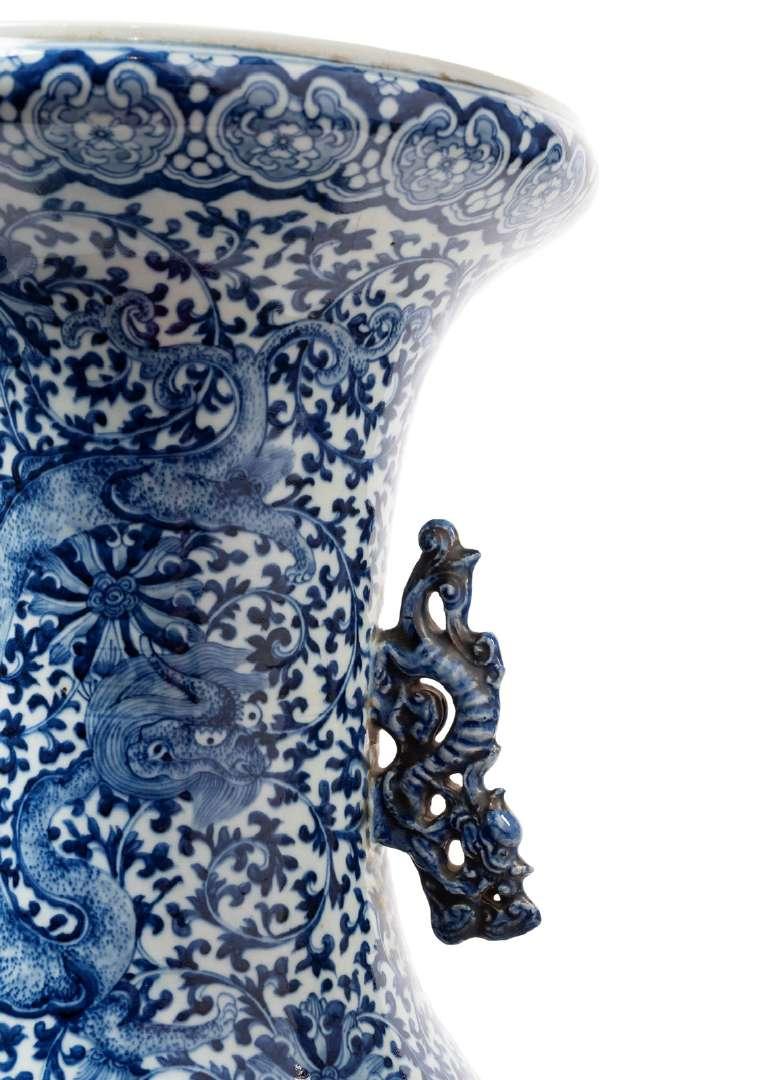
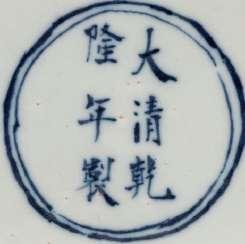
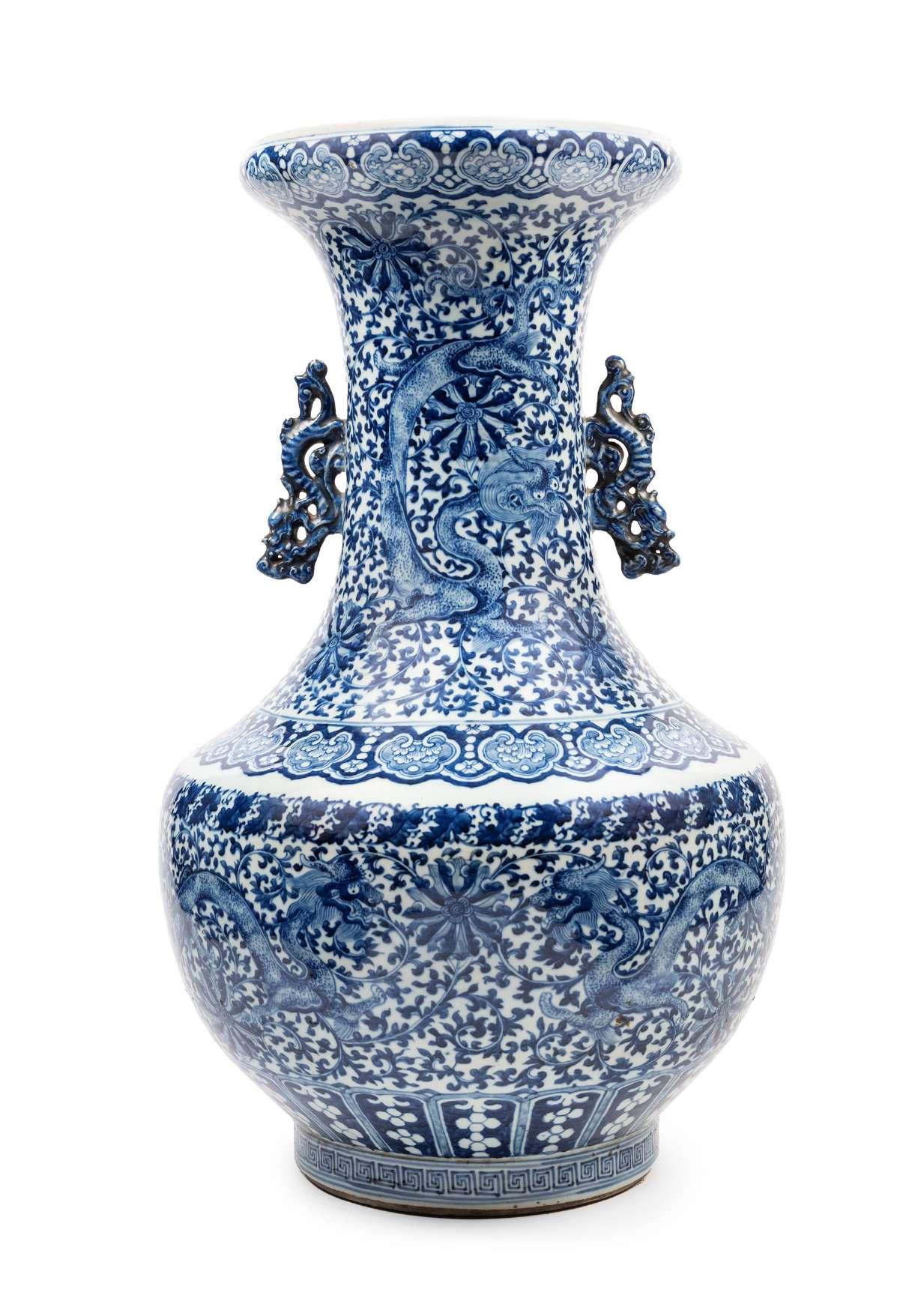

51
A BLUE AND WHITE ‘LOTUS POND’ PORCELAIN DISH,
China, Ming dynasty, Jiajing period (1521-1567)
d cm 30
€ 500 / 700
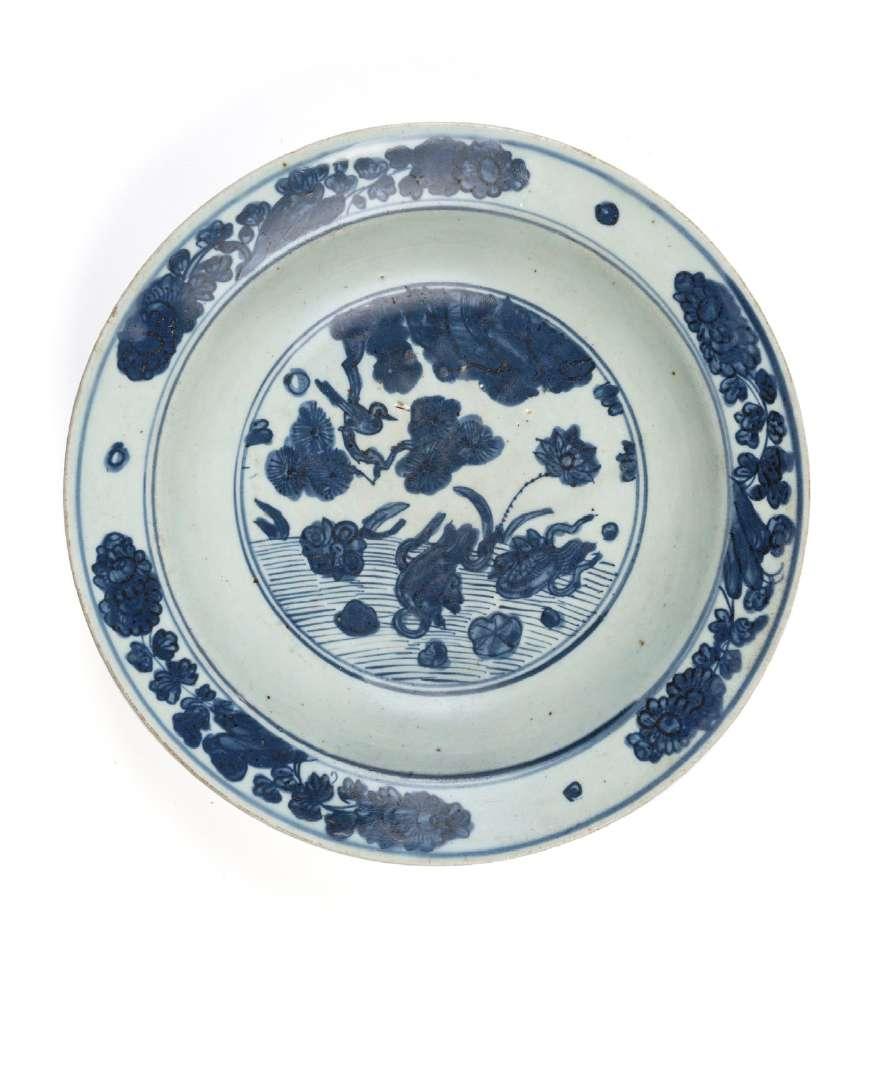
Finely painted in underglaze blue, the centre within a circular medallion depicts a lakeside scene with two mandarin ducks swimming among lotus flowers, while a small bird perches on a pine branch emerging from rocks. The rim is decorated with flowering branches, repeated on the exterior. The base bears a four-character mark Fu Gui Jia Qi (富贵佳器), meaning “Exquisite Vessel of Wealth and Honour.”
Provenance: private collection, Tuscany.
Catalogue note:
An identical dish is preserved in the collection of the Topkapi Saray Museum, Istanbul, inventory no. TKS 15/3350, illustrated in Regina Krahl and John Ayers, Chinese Ceramics in the Topkapi Saray Museum, Istanbul: A Complete Catalogue, vol. II, London, 1986, p. 609, fig. 840.
RARO PIATTO IN PORCELLANA BIANCA
E
BLU, Cina, dinastia Ming, periodo Jiajing (1521-1567)
Ben dipinto in blu sotto coperta al centro all’interno di una riserva circolare presenta una scena lacustre con due anatre mandarine che nuotano in uno stagno tra fiori di loto, mentre un uccellino è poggiato su un ramo di pino che esce da rocce; il bordo è dipinto con rami fioriti così come all’esterno. Al centro della base reca il marchio a quattro caratteri Fu Gui Jia Qi (富贵佳器), che significa “Raffinato Oggetto Simbolo di Prosperità e Onore”.
Provenienza: collezione privata, Toscana.
Note di catalogo: un piatto identico è conservato nella collezione del Museo Topkapi a Istanbul, numero di inventario TKS 15/3350, illustrato in Regina Krahl and John Ayers 1986, Chinese Ceramics in The Topkapi Saray Museum Istanbul - A Complete Collection, vol. II, Londra, pag. 609, fig. n° 840.
明 青花盘
A BLUE AND WHITE PORCELAIN
SWATOW CHARGER,
China, Ming dynasty, 16th / 17th century
d cm 34,5
€ 150 / 250
Depicting, within a central medallion, a bird among branches; four reserved panels on a honeycomb-ground enclose flowers. The reverse is decorated with stylized flowers.
Provenance: Private collection, Tuscany.
GRANDE PIATTO IN PORCELLANA BIANCA E BLU, Cina, dinastia Ming, XVI / XVII secolo
Raffigurante all’interno di un medaglione centrale un uccello tra rami, quattro riserve su un fondo a nido d’ape racchiudono fiori. Il retro decorato con fiori stilizzati.
Provenienza: collezione privata, Toscana.
53
A SWATOW POLYCHROME PORCELAIN CHARGER,
China, Ming dynasty, 17 century
d cm 38,5
€ 500 / 700
The center features a compass with a two-character inscription at its center, while along the compass rim is a twenty-four-character inscription; the border is decorated with leaping carp.
Provenance: Private collection, Tuscany.
Catalogue notes:
A very similar dish is illustrated in Canepa Teresa 2006, Zhangzhou Export Ceramics: The So-Called Swatow Wares, Lisbon/London, p. 133, item n. 28.
GRANDE PIATTO IN PORCELLANA POLICROMA SWATOW, Cina, dinastia Ming, XVII secolo
Il centro presenta una bussola con un’iscrizione di due caratteri al centro e lungo il bordo della bussola è disposta un’iscrizione di ventiquattro caratteri, il bordo è decorato con carpe guizzanti.
Provenienza: collezione privata, Toscana.
Note di catalogo: Un piatto molto simile è illustrato in Canepa Teresa 2006, Zhangzhou Export Ceramics: The So-Called Swatow Wares, Lisbona/Londra, pag. 133, n° 28. 明 青花瓷盘 明 斯瓦托瓷盘

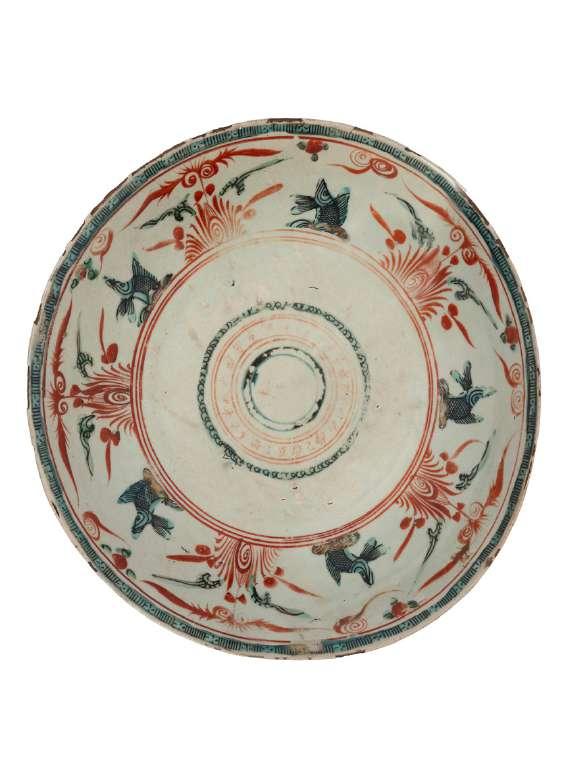
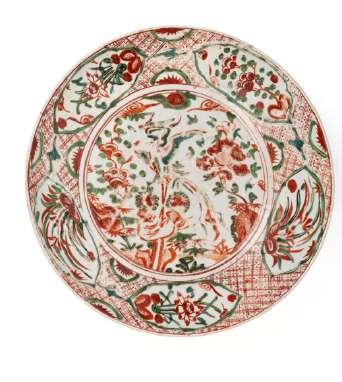

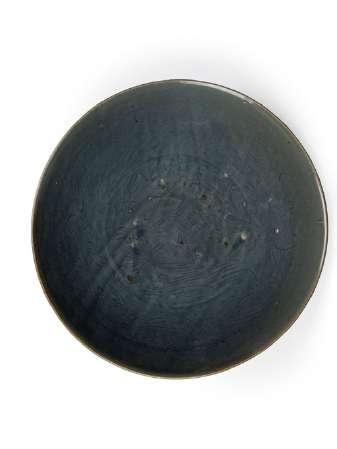
A
LARGE POLYCHROME SWATOW DISH, China, Ming dynasty, 16th / 17th century
d cm 36,5
Decorated in red, green, and turquoise blue, with a central phoenix among flowers; the rim adorned with cartouches enclosing floral motifs on a trellis ground, alternating with circular red panels.
Provenance: Private collection, Tuscany. Catalogue notes: A very similar dish is in the collection of the British Museum, accession number 1965,1014.1. See also the related example sold at Christie’s, live auction 5020, Arts d’Asie, 26 November 2002, Paris, lot no. 84.
GRANDE PIATTO IN PORCELLANA SWATOW, Cina, dinastia Ming, XVI / XVII secolo
Decorato in rosso, verde e blu turchese, con al centro una fenice tra fiori; l’orlo ornato da cartigli con motivi floreali su fondo a graticcio, alternati a cartigli circolari rossi. Provenienza: collezione privata, Toscana. Note di catalogo: Un piatto molto simile è nella collezione del British Museum, numero d’inventario 1965,1014.1. Si veda anche il piatto simile venduto da Christie’s, asta live 5020, Arts d’Asie, 26 Novembre 2002, Parigi, lot. n° 84.
A
LARGE POLYCHROME SWATOW CHARGER, China, Ming dynasty, 16th / 17th century
d cm 37
Painted in turquoise and black enamels with the “Path to the Island of the Immortals” motif in the central reserve; the outer border is decorated with panels depicting maritime scenes, alternating with four-character seal marks in iron-red enamel. Provenance: Private collection, Tuscany. Catalog notes: An almost identical charger is in the British Museum, accession number Franks.486.+. See also the dish in the Keramiekmuseum Princessehof, accession number GRV 1929-340. See also an almost identical charger has been sold in Bonhams, Asian Art, 19 February 2014, London Knights Bridge, lot n. 168.
GRANDE PIATTO IN PORCELLANA POLICROMA SWATOW, Cina, dinastia Ming, XVI / XVII secolo
Dipinto con smalti turchese e neri con il motivo “Il percorso verso l’Isola degli Immortali” nella riserva centrale; il bordo esterno è decorato con riserve raffiguranti scene marittime alternate a marchi sigillari a quattro sigilli in smalto rosso ferro. Provenienza: collezione privata, Toscana. Note di catalogo: Un piatto quasi identico si trova nella collezione del British Museum, numero d’inventario Franks.486.+. Si veda ancheil piatto al Keramiekmuseum Princessehof, numero di inventario GRV 1929-340. Si veda anche il piatto quasi identico è stato venduto da Bonhams, Asian Art, 19 Febbraio 2014, Londra Knights Bridge, lot. n° 168.
A
LARGE INCISED BLUE-GLAZED SWATOW DISH, China, Ming dynasty, 16th century
d cm 36
Decorated with incised designs of a carp emerging among aquatic flowers, between floral scrolls at the rim, all beneath a pale blue glaze. Provenance: Private collection, Tuscany.
GRANDE PIATTO IN PORCELLANA MONOCROMA SWATOW, Cina, dinastia Ming, XVI secolo
Decorato con incisioni di una carpa che esce tra fiori lacustri tra scroll di fiori sul bordo, il tutto sotto a uno blu pallido. Provenienza: collezione privata, Toscana.

FOUR BLUE AND WHITE DISHES,
China, Ming dynasty, 16th/17th century
The larger d cm 20
€ 300 / 500
The central medallion is decorated with phoenixes in a naturalistic landscape with plants, rocks and small birds. The rim is painted with Buddhist emblems alternating with floral motifs, while one of the four dishes is further adorned with qilong. Three examples bear a mark to the reverse. Metal rim.
QUATTRO PIATTI IN PORCELLANA BIANCA E BLU, Cina, dinastia Ming, periodo Wanli (1572-1620)
La parte centrale, entro un medaglione, è decorata con fenici in un paesaggio naturalistico animato da piante, rocce e piccoli uccelli. La tesa è ornata da oggetti buddisti alternati a motivi floreali; in uno dei quattro esemplari compaiono inoltre figure di qilong. Tre esemplari recano marchio al retro. Presentano bordo metallico.
16/17世纪 青花花鸟纹盘(一组四件)
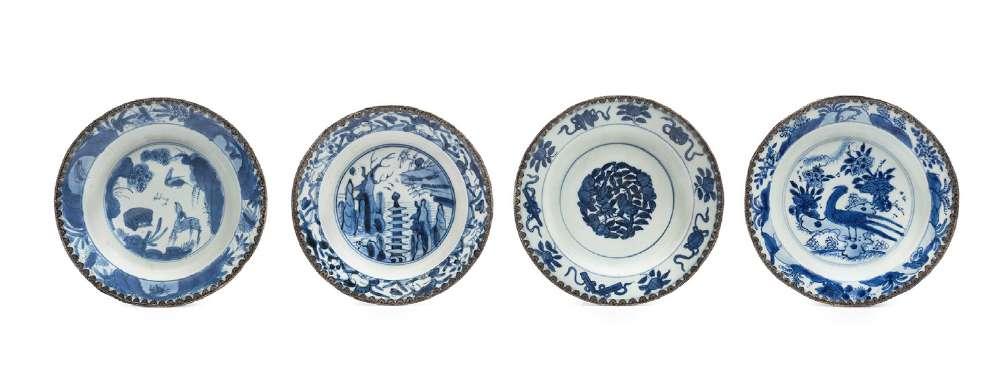
FOUR
BLUE AND
WHITE PORCELAIN DISHES,
China, Ming dynasty, Wanli period (1572-1620)
The larger d cm 20,5
€ 300 / 500
Painted to the central circular section with naturalistic landscapes featuring birds, deer, pagodas and floral motifs; the rims alternating with naturalistic landscapes and Buddhist emblems. Two examples bear a mark to the reverse. Metal rim.
QUATTRO PIATTI IN PORCELLANA BIANCA E BLU, Cina, dinastia Ming, periodo Wanli (1572-1620)
Dipinti nella sezione centrale circolare con paesaggi naturalistici raffiguranti volatili, cerbiatti, pagode e motivi floreali; sulle tese si alternano paesaggi naturalistici e oggetti della tradizione buddhista. Due esemplari recano marchio al retro. Il bordo in metallo.
明万历 青花盘(一组四件)
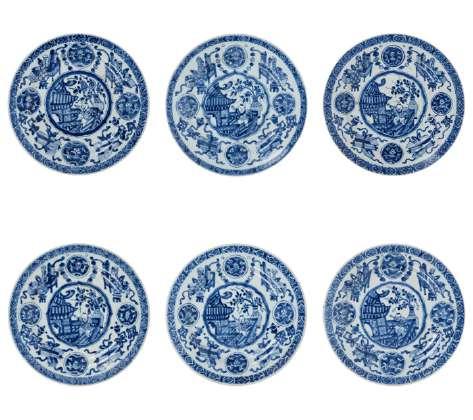
A SET OF SIX BLUE AND WHITE PORCELAIN DISHES, China, Qing dynasty, Kangxi period (1661-1722)
€ 1.000 / 1.500
Painted in various shades of blue, with a central lobed medallion enclosing a dancing boy on a terrace, surrounded by Buddhist emblems and precious objects; the exterior decorated with stylized flowering branches. Provenance: Private collection, Tuscany. Catalogue notes: An identical pair was sold at Christie’s, Christie’s Interiors, live auction, 9 November 2011, London, lot no. 814.
SET DI SEI PIATTI
IN PORCELLANA BIANCA E BLU, Cina, dinastia Qing, periodo Kangxi (1661-1722)
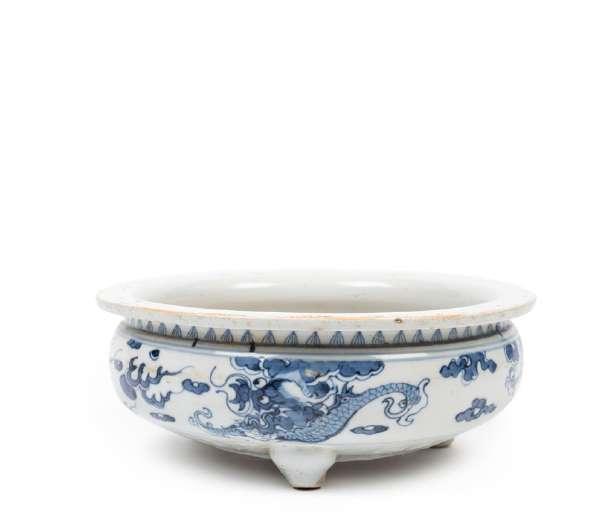
Dipinti in diverse tonalità di blu, con un medaglione lobato centrale che racchiude un fanciullo danzante su una terrazza, circondato da emblemi buddhisti e oggetti preziosi; l’esterno decorato con rami fioriti stilizzati. Provenienza: collezione privata, Toscana. Note di catalogo: una coppia identica è stata venduta da Christie’s, asta live, Christie’s Interiors, 9 Novembre 2011, londra, lot. n° 814.
A BLUE AND WHITE PORCELAIN TRIPOD CENSER, China, Qing dynasty, 19th century
d cm 22 d cm 21
€ 150 / 200
Painted with a dragon amid stylized clouds chasing the pearl.
INCENSIERE TRIPODE
IN PORCELLANA BIANCO E BLU, Cina, dinastia Qing, XIX secolo
Dipinto con un drago tra nuvole stilizzate che insegue la perla.
清19世纪 青花云龙纹三足炉
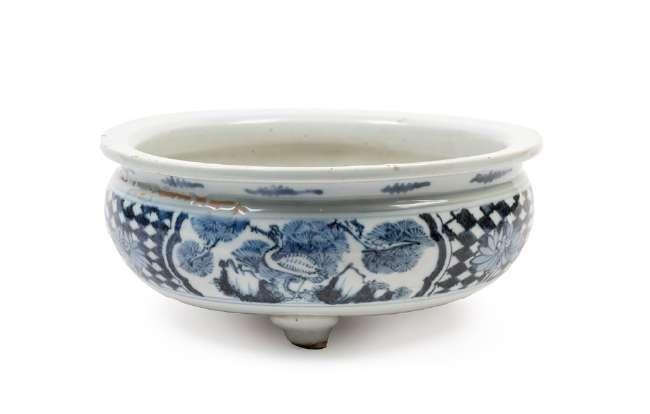
A BLUE AND WHITE PORCELAIN TRIPOD CENSER, China, 17th century
h cm 10,5 x d cm 26
€ 500 / 700
The body is decorated with a horizontal band featuring lobed reserves depicting cranes in naturalistic landscapes, alternating with lotus motifs set against a geometric ground.
INCENSIERE TRIPODE IN PORCELLANA BIANCA E BLU, Cina, XVII secolo
Il corpo è decorato con una fascia orizzontale con riserve lobate raffiguranti gru in paesaggi naturalistici, intervallate da motivi di fiori di loto su fondo geometrico.
A
PORCELAIN
DISH
MADE FOR THE OTTOMAN MARKET, China, Qing dynasty, Qianlong period (1735-1796)
l cm 29
€ 500 / 800
Of shallow rounded form on a short foot, the exterior decorated with four white oblong cartouches bearing Qur’anic inscriptions in gold, outlined in red and green enamel, set against a cobalt-blue ground with gilded crescents and stars. The rim features a white band with further Qur’anic inscriptions in gold, while the foot is encircled by a narrow band of green and red enamelled chrysanthemums. The white interior is detailed with concentric blue circles and two bands of Qur’anic inscriptions, the centre with the shahada in large gilded naskh script. For an almost identical dish, of larger size, see: Christie’s, Live Auction 6940, Islamic Art and Manuscripts, 12 October 2004, London, lot no. 136.
PIATTO IN PORCELLANA REALIZZATO PER IL MERCATO OTTOMANO, Cina, dinastia Qing, periodo Qianlong (1735-1796)
Di forma bassa e arrotondata su piede corto, l’esterno è decorato con quattro cartigli oblunghi bianchi recanti iscrizioni coraniche in oro, contornati da smalti rossi e verdi, su fondo blu cobalto con lune e stelle dorate. Il bordo presenta una fascia bianca con ulteriori iscrizioni coraniche in oro, mentre il piede è circondato da una stretta fascia di crisantemi smaltati in verde e rosso. L’interno bianco è decorato con cerchi concentrici blu e due fasce di iscrizioni coraniche, al centro la shahada in grande scrittura naskh dorata. Per un piatto quasi identico, di misura più grande, si guardi: Christie’s, Live Auction 6940, Islamic Art and Manuscripts, 12 Ottobre 2004, Londra, lot. n° 136.
清乾隆 阿拉伯文大盘
A ‘BENJARONG’ ‘BODHISATTVA’ EXPORT PORCELAIN BOWL,
China for the Kingdom of Siam, 19th century
d cm 14,5
€ 400 / 600
With strongly rounded sides rising from a low ring foot to a flared rim, the exterior is decorated with alternating figures of Norasingh and Thepanom angels amid scrolling foliage left in reserve on a black ground. The interior is glazed green with a central medallion, while the rim features floral bands. Provenance: Private collection, Tuscany. Catalogue notes: See a similar bowl at the Victoria and Albert Museum, inventory no. IS.31-1887. Also see the related bowl sold at Sotheby’s, Arts d’Asie Online, 3–9 November 2021, Paris, lot no. 23.
CIOTOLA DA ESPORTAZIONE IN PORCELLANA BENJARONG, Cina per il regno del Siam, XIX secolo
Con lati fortemente arrotondati che si elevano da un piede ad anello basso a un orlo svasato, l’esterno è decorato con figure alternate di Norasingh e angeli Thepanom tra volute di fogliame lasciate a riserva su fondo nero. L’interno è smaltato di verde con un medaglione centrale, mentre l’orlo presenta fasce floreali. Provenienza: collezione privata, Toscana. Note di catalogo: Si veda la ciotola simile al Victoria and Albert Museum, numero di inventario IS.31-1887. Si veda anche la ciotola simile venduta da Sotheby’s, Arts d’Asie Online, 3-9 Novembre 2021, Parigi, lot. n° 23.
出口瓷碗 19世纪暹罗王国的瓷器
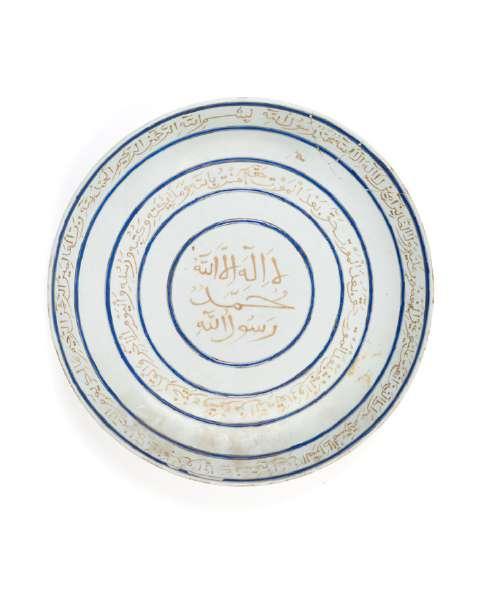
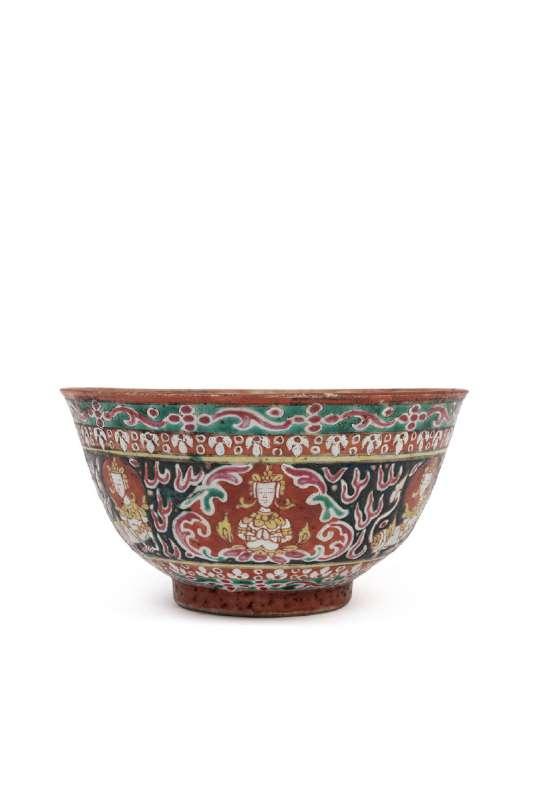
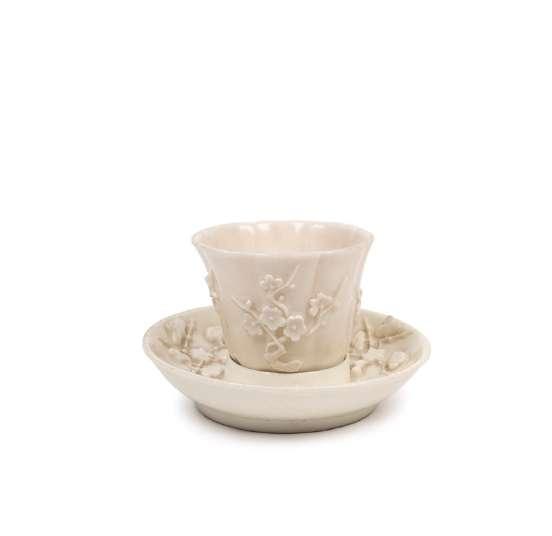
A DEHIA PORCELAIN CUP WITH SAUCER, China, Qing dynasty, 18th century
h cm 6 x l cm 12,4
€ 500 / 800
Decorated in relief with flowering trees.
TAZZINA CON PIATTINO IN PORCELLANA DEHUA, Cina, dinastia Qing, XVIII secolo
Decorati a rilievo con alberi fioriti.
清18世纪 德化白瓷梅花纹杯碟

A ORMOLU MOUNTED BLANC DE CHINE PORCELAIN LIBATION CUP, China, Qing dynasty, Kangxi period (1661-1722)
h cm 7,1
€ 200 / 300
Modeled in relief with plum blossoms and tendrils.
COPPA DA LIBAGIONE IN PORCELLANA BLANC DE CHINE MONTATA IN BRONZO, Cina, dinastia Qing, periodo Kangxi (1661-1722)
Modellate a rilievo con fiori di pruno e viticci.
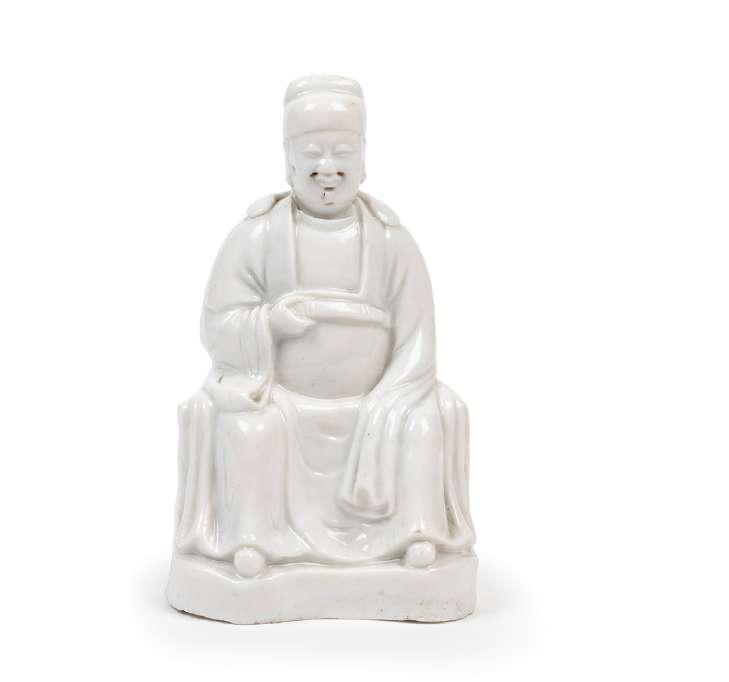
清康熙 德化窑白釉贴塑花卉纹杯
66
A BLANC-DE-CHINE PORCELAIN FIGURE, China, Qing dynasty, Kangxi period (1661-1722)
h cm 16,1
€ 200 / 300
Depicting Wenchang Wang seated.
Provenance: private collection, Tuscany.
FIGURA IN PORCELLANA BLANC-DE-CHINE, Cina, dinastia Qing, periodo Kangxi (1661-1722)
Raffigurante Wenchang Wang seduto.
Provenienza: collezione privata, Toscana.
清康熙 白瓷人物坐像
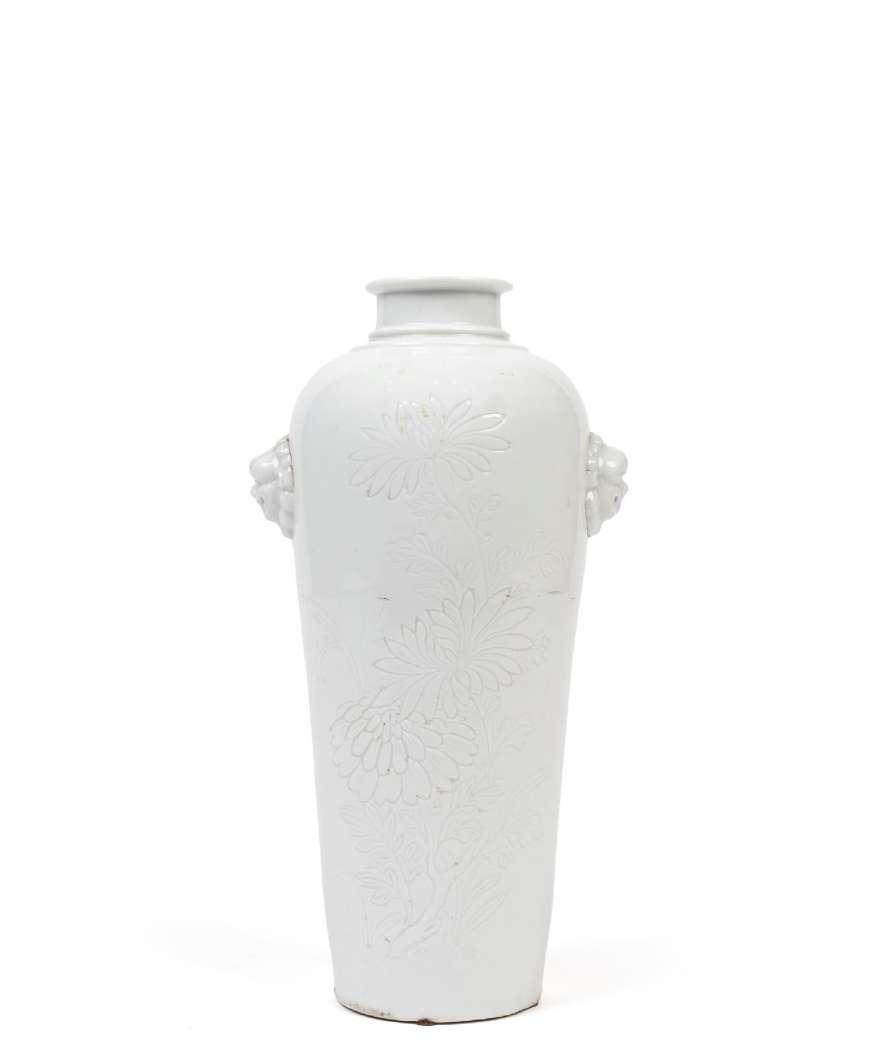
A
DEHUA PORCELAIN ‘SLEEVE’ VASE, China, Transitional period, 17th century
h cm 24
67 € 400 / 600
Tall and slender in form, with two lion-head handles, the body decorated in anhua technique with chrysanthemums. Provenance: Private collection, Tuscany. Catalogue notes: A very similar vase was sold at Christie’s, live auction 5497, Chinese Ceramics, Works of Art and Textiles, 14 May 2010, London, lot no. 516. 17
VASO IN PORCELLANA DEHUA, Cina, periodo di Transizione, XVII secolo
Di forma alta e rastremata, con due anse a testa di leone, decorata con tecnica anhua sul corpo con crisantemi. Provenienza: collezione privata, Toscana. Note di catalogo: un vaso molto simile è stato venduto da Christie’s, asta live 5497, Chinese Ceramics, Works of Art and Textiles, 14 Maggio 2010, Londra, lot. n° 516.
世纪过渡期 德化白釉狮耳瓶
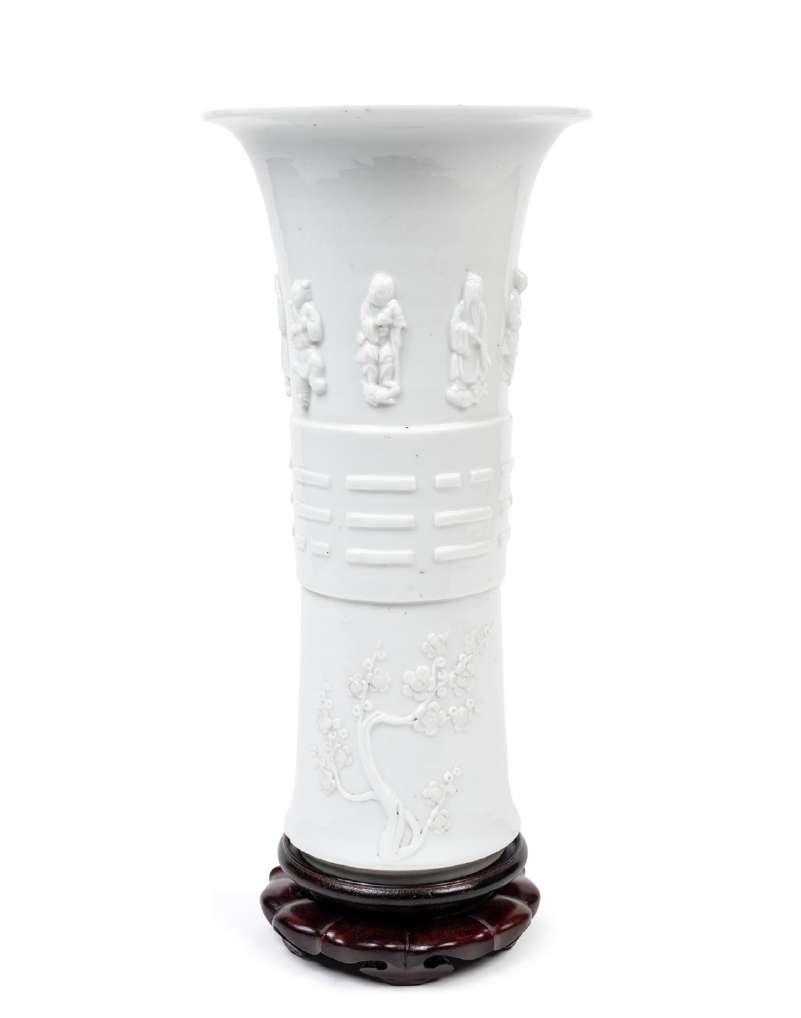
68
A DEHUA PORCELAIN BEAKER VASE,
GU, China, Qing dynasty, Kangxi period (1661-1722)
h cm 31
€ 500 / 800
With a flaring trumpet mouth, the vessel is decorated in relief with the Eight Immortals above a band modelled with trigram motifs, and further adorned below with a branch of flowering prunus. The slightly inset foot surrounds a recessed base.
Provenance: private collection, Tuscany.
Catalogue note: An almost identical vase is illustrated in P. J. Donnelly 1969, Blanc de Chine, London, pl. 52A (centre), and discussed on p. 111. See also a smaller vase of almost identical design, with pierced trigram decoration, sold at Bonhams, Asian Decorative Works of Art, 5–15 April 2021, Los Angeles, lot no. 26.
VASO IN PORCELLANA DEHUA, Cina, dinastia Qing, periodo Kangxi (1661-1722)
Dalla forma arcaitica gu con bocca svasata a tromba, presenta in rilievo gli Otto Immortali al di sopra di una fascia modellata con trigrammi; decorato inferiormente con un ramo di pruno in fiore. Il piede, leggermente incassato, circonda una base ribassata.
Provenienza: collezione privata, Toscana.
Note di catalogo: Un vaso quasi identico è illustrato in Donnelly P. J. 1969, Blanc De Chine, London, plate 52A (al centro) discusso a pag. 111. Si veda un vaso più piccolo quasi identico coi trigrammi forati venduto da Bonhams, Asian Decorative Works of Art, 5-15 Aprile 2021, Los Angeles, lot. n° 26.
清康熙 德化白瓷花觚
A PORCELAIN FIGURE,
China, Qing dynasty, 18th century
h cm 31 x l cm 20
€ 1.800 / 2.200
Modelled in the form of a rooster perched upon a rock.
FIGURA IN PORCELLANA, Cina, dinastia Qing, XVIII secolo
Modellato a forma di gallo che si poggia su una roccia.
清18世纪 雄鸡瓷塑摆件
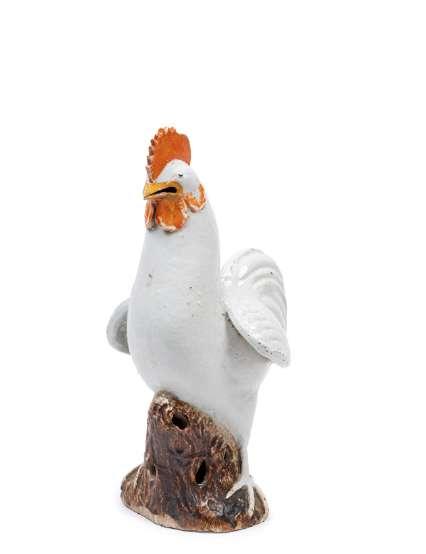

A PAIR OF PORCELAIN FIGURE, China, Qing dynasty, 18th century
h cm 39,5 x l cm 23
70 € 5.000 / 7.000
Well modelled in a naturalistic manner as roosters perched upon a rock, their feathers finely incised to create a realistic effect.
COPPIA DI FIGURE IN PORCELLANA, Cina, dinastia Qing, XVIII secolo
Ben modellati in maniera naturalistica a forma di gallo che si poggiano su una roccia, le piume sono incise a simulare un effetto realistico.
清18世纪 一对雄鸡瓷塑摆件

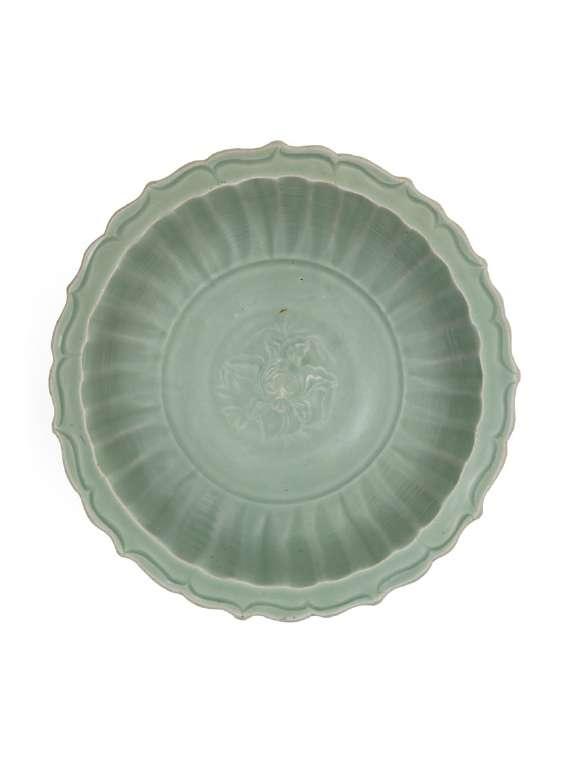
71
A CELADON PORCELAIN PLATE, China, Ming dynasty (1368-1644)
d cm 34,5
€ 400 / 600
Carved at the center with a large stylized lotus flower; the rim features radiating molded panels.
Provenance: Private collection, Tuscany.
PIATTO IN PORCELLANA CELADON, Cina, dinastia Ming (1368-1644)
Intagliato al centro con un grande fiore di loto stilizzato, il bordo presenta pannelli modellati a raggera.
Provenienza: collezione privata, Toscana.
明 青瓷盘
72
A LARGE LONGQUAN CELADON BARBED-RIM DISH, China, Ming
dynasty,
15th century
d cm 33,5
€ 500 / 700
The interior is decorated at the center with a finely carved peony, surrounded by radiating petals beneath a petal-tipped rim, and entirely covered with a lustrous seagreen glaze, continuing along the rim of the foot, where an unglazed ring at the base oxidized during firing, taking on a dark orange hue. Provenance: Private collection, Tuscany. Catalogue notes: See the very similar dish sold at Christie’s, online auction 19566, The Art of China, 21–28 May 2020, London, lot no. 31.
GRANDE PIATTO IN PORCELLANA CELADON, Cina, dinastia Ming, XV secolo
Decorato al centro dell’interno con una peonia finemente intagliata, circondato da petali radianti sotto un orlo a punte di petalo, e completamente ricoperto da uno smalto untuoso di colore verde mare, che continua lungo il bordo del piede, dove un anello non smaltato alla base si è ossidato durante la cottura assumendo un colore arancione scuro. Provenienza: collezione privata, Toscana. Note di catalogo: si veda il piatto molto simile venduto da Christie’s, asta online 19566, The Art of China, 21-28 Maggio 2020, Londra, lot. n° 31.
明 青瓷盘
A LONGQUAN CELADON ‘TWIN
FISH’ PORCELAIN DISH,
China, Song dynasty (960-1279)
d cm 22
€ 150 / 200
With shallow, rounded sides rising to a wide flat rim, the interior features two molded scaly fish swimming in opposite directions, while the exterior is carved with lotus petals radiating upward from the foot. The piece is entirely covered with a semi-transparent sea-green glaze, neatly finishing around the unglazed orange foot.
Provenance: Private collection, Tuscany.
PIATTO “TWIN FISH” IN PORCELLANA CELADON, Cina, dinastia Song (960-1279)
Con lati poco profondi e arrotondati che si elevano verso un ampio orlo piatto, l’interno presenta due pesci squamosi modellati a stampo che nuotano in direzioni opposte, mentre l’esterno è intagliato con petali di loto che si irradiano verso l’alto dal piede. Il tutto è ricoperto da uno smalto semi-trasparente di colore verde mare, che termina ordinatamente attorno al piede non smaltato di colore arancio.
Provenienza: collezione privata, Toscana.
宋 青瓷双鱼纹盘
A LONGQUAN CELADON
‘TWIN FISH’ DISH, China, Yuan - Ming period
d. 19.2 cm
€ 750 / 850

The rounded sides rising from the tapered foot to the everted rim are sculpted on the outside with a band of petals, while the centre of the interior is decorated in relief with two small fish, all under a green glaze that also covers the inside of the foot.
Provenance: a private collection from Rome.
PIATTO LONGQUAN CELADON, Cina, periodo Yuan - Ming
I lati arrotondati che salgono dal piede affusolato all’orlo estroflesso sono scolpiti all’esterno con una fascia di petali, mentre il centro dell’interno è decorato a rilievo con due piccoli pesci, il tutto sotto una glassa di colore verde che ricopre anche l’interno del piede.
Provenienza: collezione privata Roma. 元明 龙泉青瓷盘
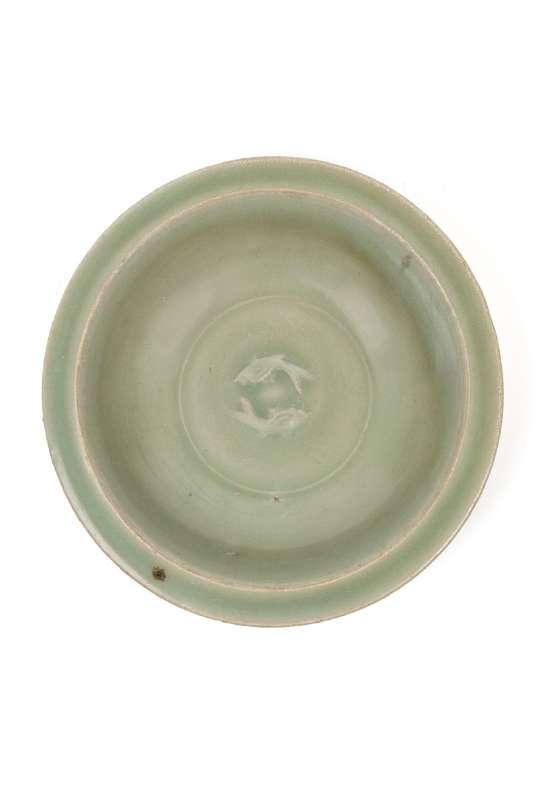
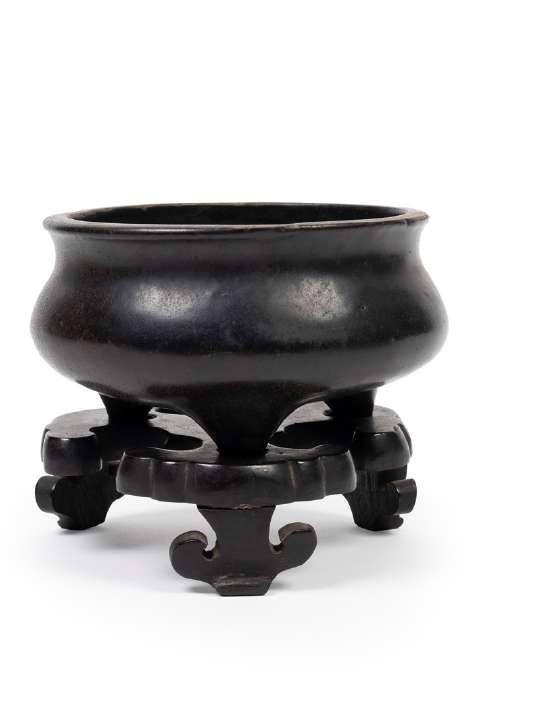
A CERAMIC TRIPOD CENSER,
China, Qing dynasty, 18th / 19th century
d. 12 cm
€ 200 / 300
It rests on three small legs and is completely covered in brown enamel. It stands on its wooden base.
INCENSIERE IN CERAMICA, Cina, dinastia Qing, XVIII / XIX secolo
Si poggia su tre piccole gambe, è completamente ricoperto da uno smalto marrone. Poggia sulla sua base in legno.
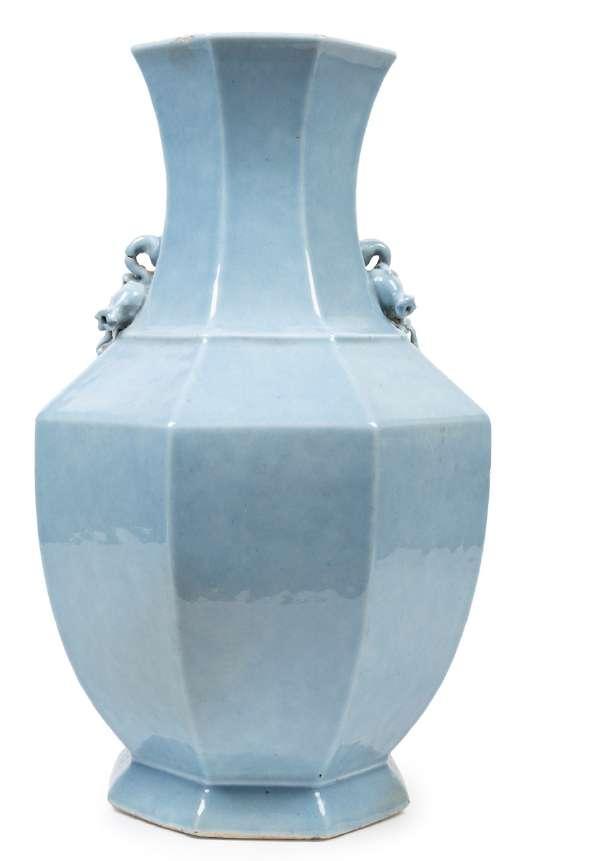
A ‘CLAIR DE LUNE’ PORCELAIN VASE, China, 19th / 20th century
h cm 44,5
€ 1.000 / 1.500
Of octagonal form, it is covered with a light blue enamel and features pomegranate-shaped handles.
VASO IN PORCELLANA CLAIR DE LUNE, Cina, fine XIX secolo / inizio XX secolo
Di forma ottagonale, è ricoperto da uno smalto color azzurro, con anse a forma di melograno.
A ‘CLAIR DE
LUNE’
VASE,
China, Qing Dynasty, late 19th century
h. 28.3 cm
77 € 250 / 300
Shaped with a raised foot, an oval body and a short, flared neck, the handles have two loops in the shape of heads; it is completely covered on the outside with a blue enamel, in the centre of the white base it bears the six-character apocryphal mark in underglaze blu of the Kangxi Emperor.
VASO IN PORCELLANA ‘CLAIR DE LUNE’, Cina, dinastia Qing, fine XIX secolo
Dalla forma con piede rialzato, corpo ovale e collo corto e svasato, ai manici presenta due anse a forma di teste; è completamente ricoperto all’esterno da uno smalto azzurro, al centro della base bianca presenta il marchio apocrifo a sei caratteri in blu sotto coperta dell’Imperatore Kangxi.
清 天蓝釉双耳尊

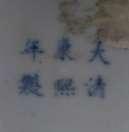
A
CLAIR-DE-LUNE PORCELAIN VASE, China, early 20th century
h cm 26
78 € 300 / 500
Of classic bottle form, with a globular body rising to a slender neck with a slightly flared mouth, entirely covered with a blue glaze. The base bears a six-character underglaze blue mark of the Kangxi Emperor.
VASO IN PORCELLANA CLAIR-DE-LUNE, Cina, inizio XX secolo
Dalla classica forma a bottiglia, con il corpo globulare che si innalza in un collo sottile con bocca leggermente svasata ed è completamente ricoperto da una smaltatura azzurra. Alla base reca un marchio a sei caratteri in blu sottocoperta dell’Imperatore Kangxi.
20世纪初 天青釉长颈瓶

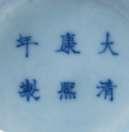
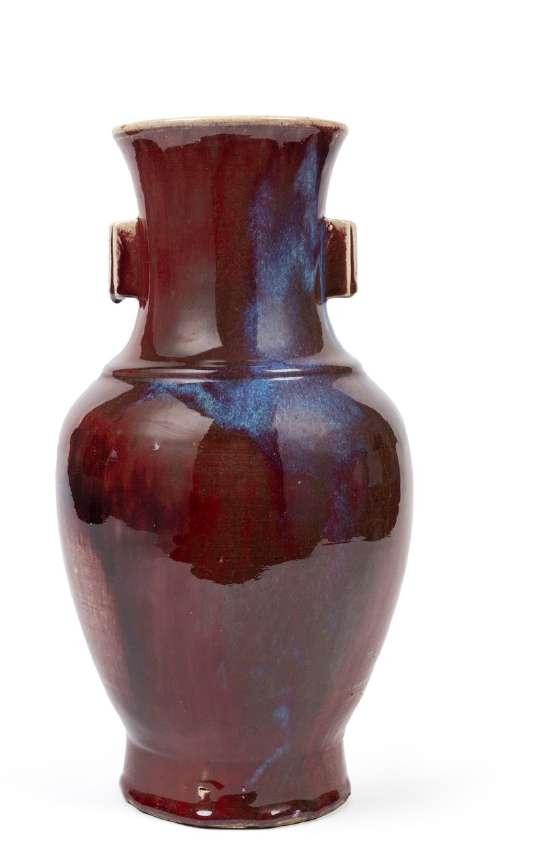
A ‘FLAMBE’ PORCELAIN VASE, China, Qing dynasty, early 19th century
h cm 41
€ 500 / 800
Completely covered in a red glaze with bluish streaks.
VASO IN PORCELLANA FLAMBÈ, Cina, dinastia Qing, inizio XIX secolo
Completamente ricoperti da uno smalto rosso con striature bluastre.
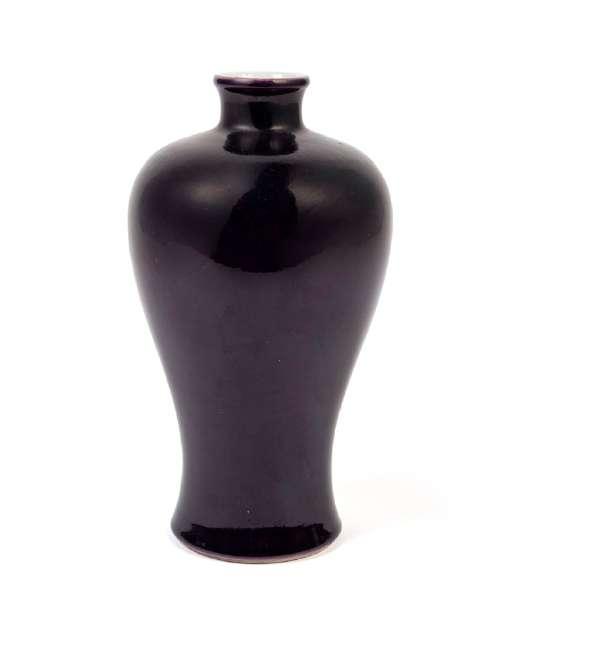
AN AUBERGINE-GLAZED VASE ‘MEIPING’, China, Qing dynasty, 18th century
h cm 18,5
€ 500 / 800
It is entirely covered with a beautiful deep violet glaze.
VASO IN PORCELLANA MONOCROMA MELANZANA, Cina, dinastia Qing, XVIII secolo
Dalla forma Meiping, è interamente ricoperto da un bello smalto color viola intenso.
清18世纪 茄皮紫釉梅瓶
清19世纪初 窑变釉花瓶

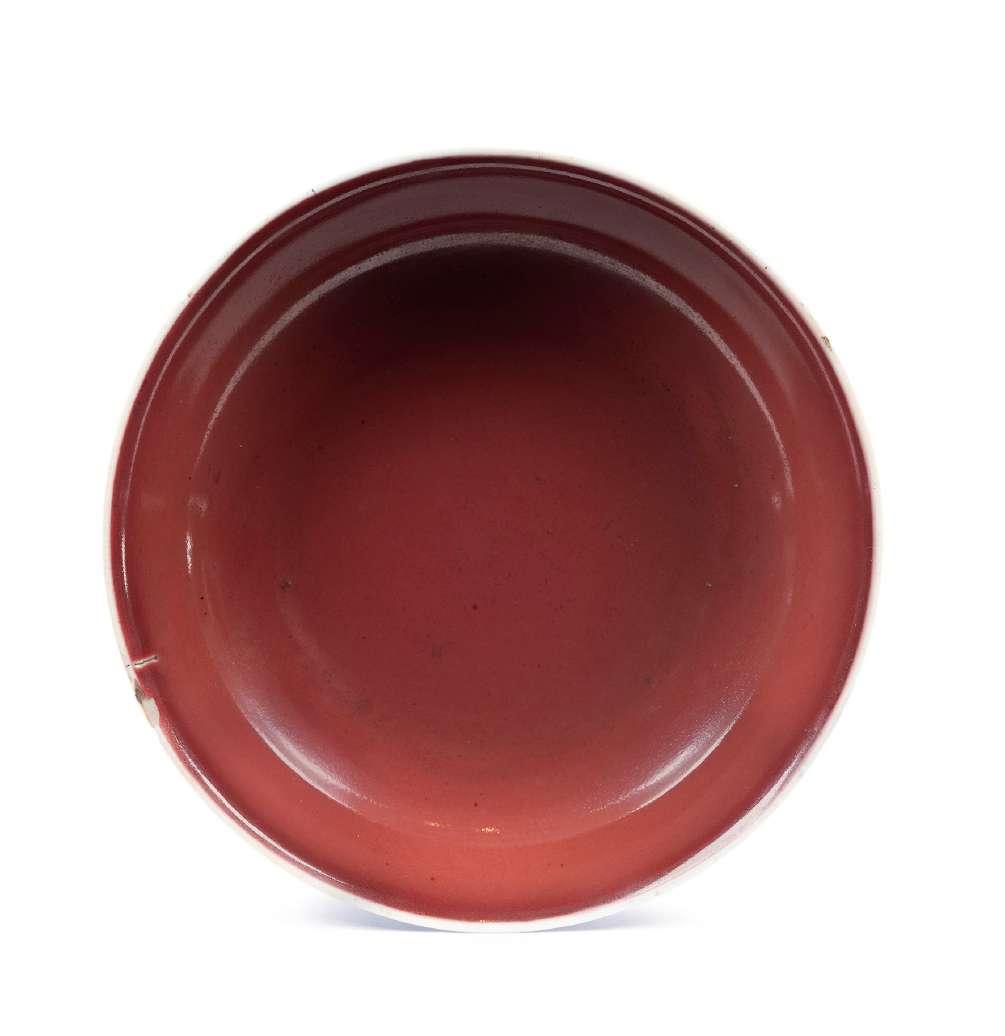
A COPPER-RED-GLAZED PORCELAIN DISH,
China, Qianlong (1735-1796) mark and period
d cm 18,1
81 € 1.500 / 2.000
With rounded sides rising from a short foot, both the interior and exterior covered with a iron-red glaze below the white rim; the base bears a six-character underglaze blue mark of the Qianlong Emperor. With wooden base.
Provenance: from a private collection, Rome.
Catalog notes: An almost identical slightly smaller dish have been sold in Bonhams, Fine Chinese Ceramics and Works of Art, 20 May 2024, Hong Kong, lot. n. 305.
PIATTO
IN PORCELLANA
MONOCROMA,
Cina, marchio e periodo Qianlong (1735-1796)
Con i lati arrotondati che si innalzano da un piede corto, sia l’interno che l’esterno coperti da una smaltatura di tonalità rosso ferro sotto il bordo bianco; alla base reca marchio a sei caratteri in blu sottocoperta dell’Imperatore Qianlong. Con base in legno.
Provenienza: da una collezione privata, Roma.
Note di catalogo: Un piatto quasi identico leggermente più piccolo è stato venduto da Bonhams, Fine Chinese Ceramics and Works of Art, 20 maggio 2024, Hong Kong, lot n° 305.
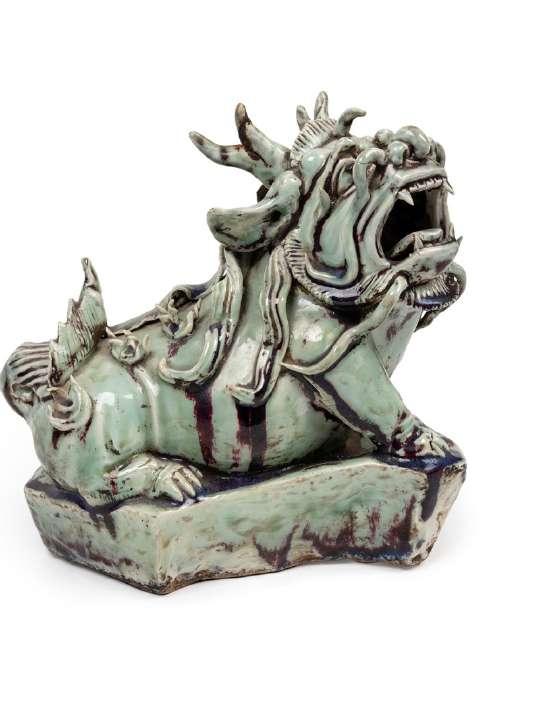
82
A PORCELAIN PHO DOG, China, Qing dynasty, 19th century
h cm 25
€ 400 / 600
In monochrome porcelain, seated on a rock while showing its fangs.
Provenance: Private collection, Liguria.
CANE DI PHO IN PORCELLANA, Cina, dinastia Qing, XIX secolo
In porcellana monocroma, in posizione seduta su una roccia mentre mostra le fauci.
Provenienza: collezione privata, Liguria
清 麒麟瓷塑
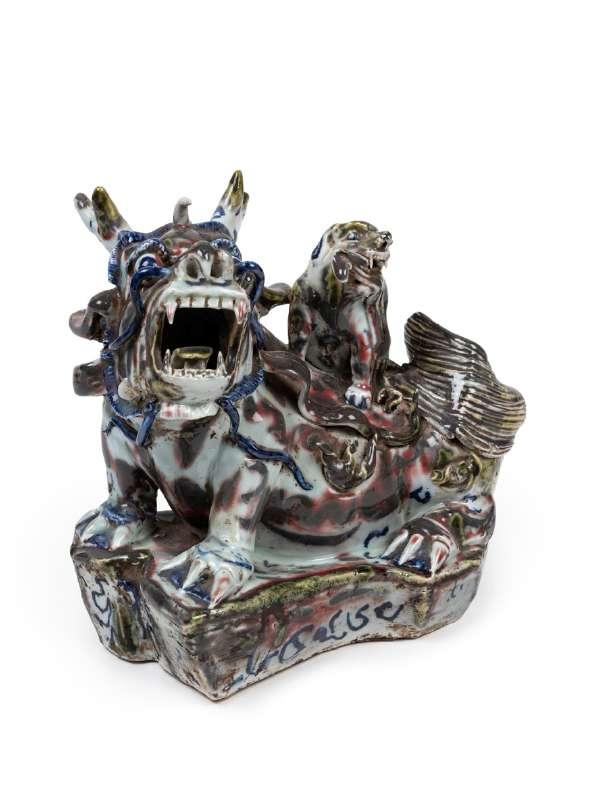
83
A PORCELAIN PHO DOG, China, Qing dynasty, 19th century
h cm 23,5
€ 400 / 500
Entirely glazed in polychrome, depicted seated on a rock, with its jaws wide open and a cub resting on its back.
Provenance: Private collection, Liguria.
CANE DI PHO IN PORCELLANA, Cina, dinastia Qing, XIX secolo
Interamente invetriato in policromia, raffigurato seduto su una roccia, con le fauci spalancate e il cucciolo adagiato sul dorso.
Provenienza: collezione privata, Liguria.
清 麒麟瓷塑
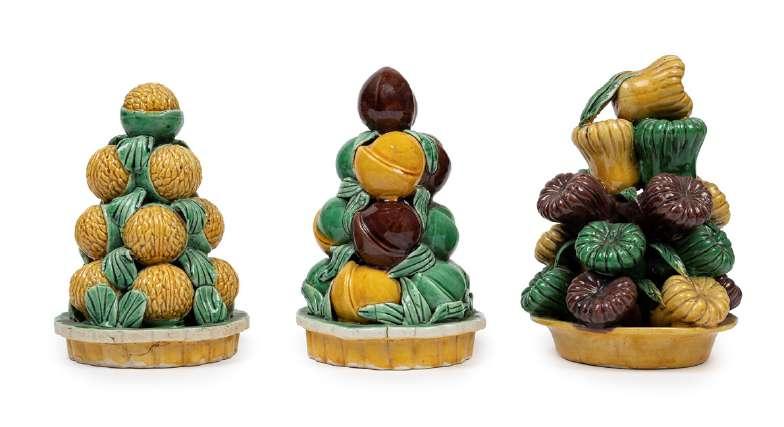
THREE FAMILLE VERTE PORCELAIN ‘FRUITS’ PYRAMID, China, Qing dynasty, Kangxi period (1661-1722)
The larger h cm 17
€ 800 / 1.200
One depicting lychees and a peach, the other pumpkins. Provenance: Private collection, Tuscany. Catalogue notes: See the pair of lychee pyramids sold at Sotheby’s, Asian Art / 5000 Years, June 17–25, 2025, New York, lot no. 22.
TRE PIRAMIDI DI FRUTTA IN PORCELLANA FAMIGLIA VERDE, Cina, dinastia Qing, periodo Kangxi (1661-1722)
Una raffigurante litchi, una pesche e l’altra zucche. Provenienza: collezione privata, Toscana. Note di catalogo: Si veda la coppia di piramidi di litchi venduta da Sotheby’s, Asian Art / 5000 Years, 17-25 Giugno 2025, New York, lot. n° 22.
清康熙 一组素三彩果盘瓷塑 84
85
TWO
WUCAI
PORCELAIN VASES,
China, Qing dynasty, 19th century
h cm 18
€ 750 / 950
With a classic shape featuring a flat foot, a tapered body, and a short flared neck, they are decorated with figures in landscapes among trees, birds and rocks; at the center of the base, one of the two bears the apocryphal sixcharacter underglaze blue mark of Emperor Chenghua within a circle.
DUE VASI IN PORCELLANA WUCAI, Cina, dinastia Qing, XIX secolo
Dalla classica forma dal piede piatto, corpo rastremato e collo corto e svasato, sono decorati con personaggi in paesaggi tra alberi, uccelli e rocce; al centro della base uno dei due reca il marchio apocrifo a sei caratteri in blu sotto coperta dell’Imperatore Chenghua all’interno di un cerchio.
19世纪 五彩山水人物纹瓶两只


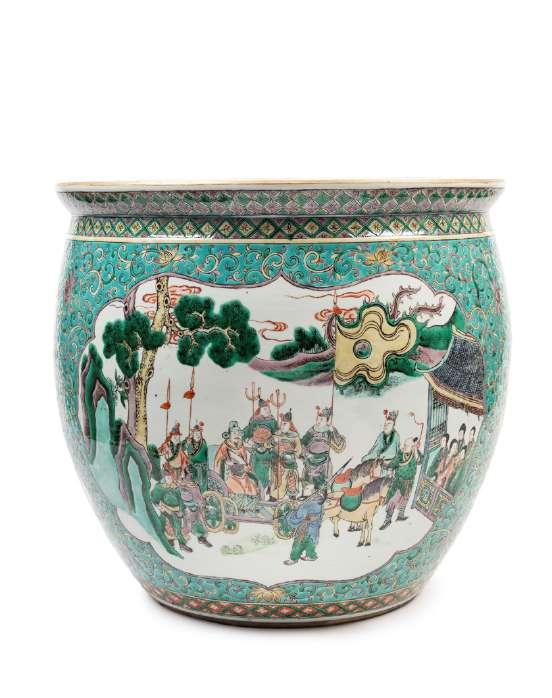
A LARGE FAMILLE VERTE BALUSTER-SHAPED PORCELAIN VASE, China, Qing dynasty, 19th century
h cm 59,5
€ 250 / 300
It is seamlessly painted with a naturalistic landscape of trees and rocks, where several figures are attempting to rescue a lady and a child seated on a boat amidst waves.
Provenance: from a private collection, Tuscany.
GRANDE VASO IN PORCELLANA FAMIGLIA VERDE, Cina, dinastia Qing, XIX secolo
Di forma a colonna di balaustra, è dipinto senza soluzione di continuità con un paesaggio naturalistico di alberi e rocce, dove alcune figure tentano di salvare una dama e un bambino seduti su un’imbarcazione tra onde.
Provenienza: collezione privata, Toscana.
清19世纪 五彩花瓶
A LARGE FAMILLE VERTE FISH-BOWL, China, Qing dynasty, 19th century
h cm 41,5 x d cm 46
€ 600 / 800
Painted on a turquoise ground with scrolling lotus and polylobed reserves: the main panels depict a procession of military figures escorting a chariot with a dignitary, and a military review with a standard-bearer in a tree-lined courtyard before soldiers and officials; the smaller panels show flowers and landscapes. The interior is finely painted with red carp among aquatic plants.
GRANDE VASCA PER PESCI IN PORCELLANA FAMIGLIA VERDE, Cina, dinastia Qing, XIX secolo
Dipinta su fondo turchese con volute di loto con riserve polilobate: le principali raffigurano un corteo di figure militari che scortano un carro con un dignitario e un’esibizione militare con un porta stendardo in un cortile alberato, di fronte a soldati e dignitari; le più piccole con fiori e paesaggi. All’interno è finemente dipinta con carpe rosse tra alghe.
清 五彩开光人物故事纹大缸
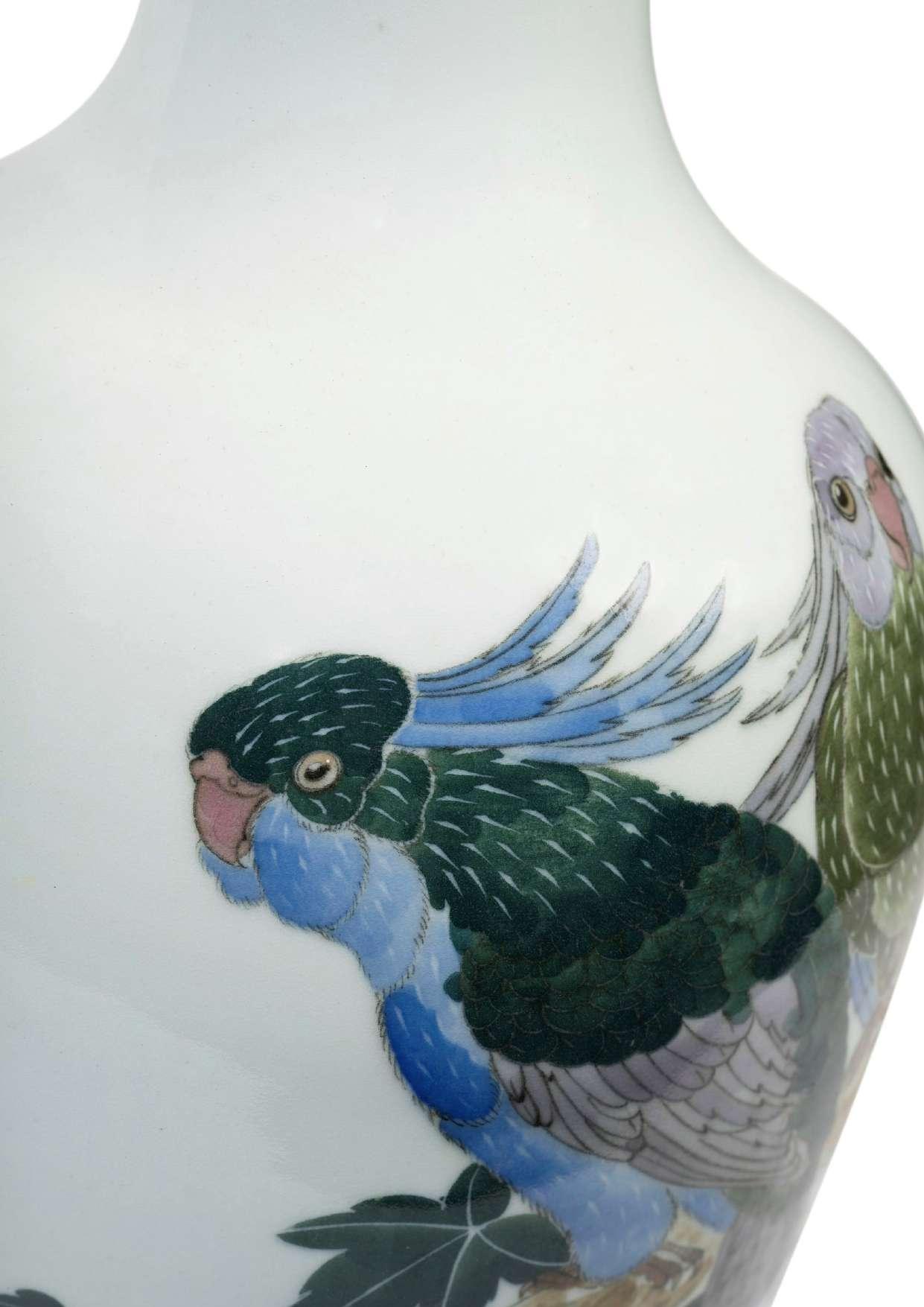
A RARE POLYCHROME PORCELAIN VASE, China, Xuantong mark and period, dated 1910
h cm 47,5
€ 300 / 500
Finely painted with two parrots perched on a stand; the base bears an underglaze blue mark reading Dà Qīng Xuāntǒng Èr Nián Húnán Cíyè Gōngsī, meaning: Hunan Ceramic Company, 2nd year of the Xuantong era (1910) of the Great Qing Dynasty (大清宣统 二年湖南瓷业公司).
Catalog notes:
In 1905, Xiong Xiling and other reformers from Hunan founded the Hunan Government Ceramic School in Liling, and the following year established the Hunan Ceramic Company, giving rise to the renowned Liling underglaze polychrome porcelains. Executed with multiple colored oxides, these wares combine traditional Chinese painting with an elegant and refined style, distinguished by great artistic expressiveness and strong visual impact. Liling porcelains have received numerous awards at international exhibitions and have enjoyed widespread acclaim in China. The present vase is an extraordinary example of this manufacture.
RARO VASO IN PORCELLANA POLICROMA,
Cina, marchio e periodo Xuantong, datato 1910
Di forma a colonna di balaustra, è finemente dipinto con due pappagalli appollaiati su un trespolo; alla base reca il marchio in blu sottocoperta Dà Qīng Xuāntǒng Èr Nián Húnán Cíyè Gōngsī, che significa: Compagnia Ceramica del Hunan, 2° anno dell’era Xuantong (1910) della Grande Dinastia Qing (大清宣统二年湖南瓷业公司).
Note di catalogo:
Nel 1905, Xiong Xiling e altri riformisti del Hunan fondarono a Liling la Scuola Ceramica Governativa del Hunan e, l’anno successivo, la Compagnia Ceramica del Hunan, dando origine alle celebri porcellane policrome sottosmalto di Liling. Realizzate con ossidi policromi multipli, queste ceramiche combinano la tradizionale pittura cinese con uno stile elegante e raffinato, caratterizzato da grande espressività artistica e forte impatto visivo. Le porcellane di Liling hanno ottenuto numerosi premi alle esposizioni internazionali e hanno riscosso notevole successo in Cina. Il presente vaso è uno straordinario esempio di questa manifattura.
清宣统 1910年 醴陵窑釉下彩绘鹦鹉撇口瓶 底款:大清宣统二年湖南瓷业公司
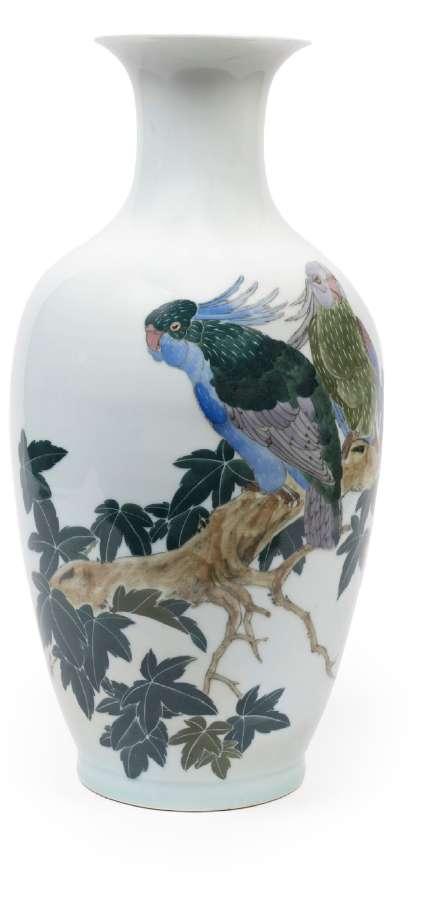
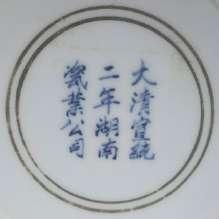
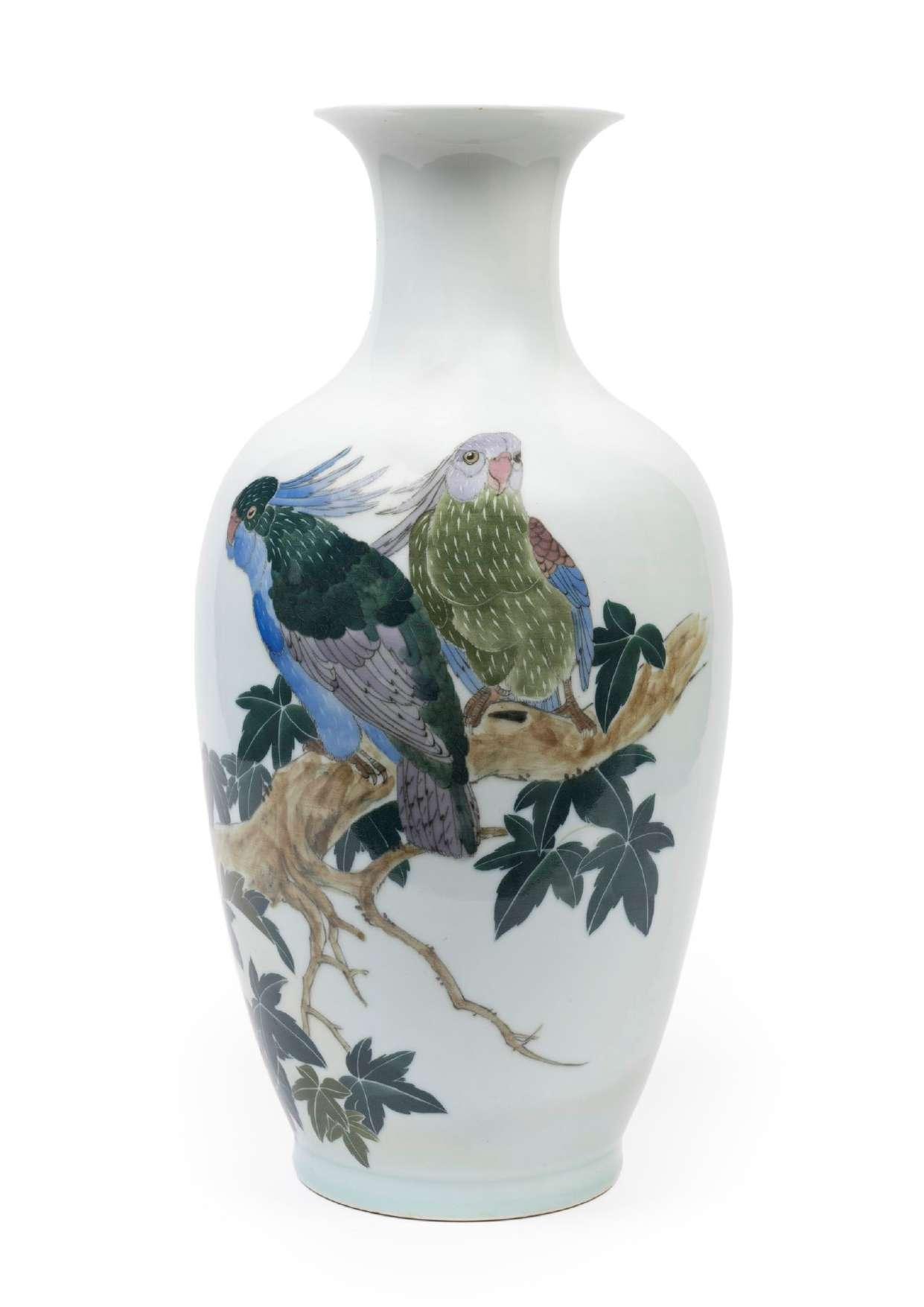
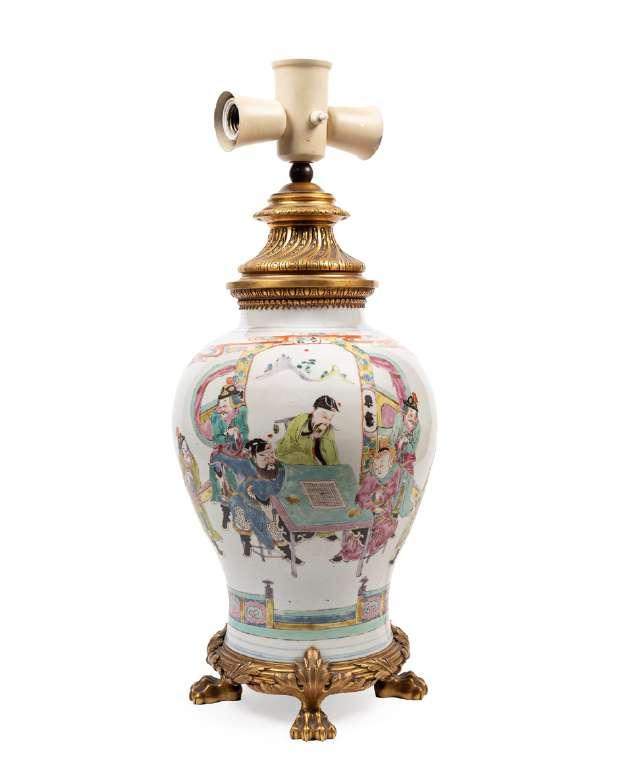
A
FAMILLE ROSE ORMULU MOUNTED PORCELAIN VASE, China, Qing dynasty, Yongzheng period (1723-1735)
h cm 34 (the vase)
€ 1.500 / 2.500
Decorated with a courtly scene: a finely dressed lady challenges a general to a game of Go, while Confucius and other sages, depicted in traditional robes, observe attentively and engage in animated discussion.
VASO IN PORCELLANA FAMIGLIA ROSA, Cina, dinastia Qing, periodo Yongzheng (1723-1735)
Decorato senza soluzione di continuità con una scena di corte: una donna elegantemente vestita sfida un generale al gioco del Go, mentre Confucio e altri saggi, raffigurati in abiti tradizionali, osservano attentamente e discutono animatamente.
清雍正 粉彩古人弈棋图瓷瓶(改装为台灯)

90
A FAMILLE ROSE
AND
GILT-DECORATED DISH,
China,
Qing dynasty, Yongzheng period (1723-1735)
d cm 23
€ 400 / 600
Finely and delicately enamelled, at the centre the scene depicts two ladies on a courtyard terrace, another figure peering through a circular window, and an attendant at the foot of a staircase, all framed by an elaborate decorative border enriched with flowers, butterflies, and gilt vegetal motifs.
Provenance: from a private collection, Tuscany.
Catalog notes: See the identical but larger plate sold at Sotheby’s, Monochrome | Important Chinese Art, London, 2 November 2022, lot no. 323.
RARO PIATTO IN PORCELLANA
FAMIGLIA ROSA CON DECORAZIONI IN ORO, Cina, dinastia Qing, periodo Yongzheng (1723-1735)
Finemente e delicatamente smaltata, la scena raffigura due dame su una terrazza di cortile, un’altra figura che osserva attraverso una finestra circolare e un attendente ai piedi di una scala, il tutto incorniciato da un elaborato bordo decorativo arricchito da fiori, farfalle e motivi vegetali in oro sopra coperta.
Provenienza: collezione privata, Toscana.
Note di catalogo: Si veda il piatto identico ma più grande venduto da Sotheby’s, Monochrome | Important Chinese Art, 2 Novembre 2022, Londra, lot. n° 323.
清雍正 粉彩西厢记人物故事图折沿盘

A RARE AND LARGE FAMILLE ROSE PORCELAIN BALUSTER-SHAPED VASE, China, Qing dynasty, Jiaqing period (1796-1820)
h cm 83
91 € 10.000 / 15.000
With a flared neck and a slightly everted rim. The neck is modelled in low relief with lotus volutes, leaves and vegetal scrolls, bats, peaches and Buddhist emblems. Two gilded dragon-head handles in the form of kui rise from the shoulders. Against a turquoise ground worked in low relief with wan motifs, the body carries relief decoration including two lateral qilong supporting the character shòu, surmounted by a bat and with two floral medallions beneath them. The principal register contains two quadrilobate panels: one a Taoist scene depicting Zhuangzi, Laozi and three masters contemplating the taiji symbol in a tree-filled garden; the other a finely painted garden with a flowering tree, songbirds, chrysanthemums and peonies among rocks and clouds. The composition is framed by raised friezes with stylized qilong, ruyi, petal motifs and meanders. Accompanied by a later carved wooden stand with floral carving and a central marble disc.
Catalogue notes:
Compare with the vase of similar size and form, likewise decorated in relief, attributed to the Jiaqing period, in the Palace Museum, Beijing, illustrated in The Complete Collection of the Treasures of the Palace Museum: Porcelains with Cloisonné Enamel Decoration and Famille Rose Enamel Decoration, Hong Kong, 1999, pp. 190–191, no. 168.
GRANDE E RARO VASO IN PORCELLANA FAMIGLIA ROSA, Cina, dinastia Qing, periodo Jiaqing (1796-1820)
Di forma a colonna di balaustro con collo svasato e orlo lievemente estroflesso. Il collo è modellato a rilievo con volute di loto, foglie e motivi vegetali, pipistrelli, pesche e simboli buddhisti. Due anse dorate a testa di draghi kui emergono dai fianchi. Il corpo, su fondo turchese interamente lavorato a bassorilievo con motivi wan, presenta decorazioni a rilievo con due qilong laterali che sorreggono il carattere shòu, sormontati da un pipistrello e al di sotto dei quali si trovano due medaglioni floreali. Il registro centrale ospita due pannelli quadrilobati: uno con scena taoista raffigurante Zhuangzi, Laozi e tre maestri in contemplazione del taiji in un giardino; l’altro con un giardino finemente dipinto con un albero in fiore, uccellini, crisantemi e peonie tra rocce e nuvole. L’insieme è incorniciato da fasce a rilievo con qilong stilizzati, ruyi, petali e greche. Accompagna il vaso uno stand in legno intagliato a motivi floreali con disco centrale in marmo, di epoca posteriore.
Note di catalogo:
Si veda il vaso dalla misura e dalla forma simile anch’esso decorato a rilievo, datato al periodo Jiaqing, conservato al Palace Museum di Pechino e illustrato in The Complete Collection of Treasure of the Palace Museum - Porcelains with Cloisonne Enamel Decoration and Famille Rose Enamel Decoration, 1999 Hong Kong, pag. 190-191, n. 168.
清嘉庆 松石绿地粉彩轧道堆塑开光花鸟人物故事图双螭龙耳大瓶


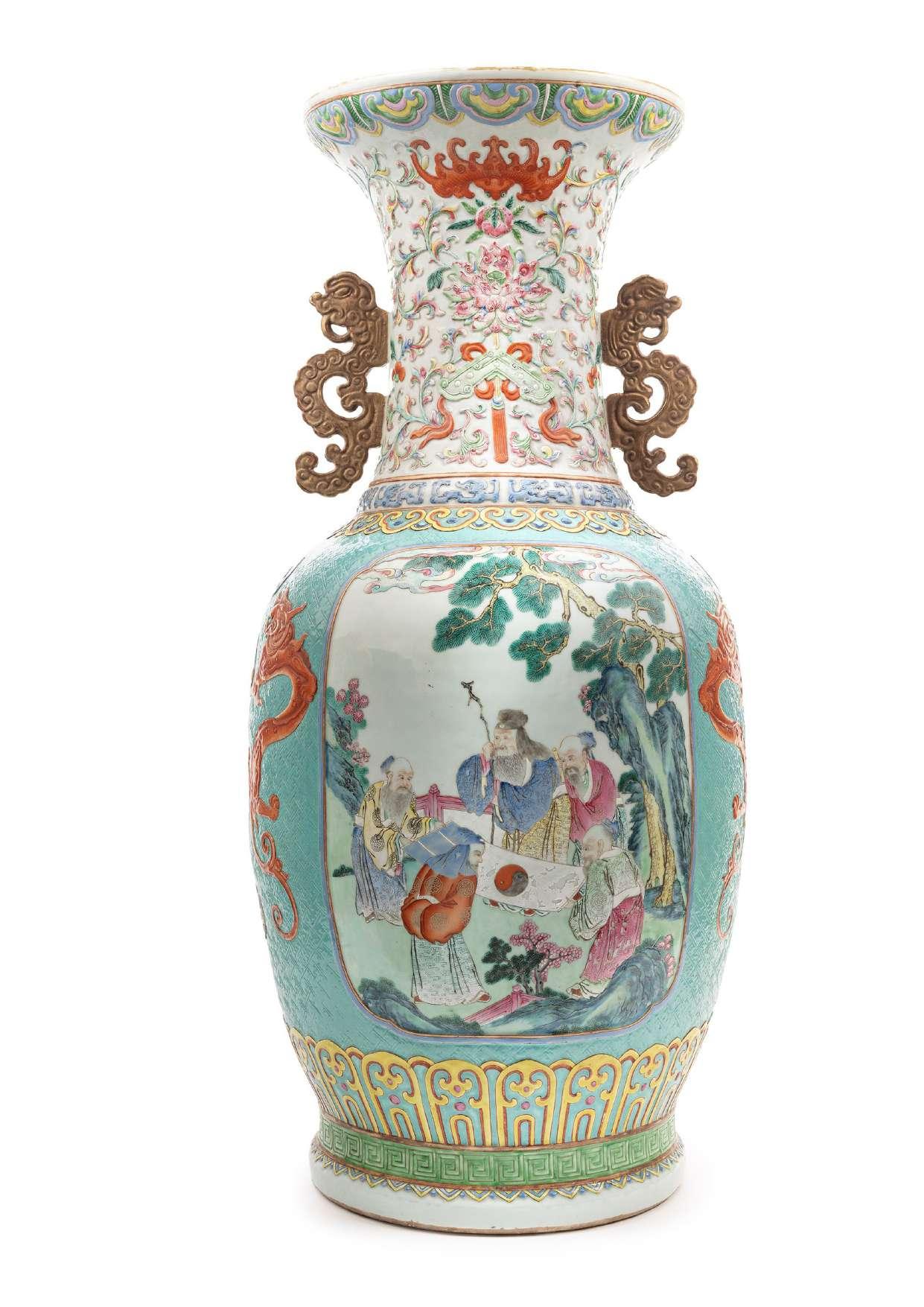


A FAMILLE ROSE PORCELAIN TIANQIUPING VASE,
China, Republic period (1912-1949)
h cm 41
92 € 3.000 / 5.000
Finely painted in a continuous scene with five bats flying above a naturalistic landscape of trees and clouds. To the center of the base a four-character iron-red mark Shen De Tang Zhi (慎德堂製).
VASO IN PORCELLANA FAMIGLIA ROSA, Cina, Repubblica di Cina (1912-1949)
Dalla forma tianqiuping, è ben dipinto senza soluzione di continuità con cinque pipistrelli in volo su un paesaggio naturalistico con alberi e nuvole. Al centro della base reca il marchio a quattro caratteri in rosso ferro Shen De Tang Zhi (慎德堂製).
民国 粉彩天球瓶 (慎德堂製)
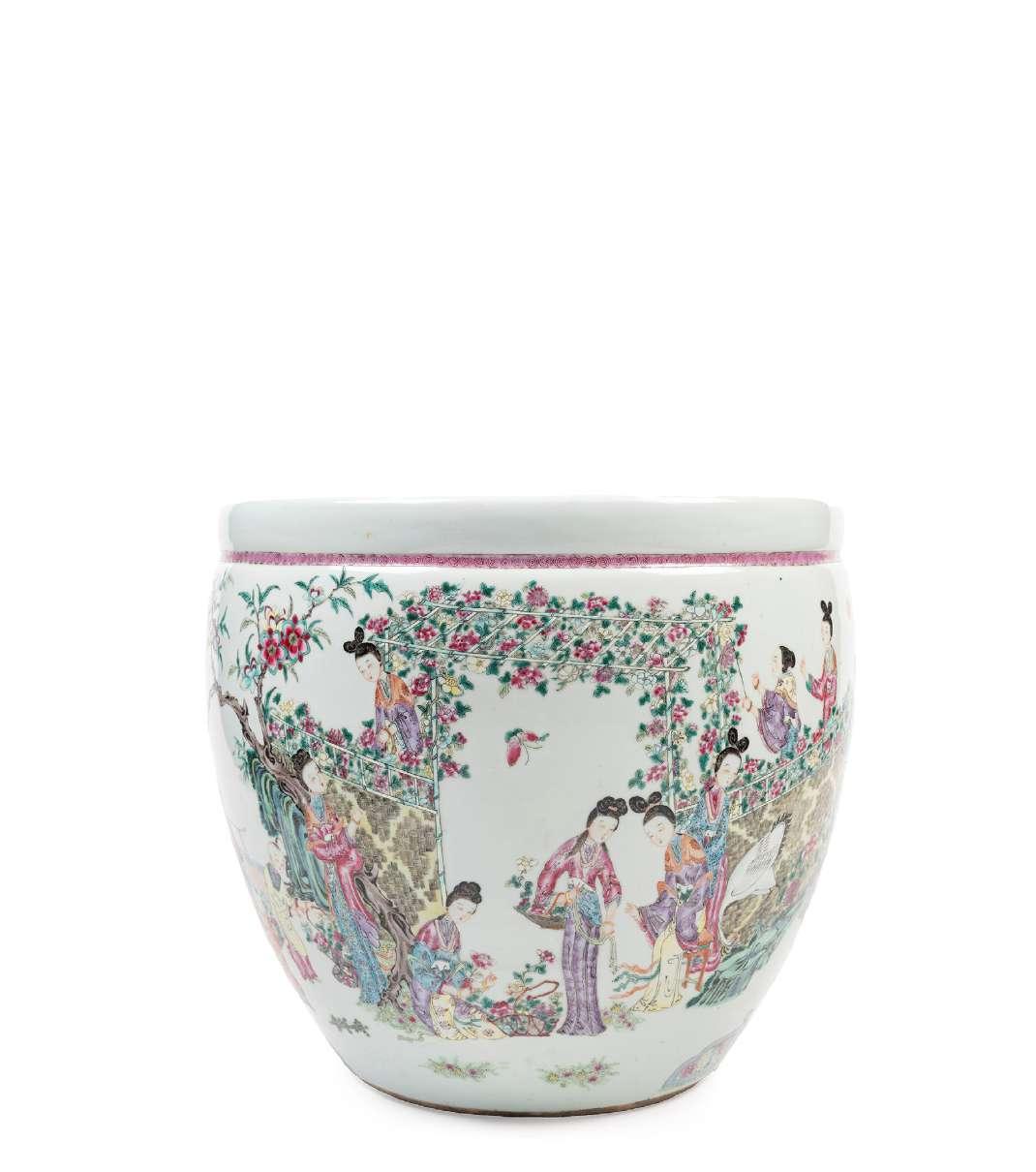
A
FAMILLE ROSE PORCELAIN CHACHEPOT,
China, Qing dynasty, 19th century
h cm 34 x d cm 38,5
€ 1.500 / 2.000
Finely painted in a continuous composition, it depicts elegantly dressed ladies and children gathering flowers in a lush natural landscape with blossoming trees, herons, and a pond dotted with peonies.
CACHEPOT IN PORCELLANA FAMIGLIA ROSA, Cina, dinastia Qing, XIX secolo
Finemente dipinta senza soluzione di continuità, la composizione raffigura dame elegantemente vestite e bambini che raccolgono fiori in un rigoglioso paesaggio naturalistico con alberi in fiore, aironi e uno stagno punteggiato di peonie. 清19世纪 粉彩人物故事纹卷缸

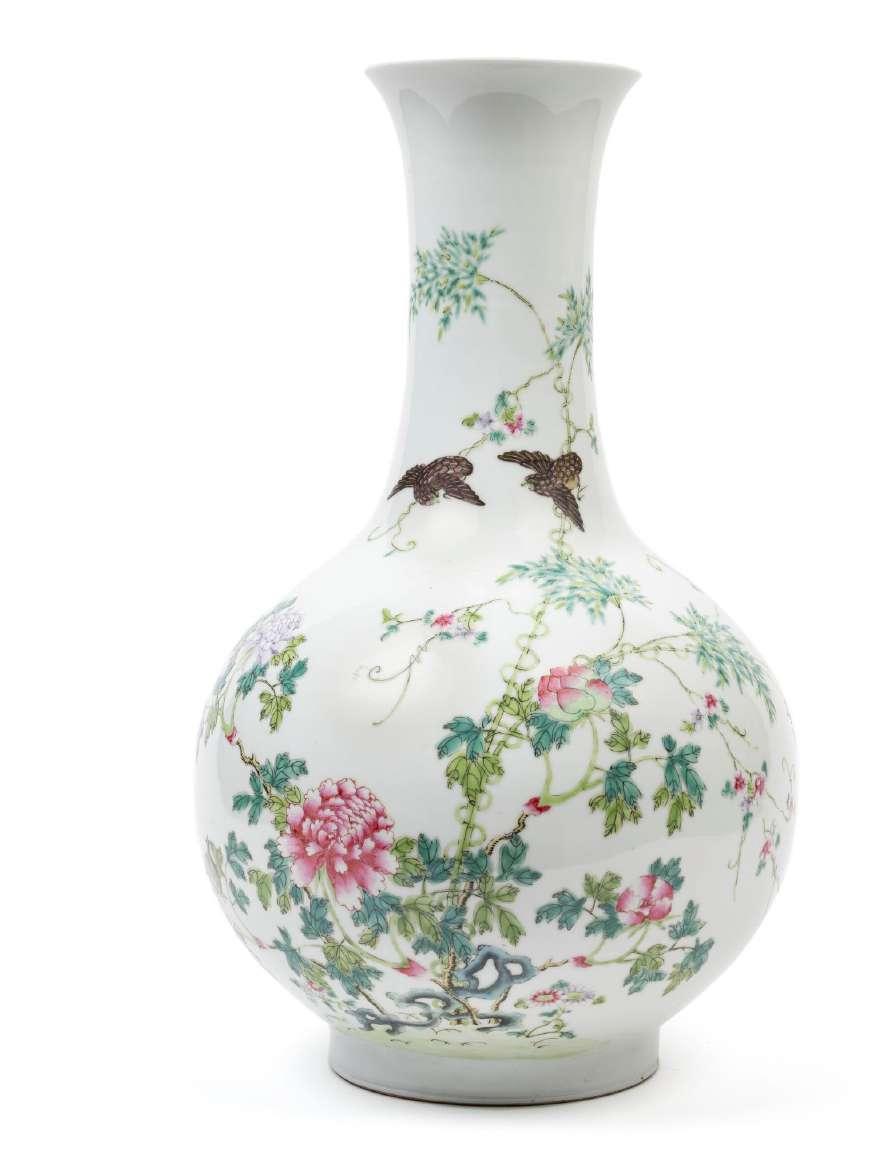
A
FAMILLE
ROSE BOTTLE-SHAPED PORCELAIN
VASE, China, Republic Period (1912-1949)
h cm 39,5
€ 2.500 / 3.000
With a globular body and long neck rising to a slightly flared mouth, is finely decorated with a floral landscape depicting peonies, pomegranates, bats, and small birds in flight. The base bears a six-character apocryphal red mark of the Guangxu Emperor.
VASO IN PORCELLANA FAMIGLIA ROSA, Cina, Repubblica di Cina (1912-1949)
Con corpo globulare e lungo collo terminante in una bocca leggermente svasata, è decorato con un elegante paesaggio floreale raffigurante peonie, melograni, pipistrelli e piccoli uccelli in volo. Alla base reca un marchio apocrifo a sei caratteri dell’Imperatore Guangxu.
民国
A FAMILLE ROSE PORCELAIN JARDINIERE,
China, Republic period (1912-1949)
h cm 16,5 x l cm 20,5
€ 700 / 800
Of square section, resting on four feet decorated with key-fret motifs; the body is divided into four panels depicting flowers, and sages with attendants. The base bears an apocryphal four-character square mark in iron-red of Hongxiang.
JARDINIERE IN PORCELLANA FAMIGLIA ROSA, Cina, Repubblica di Cina (1912-1949)
Di sezione quadrata, poggia su quattro piedi decorati a greche; il corpo è suddiviso in quattro pannelli raffiguranti fiori, e saggi con accoliti. Alla base reca marchio apocrifo quadrato in rosso ferro a quattro caratteri di Hongxiang.
民国 粉彩花卉人物纹花盆 洪宪御製款
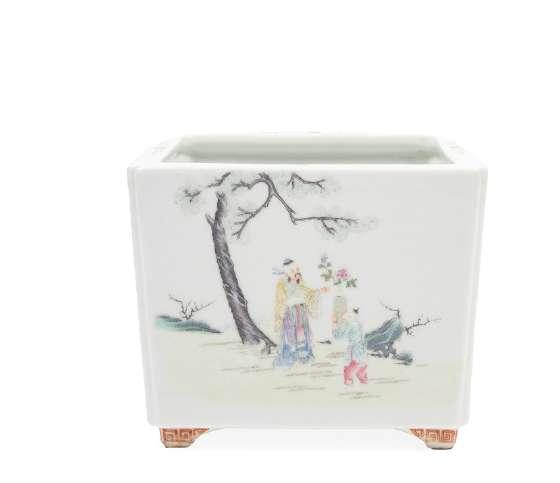

A
FAMILLE
ROSE PORCELAIN VASE,
China, Republic Period (1912-1949)
h cm 23,5
€ 500 / 700
Finely painted in a seamless composition, depicting a child playing with his mother in a tree-lined courtyard with rocks. The base bears an apocryphal fourcharacters square iron-red mark of the Qianlong Emperor.
VASO IN PORCELLANA FAMIGLIA ROSA, Cina, Repubblica di Cina (1912-1949)
Ben dipinto senza soluzione di continuità con un bambino che gioca con la madre in un cortile alberato con rocce. Alla base reca marchio apocrifo quadrato a quattro caratteri in rosso ferro dell’Imperatore Qianlong.
民国 粉彩花瓶
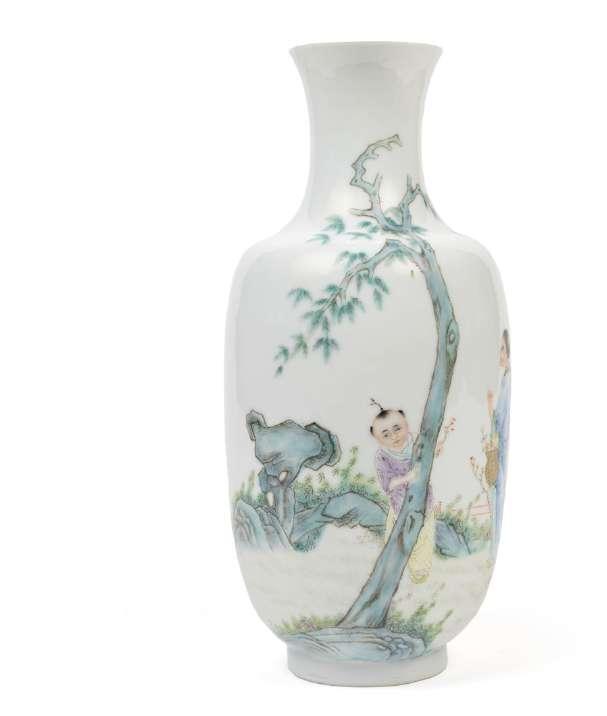
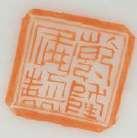
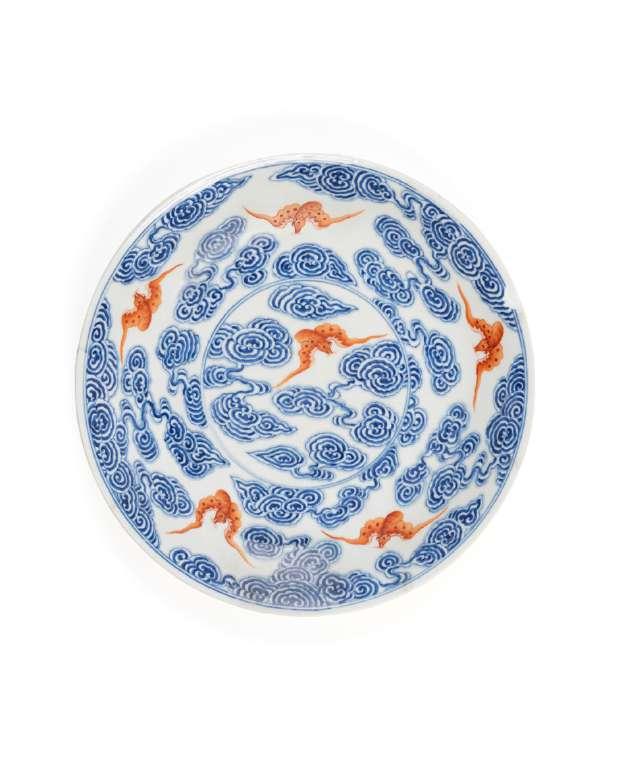
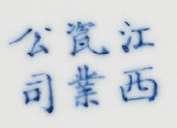
97
A BLUE, WHITE AND IRON RED PORCELAIN PLATE,
China, Republic Period (1912-1949)
d cm 24,2
€ 100 / 200
Well painted with six iron-red bats flying among stylized clouds. The reverse is decorated with four bats and bears a six-character mark in underglaze blue within double circles, reading 江西瓷业公司 Jiangxi Ciye Gongsi (Jiangxi Porcelain Company).
PIATTO IN PORCELLANA BIANCO, BLU E ROSSO FERRO, Cina, Repubblica di Cina (1912-1949)
Ben dipinto con sei pipistrelli in rosso ferro che volano tra nuvole stilizzate. Al retro è dipinto con quattro pipistrelli e reca il marchio a sei caratteri in blu sotto coperta entro due cerchi 江西瓷业公司 “Jiangxi Ciye Gongsi” (Jiangxi Porcelain Company).
民国 青花矾红云蝠纹盘 底款“江西瓷业公司”
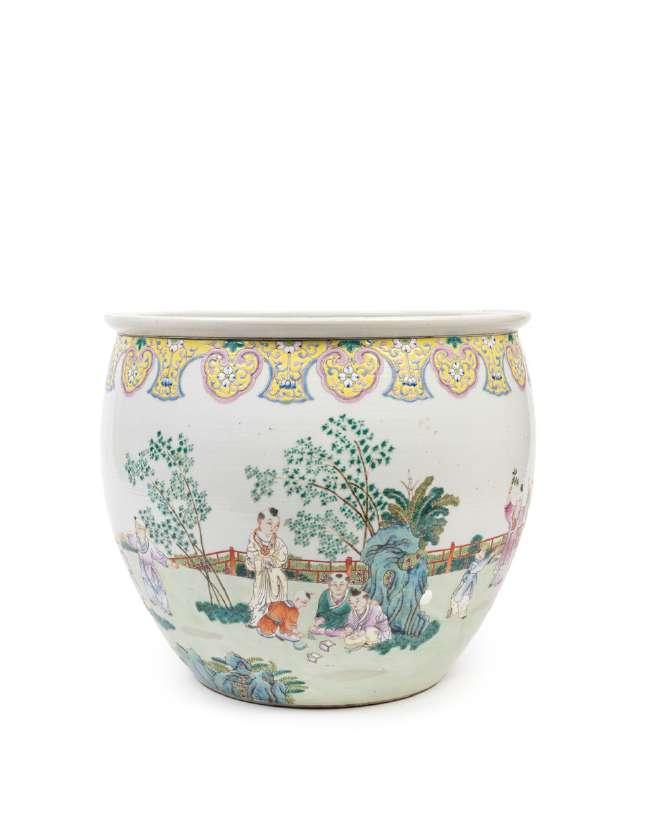
98
A FAMILLE ROSE PORCELAIN JARDINIERE,
China, Republic period (1912-1949)
h cm 27 x d cm 30,5 cm
€ 2.000 / 3.000
Painted continuously around the entire body with a scene of boys in a garden among bamboo, rocks, and flowers, all under a ruyi band.
FIORIERA IN PORCELLANA FAMIGLIA ROSA, Cina, Repubblica di Cina (1912-1949)
Dipinta su tutto il corpo senza soluzione di continuità con una scena di ragazzi in un giardino tra piante di bambù, rocce e fiori sotto ad una fascia di ruyi.
民国 粉彩婴戏纹卷缸

A RARE PAIR OF TURQUOISE GROUND PORCELAIN “DAYAZHAI” VASES, China, Qing dynasty, Guangxu period (1875-1908)
h cm 75,5
Featuring handles modelled as qilong and are magnificently enamelled with the motif of the “Peaches of Longevity” set within a naturalistic landscape populated with blossoming peach trees, nandina sprays, grape clusters, linghzi, and rocks, all against a turquoise ground. The neck, beneath a band of key-fret and a frieze of ruyi heads, bears an oval medallion inscribed in iron-red with the three characters Dayazhai (大雅斋), while the base is inscribed with a four-character mark Yong Qing Chang Chun (永庆长 春), meaning ‘Eternal Prosperity and Enduring Spring’.
Provenance: from a private Italian collection.
Catalog notes:
An identical pair of Dayazhai porcelain vases is in the collection of the Guizhou Provincial Museum.
RARA
COPPIA GRANDI
VASI
DAYAZHAI, Cina, dinastia Qing, periodo Guangxu (1875-1908)
Dalla forma a colonna di balaustro, i vasi presentano anse modellate a forma di qilong e sono magnificamente smaltati con il motivo delle “pesche della longevità” inserite in un paesaggio naturalistico popolato da alberi di pesco in fiore, rami di nandina, grappoli d’uva, linghzi e rocce, su uno sfondo turchese. Il collo, al di sotto di una fascia di decori alla greca e di una banda di ruyi, reca un medaglione ovale con i tre caratteri in rosso ferro Dayazhai (大雅斋), mentre la base è marcata con un marchio a quattro caratteri Yong Qing Chang Chun (永庆长春), che significa “Prosperità eterna e primavera duratura”.
Provenienza: collezione privata, Italia.
Note di catalogo:
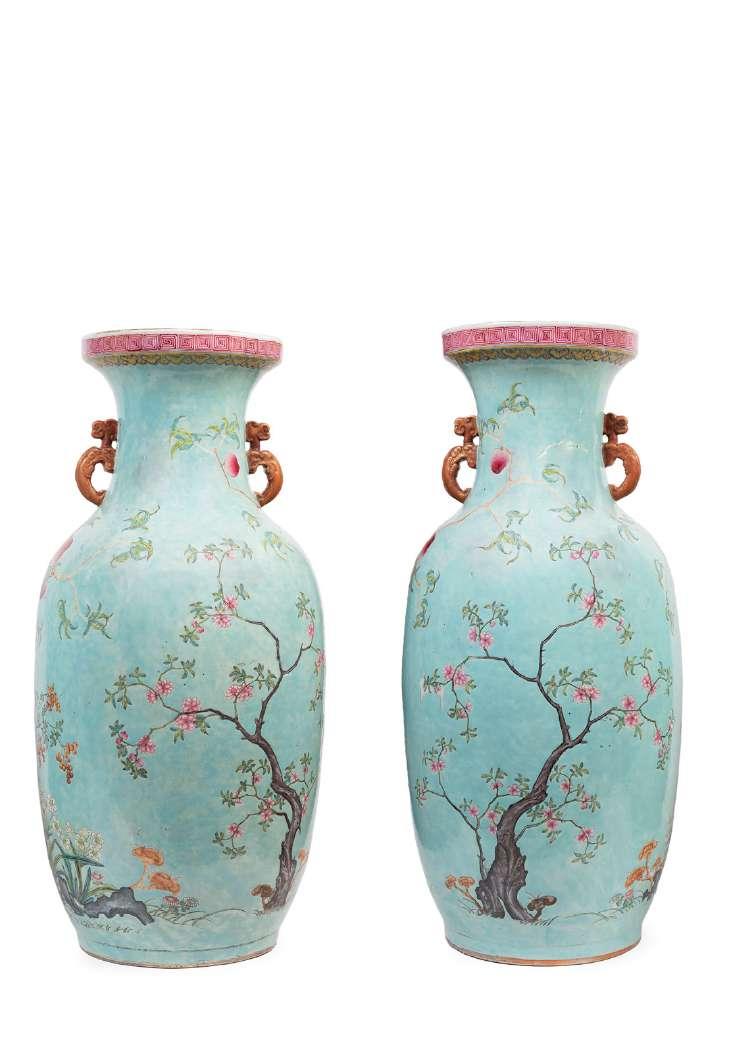
Un’identica coppia di vasi Dayazhai del periodo Guangxu è conservata al Museo Provinciale di Guizhou. 99 € 6.000 / 8.000
清光绪 大雅斋款绿地粉彩九桃纹双耳瓶一对 这对花瓶以绿地为地,绘有九桃纹,桃在中国传统文化中象征长寿,搭配竹、石、花卉等元素,色彩丰富艳丽,工艺精湛。
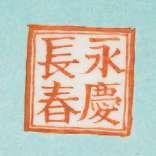

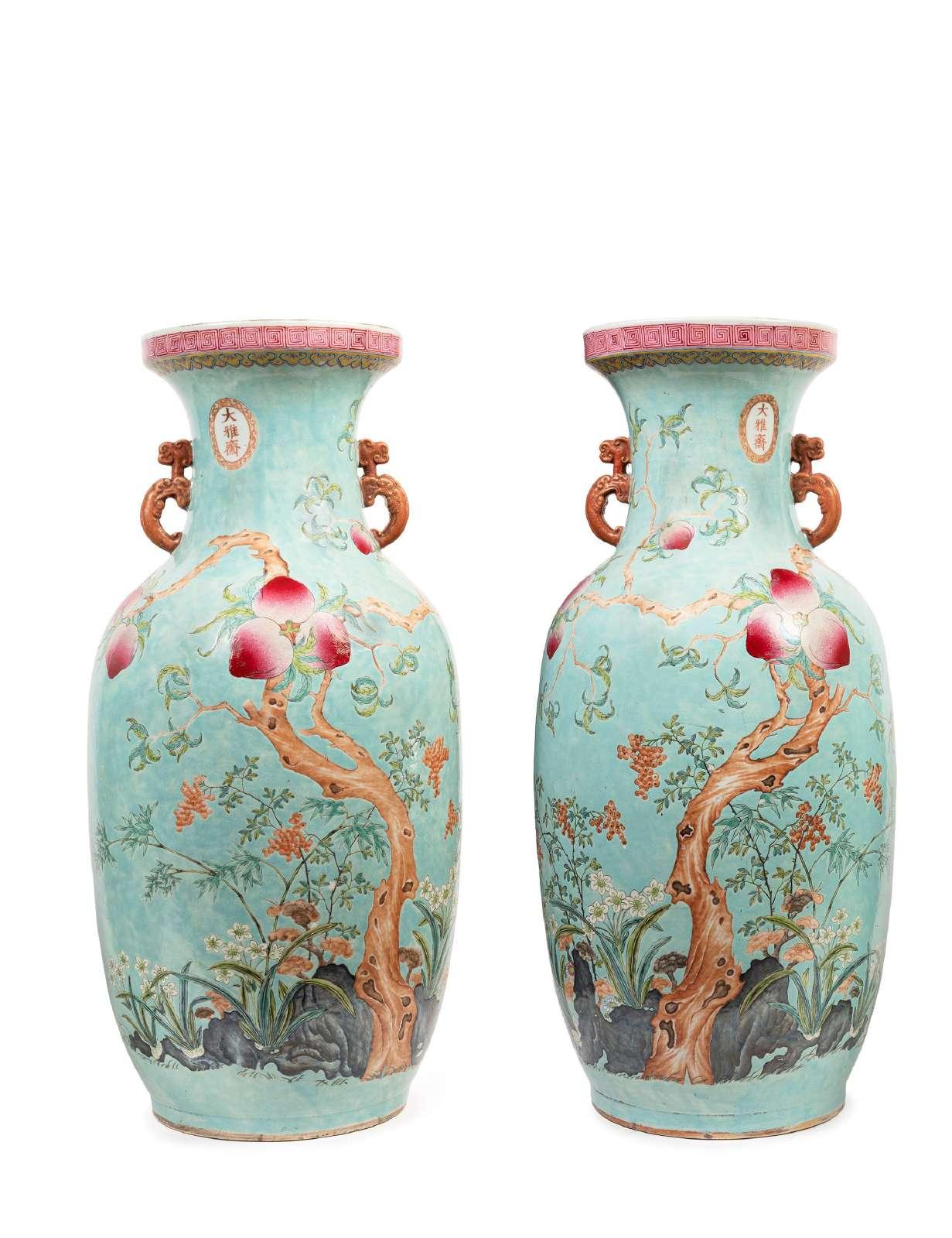
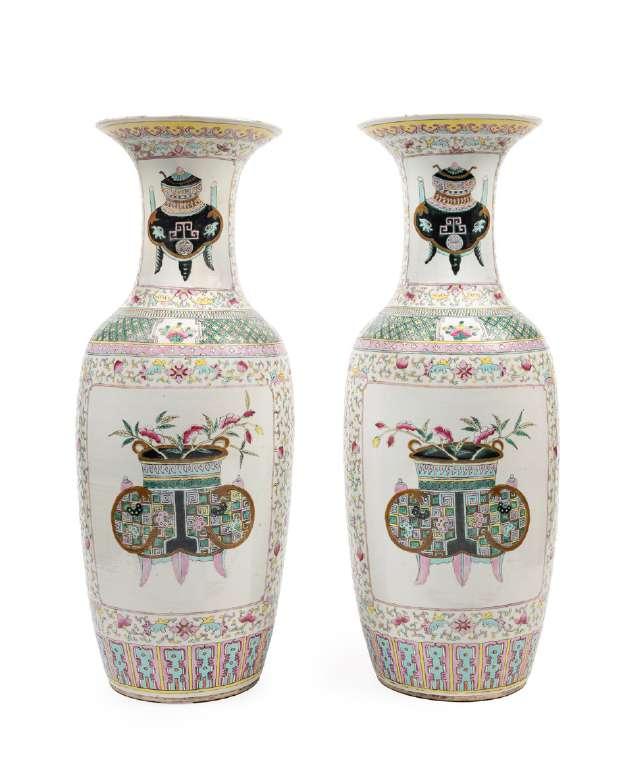

100
A PAIR OF FAMILLE ROSE PORCELAIN VASES,
China, late 19th / early 20th century
h cm 60
€ 600 / 800
Of baluster form, the body is decorated with dense leafy and floral scrolls, interrupted by two large square panels depicting censers adorned with flowers. The upper section of the vase is encircled by a band of geometric motifs alternating with floral reserves, while the neck continues the scrolling decoration of the body, enriched with panels featuring trypod archaistic censers.
COPPIA DI VASI IN PORCELLANA FAMIGLIA ROSA, Cina, fine XIX / inizio XX secolo
Dalla forma a colonna di balaustro, il corpo è decorato da uno scroll di fiori e foglie, intervallato da due riserve quadrate raffiguranti incensieri ornati di fiori. La parte superiore dei vasi è cinta da una fascia a motivi geometrici alternati a riserve floreali, mentre il collo riprende il decoro a ramages del corpo, arricchito da riserve con incensieri tripodi.
19/20世纪初 粉彩博古纹花瓶一对
101
TWO LARGE CELADON-GROUND SLIP-DECORATED VASES, China, Qing dynasty, 19th century
h cm 61,5
€ 2.500 / 3.000
Of baluster column form with lion-head handles and relief qilong, the body is decorated in white slip with incised floral motifs and pomegranates, all against a celadon ground.
DUE GRANDI VASI IN PORCELLANA CELADON, Cina, dinastia Qing, XIX secolo
Dalla forma a colonna di balaustra con anse leonine e qilong a rilievo, sono decorati con barbottina bianca incisa decori floreali e melograni, il tutto su fondo celadon.
清19世纪 豆青釉堆白花卉纹双耳瓶一对
TWO CHINESE PORCELAIN VASES IN FAMILLE ROSE AND QIANJIANG ENAMEL,
China, Qing dynasty, late 19th century
€ 400 / 600
The first decorated on the body and neck with archaic censers amid floral motifs and poetic inscriptions, with handles shaped as lions; the second adorned with Qianjiang enamels depicting the One Hundred Antiquities, bearing inscriptions on the reverse including the artist’s signature and date, with handles shaped as pomegranates, the base bears a four-character seal mark of Emperor Guangxu.
DUE VASI IN PORCELLANA FAMIGLIA ROSA E QIANGJIANG, Cina, dinastia Qing, fine XIX secolo
Entrambi a forma di colonna di balaustra, il primo decorato sul corpo e sul collo con incensieri arcaici tra fiori e iscrizioni poetiche, con anse modellate a forma di leoni; il secondo ornato con smalti Qianjiang raffiguranti le Cento Antichità, sul retro reca iscrizioni tra le quali la firma dell’artista e la data, con anse modellate a forma di melograno, alla base è impresso il marchio sigillare a quattro caratteri dell’Imperatore Guangxu.
清19世纪末 博古纹花瓶两只
A QIANJIANGCAI PORCELAIN VASE
SIGNED BY GAO HENGTAI, China, 1906 dated
The larger h cm 60 h cm 61
€ 500 / 700
Shaped like a baluster column with handles modeled as mythical creatures, the body is painted with sages and their attendants in a treelined courtyard, engaged in playing go, making music, and reading. The reverse bears poetic inscriptions with the signature of the artist Gao Hengtai (高恒泰) and the date bing wu (丙午) corresponding to 1906.
VASO IN PORCELLANA QIANJIANG FIRMATO
DA GAO HENGTAI, Cina, datato 1906
A forma di colonna di balaustra con anse a guisa di animale fantastico, il corpo è dipinto con saggi e i loro accoliti in un cortile alberato, intenti a giocare a go, suonare e leggere. Sul retro sono presenti iscrizioni poetiche con la firma dell’artista Gao Hengtai (高恒泰) e la data bing wu (丙午) corrispondente all’anno 1906.
清 丙午 ( 1906 ) 浅绛彩大瓶 高恒泰 作
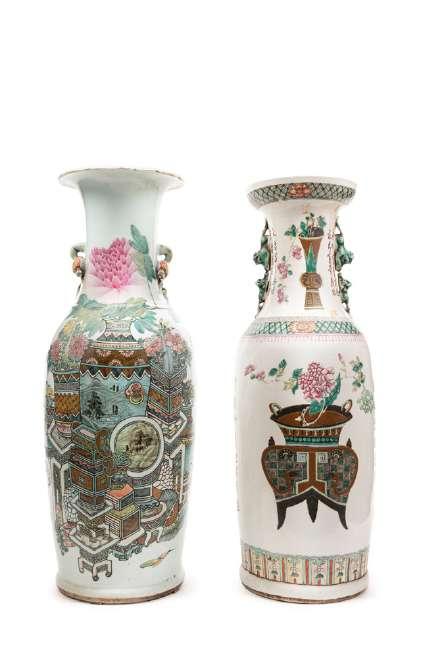


TWO QIANJIANG PORCELAIN PLAQUES,
China, late 19th century / early 20th century
d cm 26,5
104 € 800 / 1.200
Of circular form, one depicts two ladies in a tree-lined courtyard with a bird, signed 汪俊顺 (Wāng Jùnshùn); the other portrays a lagoon landscape with mountains in the background and figures aboard a boat. Mounted on gilt-bronze tripod tables.
DUE PLACCHE IN PORCELLANA QIANJIANG,
Cina, fine XIX secolo / inizio XX secolo
Di forma circolare, una presenta due dame in un cortile alberato con un volatile, firmata 汪俊顺 (Wāng Jùnshùn); l’altra raffigura un paesaggio lagunare con montagne sullo sfondo e figure a bordo di un’imbarcazione. Montate su dei tavolini tripodi in bronzo dorato.
19/20世纪 瓷板画铜花几
A QIANJIANGCAI PORCELAIN BRUSHPOT
SIGNED BY XU PINHENG, China, Qing dynasty, early 20th century
h cm 13
€ 300 / 500
Cylindrical in shape, the body is painted with flower vases and scholar’s objects, with an inscription on the back with the signature of Xu Pinheng (许 品衡). The base bears a four-character apocryphal mark in underglaze blue of Emperor Daoguang.
PORTAPENNELLI IN PORCELLANA QIANJIANG
FIRMATO DA XU PINHENG, Cina, dinastia Qing, inizio XX secolo
Di forma cilindrica è dipinto sul corpo con vasi di fiori e oggetti da studiosi, con iscrizione sul retro dell’artista Xu Pinheng (许品衡). Alla base reca il marchio apocrifo a quattro caratteri in blu sottocoperta dell’Imperatore Daoguang.
清光绪 博古纹浅降彩笔筒 许品衡制
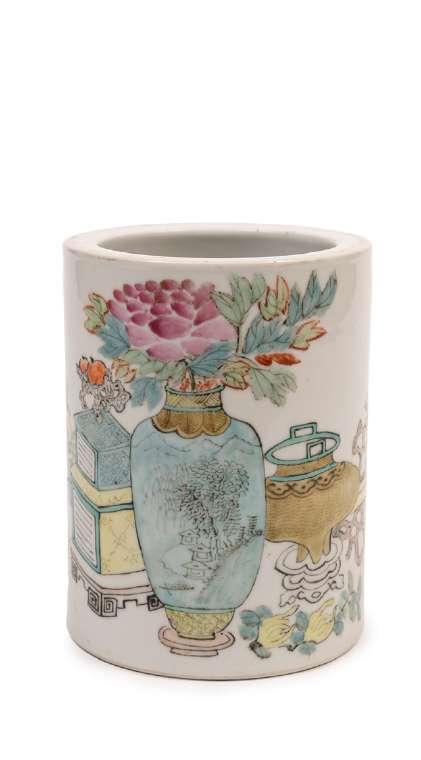

106
A SMALL QIANJIANG PORCELAIN VASE,
China, 20th century
h cm 18
€ 100 / 150
The body is decorated with a depiction of a pensive lady seated at a writing desk; the reverse bears inscriptions. The handles are shaped like elephants.
PICCOLO VASO IN PORCELLANA QIANJIANG,
Cina, XX secolo
Il corpo è decorato con la raffigurazione di una dama pensierosa seduta a uno scrittoio; sul retro sono presenti iscrizioni. Le anse sono modellate a forma di elefante.
20世纪 粉彩象耳瓶
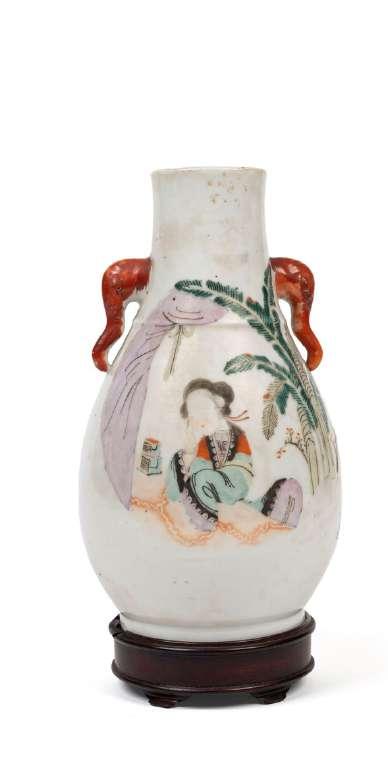


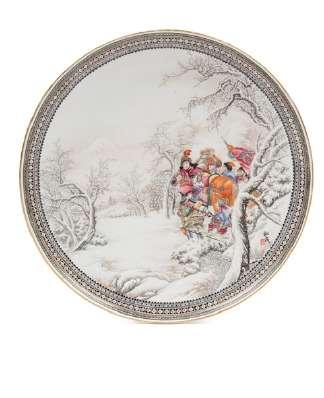

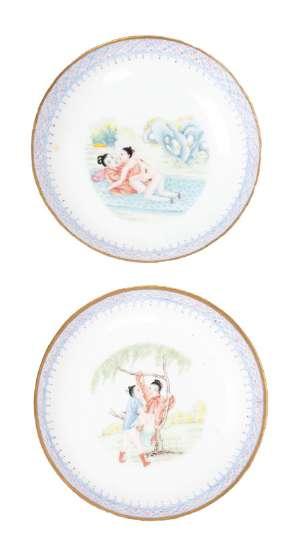
A
SMALL PORCELAIN BOX, China, Republic period (1912-1949)
d cm 6,6
€ 300 / 500
The upper section is decorated with a band of geometric patterns below a ruyi border, centered with an inscription and a signature; the lower section is adorned with a band of floral and foliate motifs. The base bears an apocryphal four-character square mark of the Qianlong Emperor in overglaze blue.
PICCOLA SCATOLA IN PORCELLANA, Cina, Repubblica di Cina (1912-1949)
La parte superiore è ornata da una fascia a motivi geometrici seguita da una decorazione a ruyi, con al centro un’iscrizione accompagnata da una firma; la sezione inferiore è impreziosita da una banda dipinta con eleganti motivi floreali e fogliacei. Alla base si trova un marchio apocrifo quadrato a quattro caratteri in blu sopracoperta dell’imperatore Qianlong.
107 108
A
FAMILLE ROSE PORCELAIN PLATE SIGNED BY ZHANG SONGMAO, China, 20th century
d cm 23,5
€ 600 / 800
Finely painted on the body with a snowy scene featuring trees, pagodas, and soldiers on horseback; the rim is divided into three distinct geometric sections. Signed by Zhang Songmao (松茂). The base bears a red-iron mark: Zhōng Guó Jǐng Dé Zhèn Zhì (中国景德镇制).
PIATTO IN PORCELLANA FAMIGLIA ROSA FIRMATO DA ZHANG SONGMAO, Cina, XX secolo
Finemente dipinto sul corpo con una scena innevata con alberi, pagode e soldati a cavallo; la tesa è divisa in tre sezioni geometriche differenti, firmato da Zhang Songmao (松茂). Alla base reca marchio in rosso ferro Zhōng Guó Jǐng Dé Zhèn Zhì (中国 景德镇制).
20世纪 粉彩雪景人物图瓷盘
109
PAIR OF FAMILLE ROSE EROTIC PORCELAIN DISHES, China, Republic Period (1912-1949)
d cm 10
€ 600 / 800
Well painted, the rims decorated with a band of honeycomb-pattern motifs and the centers featuring erotic scenes. The bases bear a four-character overglaze mark
Chūn Yí Táng Zhì 春怡堂製
COPPIA DI PIATTINI IN PORCELLANA FAMIGLIA ROSA, Cina, Repubblica di Cina (1912-1949)
Ben dipinti, con il bordo decorato con una fascia contenente decori ad alveare e centrati da scene erotiche. Alla base recano il marchio a quattro caratteri in rosso
Chūn Yí Táng Zhì 春怡堂製
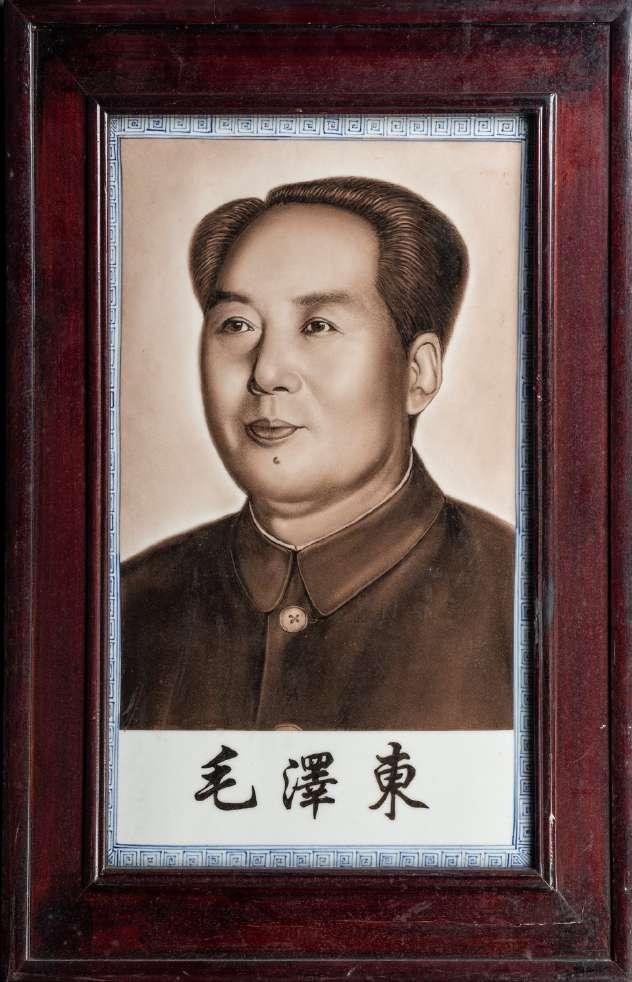
A
COMUNIST
PROPAGANDA PORCELAIN
PLAQUE, China, People’s Republic of China (1949- present)
h cm 58 x l cm 35,5
Depicting the portrait of Mao Zedong in sepia tones, with the inscription 毛澤東, Máo Zédōng, the rim of the plaque is decorated with an underglaze-blue key-fret border.
PLACCA DELLA PROPAGANDA COMUNISTA IN PORCELLANA, Cina, Repubblica Popolare Cinese (1949 - presente)
Raffigurante il volto di Mao Zedong in color seppia, con l’iscrizione 毛澤東, Máo Zédōng, il bordo della placca presenta una greca in blu sotto coperta.
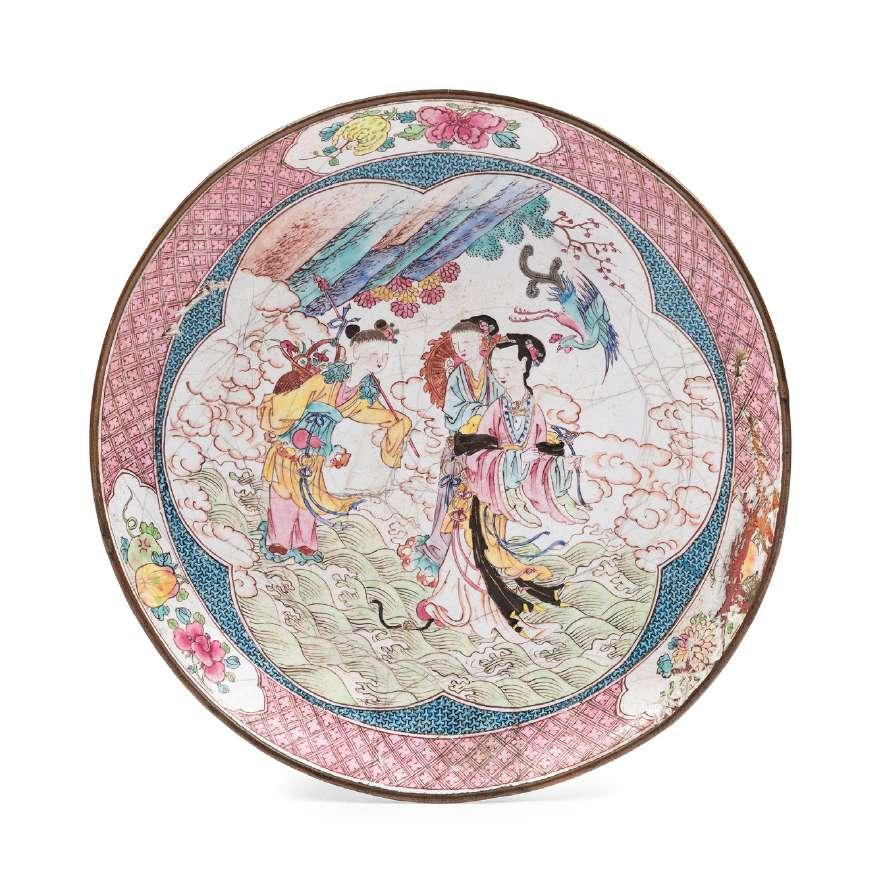
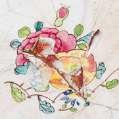
A
RARE FAMILLE
ROSE
ENAMEL ON COPPER DISH, China, Qing dynasty, Yongzheng period (1723-1735)
d cm 18
111 € 450 / 550
Finely painted at the center with a lobed reserve enclosing a scene within a naturalistic landscape with clouds, waves and a phoenix in flight, where two elegantly dressed ladies with elaborately arranged coiffures meeting a young figure carrying a basket of fruit and a staff. The rim decorated with pink geometric motifs alternating with reserves containing cartouches adorned with fruits and flowers. The reverse painted with leafy and floral designs.
RARO PIATTO FAMIGLIA ROSA SMALTATO SU RAME, Cina, dinastia Qing, periodo Yongzheng (1723-1735)
Raffinatamente dipinto al centro con una riserva polilobata che racchiude una scena in un paesaggio naturalistico con nuvole, onde e una fenice in volo, in cui due dame elegantemente vestite con capelli raccolti in acconciature elaborate incontrano una giovane con un cesto di frutta sulle spalle e un bastone nella mano. Il bordo è decorato con motivi geometrici rosa alternati a riserve contenenti cartigli ornati con frutti e fiori. Il retro è dipinto con fiori.
清雍正 铜胎画珐琅盘
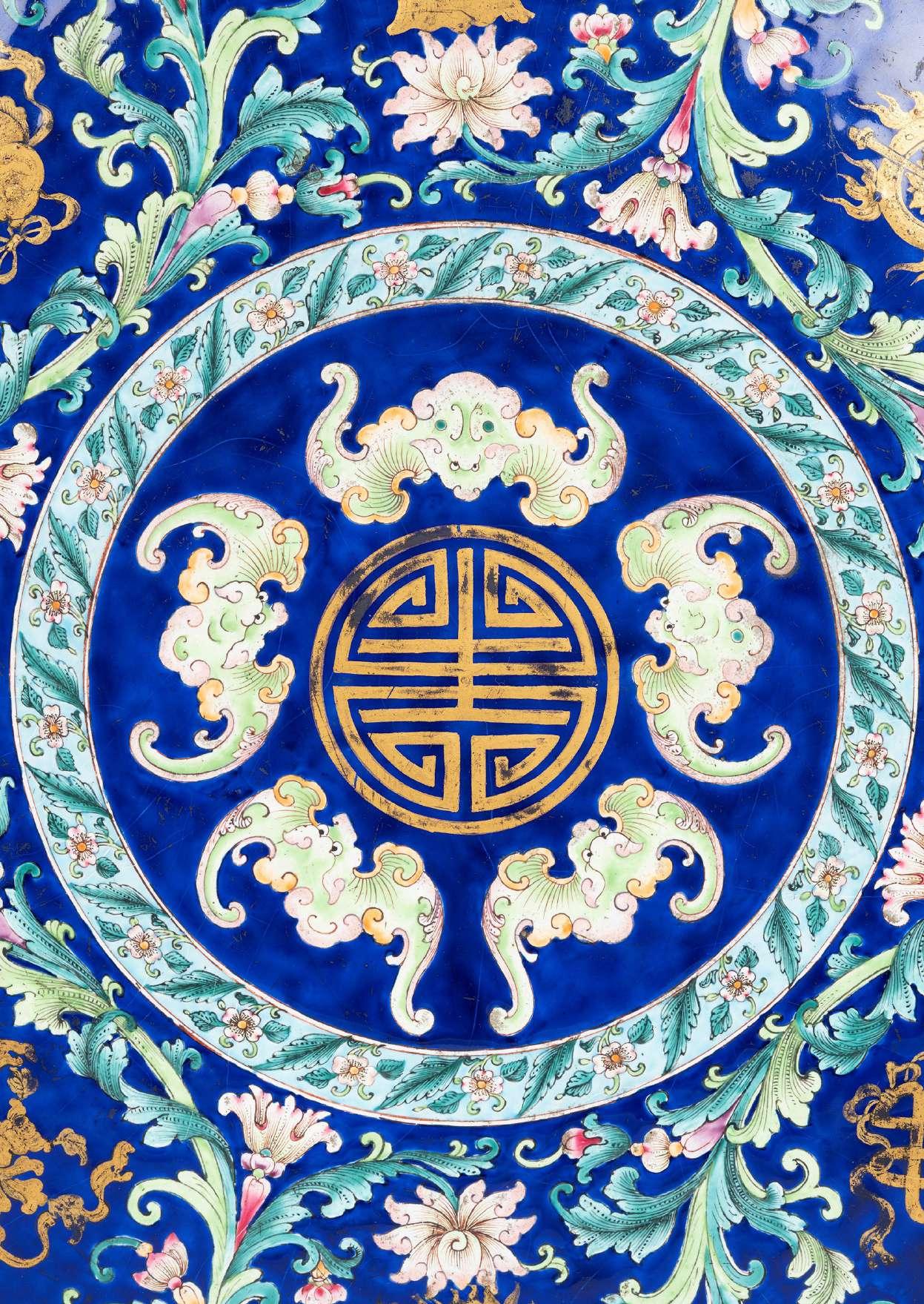
A ENAMEL BOX, China, Qing dynasty, 18th / 19th century
d cm 34,5
112 € 1.500 / 2.000
Of flat circular form with a slightly domed cover, finely enamelled on a blue ground with a central band in gilt overglaze depicting the Eight Buddhist Emblems among lotus flowers and leafy scrolls. At the center, five bats support a large gilt shou (longevity) symbol. The interior contains eight fan-shaped trays surrounding a central circular dish, each decorated with bats, foliate motifs, and auspicious symbols.
Catalog notes:
An almost identical box is held in the collection of the National Palace Museum in Taipei, accession number 故琺000369N000000000. See also a closely similar box in the collection of the Palace Museum in Beijing, accession number 故00116663.
SCATOLA IN SMALTO, Cina, dinastia Qing, XVIII / XIX secolo
Di forma piatta e rotonda, con coperchio leggermente bombato, finemente smaltata su fondo blu, presenta una fascia centrale decorata in oro sovracoperta con gli otto simboli di buon auspicio tra fiori di loto e ramages fogliacei. Al centro, cinque pipistrelli sorreggono un ampio simbolo di longevità dorato. All’interno si trovano otto vassoietti a ventaglio disposti attorno a uno centrale circolare, ciascuno decorato con pipistrelli, motivi fogliacei e simboli di buon auspicio.
Note di catalogo:
Una scatola quasi identica si trova nella collezione del National Palace Museum di Taipei, numero di inventario 故琺 000369N000000000.
Si veda anche la scatola quasi identica nella collezione del Palace Museum di Pechino, numero di inventario 故00116663.
清中期 铜胎画珐琅福寿八宝攒盘盖盒
台北故宫博物院藏品中存有一件近乎相同的盒子,藏品编号为故琺000369N000000000。
另可参见北京故宫博物院藏品中一件近乎相同的盒子,藏品编号为 故00116663。

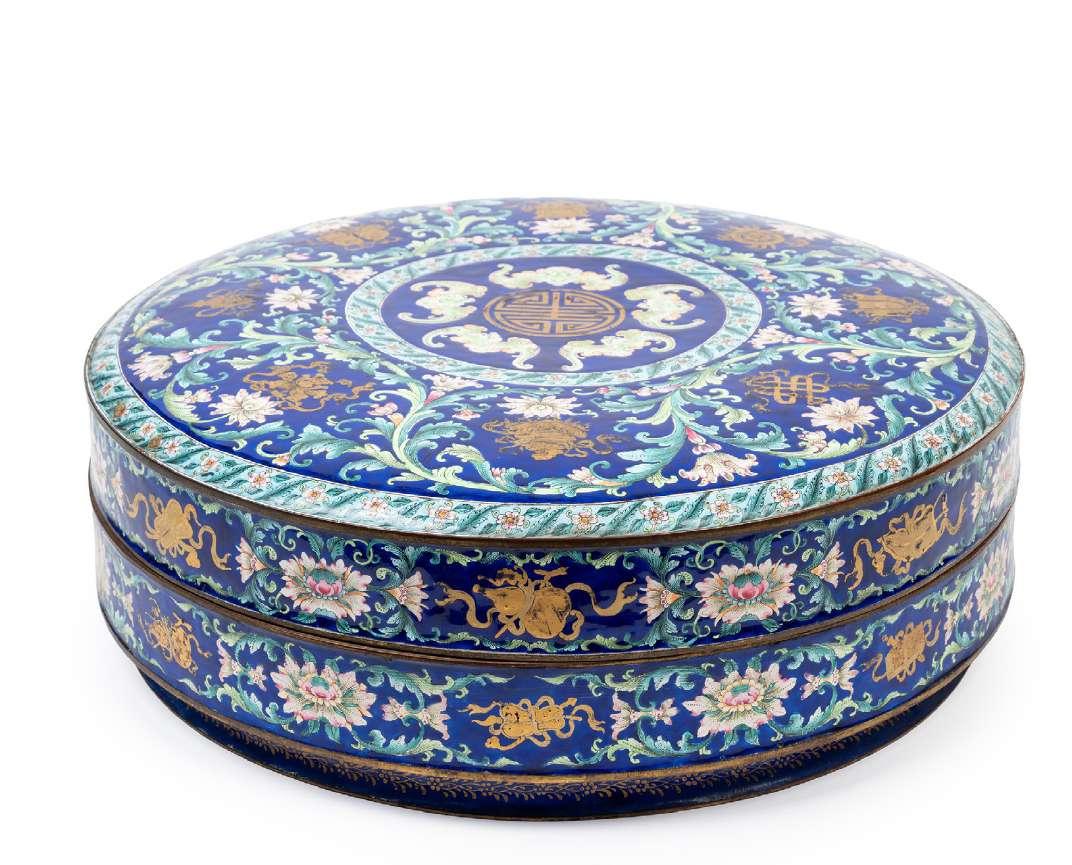
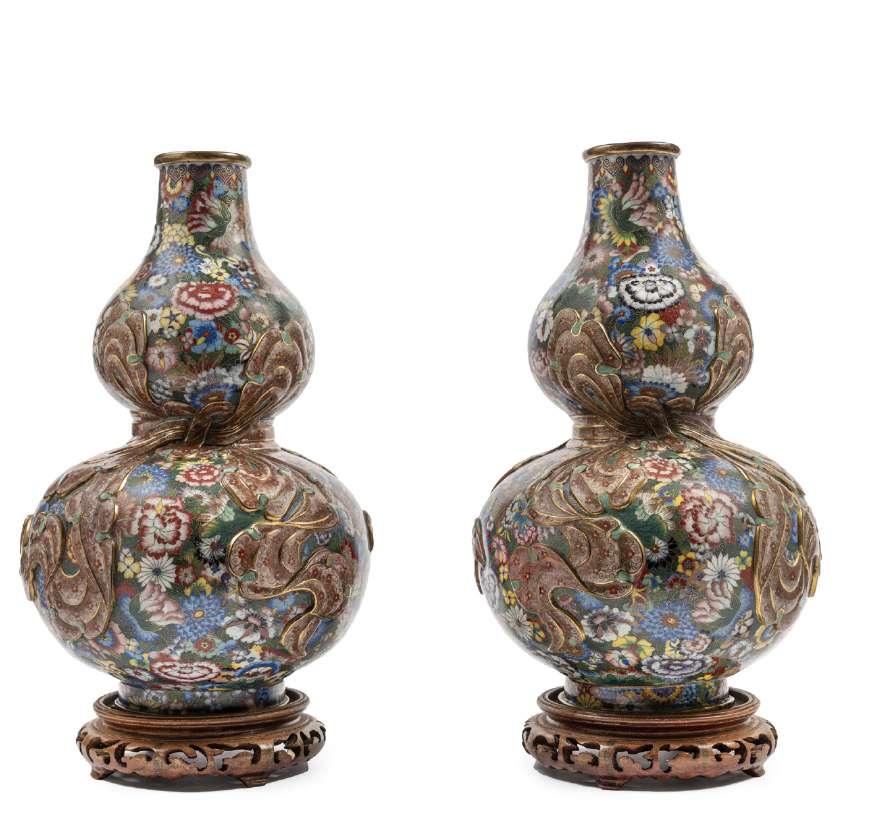
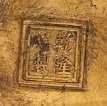
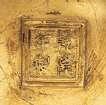
A PAIR OF CLOISONNÉ VASES, China, Qing dynasty, late 19th century
h cm 33,5 x d max cm 20,5
113 € 800 / 1.200
Well-molded in the shape of a double gourd with a ribbon cinched at the waist forming two bows, they are finely decorated with the “millefleurs” pattern; at the center of the base, they bear the apocryphal fourcharacter mark of the Qianlong Emperor. Wirth their wooden stands.
Catalog notes:
For a vase with a similar decoration see the one in the Palace Museum in Beijing and illustrated in The Complete Collection of Treasure of the Palace Museum - Metal-Bodied Enamel Ware, 2008, Hong Kong, pl. 169, pag. 177.
COPPIA DI VASI IN CLOISONNÉ, Cina, dinastia Qing, fine XIX secolo
Ben modellati a forma di doppia zucca con un nastro stretto in vita a formare due fiocchi, sono ben decorati col motivo a “millefiori”; al centro della base recano il marchio apocrifo a quattro caratteri dell’Imperatore Qianlong. Poggiano sulle loro basi in legno.
Note di catalogo:
Si veda un vaso dalla simile decorazione conservato al Palace Museum di Pechino e illustrato in The Complete Collection of Treasure of the Palace Museum - Metal-Bodied Enamel Ware, 2008, Hong Kong, pl. 169, pag. 177
19世纪末 景泰蓝百花不落地葫芦瓶一对
114
A CLOISONNÉ CENSER, China, Qing dynasty, 19th century
h cm 32
€ 300 / 500
It rests on four high feet decorated with lotus flowers and intertwined branches; the square-shaped body depicts an elaborate landscape with pagodas, fishermen, and trees, while the top and handles feature lotus flower motifs.
INCENSIERE IN CLOISONNÉ, Cina, dinastia Qing, XIX secolo
Si poggia su quattro alti piedi decorati con fiori di loto e rami intrecciati; il corpo a sezione quadrata raffigura un elaborato paesaggio con pagode, pescatori e alberi, mentre la parte superiore e le anse riprendono il motivi dei fiori di loto.
清19世纪 景泰蓝山水楼阁图景鼎式香炉
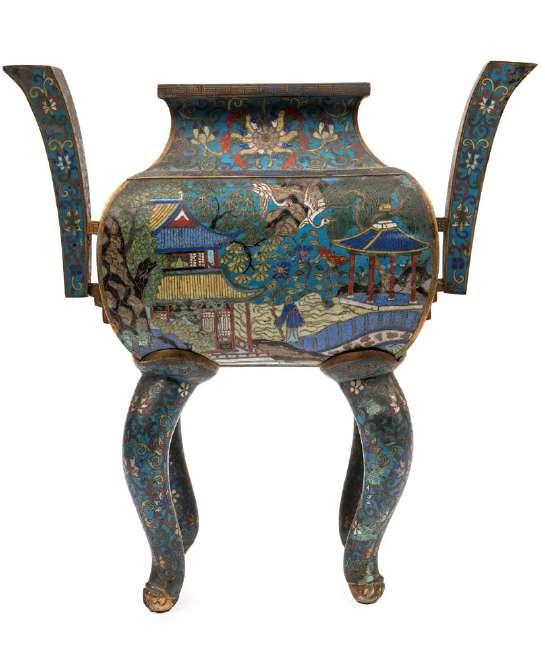
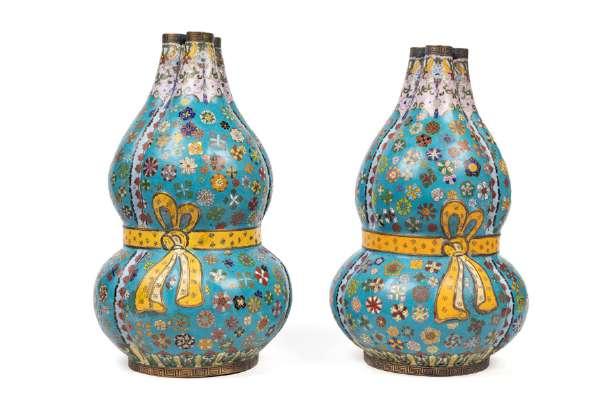
115
A PAIR OF DOUBLE GOURD CONJOINED CLOISONNE VASES, China, early 20th century
h cm 38
€ 800 / 1.000
Entirely decorated with floral medallions on a turquoise-blue ground, framed by ornamental borders; a simulated ribbon is tied around the body. The mouth features a key-fret band, beneath which, on a pink ground, is depicted a bat holding a medallion.
COPPIA DI VASI DOPPIA ZUCCA CONGIUNTA IN CLOISONNÈ, Cina,
inizio XX secolo
Interamente decorato con medaglioni floreali su fondo blu turchese, delimitati da bordure ornamentali; un fiocco simulato è legato attorno al corpo. La bocca presenta un fregio con motivo alla greca, al di sotto del quale, su fondo rosa, è raffigurato un pipistrello che sostiene un medaglione.
民国 景泰蓝葫芦瓶一对

A CLOISONNÉ VASE,
China, 20th century
h cm 21,5
116 € 250 / 300
Bottle-shaped, the body is enamelled on a green ground with floral motifs.
PICCOLO VASO IN SMALTO CLOISONNÈ, Cina, XX secolo
A forma di bottiglia, il corpo è smaltato su fondo verde con motivi floreali.
晚清民国 铜胎掐丝珐琅长颈瓶

A PAIR OF CLOISONNÉ ENAMEL TEA CUPS AND SAUCERS, China, Qing dynasty, 19th century
h cm 6,5 x l max cm 12
117 € 200 / 300
Decorated with a central band of floral and foliate motifs, bordered by a ruyi band.
COPPIA DI TAZZINE E PIATTINI IN CLOISONNE, Cina, dinastia Qing, XIX secolo
Decorate con una fascia centrale a motivi floreali e fogliacei, delimitata da una fascia a ruyi.
19世纪末 景泰蓝杯碟一对
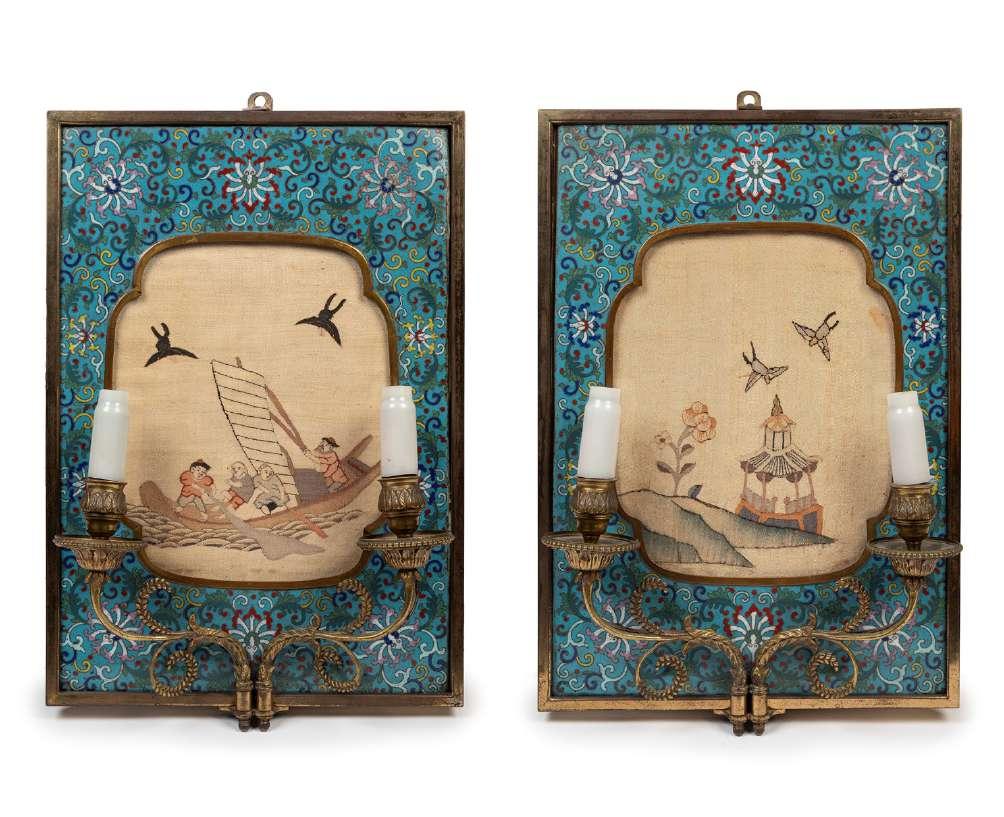
118
A PAIR OF CLOISONNÉ ENAMEL FRAMES,
China, Qing dynasty, late 19th century
h cm 40,2 x l cm 28,5
€ 2.000 / 2.500
Enamelled with refined floral motifs and leafy ramages, each frame is centered by a polylobed reserve enclosing silk fabrics decorated with a boat animated by figures and a landscape with pagodas and birds. Gilt-bronze mounts enriched with two-light candelabra.
COPPIA DI CORNICI IN SMALTO CLOISONNÈ,
Cina, dinastia Qing, fine XIX secolo
Smaltate con raffinati decori floreali e ramages fogliacei, ciascuna cornice è centrata da una riserva polilobata che racchiude tessuti in seta decorati con un’imbarcazione animata da figure e un paesaggio con pagode e uccellini. Montature in bronzo dorato arricchite da candelieri a due luci.
Second session
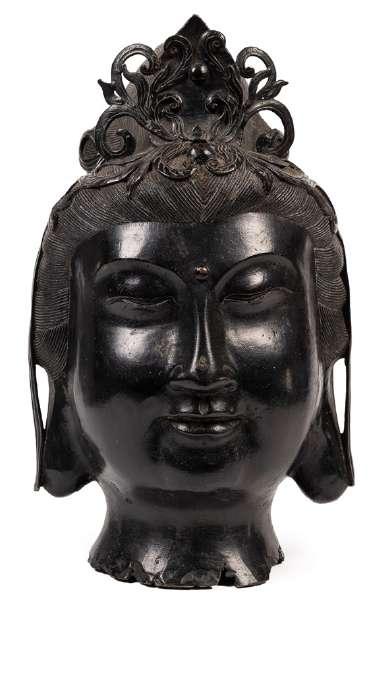

A LARGE GUANYIN HEAD BRONZE, China, Qing dynasty, 19th century
h cm 42
119 € 800 / 1.200
Depicted with a serene expression and an elegant hairstyle adorned with a floral crown.
GRANDE TESTA DI GUANYIN IN BRONZO A PATINA SCURA, Cina, dinastia Qing, XIX secolo
Raffigurata con volto sereno e un’elegante acconciatura ornata da una corona floreale.
清19世纪
A LARGE BRONZE FIGURE OF WEITUO, China, Ming dynasty, 16 century
h cm 40,5
120 € 350 / 550
Depicting Weituo standing, holding the command staff, dressed in an ornate armor secured with cords and straps, with an inlaid belt and a pale blue scarf draped over his shoulders.
Provenance: private collection, Italy.
GRANDE FIGURA IN BRONZO, Cina, dinastia Ming, XVI secolo
Raffigurante Weituo in posizione eretta, impugna il bastone del comando ed è vestito con un’armatura ornata, fissata da cordoni e fasce, completa di cintura intarsiata e di una sciarpa celeste che gli avvolge le spalle.
Provenienza: collezione privata, Italia.
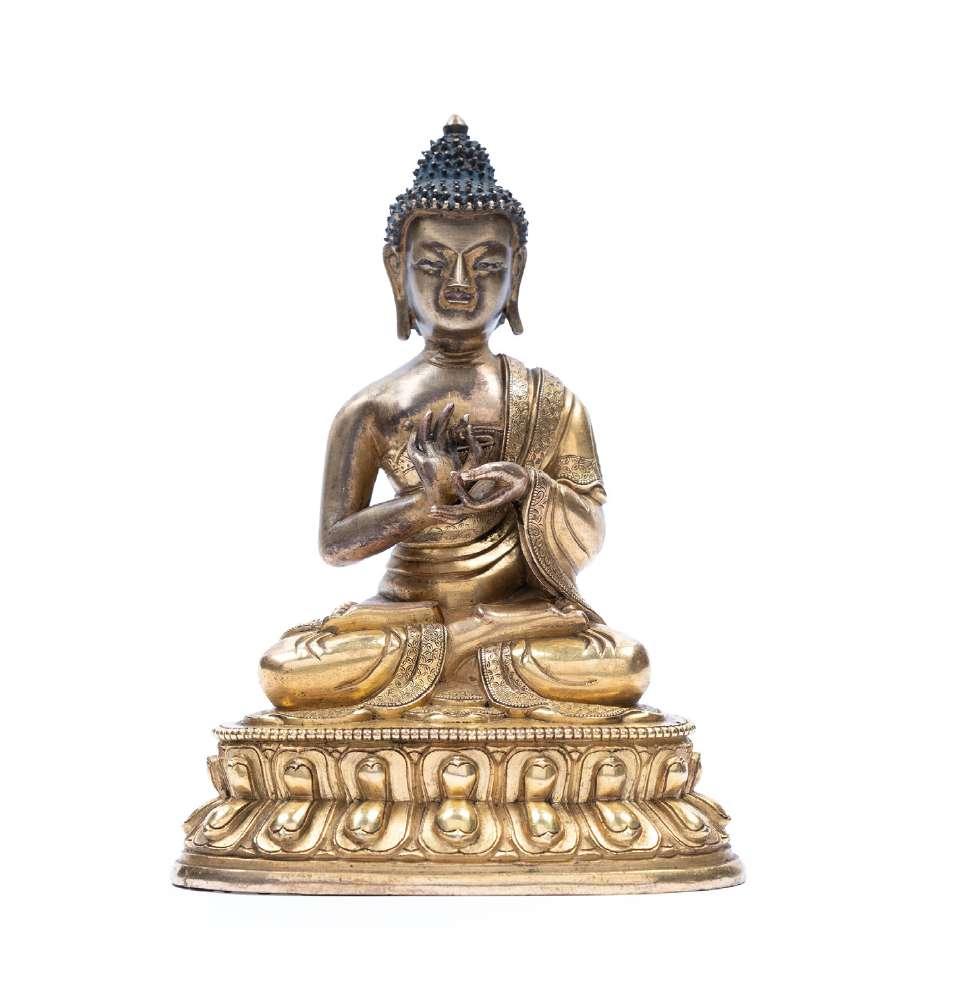
A
GILT BRONZE FIGURE OF BUDDHA SHAKYAMUNI, Tibet, 18th century
h cm 16,4
121 € 800 / 1.200
Seated in padmasana on a double lotus base, his hands are in the dharmachakra mudra. He wears the simple robe of a monk and has a serene expression on his face.
FIGURA DI BUDDHA SHAKYAMUNI IN BRONZO DORATO, Tibet, XVIII secolo
Seduto in padmasana su una doppia base di fiori di loto, ha le mani in dharmachakra mudra. Indossa la semplice tunica del monaco e ha un’espressione serena sul viso.
西藏18世纪 铜鎏金佛像
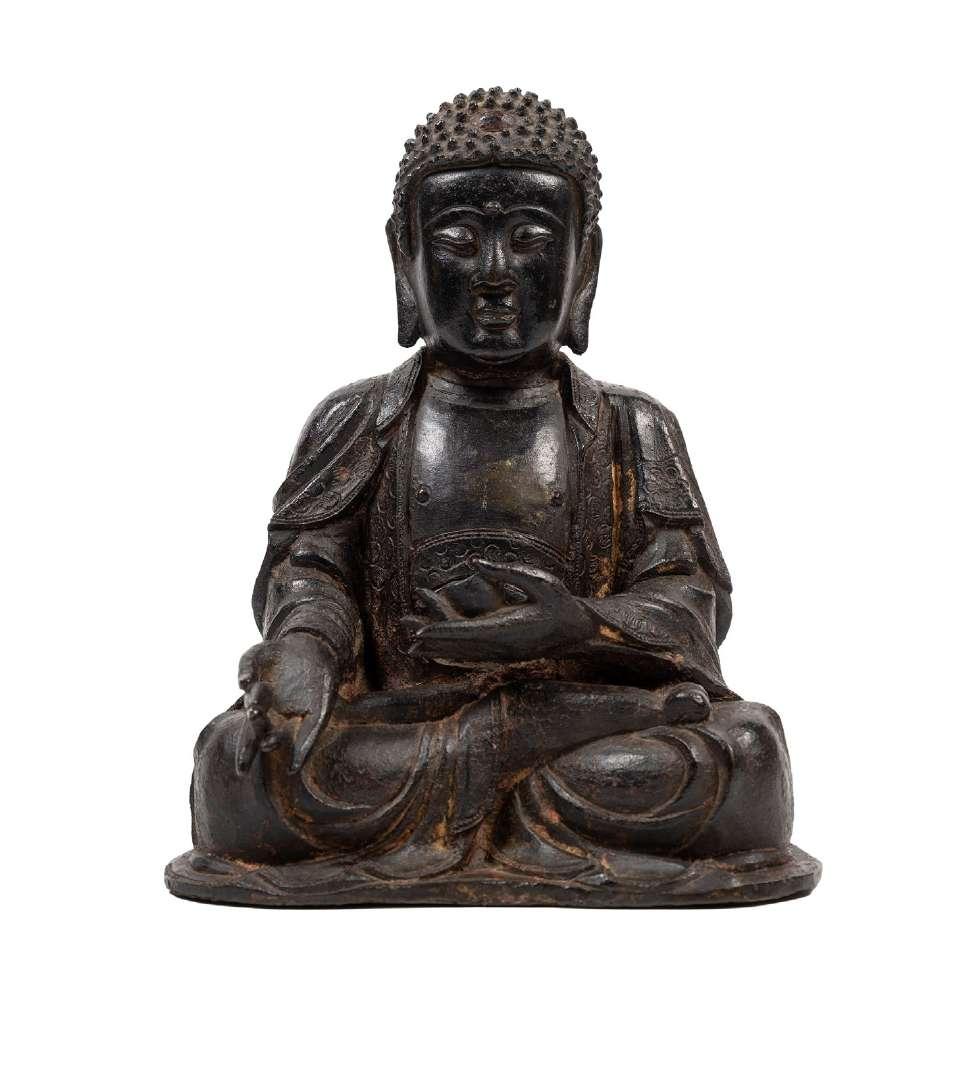
A BRONZE FIGURE OF BUDDHA, China, Ming dynasty (1368-1644)
h cm 24,5
122 € 4.000 / 5.000
Depicted with a serene expression, dressed in a dhoti, seated in padmasana (lotus position), the right hand in varadamudra and the left in dhyanamudra, holding a small ritual vessel.
FIGURA IN BRONZO, Cina, dinastia Ming (1368-1644)
Raffigurante Buddha, rappresentato con il volto sereno, abbigliato con un dhoti, seduto in padmasana (posizione del loto), con la mano destra in varadamudra e la sinistra in dhyanamudra, mentre regge un piccolo vaso rituale.
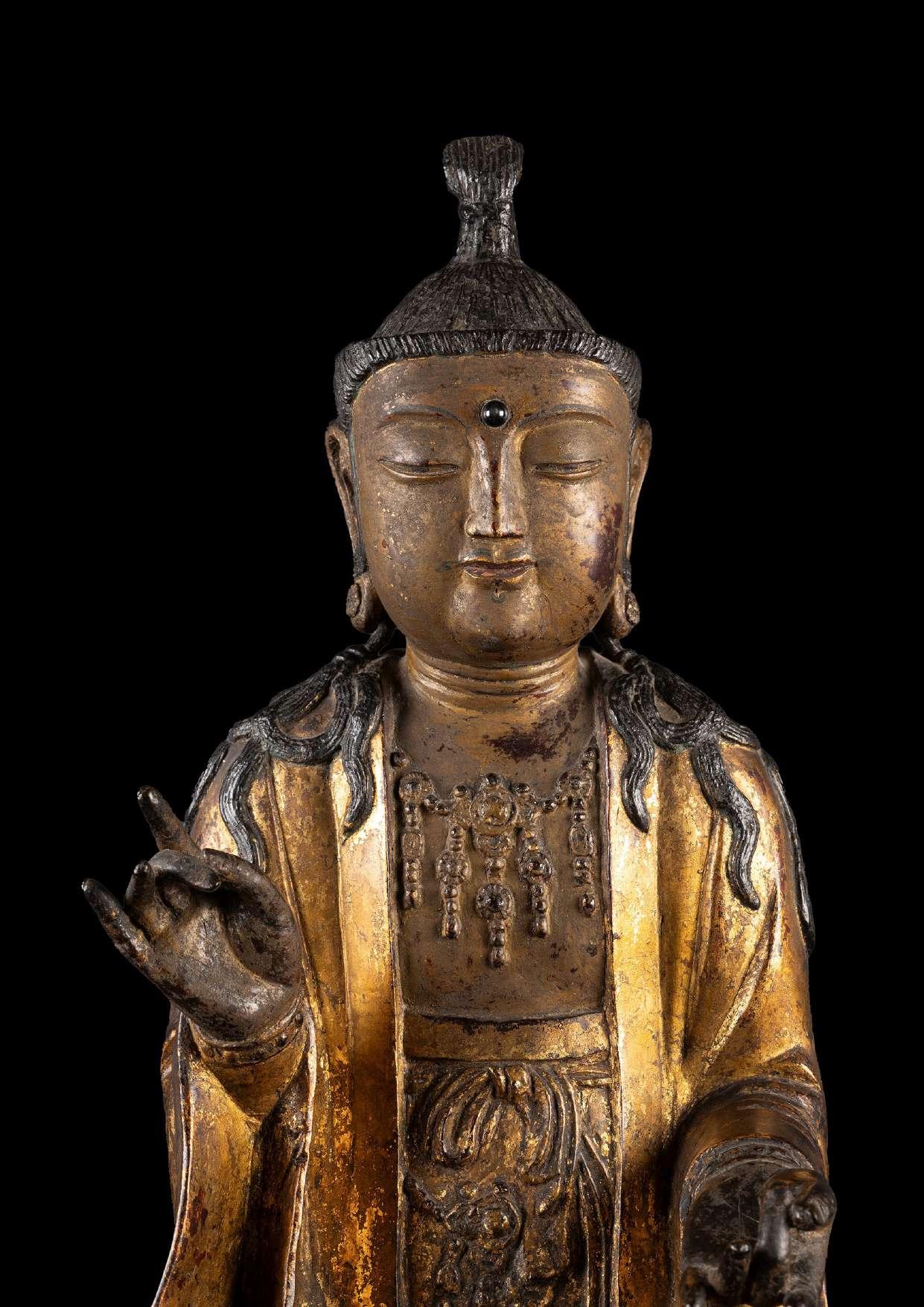
AN EXCEPTIONALLY RARE AND IMPORTANTLARGE GILT-BRONZE FIGURE OF GWANSE-EUM BOSAL, Korea,
h cm 52
Goryeo period (918-1392), 12th / 13th century
€ 80.000 / 120.000
Seated in dhyānāsana, he holds his hands in shuni mudrā. He wears a broad draped robe that falls over a tied dhotī, covering both feet. Lavish rosette-shaped jewels descend from the neck to ornament the chest, recur across the garment and punctuate the earlobes. Long lacquered-black locks fall in waves over the shoulders and are gathered into a chignon at the crown. The serene face is distinguished by a painted moustache and beard and by half-closed eyes with visible pupils. An ūrṇā inlaid with rock crystal is set at the centre of the forehead.
Provenance: From a private collection, Milan.
*This lot has been searched against the database of lost and stolen art kept by The Art Loss Register and is clear.
Catalog notes:
Large-scale gilt-bronze images of Avalokitesvara became characteristic of the Goryeo period [1], reflecting the widespread diffusion of Buddhism at that time [2]. Production of bronzes of this type intensified from the mid-Goryeo period (c. 12th–13th centuries), when bronze largely supplanted iron as the preferred medium for monumental statuary previously common in the early Goryeo phase (c. 10th–12th centuries) [3]. The present sculpture, example of technical mastery attributable to the mid-Goryeo period, yet it retains features typical of the early Goryeo phase, notably an idealized face with markedly elongated eyes [4]. Indeed, the same facial traits – including the painted moustache and beard – and comparable expression appear in the large gilded iron statue of Cheonsu Gwanseum Bosal in the Musée Guimet [5], Paris, dated to the 10th–11th centuries. Other relevant parallels concern the treatment of the hair and the drapery — particularly the triangular hem that falls over both knees and the pointed tie that secures the inner garment.
The clear Chinese features visible in the present bronze — especially in the facial modelling — are characteristic of the mid- Goryeo period [6]. In particular, the sinuous locks falling over the shoulders are a distinctive sign of Song (960–1279) influence upon mid-Goryeo sculpture [7]. This influence is readily appreciated in comparison with a Chinese wooden sculpture of the Southern Song dynasty (1126–1279) representing Avalokiteśvara, now preserved at Sennyūji temple [8], Japan. The subject, pose and facial expression — half-closed eyes, hair laid over the shoulders, moustache and beard painted and a conspicuous necklace on the chest — correspond closely. These parallels, together with the documented maritime transmission of iconographic types, indicate that Goryeo ateliers reworked Song prototypes into sculpted and cast forms suited to regional circulation, particularly in the case of images of Avalokiteśvara [9]. See also the Northern Song (960–1127) ceramic Avalokiteśvara in the collection of the Los Angeles County Museum of Art [10]: the facial rendering, with moustache and beard painted beneath the nose and on the chin, is strikingly analogous to that of the present bronze statue, as is the necklace.

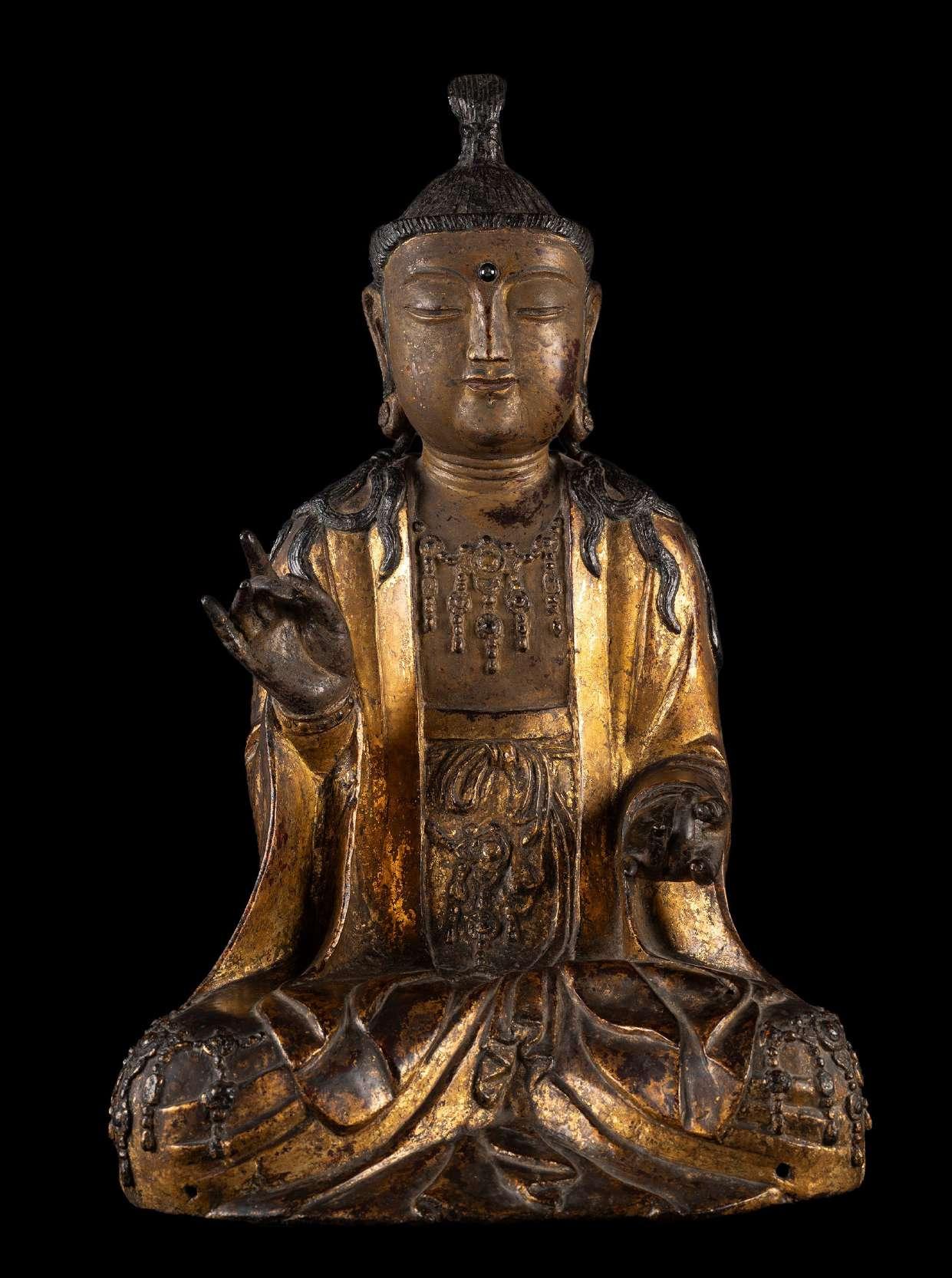
A comparable gilt-bronze figure of a bodhisattva of the mid-Goryeo period, dated to the 12th–13th centuries, is conserved in a Japanese collection [11] and it displays all the typical period traits: both works wear a heavy outer robe [12] that falls along the arm with broad sleeves and long undulating hair that descends over the shoulders; the upper garments fall like a sleeve and form a triangular hem over both legs [13] and in both examples the pointed termination of the innergarment fastening is visible. One notable difference in the present piece is the profusion of jewellery. Junghee Lee identifies such ostentatious ornamentation as more typical of the late Goryeo period (13th–14th centuries) [14] plausibly deriving from Liao (907–1125), Jin (1115–1234) and Yuan (1271–1368) Chinese influences [15]; however, as noted above, Song images were already depicted with conspicuous jewellery [16].
Mid-Goryeo examples bearing ornamentation are attested [17], notably the gilded wooden Gwaneum Bosal at Bongjeongsa [18], Andong (c. 1199). This work shares Southern Song–derived formal traits [19] with the present bronze — a bold, dignified facial expression; locks of hair falling over the shoulders; an outer robe that covers the shoulders; billowing sleeves terminating in triangular hems that drape across the knees. Together with the jewellery adorning the ears, chest and drapery at thigh level, further correspondences can be observed in the pose, the painted moustache and beard, and the long, slightly inclined eyes. Another important comparison is a gilded wooden Gwaneum Bosal in lalitāsana (royal-ease pose) in the collection of the National Museum of Korea [20], Seoul, dated to the 13th century and exhibited at the Arthur M. Sackler Gallery, Washington, D.C., in “Sacred Dedication: A Korean Buddhist Masterpiece” (21 September 2019–31 May 2020). The facial expression — with slightly slanting and elongated eyes and painted moustache and beard — the locks of hair falling over the shoulders, and the chest and garments ornamented with jewellery correspond closely to the bronze example. These transitional stylistic elements from mid-to late-Goryeo are also apparent in a gilt-bronze figure of bodhisattva Mahasthamaprapta dated to the 13th–14th centuries, preserved at Fumyo-ji temple in Japan and shown in the exhibition “Goryeo Dynasty: Korea’s Age of Enlightenment”, 918–1392 at the Asian Art Museum, San Francisco (Chong-Moon Lee Center for Asian Art and Culture, 18 October 2003–11 January 2004) [21]; Junghee Lee describes, in this group, the introduction of ornament that traverses the torso with a large central rosette as a stylistic innovation [22].
The late Goryeo period, as Junghee Lee has observed, is defined by recurrent canons in bodhisattva imagery [23]: a large head, compact proportions, short legs, a ribbon-decorated buckle, an imposing necklace, sumptuous rosette jewellery, heavy drapery, V-shaped sleeve openings and a triangular upper-robe hem resting on the thigh. Some of these are also visible on the present statue [24]. Comparable iconographic types that differ stylistically are found in the late Goryeo corpus; foremost among these is the 14th century sculpture of Gwaneum Bosal in the collection of the Jeonju National Museum [25]. The coiffure and hand position (with long, tapering fingers) are very similar; the gilding is comparable in technique and surface effect — widespread and uniform on the robe, and surviving only in small traces on face, chest and hands — and the lavish jewellery belongs to the same typology. Differences in facial expression, the absence of the triangular hem on the right thigh and the lack of the pointed fastening ribbon for the inner robe, together with the more slender proportions of the sculpture, suggest a possibly earlier date for the present example.
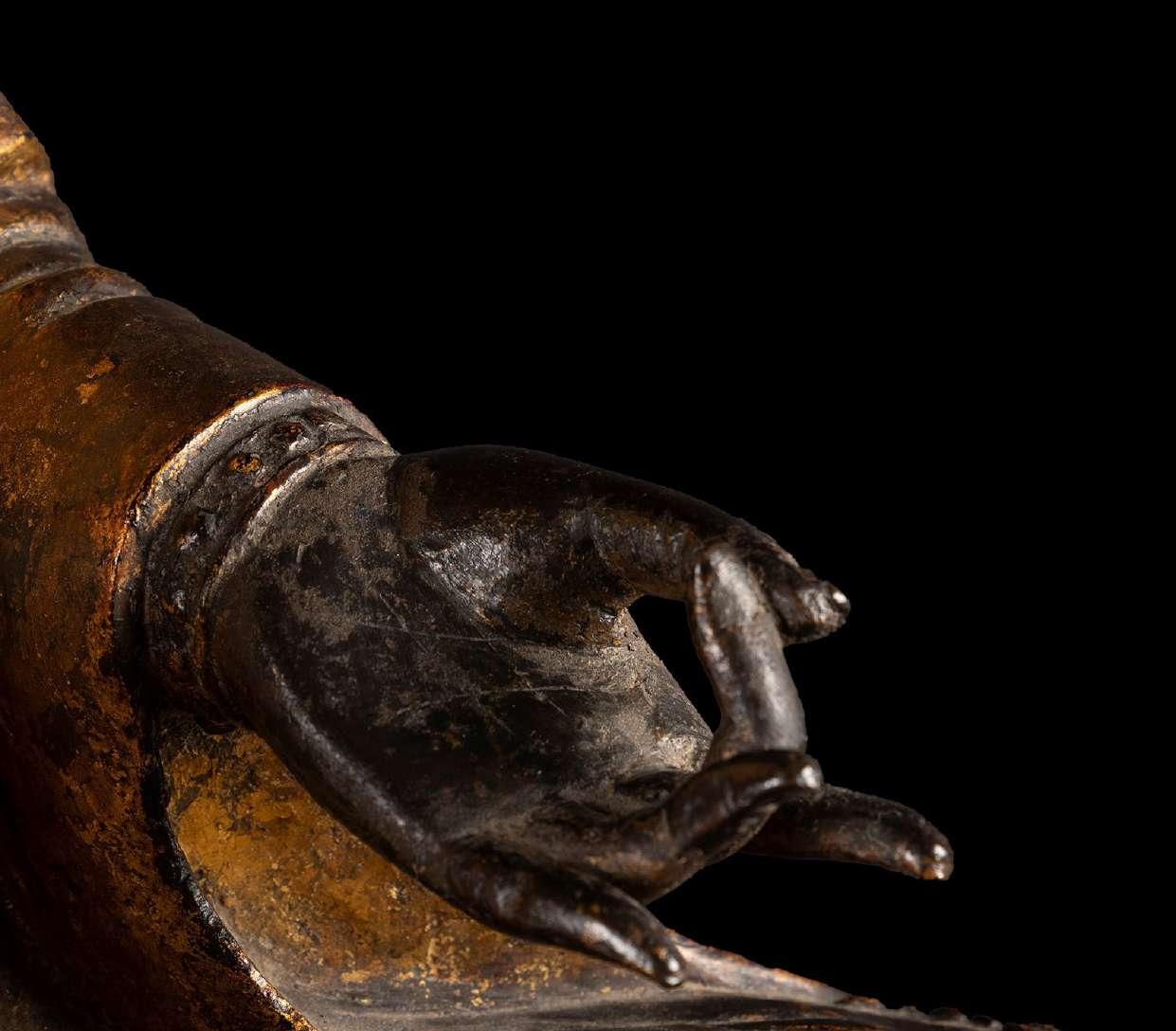
To trace the development of the style and distinctions within the late period, consult also the 14th century Gwaneum Bosal originally gilded and preserved at Kannon-ji Temple [26], Tsushima and two 14th century figures held by the National Museum of Korea [27], Seoul.
Finally, from an iconographic perspective, depictions of Avalokiteśvara became especially popular during the Goryeo dynasty, particularly in the Water-andMoon Avalokiteśvara type [28], as widely seen in 14th-century paintings, including those in the Metropolitan Museum of Art [29], New York, and the Smithsonian’s National Museum of Asian Art, Washington, D.C. [30]. As Junghee Lee observes: “these depictions were not popular during the Liao and Yuan periods, but they were in the Song and Jin periods in China, as well as in late Goryeo, indicating that Song iconography remained relevant. Although the opulent style of the images is of Yuan date, the iconography remained traditional” [31]. Together with the gilt-wooden statue of Water-and-Moon Avalokitesvara in the National Museum of Korea, the gilded iron example at the Guimet and the wooden figure at Bongjeongsa, the present work attests to the depiction of this bodhisattva already before the late Goryeo period, mitigating the perceived scarcity of such images and highlighting how the forms that became widespread in the late period gradually evolved from earlier prototypes.
This large gilt-bronze functions as a crucial intermediary example within the Goryeo corpus, bridging mid-and late-Goryeo idioms. Its combination of a compact, orthogonal body, painted moustache and beard, long locks gathered into a chignon, and extensive rosette jewellery aligns it closely with the Sennyūji wooden example and the gilded wooden Gwaneum Bosal at Bongjeongsa. Rather than representing a mere adoption of Song prototypes, this bronze demonstrates how Goryeo sculptors synthesized Chinese formal elements (notably Song hair and facial modelling) with local conventions (heavy drapery, triangular hems, and specific ornament typologies), producing a distinct regional variant that was evidently mobile across East Asian networks: Goryeo played a significant role in shaping Avalokiteśvara [32], and the present bronze stands as a clear witness to this development. In conclusion, the coexistence of Songderived elements and all the distinctive characteristics of the mid-Goryeo phase that place this sculpture in that point — combined with the incipient iconographic and stylistic innovations of the late dynasty — make this object a singular and precise marker of stylistic development within the Goryeo period. Above all, given that the Bongjeongsa statue is probably the product of local aristocratic patronage in Goryeo [33], the close resemblance of the present bronze suggests that it may represent another significant instance of such patronage.


Footnotes:
[1] Pak and Whitfield 2002, pag. 366.
[2] Pak and Whitfield 2002, pag. 366; K. P. Kim, Choi, Ide, J. Y. Kim, Lee, Pak and Shulz 2003, pag. 140.
[3] K. P. Kim, Choi, Ide, J. Y. Kim, Lee, Pak and Shulz 2003, pag. 141.
[4] C. Kim and W. Kim 1966, pag. 169.
[5] Cat. MG 15369.
[6] K. P. Kim, Choi, Ide, J. Y. Kim, Lee, Pak and Shulz 2003, pag. 14.
[7] K. P. Kim, Choi, Ide, J. Y. Kim, Lee, Pak and Shulz 2003, pag. 142.
[8] Jeong 2013, pag. 45, fig. 8; see: https://www.ijkaa.org/v.7/0/40/117.
[9] The author discusses Avalokiteśvara as a “maritime” bodhisattva, whose identity and cult were closely tied to the oceans of East Asia from at least the tenth century. This characterization reflects both the trans-cultural circulation of Avalokiteśvara’s images among Song China, Goryeo, and Japan, and the bodhisattva’s role as a conduit for the diffusion of artistic and religious forms along maritime routes. Portable statuettes, often found in coastal contexts or recovered from shipwrecks, further attest to the dissemination of Avalokiteśvara’s cult across maritime networks. The Sennyūji statue exemplifies this transoceanic typology: while the icon does not explicitly depict an aquatic environment, it embodies the flexible, mobile, and relational qualities of Avalokiteśvara’s worship, translating wide-ranging maritime connections into a localized visual and ritual program.
[10] Cat. M.90.72.4.
[11] Illustrated in K. P. Kim, Choi, Ide, J. Y. Kim, Lee, Pak and Shulz 2003, pag. 141, fig.3.
[12] According to Junghee Lee, this heavy upper robe becomes one of the characteristic features of Korean bodhisattva and Buddha images from the mid-Goryeo period through the Joseon era, see K. P. Kim, Choi, Ide, J. Y. Kim, Lee, Pak and Shulz 2003, p.142.
[13] Junghee Lee notes that this becomes an important motif in late-Goryeo bodhisattva images, see K. P. Kim, Choi, Ide, J. Y. Kim, Lee, Pak and Shulz 2003, p. 142. Note that in the late Goryeo period it appears only on the left knee, whereas in the early–mid Goryeo it is found on both legs.
[14] K. P. Kim, Choi, Ide, J. Y. Kim, Lee, Pak and Shulz 2003, pag. 161.
[15] Shin, Yi and Park 2019, pag. 110; K. P. Kim, Choi, Ide, J. Y. Kim, Lee, Pak and Shulz 2003, pag. 142.
[16] Shin, Yi and Park 2019, pag. 110. The Yuan influence is perhaps more evident in the presence of jewellery upon the garments; see, for comparison, a Guanyin in qingbai porcelain at the Metropolitan Museum of Art, New York: Cat. 51.166.
[17] Jeong 2013, pag. 41.
[18] Illustrated in Jeong 2013, pag. 47, fig. 11.
[19] Jeong 2013, pag. 47.
[20] Cat. 덕수953; illustrated in Shin, Yi and Park 2019, pag. 7, fig.2. For the exhibition see: https://www.smithsonianmag.com/artsculture/rare-centuries-old-korean- buddhistmasterpiece-goes-view-180973337/.
[21] Illustrated in K. P. Kim, Choi, Ide, J. Y. Kim, Lee, Pak and Shulz 2003, pag. 160-161, pl. 47.
[22] K. P. Kim, Choi, Ide, J. Y. Kim, Lee, Pak and Shulz 2003, pag. 142; Junghee Lee observes also that the figure lacks the triangular fold on the left thigh, a feature that becomes characteristic of late-Goryeo bodhisattva imagery. This absence, coupled with other shared traits, underscores the piece’s proximity to the developing late-period idiom without fully aligning it with the mature lateGoryeo canon.
[23] K. P. Kim, Choi, Ide, J. Y. Kim, Lee, Pak and Shulz 2003, pag. 143.
[24] The fifth, the sixth, seventh and eighth elements are also appreciable in the present sculpture, while the ninth, as noted above, is present on both thighs, once again confirming the exceptional delineation of this stylistic transition.
[25] Cat. 덕수 4238, https://jeonju.museum.go.kr/relic.es?mid=a10504000000&seq=196&act=view; illustrated in Pak and Whitfield 2002, pl. 83, pag. 364.
[26] Pak and Whitfield 2002, pl. 84, pag. 365.
[27] Cat. 구6241; cat. 덕수 75.
[28] Shin, Yi and Park 2019, pag. 110.
[29] Cat. 14.76.6.
[30] Cat. F1904.13.
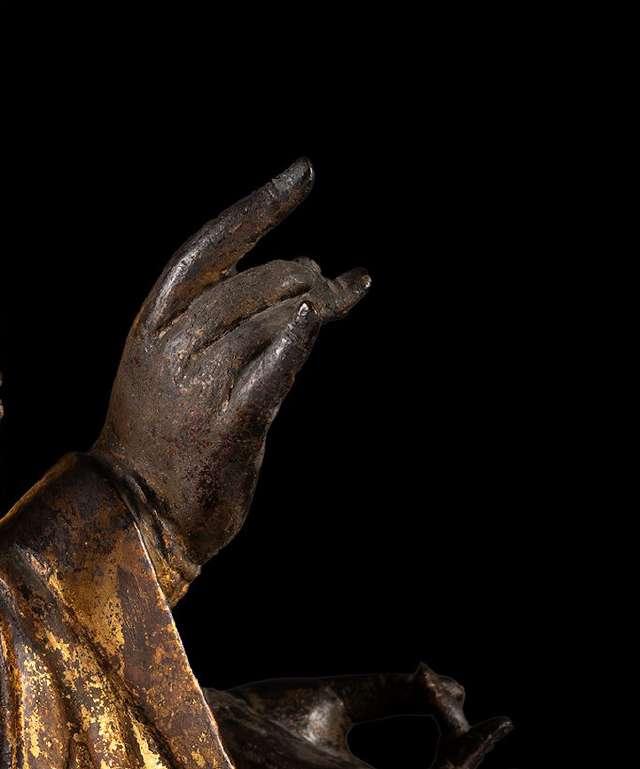
[31] K. P. Kim, Choi, Ide, J. Y. Kim, Lee, Pak and Shulz 2003, pag. 144. The Song influence also confirmed in Shin, Yi and Park 2019, pag. 110.
[32] Fu 2025, pag. 38-41.
[33] Fu 2025, pag. 38.
Bibliography:
Chewon Kim and Won-Yong Kim 1966, The Arts of Korea – Ceramics-Sculpture-Gold Bronze and Lacquer, London.
Fu Emma Yujia 2025, Res: Anthropology and Aesthetics Volume 83 Number 1 Spring 2025 pp. 22-48 – Configuring a transoceanic Avalokiteśvara-The Sennyūji statue, University of Chicago Press for the Peabody Museum of Archaeology and Ethnology Harvard University, Chicago.
Jeong Eunwoo 2013, Journal of Korean Art & Archaeology Vol.7 pp. 40-59 – Mid-Goryeo Buddhist Sculpture and the Influence of Song-Dynasty China, National Museum of Korea, Seoul.
Kumja Paik Kim, Eung-Chon Choi, Seinosuke Ide, Jae Yeol Kim, Junghee Lee, Youngsook Pak and Edward Shultz 2003, Goryeo Dynasty, Korea’s Age of Enlightenment, 918-1392, San Francisco.
Shin Soyeon, Yi Yonghee & Park Seungwon 2019, Research Report on a Seated Wooden Avalokiteshvara (duk 953) (English trans. Sunwoo Hwang; edited by Keith Wilson), National Museum of Korea; Freer Gallery of Art and Arthur M. Sackler Gallery, Seoul; Washington D.C. Youngsook Pak and Roderick Whitfield 2002, Handbook of Korean Art, Buddhist Sculpture, London.
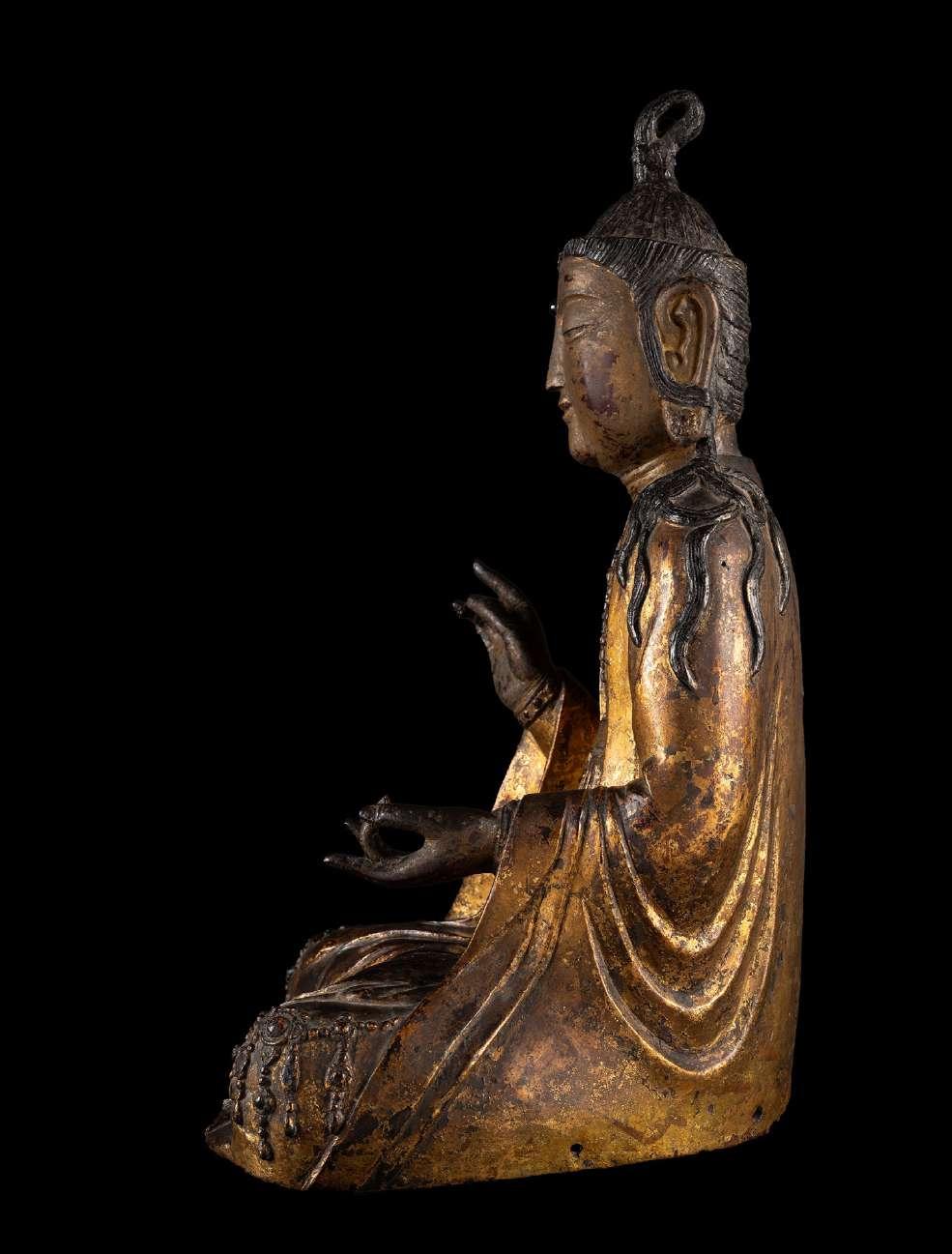
Scientific data:
This report synthesises the analytical evidence available for a gilt-bronze seated Gwaneum Bosal (h. 52 cm), and presents a reasoned attribution to the Goryeo dynasty (918–1392 CE). The dataset comprises an independent thermoluminescence certificate by Oxford Authentication, a thermoluminescence analysis including a direct alpha-activity measurement on the casting core by Turin Thermoluminescence Analysis, and targeted handheld XRF spot analyses conducted by Dr Andrea Ciaroni (Olympus Vanta).
1. Thermoluminescence (TL): Oxford Authentication and TTA — data and interpretation Oxford Authentication reports the last hightemperature event as “between 700 and 1000 years ago”, corresponding approximately to c. 1025–1325 CE and therefore placing the firing squarely within the Goryeo period. Turin Thermoluminescence Analysis (TTA, Fantino) recorded De = 8.2 ± 0.7 Gy and a measured alpha activity used to refine the annual dose estimate; the laboratory reports a conservative interval 600–1000 CE with a central estimate ≈ c. 850 CE. Although TTA’s central estimate is earlier than Oxford’s, both independent thermoluminescence (TL) assessments indicate an ancient high-temperature resetting of the casting-core material and are therefore inconsistent with recent manufacture. Oxford’s lower bound (≈1025 CE) lies only ~25 years after the conservative upper bound reported by TTA (≈1000 CE); this close adjacency of independently derived intervals is concordant with a last firing around the turn of the first and second millennia CE (late 10th–early 11th century) and, read conservatively, supports attribution to an early–mid Goryeo casting event.
2.XRF compositional evidence and technological reading.
1. Alloy composition (bulk). The bulk rim/base Geochem(2) measurement (Dr A. Ciaroni) yields Cu 74.791%, Sn 12.533%, Pb 7.368%, Fe 1.384%, As 1.259%, Ag 0.618%. This composition corresponds to a ternary Cu–Sn–Pb alloy commonly observed in medieval Korean statuary. For direct comparison, published reference points include: statue in Goseongsa Temple [2] (low Pb) – Cu 81.26 / Sn 16.42 / Pb 1.72; statue in Janggoksa Temple [1] (high Pb) — Cu 68.80 / Sn 10.40 / Pb 17.10; selected intra-object points from a statue in the National Museum of Korea [3] (face/crown/wrist) demonstrate pronounced intra-object variability (see table), with localized zones of elevated Pb and marked Au/Hg surface enrichment. The subject alloy therefore occupies an intermediate position between the low- Pb and high-Pb endmembers documented in the Goryeo corpus, consistent with known workshop variability.
* Values of Gwaneum Bosal are from handheld/spot XRF; surface-weighted effects (gilding, lacquer, patina) and matrix effects can bias surface measurements.
2. The intermediate Pb content (≈7%) is within the technological envelope documented for Goryeo bronzes and is plausibly explained by differences in casting practice, object function and local workshop choices (e.g. selective use of high-lead alloys for small detailed elements versus lower-lead bulk alloys).
3. The measured Fe 1.384% and As 1.259%, together with residual Ag ≈ 0.4–0.7% across multiple runs, match signatures reported for other medieval Korean bronzes. Iron at ~1% commonly reflects ore or furnace/tool contamination; arsenic, although relatively high, is plausibly derived from sulfidic copper ores (e.g. chalcopyrite/arsenopyrite); residual silver is typical of argentiferous copper sources and incomplete historic desilvering. These impurity patterns favour traditional smelting/working rather than modern refined metal.
4. A targeted precious-metals run on the robe records Au 10.676% (Precious Metals profile) with no detectable Ni/Cr interlayers within the instrument LOD — a result that argues against modern electroplating. This composition is compatible with historic gilding practices; note that the absence of detectable Hg does not exclude historical amalgam because mercury may volatilise during firing and may fall below XRF detection limits.
5. The XRF signature measured on the black lacquered hair (strong organic fraction, LE ≈ 63%; Si, Ca, K; Cu/Sn/Pb attenuated beneath the film; Fe, Al, As at ppm levels) is qualitatively consistent with a traditional Goryeo lacquer system. Further comparisons with technical studies of Goryeo Buddhist bronzes show the same pattern: the National Museum of Korea reports a late-Goryeo/ early-Joseon gilt-bronze seated bodhisattva [4] whose black surface (hair included) bears a lacquer layer mixed with bone powder, and experimental/analytical work confirms that bone powder (Ca, P) was commonly added to lacquers and produces a thicker, more rapidly curing lacquer layer— findings consistent with XRF by Dr Ciaroni (Ca, P, Pb attenuated beneath an organic film) [5]. The overall pattern — ternary Cu–Sn–Pb alloys with wide Sn/Pb variation, metallurgical impurities (Fe, As, Ag), surface Au enrichment and differences between surface and bulk due to lacquer/patina — is exactly the pattern documented in the regional literature. The XRF dataset therefore aligns with established metallurgical and finishing repertoires for high-quality Goryeo gilt bronzes.
3. Conclusion Independent, convergent lines of technical evidence support attributing the gilt-bronze Gwaneum Bosal to the Goryeo dynasty (918–1392 CE):
- Thermoluminescence: two independent TL assessments (Oxford Authentication certificate; TTA) both demonstrate an ancient clay casting core and therefore exclude recent manufacture.
- XRF and comparative metallurgical literature: the bulk Cu–Sn–Pb composition, trace impurities (Fe, As, Ag), the presence of genuine surface gilding (Au 10.676%), and the absence of modern plating markers (Ni/ Cr) are coherent with documented Goryeo workshop practice and finishing techniques.
Overall, the analytical package justifies a working attribution to the Goryeo dynasty.
Bibliography:
[1] Bae Go Woon, Lee Sang Ok, Beom, Dae Geom, Chung, Kwang Yong 2018, Manufacturing Techniques and Provenance of Gilt bronze Seated Bhaisajyaguru (Medicine Buddha) Statue of Cheongyang Janggoksa Temple, Korea, Journal of Conservation Science, vol. 34, n.1, pag. 59–67.
[2] Bae Go Woon, Lee Sang Ok, Beom, Dae Geom, Chung, Kwang Yong 2024. Manufacturing Techniques of Bronze Seated Bodhisattva Statue of Goseongsa Temple in Gangjin, Korean Journal of Heritage: History & Science, vol. 57, n. 1, pag. 146–159.
[3] Gwak Hong In, Kwon Mi Hye 2019, A Study on Conservation and Manufacturing Techniques of a Seated Avalokiteshvara with a Thousand Hands of Goryeo Dynasty, Journalof Conservation Science, vol. 35, n. 3, pag. 253–258.
[4] Shin Soyeon 2017, Zoom in – Gilt-bronze seated Bodhisattva, National Museum of Korea, NMK Magazine, vol. 38.
[5] Park Jongseo 2024, Study on the Function of Bone Powder in the Drying of Asian Lacquer Containing it, Korean Journal of Conservation Science, vol. 40, n. 3.
韩国 高丽时期(918-1392 年) 重要且罕见的鎏金铜观世音菩萨像

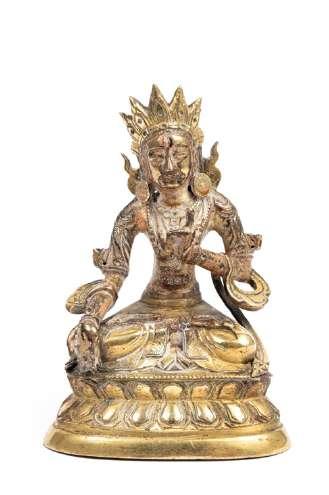
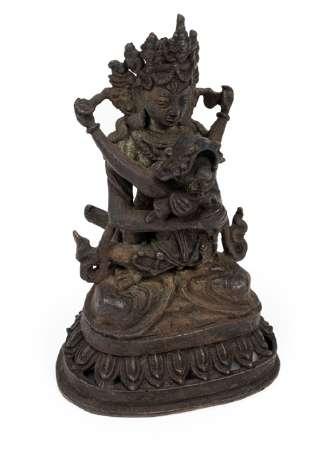
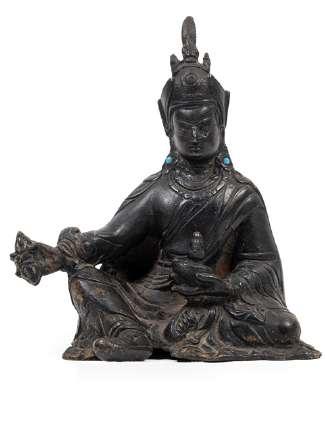
A BRONZE FIGURE OF WHITE TARA, Tibet, 18th century
h cm 13
€ 1.000 / 1.500
Seated in padmasana on a double lotus base, with her right hand in the traditional varada mudra and her left hand in kartari mudra; her dhoti is finely adorned with jewelry and decorated with lotus motifs.
SCULTURA IN BRONZO DORATO, Tibet, XVIII secolo
Raffigurante Tara Bianca seduta in padmasana su una base a doppio fiore di loto, con la mano destra nella tradizionale varada mudra e la sinistra in kartari mudra; il dhoti è finemente adornato con gioielli e decorato con il motivo del loto.
A BRONZE FIGURE OF VAJRADHARA, China, Qing dynasty (1644-1911)
h cm 12,5
€ 800 / 1.000
Seated in padmasana (lotus position) on a lotus base, in yab yum with his consort Vajradakini.
FIGURA IN BRONZO, Cina, dinastia Qing (1644-1911)
Raffigurante Vajradhara seduto in padmasana (posizione del loto) su una base a fiore di loto, in yab yum con la consorte Vajradakini.
A BRONZE FIGURE OF AVALOKITEsVARA, Nepal, late 19th century
h cm 15,6
€ 1.000 / 1.500
Seated in rajalilasana, with the right hand in dhyana mudra holding a vase of longevity, and the left hand grasping a vajra.
FIGURA IN BRONZO, Nepal, fine XIX secolo
Figura di Avalokitesvara seduto in rajalilasana (posa regale), con la mano destra in gesto di meditazione (dhyana mudra) mentre sostiene un vaso della longevità, e la mano sinistra che regge un vajra.

A LARGE STONE FIGURE OF GREEN TARA,
Nepal, 17th / 18th century
127 € 12.000 / 15.000
Seated cross-legged on a double-lotus base, with the right hand in varadamudra and the left holding the stem of a lotus flowering along the upper arm. She wears a dhoti and jeweled ornaments, exuding a serene and graceful presence.
GRANDE FIGURA IN PIETRA, Nepal, XVII / XVIII secolo h cm 48,5
Raffigurante Tara Verde seduta a gambe incrociate su una base a doppio loto, con la mano destra in varadamudra e la sinistra che sostiene il gambo di un loto in fiore lungo il braccio superiore. Indossa un dhoti e ornamenti gioiellati, con un portamento armonioso e sereno.
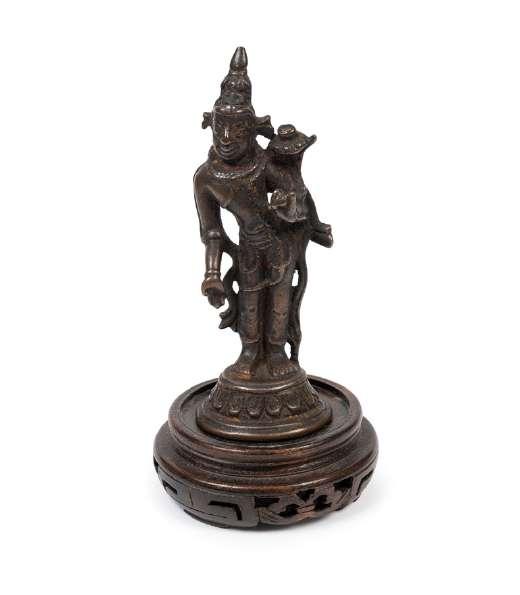
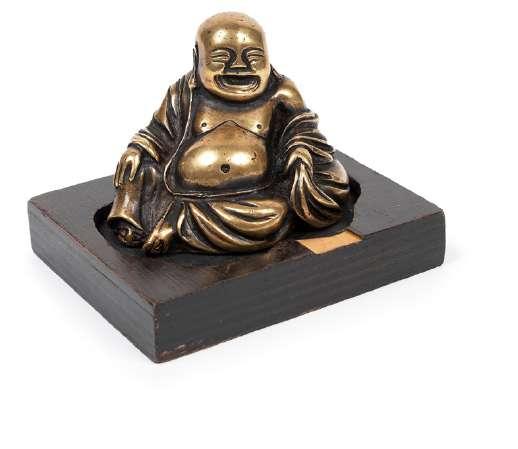
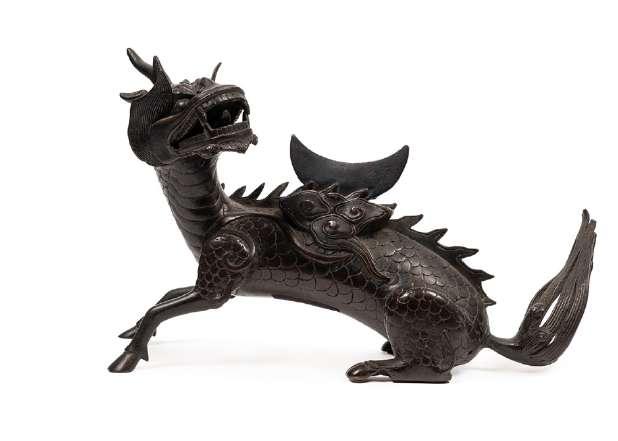
128
A SMALL BRONZE FIGURE, Nepal, 14th /15th century
h cm 11
€ 600 / 1.000
Depicting Tara seated on a lotus-base.
PICCOLA FIGURA IN BRONZO, Nepal, XIV / XV secolo
Raffigurante Tara assisa su una base a fiore di loto.
尼泊尔14/15世纪 铜佛像
129
A SMALL FIGURE OF LAUGHING BUDDHA, China, Qing dynasty, 19th century
h cm 5,5
€ 600 / 800
Depicted seated.
PICCOLA FIGURA DI BUDDA IN BRONZO DORATO, Cina, dinastia Qing, XIX secolo
Raffigurante il budda che sorride seduto.
清 19世纪 铜镀金布袋和尚
130
A BRONZE MIRROR STAND, China, 17th / 18th century
l cm 36
€ 600 / 800
Depicting a kirin shown looking back over its shoulder. The body, resembling that of a deer, is enhanced with a flaming mane and, amid stylized clouds, supports a crescentshaped base.
PORTA SPECCHIO IN BRONZO, Cina, XVII / XVIII secolo
Raffigurante un kirin rappresentato mentre volge lo sguardo all’indietro. Il corpo, simile a quello di un cervo, è arricchito da una criniera fiammeggiante e, tra nuvole stilizzate, sostiene una base a mezzaluna.
17/18世纪 铜制瑞兽形镜架
A
BRONZE
TRIPOD-CENSER,
China, Qing dynasty (1644-1911)
h cm 7
€ 600 / 800
Resting on three legs and flanked by two handles; the base bears a four-character square mark.
INCENSIERE TRIPODE IN BRONZO, Cina, dinastia Qing (1644-1911)
Si regge su tre piedi e ai lati reca due anse; alla base presenta un marchio quadrato a quattro caratteri.
清 铜压经炉 底款“珍舍永宝”
132
A BRONZE CENSER, China, Qing dynasty (1644-1911)
h cm 8,5 x d cm 12, 5
€ 1.000 / 1.500
Of globular form with a slightly flared neck, it features two eagle-shaped handles. The base bears an apocryphal mark of the Emperor Xuande.
INCENSIERE IN BRONZO, Cina, dinastia Qing (1644-1911)
Dalla forma globulare, con il collo leggermente svasato, presenta due anse a forma di aquila. Alla base reca marchio apocrifo dell’Imperatore Xuande.
清 狮耳簋式炉 底款“大明宣德年制”
133
A BRONZE CENSER, China, Qing dynasty (1644-1911)
h cm 7,5 x d cm 9,5
€ 600 / 800
Of globular form with a slightly flared neck, it features two leonine handles and bears an apocryphal mark of the Emperor Xuande on the base.
INCENSIERE IN BRONZO, Cina, dinastia Qing (1644-1911)
Dalla forma globulare con collo leggermente svasato, presenta due anse leonine, alla base reca marchio apocrifo dell’Imperatore Xuande.
清 狮耳簋式炉 底款“大明宣德年制” 131
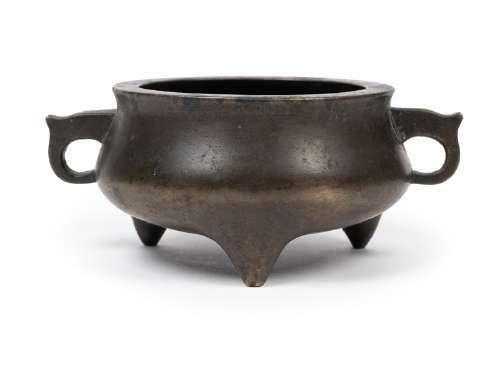
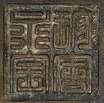

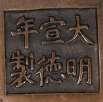
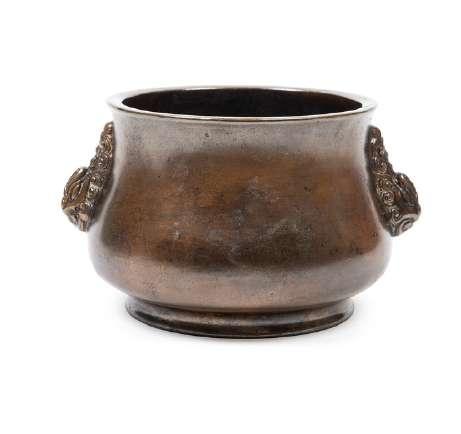
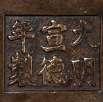
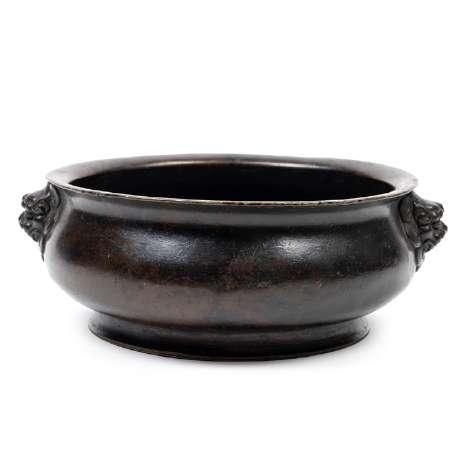

A BRONZE CENSER, China, 17th century
134 € 4.000 / 6.000
Of compressed globular form with a flared rim, resting on a raised foot, the sides are set with two lion-head handles; the base bears an apocryphal six-character mark of the Emperor Xuande.
INCENSIERE IN BRONZO, Cina, XVII secolo d cm 18,5
Dal corpo globulare compresso con orlo svasato, che si regge un piede rialzato, ai lati presenta due anse a testa di leone; sulla base reca il marchio apocrifo a sei caratteri dell’Imperatore Xuande.
17世纪 狮耳簋式炉 底款“大明宣德年制”
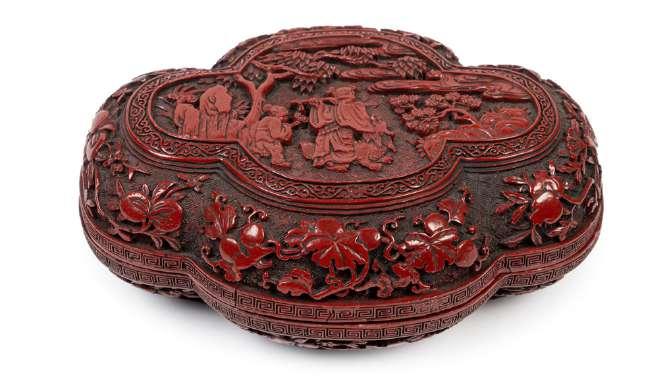
A CINNABAR-LACQUER ‘QUATREFOIL’ BOX, China, Qing dynasty (1644-1911)
h cm 7 x l cm 16
135 € 1.500 / 2.500
Lobed with four petals, finely carved in high relief against a ground incised with a honeycomb pattern, depicting a scene of a man in a garden playing the flute, surrounded by a kirin and a boy holding a ruyi; the sides are decorated with vine scrolls bearing peaches, pomegranates, and Buddha’s hand citrons.
SCATOLA IN LACCA DI CINABRO ROSSA, Cina, dinastia Qing (1644-1911)
Lobata con quattro petali, è ben intagliata ad alto rilievo su un fondo inciso con motivi a nido d’ape, con una scena di un uomo in un giardino che suona il flauto mentre un kirin e un ragazzo con un ruyi in mano lo circondano; ai lati è decorato con tralci di vite, pesche, melagrani e mani di Budda.
清 剔红人物故事海棠形盖盒
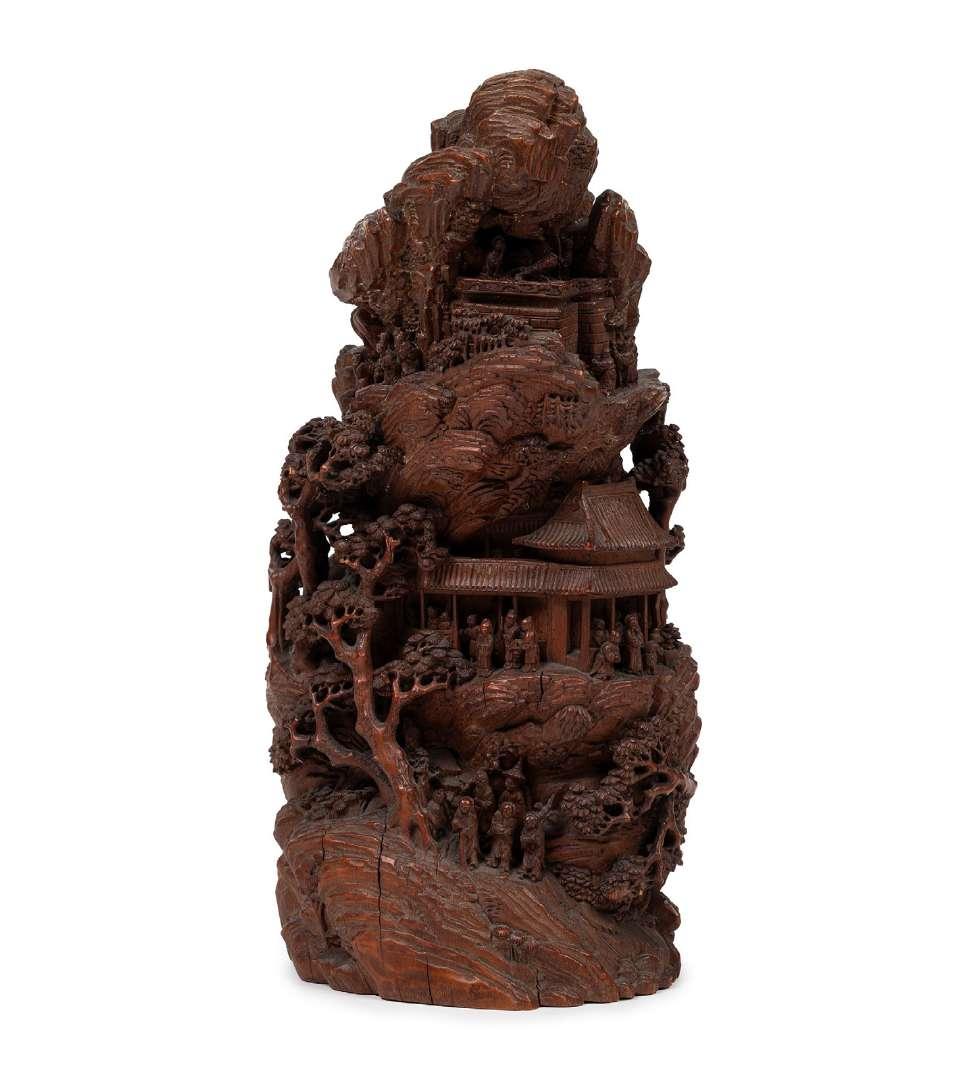
A LARGE BAMBOO CARVING OF A MOUNTAIN,
China, Qing dynasty, 18th / 19th century
h cm 31,5
136 € 3.000 / 5.000
Shaped like a mountain, it is finely and deeply carved in high relief, depicting a gathering of scholars assembled in pavilions nestled among pine trees and rocks.
Catalogue note: A nearly identical sculpture was sold at Christie’s, Live Auction 2689, Fine Chinese Ceramics and Works of Art, 21–22 March 2013, New York, lot no. 1314.
GRANDE SCULTURA IN BAMBÙ,
Cina, dinastia Qing, XVIII / XIX secolo
A forma di montagna è finemente e profondamente scolpita a alto rilievo dove è rappresentato un raduno di studiosi riuniti nei padiglioni immersi tra i pini e le rocce.
Note di catalogo: Una quasi identica scultura è stata venduta da Christie’s, asta live 2689, Fine Chinese Ceramics and Works of Art, 21-22 Marzo 2013, New York, lot. n° 1314.
清18/19世纪 竹根雕山峦亭台楼阁和人物意境摆件
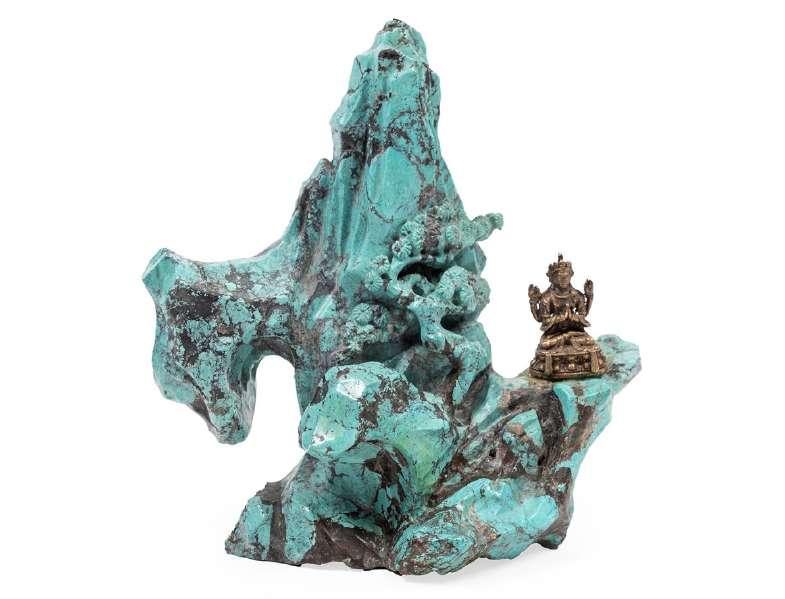
A TURQUOISE SCULPTURE, China, Qing dynasty, 19th century
h cm 15,5 x l cm 16
Well carved, it depicts a sacred mountain adorned with lingzhi and accompanied by a small gilt-bronze figure of Avalokiteshvara, seated in padmāsana (lotus position) with hands joined in añjali mudrā.
SCULTURA IN TURCHESE, Cina, dinastia Qing, XIX secolo
Ben intagliata, raffigura una montagna sacra ornata da lingzhi e accompagnata da una piccola figura di Avalokiteshvara in bronzo dorato, seduta in padmāsana (posizione del loto) con le mani giunte in añjali mudrā.
19世纪 铜坐像绿松石山子

€ 2.000 / 2.500 € 200 / 300
A SOAPSTONE SEAL, China, 19th
/ 20th century
h cm 7,8
The rectangular structure is surmounted by two figures washing an elephant. An inscription is carved on the base.
SIGILLO IN PIETRA SAPONARIA, Cina, XIX
/ XX secolo
La struttura rettangolare è sormontata da due figure che lavano un elefante. Reca iscrizione alla base.
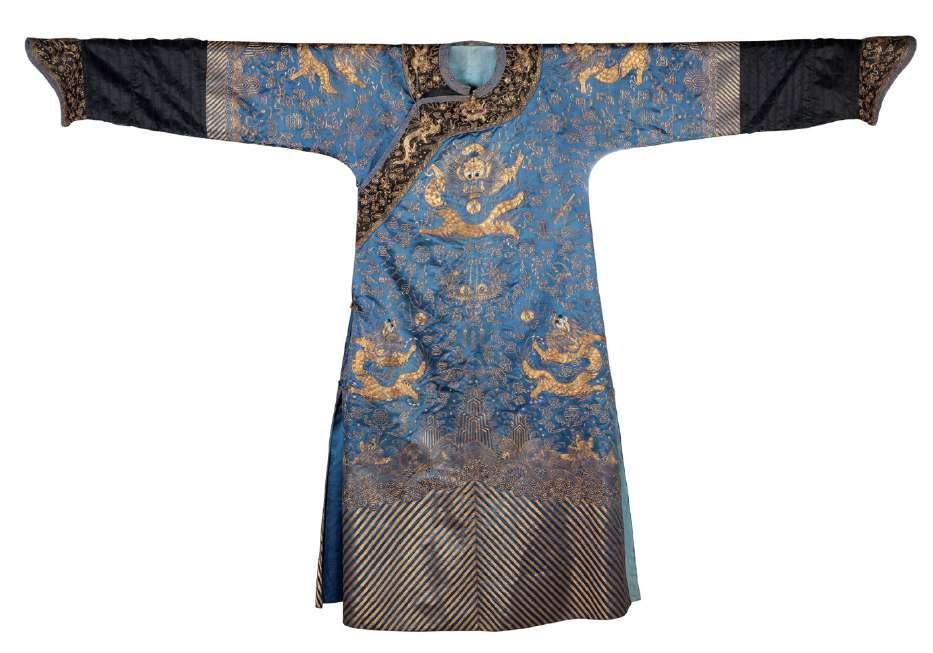
139
AN EMBROIDERED SILK ROBE, China, Qing dynasty, 19th century
h cm 145 x l cm 220
140 € 1.500 / 2.000
A
LARGE
Figures in Mandarin style among the landscapes with flowers and trees.
PLACCA IN PORCELLATA FAMIGLIA ROSA, Probabilmente Europa, XIX / XX secolo
Figure in stile mandarino tra paesaggi con fiori e alberi.
清19世纪 蓝地盘金绣龙袍
EMBROIDERY
ON SILK, China, Qing dynasty, 19th century
l cm 104,5 x p cm 104
€ 1.800 / 2.000
Finely decorated on a blue ground with stylized clouds, shou symbols, waves, and bats, featuring four five-clawed dragons at the sides and a central circular panel containing an additional dragon.
GRANDE TESSUTO
IN
SETA RICAMATA,
Cina, dinastia Qing, XIX secolo
Finemente decorato su fondo blu con nuvole stilizzate, simboli shou, onde e pipistrelli, presenta quattro dragoni a cinque artigli ai lati e una riserva circolare centrale contenente un ulteriore drago.
清晚期 蓝地五龙捧寿云纹垫面
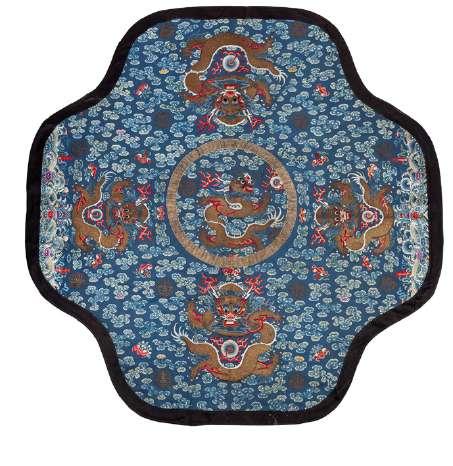
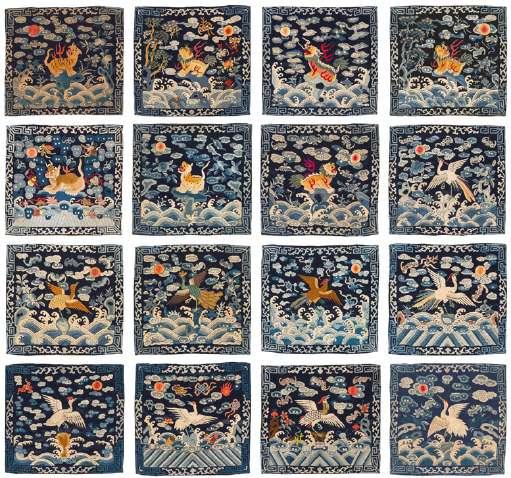
SIXTEEN EMROIDERY SILK ‘RANK BADGES’’,
China, Qing dynasty (1644-1911)
l cm 27 x p cm 29
141 € 500 / 600
Square in form, with borders embroidered in a Greek key and floral motifs, decorated with kirin and birds on a blue ground enriched with clouds, waves, bats, and stylized foliate patterns.
SEDICI ‘RANK BADGES’ IN SETA RICAMATA, Cina, dinastia Qing (1644-1911)
Di forma quadrata, con bordi ricamati a motivo greca e decori floreali, sono decorate con kirin e volatili su fondo blu, arricchito da nuvole, onde, pipistrelli e motivi fogliacei stilizzati.
清 官补十六件
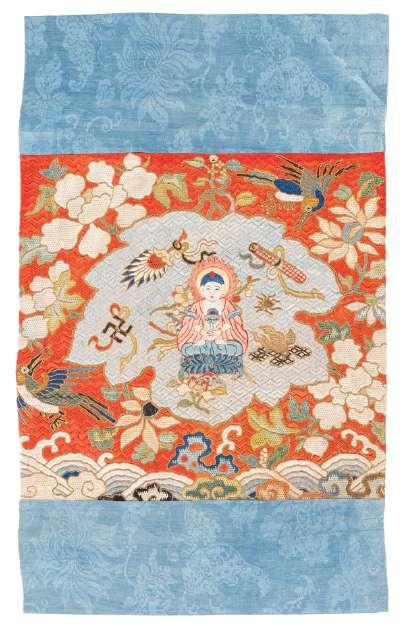
AN EMBROIDERED SILK, China, Qing dynasty, 19th century
l cm 104,5 x p cm 104
142 € 600 / 1.000
Finely embroidered on a red ground with floral motifs, stylized clouds, and birds, it is centered by a leaf-shaped panel featuring a seated Buddha on a double lotus base, surrounded by Buddhist symbols.
TESSUTO IN SETA, Cina, dinastia Qing, XIX secolo
Finemente ricamato su fondo rosso con decorazioni floreali, nuvole stilizzate e uccellini, presenta al centro una riserva a forma di foglia con la figura di un Buddha seduto su una base a doppio fiore di loto, circondato dai simboli buddhisti.
清晚期
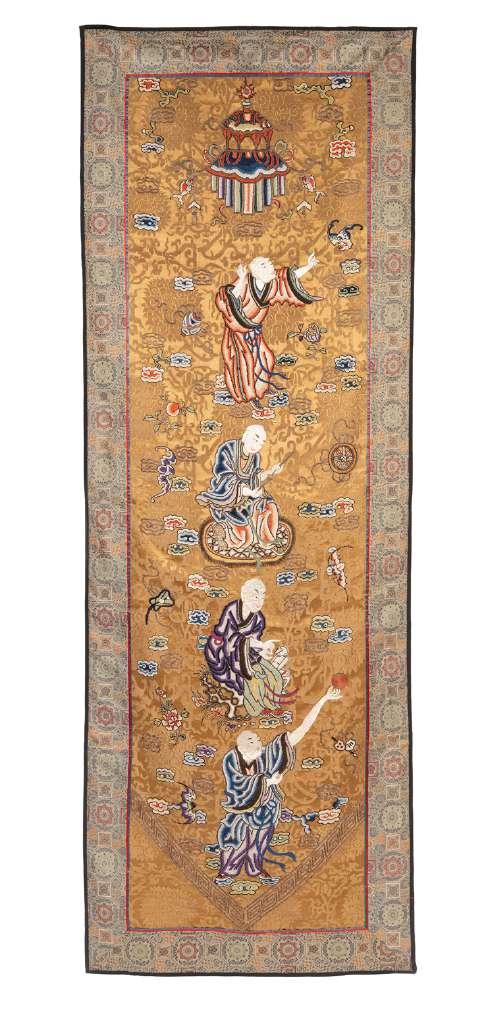
AN EMBROIDERED SILK,
China, Qing dynasty, 18th / 19th century
h cm 43 x l cm 26,3
143 € 2.000 / 3.000
Finely brocaded and embroidered decorated on a gilt ground with floral motifs, depicting four figures of arhats in a landscape with stylized clouds, bats and the eight bajixiang.
TESSUTO IN SETA, Cina, dinastia Qing, XVIII / XIX secolo
Finemente broccato e ricamato decorato a fondo oro con motivi floreali, rappresenta quattro figure di arhat in un paesaggio con nuvole stilizzate, pipistrelli e gli otto bajixiang.
清18/19世纪 织锦罗汉图
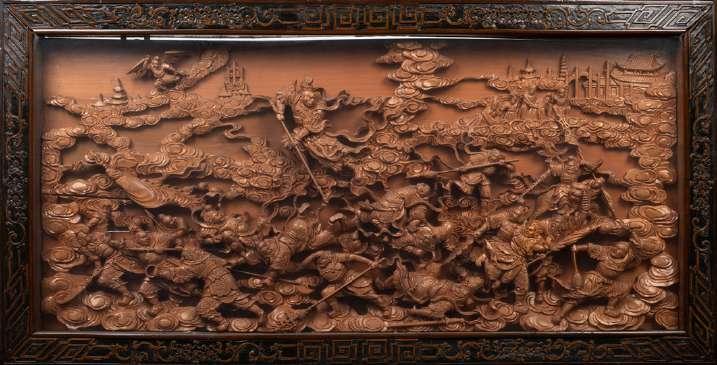
A LARGE WOOD PANEL, China, 20th century
h cm 37 x l cm 83,5
144 € 500 / 800
Finely carved and rendered in low relief, the piece depicts a battle scene with the legendary Monkey King, Sun Wukong, soaring among the clouds wielding his magical staff, Ruyi Jingu Bang, while the soldiers below flee in terror amidst stylised clouds and rocks. The entire scene is framed by a finely carved border, adorned with Greek-key motifs and delicate floral ornamentation.
GRANDE PANNELLO IN LEGNO, Cina, XX secolo
Finemente intagliato e scolpito a bassorilievo, raffigura una scena di battaglia con il leggendario Re Scimmia, Sun Wukong, che vola tra le nuvole brandendo il suo bastone magico Ruyi Jingu Bang, mentre i soldati sottostanti fuggono spaventati tra nuvole e rocce stilizzate. L’intera scena è incorniciata da una cornice finemente intagliata, decorata con motivi alla greca e raffinati ornamenti floreali.
20世纪 “大闹天宫”木雕作品
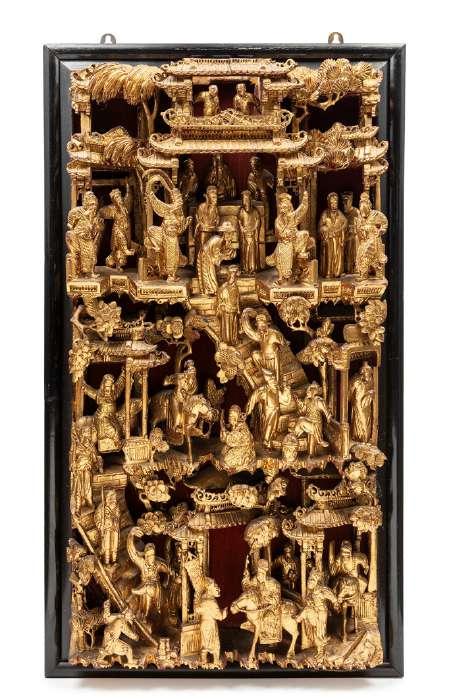
A WOODEN PANEL, China, 19th / 20th century
h cm 77 x l cm 44
145 € 300 / 600
Carved with a procession of dignitaries, soldiers, and attendants on multiple levels within a pagoda.
PANNELLO IN LEGNO, Cina, XIX / XX secolo
Intagliato con corteo di dignitari, militari e attendenti su più piani all’interno di una pagoda.
19/20世纪 潮州金漆木雕人物故事挂屏
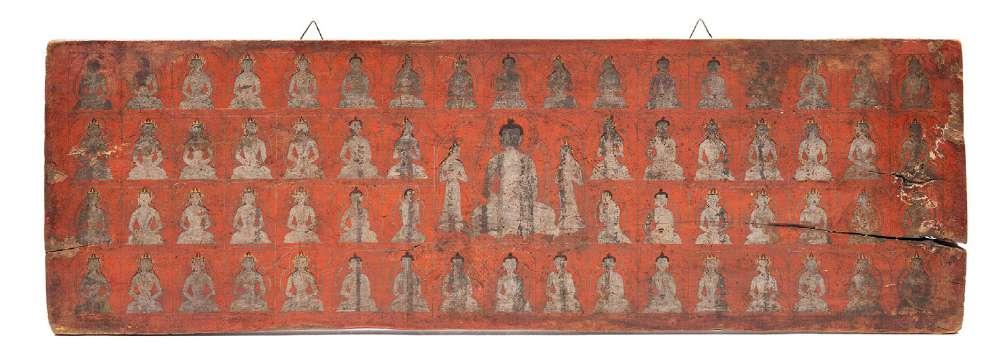
A WOODEN PANEL,
Tibet, 18th / 19th century
l cm 71 x w cm 20,5
€ 1.000 / 1.500
Of rectangular form, depicting the Buddha seated at the center, flanked by Sariputra and Maudgalyayana; four registers of deities run across the entire surface.
PANNELLO IN LEGNO, Tibet, XVIII / XIX secolo
Di forma rettangolare, raffigura il Buddha seduto al centro, affiancato da Sariputra e Maudgalyayana; quattro fasce di divinità corrono lungo l’intera superficie.
西藏 18/19世纪 佛教题材的木板彩绘作品

A
PAINTED PANEL, Nepal, 19th century
l cm 64,5 x h cm 15
€ 500 / 600
Rectangular in shape, it features inscriptions on a black background. On the sides, two pictorial panels depict respectively Buddha Śākyamuni with his disciples Ānanda and Śāriputra, and the goddess Tara accompanied by two attendants.
PANNELLO DIPINTO, Nepal, XIX secolo
Di forma rettangolare, presenta iscrizioni su fondo nero. Ai lati, due riserve figurative raffigurano rispettivamente Buddha Śākyamuni con i suoi discepoli Ānanda e Śāriputra, e la dea Tara accompagnata da due accoliti.
尼泊尔19世纪 佛教风格的经卷扉页或佛典装饰画
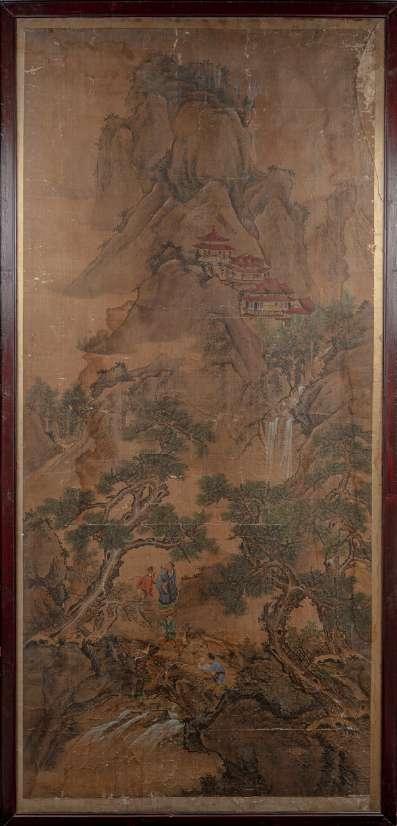
A VERY LARGE PAINTING ON SILK, China, Qing dynasty (1644-1911)
h cm 244 x l cm 122
148 € 800 / 1.200
It depicts a mountainous landscape featuring pagodas and waterfalls, with two sages and children playing with a deer along the riverbank, complemented by calligraphic inscriptions.
GRANDE DIPINTO SU SETA, Cina, dinastia Qing (1644-1911)
Raffigura un paesaggio montano animato da pagode e cascate, con due saggi e bambini che giocano con un cervo sulle rive di un fiume, completato da iscrizioni calligrafiche.

TWO PAINTED FANS, China, Qing dynasty (1644-1911)
The larger h cm 18 x l cm 52
149 € 300 / 400
One depicts a group of sages with attendants in a wooded landscape with plants, rocks, and an inscription; the other shows a boat carrying a lady, a sage, and a child, set in a river landscape with trees, rocks, and inscriptions.
DUE VENTAGLI DIPINTI, Cina, dinastia Qing (1644-1911)
Uno raffigura un gruppo di saggi con accoliti in un paesaggio alberato, con piante, rocce e iscrizione; l’altro un’imbarcazione con una dama, un saggio e un bambino, ambientata in un paesaggio fluviale con alberi, rocce e iscrizioni.

THREE
PAINTING ON SILK, China, Qing dynasty (1644-1911)
d cm 24,5
Of circular form, depicting figures in gardens. Each bears inscriptions.
TRE DIPINTI SU SETA, Cina, dinastia Qing (1644-1911)
Di forma circolare, raffigurano personaggi in giardini. Ciascuno reca iscrizioni.
清 团扇面 (三幅)

清 中国传统绘画作品(六幅) 150 151 € 300 / 500 € 300 / 400
SIX PAINTINGS ON SILK, China, Qing dynasty (1644-1911)
The larger h cm 23 x l cm 33
Two depicting scenes of daily life; two with naturalistic landscapes featuring mountains, trees, pagodas, and inscriptions; one with a floral motif and a praying mantis; and one showing two ducks in a pond.
SEI DIPINTI SU SETA, Cina, dinastia Qing (1644-1911)
Due raffiguranti scene di vita quotidiana; due con paesaggi naturalistici, caratterizzati da montagne, alberi, pagode e iscrizioni; uno con un motivo floreale e mantide religiosa; uno con due papere in uno stagno.
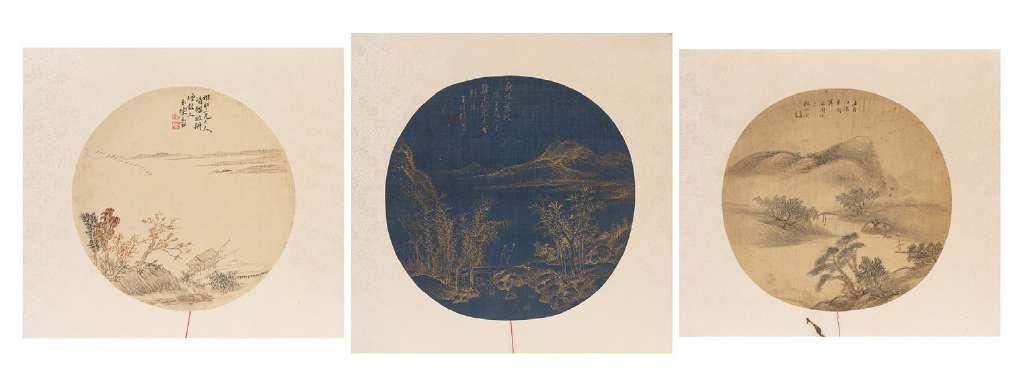
THREE PAINTING ON SILK, China, Qing dynasty (1644-1911)
The larger h cm 26,5 x l cm 28
152 € 300 / 400
Of circular form, they depict river landscapes with pagodas, fishermen, trees and mountains, accompanied by inscriptions.
TRE DIPINTI SU SETA, Cina, dinastia Qing (1644-1911)
Di forma circolare, raffigurano paesaggi fluviali con pagode, pescatori, alberi e montagne, corredati da iscrizioni.
团扇书画作品(三幅) 清(1644-1911)
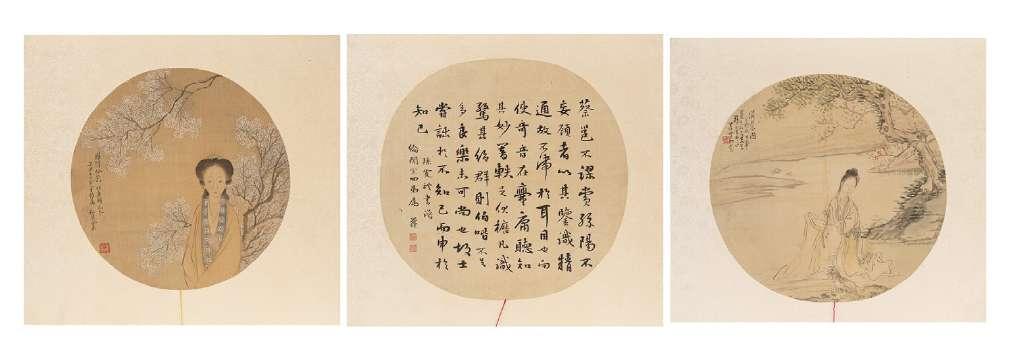
THREE PAINTING ON SILK, China, Qing dynasty (1644-1911)
The larger h cm 27 x l cm 27,5
153 € 300 / 400
Of circular form, two depict ladies in landscapes, and one bears calligraphic characters.
TRE DIPINTI SU SETA, Cina, dinastia Qing (1644-1911)
Di forma circolare, due raffigurano dame in paesaggi e una reca caratteri calligrafici.
清 团扇书画作品(三幅)
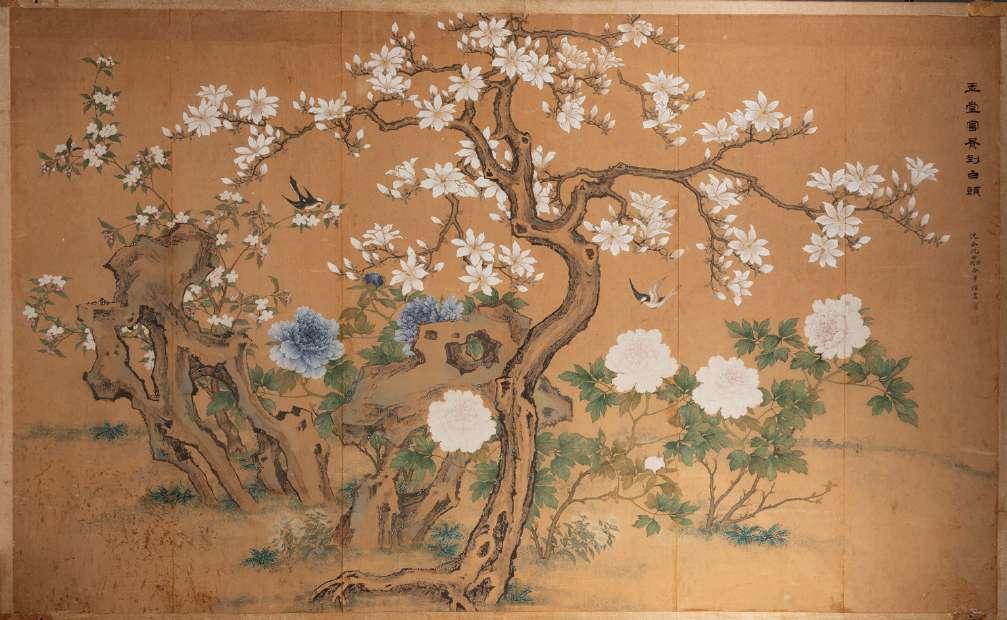
154
A PAINTING ON PAPER SIGNED BY SHEN QUAN SHEN SHIJIE E SHEN SHIRU,
China, Qing dynasty, Guangxu period (1875-1908)
h cm 155 x l cm 252
€ 5.000 / 7.000
Composed of six panels, it is finely painted with a garden scene featuring vibrant rocks, peonies, plum blossoms, and a flowering magnolia around which two swallows flutter. In the upper right corner are inscriptions bearing the names of the artists Shen Quan, Shen Shijie, and Shen Shiru.
Catalogue note:
Shen Quan was a court painter of the late Qing period, active from the Xianfeng era (1850–1861) to the Guangxu era (1875–1902).
DIPINTO SU CARTA FIRMATO DA SHEN QUAN SHEN SHIJIE E SHEN SHIRU, Cina, dinastia Qing, periodo Guangxu (1875-1908)
Composto da sei pannelli, è ben dipinto con un giardino nel quale si trovano vibranti rocce, peonie, fiori di pruno e una magnolia fiorita intorno alla quale vlteggiano due rondini; in alto a destra reca delle iscrizioni dove si leggono i nomi degli artisti Shen Quan, Shen Shijie e Shen Shiru.
Note di catalogo:
Shen Quan è stato un pittore di corte del tardo periodo Qing, attivo dal periodo Xianfeng (1850-1861) al periodo Guangxu (18751902).
玉堂富贵到白头
题款:”沈全沈世杰沈世儒合笔谨画” 上方印章:”臣沈全” 下方印章:”内廷供奉”
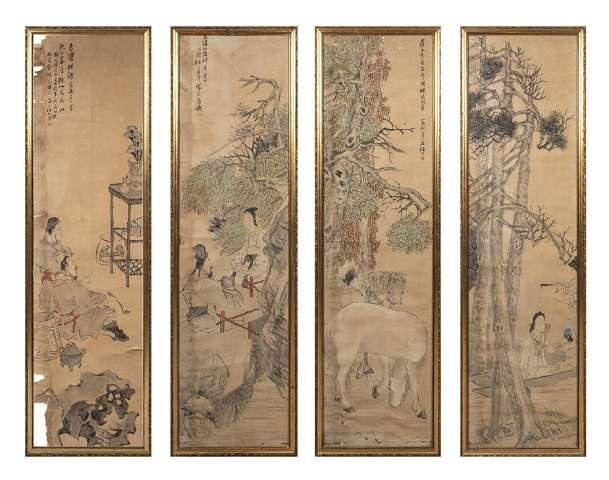
155
FOUR INK AND COLOUR PAINTINGS ON PAPER, China, Qing
dynasty,
19th century
h cm 140 x l cm 40
They depict: two Taoist scholars drinking tea; a tree-lined courtyard with two seated sages exchanging a gift; a lakeside landscape with trees and three figures on a boat; and a wooded landscape with a groom and two horses. All four bear inscriptions.
QUATTRO DIPINTI SU CARTA, Cina, dinastia Qing, XIX secolo
Raffigurano: due studiosi taoisti intenti a bere il tè; un cortile alberato con due saggi seduti che si scambiano un dono; un paesaggio lagunare con alberi e tre figure su un’imbarcazione; un paesaggio alberato con un palafreniere e due cavalli. Tutti e quattro recano iscrizioni.
清 中国传统人物画四屏 任伯年(1840-1896)
156 € 1.500 / 2.000

A CALLIGRAPHIC COUPLET, China, 20th century
h tot. cm 200 x l tot. cm 43
€ 500 / 800
With an evocative inscription and a red seal.
SCROLL CON CALLIGRAFIA SU CARTA, Cina, XX secolo
Con frase evocativa e sigillo rosso.
157
A CALLIGRAPHIC COUPLET, China, Qing dynasty (1644-1911)
h cm 117 x l cm 34
Signed, with one seal of the artist.
SCROLL CON CALLIGRAFIA SU CARTA, Cina, dinastia Qing (1644-1911)
Firmato con sigillo dell’artista.
清 草书书法立轴
TWO CALLIGRAPHIC COUPLET ON PAPER, China, 20th century
h cm 67 x l cm 43; h cm 100 x l cm 50
158 € 200 / 300 € 400 / 600
PIATTO IN PORCELLANA STILE DING, Cina, XXI secolo
20世纪 中国书法立轴一组 中华人民共和国国务院侨务办公室敬赠 一九八七年六月四日
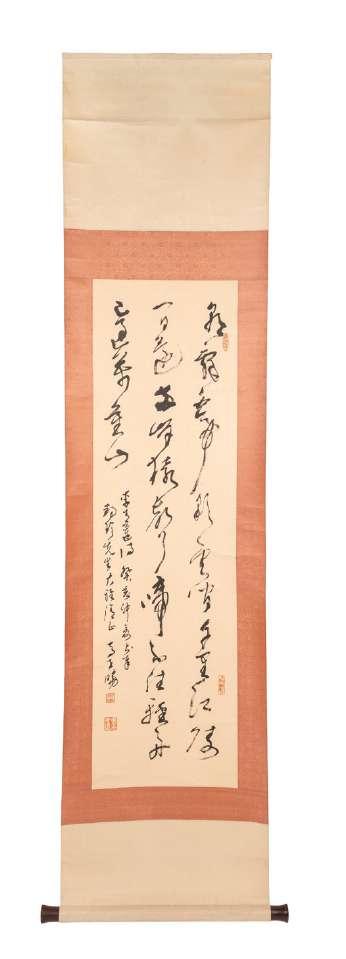
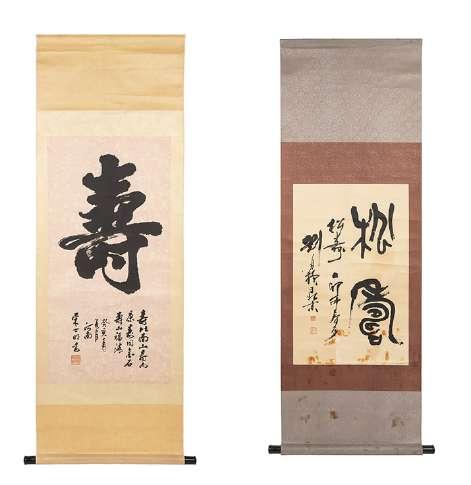


159
AN HANGING SCROLL ON SILK BY WEI TAI, China, 20th century
h cm 83 x l cm 62
Depicting four elegantly dressed figures, with an inscription.
DIPINTO A SCROLL SU SETA DI WEI TAI, Cina, XX secolo
Raffigurante quattro dame elegantemente vestite, con iscrizione.
20世纪近现代仕女题材写意画 (韦太画于上海)
INK ON PAPER PAINTING, China, Qing dynasty (1644-1911)
h cm 45 x l cm 33,5
160 € 200 / 300 € 300 / 400
Depicting a bamboo tree, with an inscription.
DIPINTO AD INCHIOSTRO SU CARTA, Cina, dinastia Qing (1644-1911)
Raffigurante albero di bambù e il profilo di un cervo, con iscrizione.
清 中国传统墨竹图 右侧题有诗文“最爱月明花静 夜,扶疏影透一窗凉”,并配有多方印章
161
A PAINTED SCROLL ON SILK, China, Qing dynasty, 19th century
h cm 179 x l cm 38
€ 400 / 600
Well-painted, it depicts a mountainous landscape with pagodas and trees, featuring Shoulao depicted atop a deer, accompanied by two children holding a large peach, a symbol of immortality; poetic inscription at the upper right.
DIPINTO A SCROLL SU SETA, Cina, dinastia Qing, XIX secolo
Ben dipinto, raffigura un paesaggio montuoso con pagode e alberi, nel quale Shoulao è ritratto sopra un cervo ed accompagnato da due fanciulli che reggono una grande pesca, simbolo di immortalità; iscrizione poetica in alto a destra.
清 绢本设色《露壺介壽》图立轴
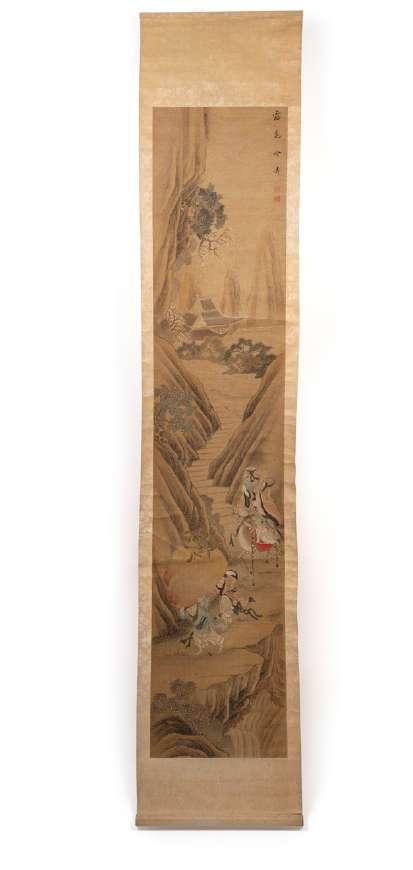
162
A SCROLL PAINTING ON SILK, China, Qing dynasty, 19th century
h cm 156 x l cm 40
€ 300 / 500
Depicting a vast mountainous landscape animated by pagodas, trees, and two figures in meditation, with a poetic inscription at the top.
DIPINTO A SCROLL SU SETA, Cina, dinastia Qing, XIX secolo
Raffigurante un ampio paesaggio montuoso, animato da pagode, alberi e due figure in meditazione; con iscrizione poetica in alto.
清 钱杜的山水诗文画 题款:“署仿五峰山人大意 钱杜”


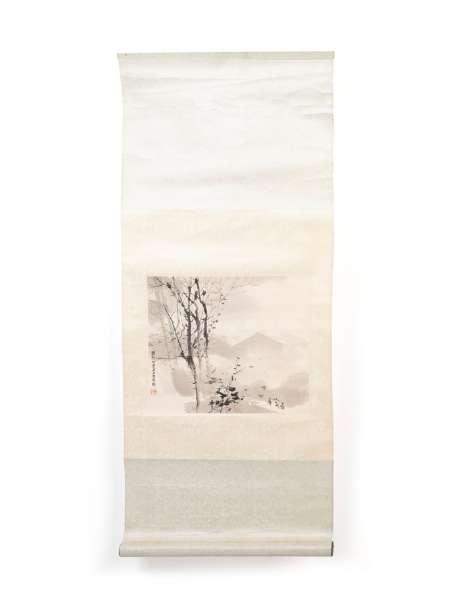
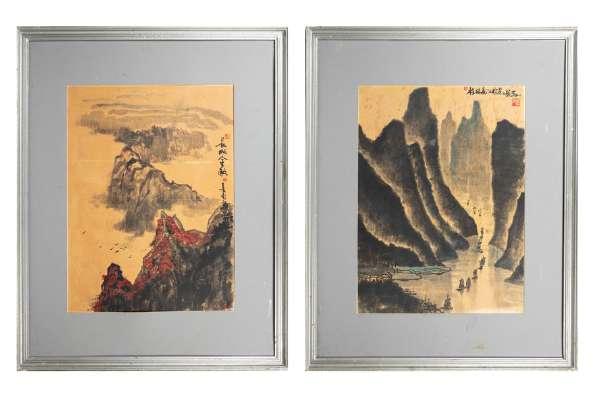
TWO SCROLL PAINTING ON SILK, China, Qing dynasty (1644-1911)
h cm 137 x l cm 45,5
€ 200 / 300
The upper section features poetic inscriptions, while the central area is divided into four rectangular panels depicting instructional scenes with a sage and his disciples set within a naturalistic landscape.
DUE DIPINTI A SCROLL SU SETA, Cina, dinastia Qing (1644-1911)
Nella sezione superiore presentano iscrizioni poetiche, mentre la parte centrale è suddivisa in quattro riserve rettangolari raffiguranti scene didattiche con un saggio e i suoi discepoli immersi in un paesaggio naturalistico.
清 集锦式人物故事图立轴
A PAINTED SCROLL ON PAPER, China, 20th century
h cm 27,5 x l cm 33
€ 100 / 200
Depicting a naturalistic landscape with mountains and trees, animated by a small figure carrying two buckets of water, the work bears an inscription and the artist’s seal.
DIPINTO A SCROLL SU CARTA, Cina, XX secolo
Raffigurante un paesaggio naturalistico con montagne e alberi, animato da una piccola figura che porta due secchi d’acqua. Reca un’iscrizione e il sigillo dell’artista.
20世纪 传统山水画 背面的签条上写有“云林 归晚 傅抱石作”的字样
TWO PAINTING ON PAPER, China, 20th century
h cm 68 x l cm 50
€ 300 / 400
Depicting a mountainous landscape with the Great Wall of China and a riverine scene among mountains with boats, the two pieces bear inscriptions and the artist’s seal.
DUE DIPINTI SU CARTA, Cina, XX secolo
Raffiguranti un paesaggio montuoso con la Grande Muraglia cinese e un paesaggio fluviale tra montagne solcate da imbarcazioni. Recano iscrizioni e sigillo dell’artista.
20世纪 传统山水画两幅
☼AN IVORY SCULPTURE, China, Qing dynasty, 19th century
h cm 53 x l cm 12
€ 600 / 800
Entirely carved and finely worked, the figure depicts Guanyin with a serene expression, adorned with an elegant crown securing an elaborate coiffure. She is dressed in gracefully detailed robes and holds in her hands a pair of flowers and a pearl necklace. With a carved wooden base.
N. Cites: IT/CE/2025/MI/00203
☼SCULTURA IN AVORIO, Cina, dinastia Qing, XIX secolo
Interamente scolpita e lavorata, raffigura una Guanyin dal volto sereno, adornata da una raffinata corona che trattiene un’elaborata acconciatura. Indossa eleganti vesti finemente incise e regge tra le mani una coppia di fiori e una collana di perle. Con base in legno.
N. Cites: IT/CE/2025/MI/00203
清19世纪 牙雕人物摆件
167
A PAIR OF SILVER FLOWER HOLDERS, China, early 20th century
h cm 19,2
€ 200 / 300
Chased, featuring a three-clawed dragon chasing the pearl among stylized clouds. Silversmith Wang Hing & Co. Weight g 479.
COPPIA DI PORTAFIORI IN ARGENTO, Cina, inizio XX secolo
Cesellati con drago a tre artigli che insegue la perla tra nuvole stilizzate. Argentiere Wang Hing & Co. Peso g 479.
民国 龙纹银花插一对 WH 90 卓 总重479g
168
A SILVER TRAY, China, 19th / 20th century
l cm 48 x w cm 27
€ 800 / 1.200
Cast and shaped, with two handles in the form of bamboo; the rim is finely embossed with scenes of children playing in a wooded landscape with pagodas, while the center is engraved with a treefilled courtyard animated by sages and immortals. Weight: g 1240.
VASSO OVALE IN ARGENTO, Cina, XIX / XX secolo
Fuso e modellato, con due manici a forma di bambù; il bordo è finemente sbalzato con scene di bambini che giocano in un paesaggio alberato con pagode, mentre al centro è inciso un cortile alberato animato da saggi e immortali. Peso: g 1240.
晚清民国 外销银托盘 款:怡安 重1240g

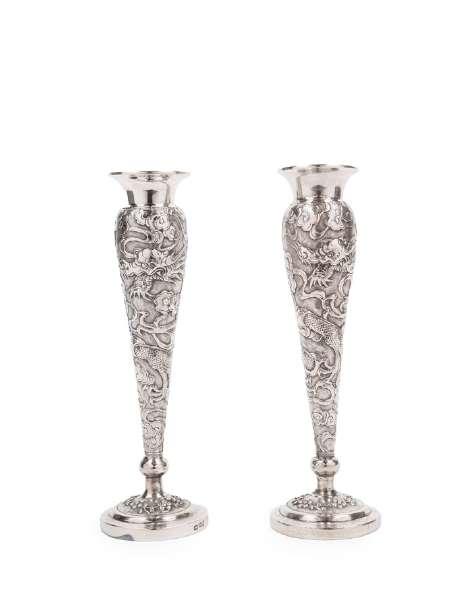
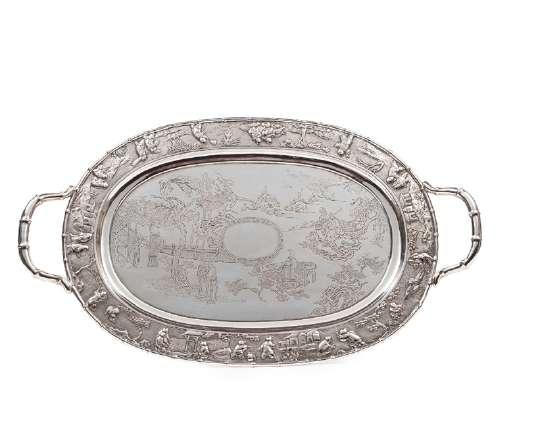
169
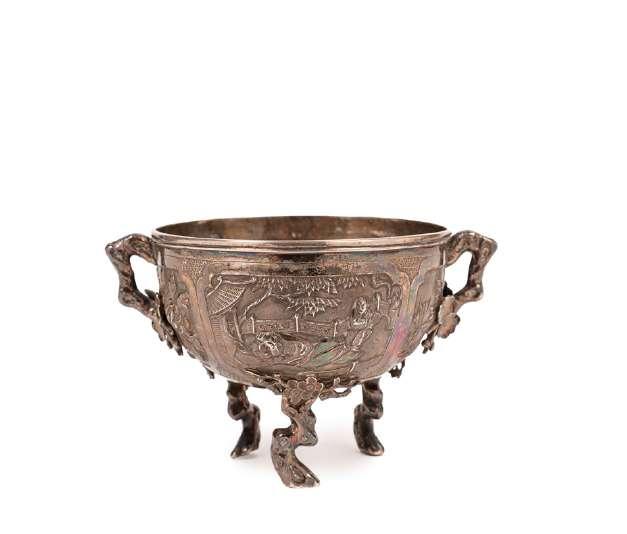
A SILVER TRIPOD CENSER, China, early 20th century
h cm 9 x l cm 15,4
€ 200 / 300
It stands on three tendril-shaped feet terminating in floral motifs. Repoussé and chased, it is decorated with lobed panels depicting dragons amid clouds in pursuit of the flaming pearl, together with foliate and floral designs and a garden scene with a reclining sage and his attendant. The base bears the silversmith’s mark WF. Weight 211 g.
INCENSIERE TRIPODE IN ARGENTO, Cina, inizio XX secolo
A forma di coppa biansata, si erge su tre piedi a forma di viticcio con motivi floreali. Sbalzato e cesellato, presenta riserve polilobate raffiguranti draghi tra le nuvole mentre inseguono la perla fiammeggiante, decori fogliacei e floreali e una scena di giardino con un saggio disteso e il suo accolito. Alla base reca il marchio dell’argentiere WF. Peso g 211.

民国 银香炉 萬昌 90 WF 重 211g
170
A SILVER CIGARETTE CASE, China, 20th century
l cm 7,8 x p cm 10
€ 200 / 300
Rectangular in shape, depicting a General. Weight 138 g.
PORTASIGARETTE IN ARGENTO, Cina, XX secolo
Di forma rettangolare, raffigurante un generale. Peso g 138.
民国 军阀戎装像银盒 重138g
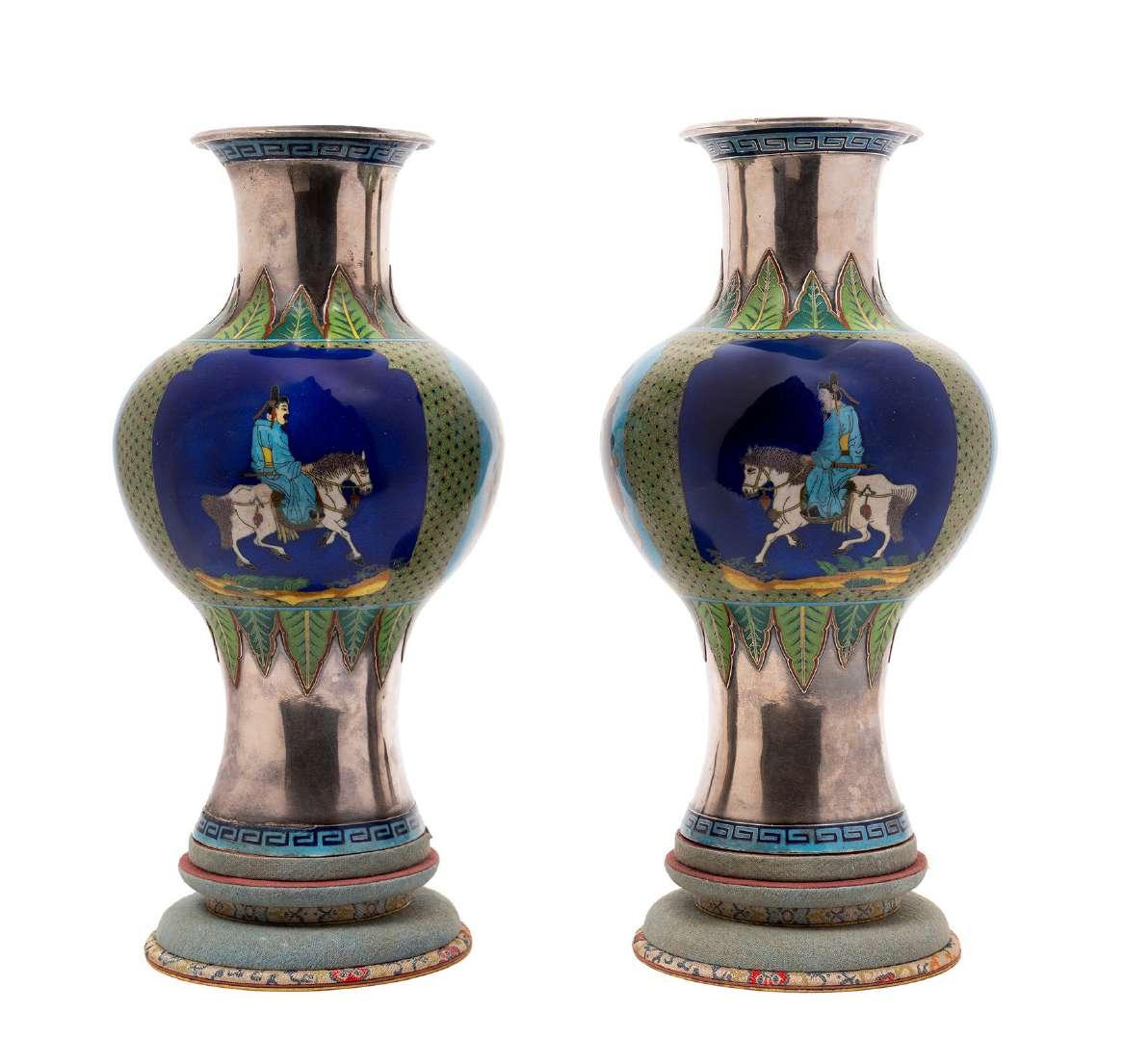


A PAIR OF SILVER AND CLOISONNÉ ENAMEL BOTTLE-SHAPED VASES, China, 19th / 20 century
h cm 25,5
171 € 2.000 / 3.000
With a slightly flared foot and a long neck, the body is finely enamelled on a green floral ground issuing stylized acanthus leaves, and interspersed with polylobed panels in shades of blue depicting ladies and dignitaries on horseback. The neck and base are adorned with Greek key borders in enamel. Stamped to the base and set on fabric-covered stands.
Total weight: 1274 g.
RARA COPPIA DI VASI IN ARGENTO E SMALTO CLOISONNÉ, Cina, XIX / XX secolo
Di forma a bottiglia, con base e collo allungato, il corpo è finemente smaltato su fondo verde decorato a motivi floreali, da cui si dipartono foglie d’acanto stilizzate. La superficie è intervallata da riserve polilobate in blu e azzurro, raffiguranti dame e dignitari a cavallo. Alla base e al collo si trovano fregi a motivo greco eseguiti a smalto. Punzonati alla base e completi di basi rivestite in stoffa. Peso totale: g 1274.
晚清民国
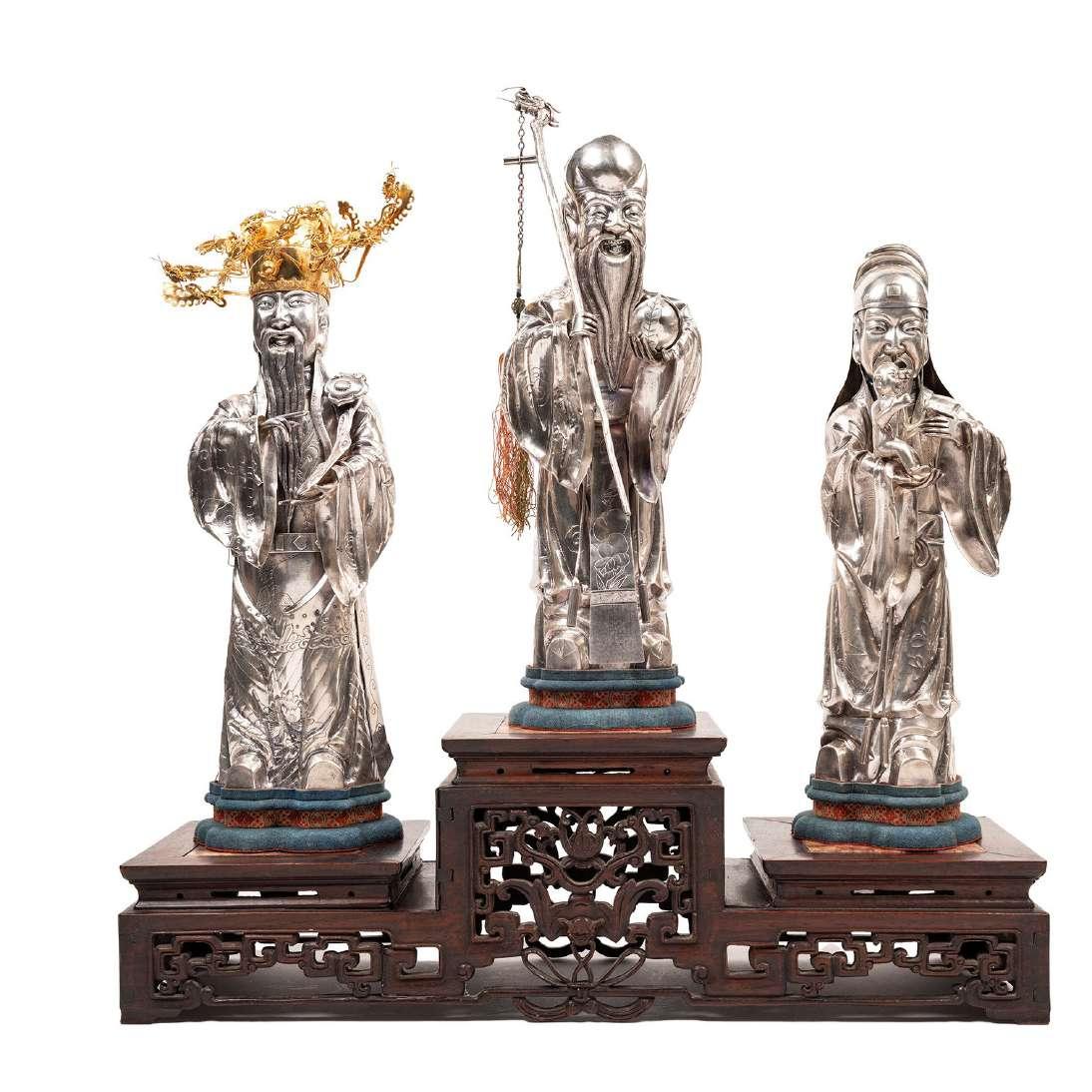


THREE SILVER FIGURES, China, 20th century
The larger h cm 33
Depicting the San Xing (Three Stars), deities from Chinese mythology, dressed with finely engraved and chiseled robes, standing on a wooden base in their traditional positions. Weight 1.480 g
TRE SCULTURE IN ARGENTO, Cina, XX secolo
Raffiguranti i San Xing (tre astri), divinità della mitologia cinese, abbigliate con delle vesti finemente incise e cesellati e stanti su uno stand in legno nelle loro posizioni tradizionali. Peso 1.480 g
172 € 3.000 / 5.000 晚清民国
173
A PAIR OF SILVER STELES,

China, late 19th century / early 20th century
h cm 19,8
€ 1.500 / 2.000
Finely chased in the form of bixì (dragon turtles) supporting the body of the stele, decorated with Chinese characters within incised rectangular panels. The steles are surmounted by a rectangular section with seals, chased with intertwined dragons chasing the pearl among stylized waves. Total weight 2.029 g.
COPPIA DI STELI IN ARGENTO, Cina, fine XIX secolo / inizio XX secolo
Sbalzate a forma di bixì che sostengono il corpo della stele, decorato con caratteri cinesi entro riserve rettangolari incise. Le steli sono sormontate da una sezione rettangolare con sigilli, sbalzata con draghi intrecciati che inseguono la perla tra onde stilizzate. Peso totale g 2.029.
晚清民国 赑屃驮碑银摆件(一对)寶華 款 重2029g
174
A SILVER INGOT, China, Qing dynasty (1644-1911)
h cm 7 x l cm 11
€ 1.000 / 1.500
Boat-shaped, with inscriptions. Weight 1.855 g
LINGOTTO IN ARGENTO, Cina, dinastia Qing (1644-1911)
A forma di barca, con iscrizioni. Peso 1.855 g
清 同治十三年银锭 重1855g
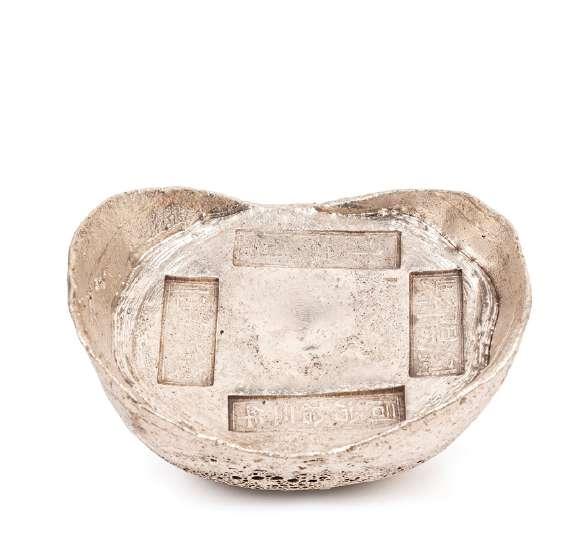
A LARGE SILVER MODEL OF A TEMPLE WITH PAGODAS, China, 20th century
h cm 52 x l cm 37,5 x p cm 43
175 € 2.000 / 3.000
Realistically modelled as a large Chinese temple set within a courtyard enclosed by finely repoussé floral fences, featuring four cast and shaped trees, three devotional pagodas with bells and a praying figure, and a large nine-tiered pagoda. Gross weight: 7325 g
GRANDE MODELLO IN ARGENTO DI TEMPIO CON PAGODE, Cina, XX secolo
Realisticamente modellata come un grande tempio cinese situato all’interno di un cortile, delimitato da recinzioni finemente sbalzate con decori floreali, con quattro alberi fusi e sagomati. Presenta tre pagode devozionali con campane e figura orante, e una grande pagoda a nove piani. Peso lordo 7325g
晚清民国 六榕寺银摆件 二十世纪 总重: 7325g
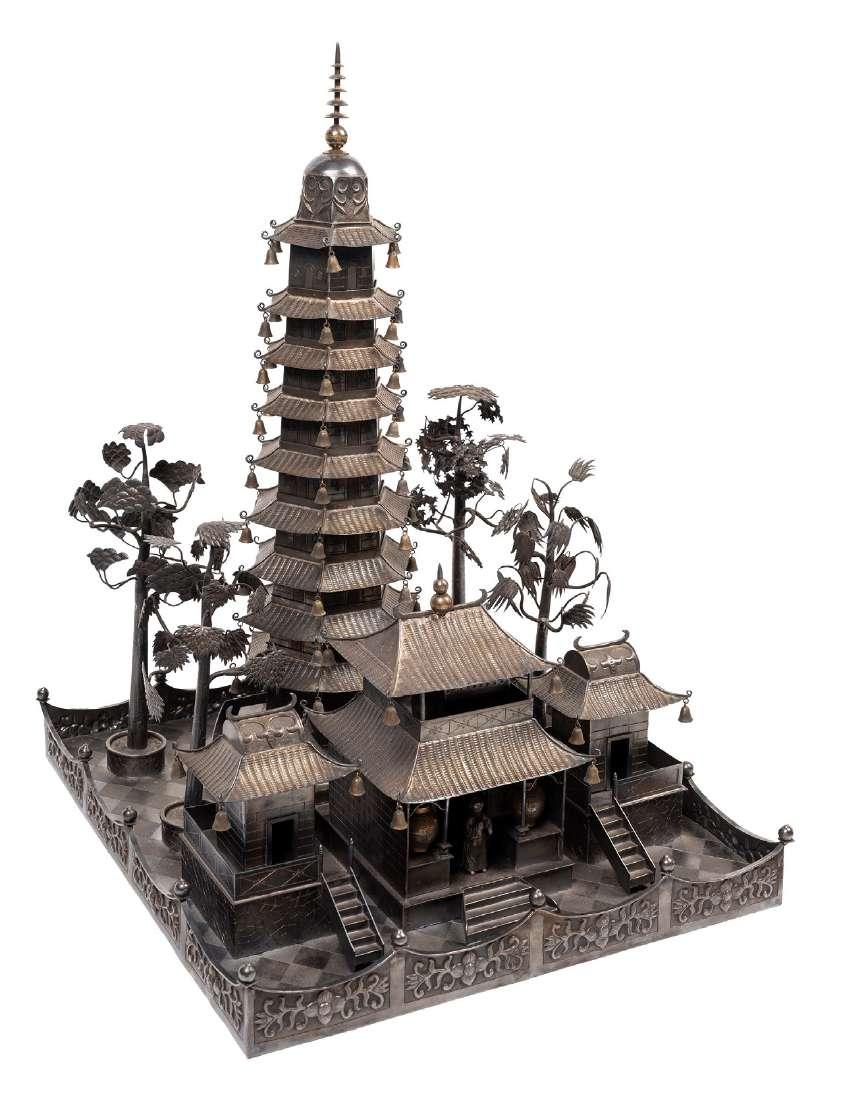
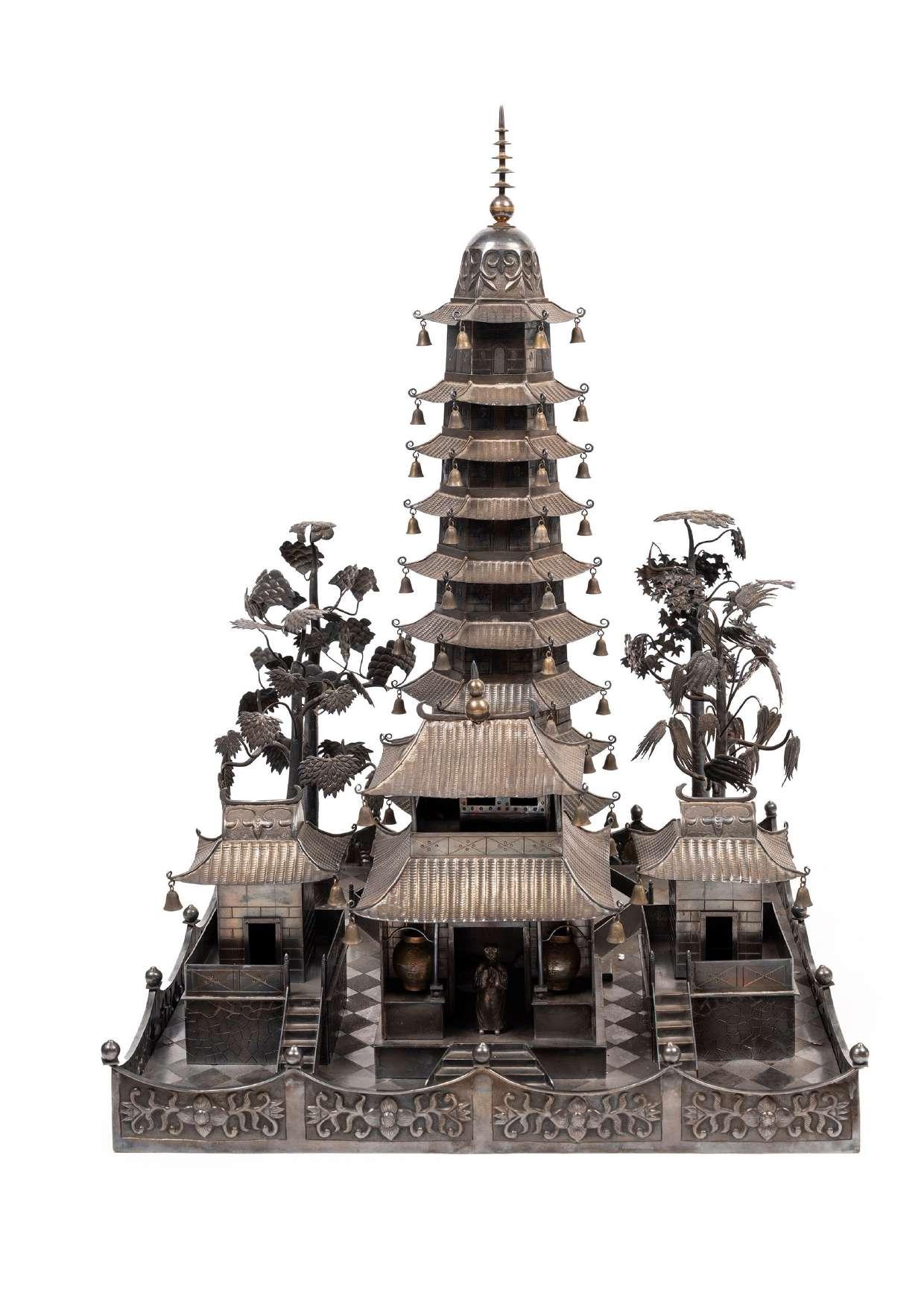
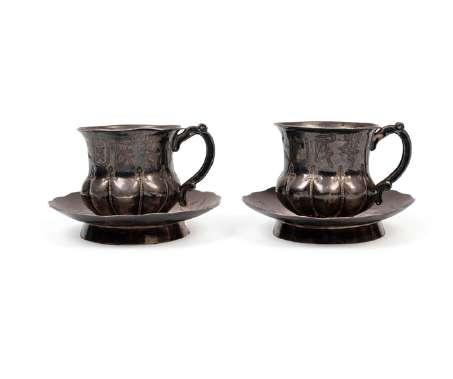

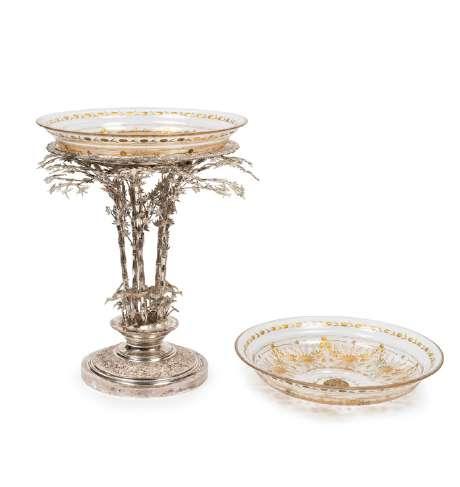
176
A
PAIR OF SILVER CUPS WITH SAUCERS, China, early 20th century
h cm 5,5 x d cm 10,1
€ 300 / 500
Fused, shaped, and baccellated; both the cups and saucers are engraved with floral motifs, birds, and Chinese characters. The base bears a hallmark. Weight: 262 g.
COPPIA DI TAZZINE
CON PIATTINO IN ARGENTO, Cina, inizio XX secolo
Fuse, sagomate e baccellate; sia le tazzine che i piattini sono inciso con decori floreali, uccellini e caratteri cinesi. Alla base reca punzone. Peso g. 262.
晚清民国 银杯碟一对 重262g
177
TWO SILVER LINGOTS, China, Qing dynasty (1644-1911)
l max cm 4,5
€ 500 / 800
Engraved with inscriptions.
DUE LINGOTTI IN ARGENTO, Cina, dinastia Qing (1644-1911)
Incisi con iscrizioni. Peso g 209.
178
A SILVER CENTERPIECE, China, late 19th / early 20th century
h cm 31 x d max cm 24
€ 3.500 / 4.000
Cast and shaped, it rests on a circular base repoussé with foliate motifs, from which rises a finely chased structure in the form of a bamboo grove inhabited by herons. The interlaced leaves support a shaped underplate. The lot also includes two glass dishes decorated with gilt foliate motifs. Weight g 1,405.
CENTROTAVOLA IN ARGENTO, Cina, fine XIX secolo / inizio XX secolo
Fuso e sagomato, poggia su una base circolare sbalzata a motivi fogliacei, dalla quale si innalza una raffinata struttura finemente cesellata a imitazione di un bosco di bambù popolato da aironi. Le foglie intrecciate sorreggono un sottopiatto sagomato. Il lotto comprende inoltre due piatti in vetro decorati con motivi fogliacei in oro. Peso g 1,405.
清光绪 两枚银锭 晚清民国 外销银桌心盘 KSL 瑞典 银重1405g
179
A JADE SILVER AND HARDSTONE BOX, China, 20th century
h cm 6 x l cm 8
€ 500 / 600
Of circular form, adorned with enameling and hardstones, and centered by a green jade ring engraved with qilong. Total weight: 339 g.
SCATOLA IN ARGENTO, GIADA E PIETRE DURE, Cina, XX secolo
Di forma circolare, è abbellita con smaltature e pietre dure ed è centrata da un anello in giada verde incisa con qilong. Peso tot g 339.
20世纪 银胎掐丝珐琅嵌玉石盖罐 重339g

180
A SILVER, JADE AND ENAMEL BOX, China, 20th century
h cm 13
€ 600 / 800
Pagoda-shaped, finely chased, with a cylindrical body decorated with doors separated by enameled columns; the base and entablature are adorned with enameled clouds and framed by two jade rings. The lid is enhanced with a fan-shaped motif set with hardstones. Total weight: 410 g.
SCATOLA IN ARGENTO, GIADA E SMALTI, Cina, XX secolo
Di forma pagoda, finemente cesellata, presenta un corpo cilindrico decorato con porte separate da colonne smaltate; la base e la trabeazione sono ornate da nuvole smaltate e delimitate da due anelli in giada. Il coperchio è arricchito da un motivo a ventaglio impreziosito da pietre dure. Peso totale: 410 g.
20世纪 银胎掐丝珐琅嵌玉石盖罐 重410g


181
A SILVER AND JADEITE BOX, China, early 20th century
h cm 4 x l cm 9 x p cm 6,5
€ 200 / 300
Of rectangular form, finely chased on the sides with bamboo and peach blossom motifs; the lid is richly embossed with foliate, floral, and bat decorations, and is centered by a small jadeite carving depicting leaves. Weight g 178.
SCATOLA IN ARGENTO E GIADEITE, Cina, inizio XX secolo
Di forma rettangolare, presenta sottili cesellature sui lati con motivi di bamboo e fiori di pesco; il coperchio è riccamente sbalzato con decori fogliacei, floreali e pipistrelli, ed è impreziosito al centro da un piccolo intaglio in giadeite raffigurante foglie. Peso g 178.
20世纪 镶翠银盒子 重178g

182
A JADE AND SILVER BOX, China, 20th century
h cm 6 x l cm 8
€ 800 / 1.200
Decorated with enamel and semi-precious stones, and featuring a jade ring engraved with archaistic motifs. Total weight g 249.
SCATOLA IN ARGENTO GIADA E PIETRE DURE, Cina, XX secolo
Abbellita con smaltature e pietre dure e un anello in giada inciso con motivi arcaisici. Peso totale g 249.
二十世纪 银制烧蓝百宝嵌玉环首饰盒 重 249g
TWO PORCELAIN IMARI SUGAR BOWLS, China, Qing dynasty, Yongzheng period (1723-1735)
h cm 10,5 x l cm 17,5
€ 300 / 500
Decorated in underglaze blue and overglaze red and gilt, depicting to the body and cover naturalistic landscapes with flowers, trees and rocks, while the handles are shaped like sea monsters.
DUE ZUCCHERIERE IN PORCELLANA IMARI, Cina, dinastia Qing, periodo Yongzheng (1723-1735)
Di forma polilobata, presenta il bordo decorato con motivi floreali ed è centrata da una riserva raffigurante i Tre Astri, Lu Xing, Shoulao e Fu Xing, intenti a conversare in un cortile alberato. Il retro è decorato con pesche e pipistrelli e reca marchio apocrifo impresso in rosso dell’Imperatore Tongzhi.
清雍正 带盖瓷杯子一对
184
A CELADON CARVED MOLDED BOWL, China, Ming Dynasty (1368-1644)
d. 16.5 cm
€ 150 / 200
Carved and modelled with stylised waves and petals.
COPPA CELADON IN PORCELLANA, Cina, dinastia Ming (1368-1644)
Intagliata e modellata con onde e petali stilizzati.
明 青瓷碗
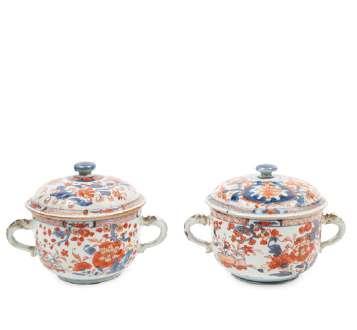
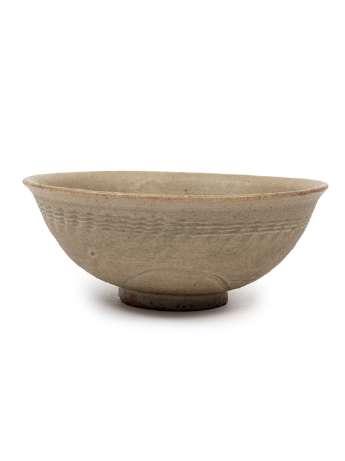

185
A PORCELAIN CUP AND TWO BOWLS WITH SAUCERS, China, Qing dynasty, 18th century
The larger h cm 7,2
€ 200 / 300
The coffee cup and saucer, decorated in famille rose enamels with a European subject, depict a young woman seated before a dressing table, inspired by a famous engraving by Bernard Picart (1673–1733). The other two show ladies and boys.
TRE TAZZINE CON PIATTINO IN PORCELLANA, Cina, dinastia Qing, XVIII secolo
La tazzina da caffè con piattino decorata nei toni della famiglia rosa con soggetto europeo, raffigura una giovane donna seduta davanti a un tavolo da trucco, ispirata a una celebre incisione di Bernard Picart (1673–1733). Le altre due con dame e ragazzi.
清18世纪 三套瓷杯和碟子
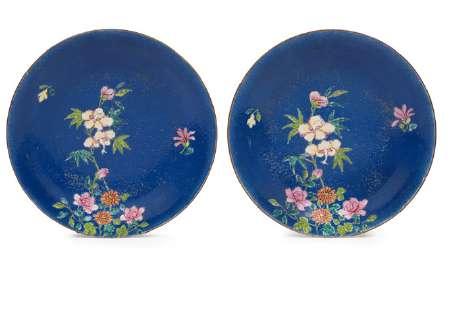


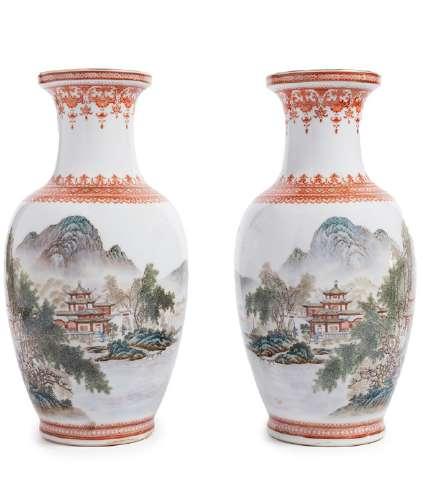


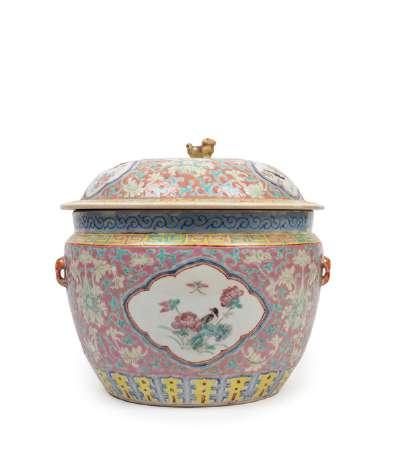
A PAIR OF FAMILLE ROSE PLATES, China, Qing dynasty (1644-1911)
€ 400 / 600
They are decorated with floral motifs on a blue ground, the base bearing a six characters seal mark in underglaze blue of the Qianlong Emperor.
COPPIA DI PIATTI IN PORCELLANA FAMIGLIA ROSA, Cina, dinastia Qing (1644-1911)
Sono decorati con motivi floreali su un fondo blu, alla base recano marchio sigillare a sei caratteri in blu sottocoperta dell’Imperatore Qianlong.
187
A
PAIR OF FAMILLE ROSE PORCELAIN VASES, China, People’s Republic of China (1949- present)
€ 600 / 800
Decorated in a continuous scene of a lake landscape with pagodas, boats, and mountains; with a poetic inscription. At the base, they bear a four-character apocryphal Qianlong mark in iron-red with gilding.
COPPIA DI VASI IN PORCELLANA FAMIGLIA ROSA, Cina, Repubblica Popolare Cinese (1949 - presente)
Decorati con un paesaggio lagunare con pagode, imbarcazioni e montagne; con iscrizione poetica. Alla base recano un marchio apocrifo a quattro caratteri dell’Imperatore Qianlong in rosso di ferro con doratura.
中华人民共和国 粉彩诗文通景山水人物瓶(一对)
188
A FAMILLE ROSE TUREEN, China, Qing dynasty, late 19th century
d cm 26 h cm 35,5 h cm 24
€ 300 / 500
The body and lid are enamelled with floral motifs on a pink ground, interspersed with polylobed panels featuring flowers and birds; the lid handle is modeled in the form of a Pho dog.
Provenance: Private collection, Tuscany.
CIOTOLA CON COPERCHIO IN PORCELLANA FAMIGLIA ROSA, Cina, dinastia Qing, fine XIX secolo
Il corpo e il coperchio sono decorati con motivi floreali e pipistrelli su fondo rosa, intervallati da riserve polilobate con fiori e uccellini; la presa del coperchio è modellata a forma di cane di Pho.
Provenienza: collezione privata, Toscana.
清 粉彩开光盖罐
189
A BLUE AND WHITE PORCELAIN BOWL,
China, Qing dynasty (1644-1911)
d cm 29,5
€ 150 / 250
Painted on the interior with flowers, leaves, and honeycomb motifs.
Provenance: Private collection, Tuscany.
CIOTOLA
IN PORCELLANA
BIANCA
E BLU, Cina, dinastia Qing (1644-1911)
Dipinta all’interno con fiori e foglie e motivi a nido d’ape.
Provenienza: collezione privata, Toscana.
清 青花碗
190
A BLUE AND WHITE PORCELAIN DISH, China,
h cm 34
Qing dynasty, 19th century
€ 250 / 350
Finely decorated with boys and a man in procession; the interior rim features Buddhist symbols and flowers, while the exterior rim is adorned with stylized bamboo branches.
Provenance: Private collection, Liguria.
PIATTO IN PORCELLANA BIANCO E BLU, Cina, dinastia Qing, XIX secolo
Ben decorato con ragazzi e un uomo in processione, il bordo esterno presenta simboli buddisti e fiori; il bordo esterno presenta rami di bambù stilizzati.
Provenienza: collezione privata, Liguria.
清 青花盘
191
A PORCELAIN TRAY AND A DISH,
China, Qing dynasty, 18th century
The larger l cm 35
€ 150 / 200
The plate is decorated on the rim and in the center in famille rose enamels with floral and peach motifs. The octagonal tray, in famille rose enamels and underglaze blue, has a border adorned with flowers and a central lakeside scene depicting a man in a courtyard awaiting the arrival of a woman on a boat.
UN PIATTO E UN VASSOIO IN PORCELLANA, Cina, dinastia Qing, XVIII secolo
Il piatto è decorato sul bordo e al centro nei toni della famiglia rosa con motivi floreali e pesche. Il vassio, di forma ottagonale in smalti famiglia rosa e blu sotto coperta, presenta il bordo ornato da fiori e al centro una scena lagunare raffigurante un uomo in un cortile nell’attesa dell’arrivo di una donna su un’imbarcazione.
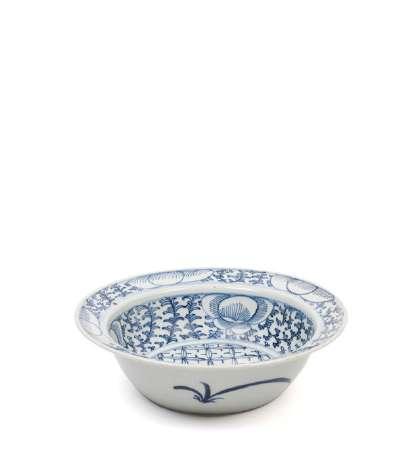

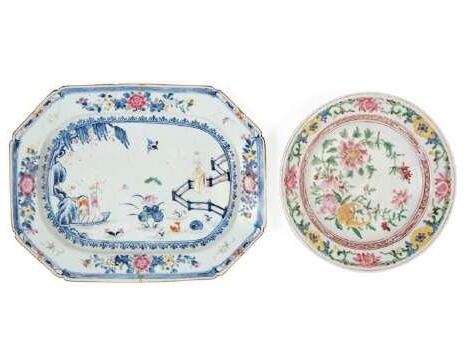
清 两个粉彩瓷盘

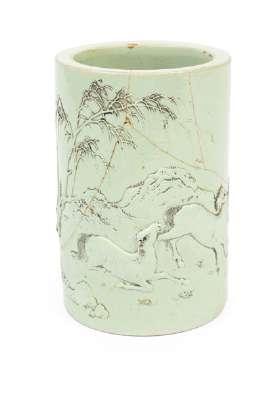

A
FAMILLE ROSE PORCELAIN HIGH-FOOTED BOWL, China, Qing dynasty, Guangxu period (1875-1908)
l cm 28
€ 150 / 200
Of polylobed form, the border is decorated with floral motifs and centered by a reserve depicting the Three Stars, Lu Xing, Shoulao, and Fu Xing, engaged in conversation in a treelined courtyard. The reverse is decorated with peaches and bats and bears the apocryphal impressed red mark of the Emperor Tongzhi.
ALZATINA IN PORCELLANA FAMIGLIA ROSA, Cina, dinastia Qing, periodo Guangxu (1875-1908)
Di forma polilobata, presenta il bordo decorato con motivi floreali ed è centrata da una riserva raffigurante i Tre Astri, Lu Xing, Shoulao e Fu Xing, intenti a conversare in un cortile alberato. Il retro è decorato con pesche e pipistrelli e reca marchio apocrifo impresso in rosso dell’Imperatore Tongzhi.
193
A
LIME-GREEN
PORCELAIN
BRUSHWASHER, China, Qing dynasty, 19th century
h cm 12,5 x d cm 8
€ 300 / 500
Cylindrical in form, it is finely decorated in relief with two horses within a mountainous landscape with trees and rocks. The base bears the Lǐ Yùchéng Zuò (李裕成作) square mark in relief.
PORTAPENNELLI IN PORCELLANA VERDE LIMONE, Cina, dinastia Qing, XIX secolo
Di forma cilindrica, è ben decorato a rilievo con due cavalli in un paesaggio montuoso con alberi e rocce. Alla base reca il marchio marchio quadrato a rilievo Lǐ Yùchéng Zuò (李裕成作).

194
FIVE
FAMILLE ROSE PORCELAIN PLAQUES, China, Republic period (1912-1949)
The larger h cm 21 x l cm 27
€ 500 / 600
Of various shapes and sizes, the pieces depict children at play in a naturalistic landscape, a floral motif inhabited by birds, and vases of archaic form adorned with plants.
CINQUE PLACCHE IN PORCELLANA FAMIGLIA ROSA, Cina, Repubblica di Cina (1912-1949)
Di diverse forme e dimensioni, i raffigurano bambini che giocano in un paesaggio naturalistico, un motivo floreale popolato da uccellini e vasi con forme arcaiche decorati da piante.
A
FAMILLE ROSE PORCELAIN BOX, China, Qing dynasty, 19th century
h cm 16 x l cm 25,5
€ 300 / 500
Peach-shaped, finely decorated with leafy branches and a small relief peach.
SCATOLA IN PORCELLANA FAMIGLIA ROSA, Cina, dinastia Qing, XIX secolo
A forma di pesca, decorata con rami fogliacei e una piccola pesca in rilievo.
清 粉彩桃形大盖盒
196
A
PAIR OF FAMILLE ROSE PORCELAIN VASES, China, 20th century
h cm 23
€ 700 / 1.000
Baluster-column form with stylized qilong-shaped handles. The body is decorated with intricate floral compositions surmounted by a ruyi band, while the neck, on a yellow ground, is adorned with peonies, lotus blossoms, and leafy scrolls. The base bears a red iron-overglaze apocryphal mark of the Qianlong Emperor.
COPPIA DI VASI IN PORCELLANA FAMIGLIA ROSA, Cina, XX secolo
Di forma a colonna di balaustra, con anse stilizzate a forma di qilong, il corpo è decorato con ricche composizioni floreali sovrastate da una fascia di ruyi; il collo, a fondo giallo, presenta motivi di peonie, fiori di loto e ramages fogliacei. Alla base recano marchio apocrifo in rosso ferro sovracoperta dell’Imperatore Qianlong.
20世纪 粉彩花卉纹双耳瓶一对
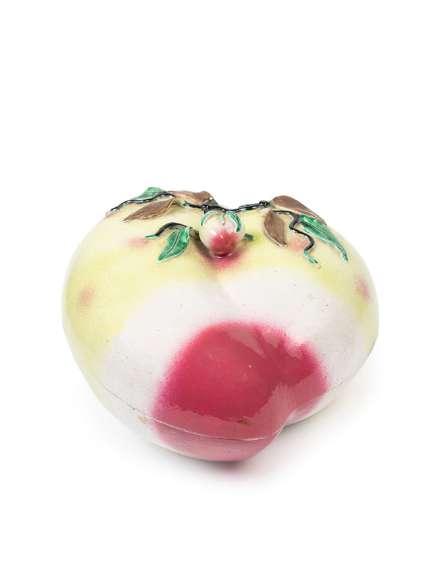
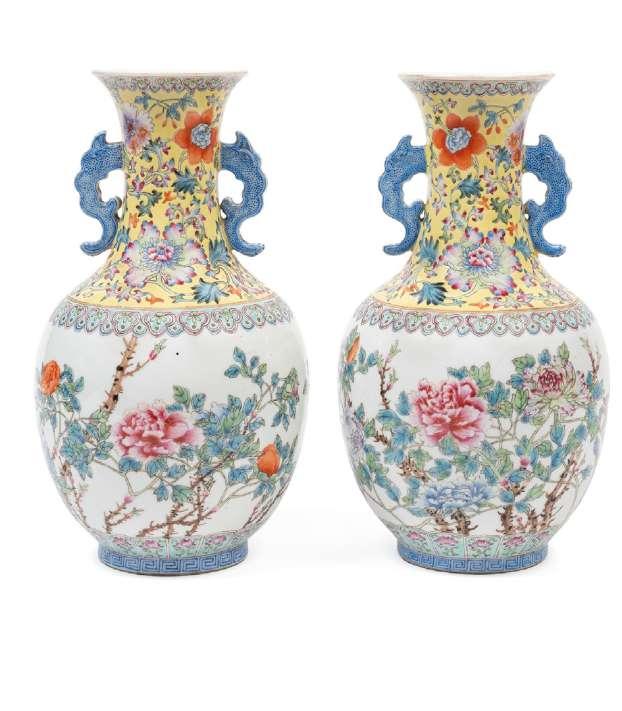

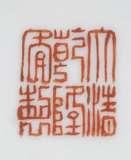

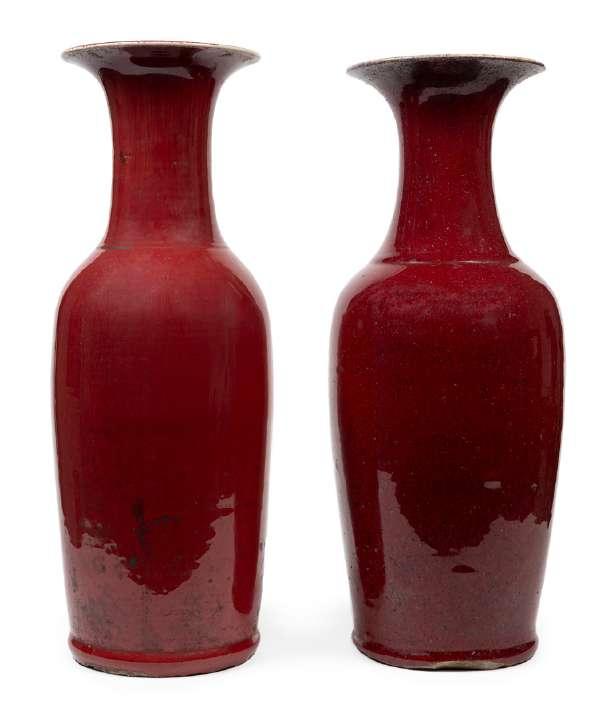
197
A FAMILLE ROSE PORCELAIN CACHEPOT,
China, Qing dynasty, 19th century
h cm 30 x d cm 36,5
€ 200 / 300
Finely painted around the body with lotus flowers, peonies, and leafy scrolls, it features four large rectangular panels decorated with elaborately arranged vases of flowers.
CACHEPOT IN PORCELLANA
FAMIGLIA ROSA, Cina, dinastia Qing, fine XIX secolo
Dipinta sul corpo con fiori di loto, peonie e ramages fogliacei, presenta quattro ampie riserve rettangolari decorate con vasi ricolmi di fiori finemente composti.
清19世纪 粉彩开光花卉大缸
198
TWO LARGE SANG-DE-BOUF PORCELAIN VASES,
China, Qing dynasty, 19th century
The larger h cm 59,5
€ 2.200 / 2.400
Baluster-shaped, they are entirely covered with a beautiful red enamel.
DUE GRANDI VASI
IN PORCELLANA SANGUE DI BUE, Cina, dinastia Qing, XIX secolo
A forma di colonna di balaustra, sono completamente ricoperti da un bello smalto rosso.
清19世纪 红釉观音瓶两件
A JADE BRUSH-WASHER,
China, 20th century
€ 200 / 300
Elongated jade censer, terminating with two spouts, the body carved with naturalistic motifs, accompanied by a wooden stand.
SCIACQUA PENNELLI IN GIADA, Cina, XX secolo
Incensiere in giada di forma allungata, terminante con due beccucci, il corpo intagliato a motivi naturalistici, corredato da base in legno.
20世纪 玉制叶形香具
A PAIR OF SERPENTIN JADE CUPS AND SAUCERS, China, 20th century
€ 1.000 / 1.200
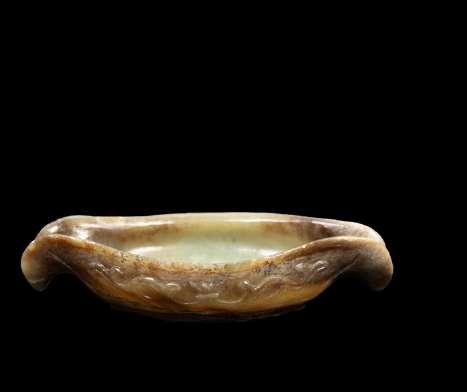
The saucers are square with lobed edges, while the cups have a squared section.
COPPIA DI TAZZINE CON PIATTINO IN GIADA SERPENTINO, Cina, XX secolo
I piattini di forma quadrata con lobature, mentre le tazzine hanno sezione squadrato.
20世纪 玉杯碟一对
€ 500 / 800
Carved in the shape of a chrysanthemum flower.
PIATTO IN GIADA CELADON IN STILE MOGHUL, Cina, XIX / XX secolo
Intagliato a forma di fiore di crisantemo.
清 菊瓣纹玉盘
h cm 5 x l cm 10 d cm 16 h cm 5,5
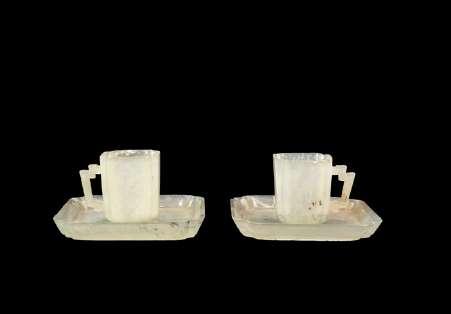
A MOGHUL-STYLE CELADON JADE PLATE, China, 19th / 20th century
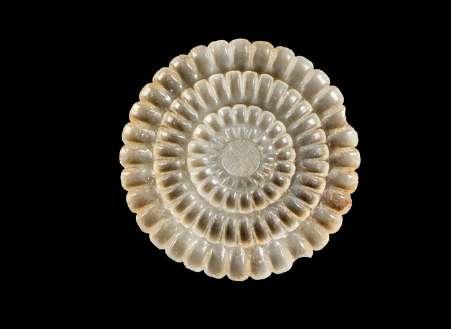
A SMALL CELADON JADE CARVING, China, Qing dynasty, 19th century
€ 100 / 150
In the shape of a small monkey; mounted on a wooden base.
PICCOLO INTAGLIO IN GIADA CELADON, Cina, dinastia Qing, XIX secolo l cm 20
A forma di scimmietta; il supporto in legno.
清 玉雕猴吊坠
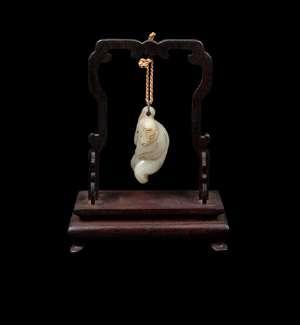
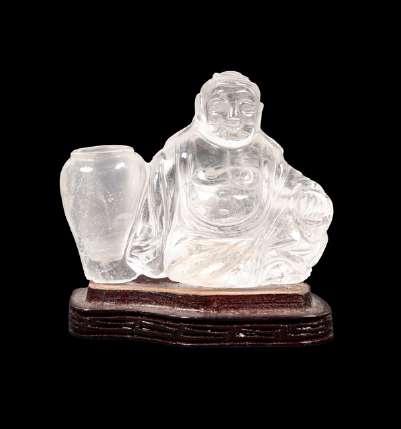


A SMALL ROCK CRYSTAL BUDAI, China, 19th / 20th century
€
/ 300
Seated with a smiling face, holding a large vase. Con base in legno
PICCOLA FIGURA DI BUDAI IN CRISTALLO DI ROCCA, Cina, XIX / XX secolo
Seduto con il viso sorridente mentre regge un grande vaso. Con base in legno.
19/20世纪 水晶弥勒佛摆件
A CRYSTALK ROCK VASE AND COVER, China, 19th / 20th century
€
/ 500
Of elongated form, the vase features mask-shaped handles holding rings. Wooden base.
VASO CON COPERCHIO IN CRISTALLO DI ROCCA, Cina, XIX / XX secolo
Di forma allungata, il vaso presenta anse a mascherone che reggono anelli. Base in legno.
19/20世纪 水晶兽耳盖瓶
A CRYSTAL ROCK TRIPOD CENSER, China, 20th century
h cm 6,2 x l cm 9 h cm 13,4 h cm 15,8
€ 500 / 700
With ring-shaped handles modeled as lions and a lid surmounted by a Shishi. With a carved wooden base.
INCENSIERE TRIPODE IN CRISTALLO DI ROCCA, Cina, XX secolo
Intagliate a forma di uccelli sopra a rocce.
20世纪 水晶狮钮兽耳活环香炉摆件
A TURQUOISE CARVING, China, 20th century
h cm 10,2
€ 100 / 150
Depicting two ladies with fans and flowers.
INTAGLIO IN TURCHESE, Cina, XX secolo
Raffigurante due dame con ventagli e fiori.
20世纪 绿松石仕女摆件
207
AN AMBER SCULPTURE, China, early 20th century
h cm 6,5 x l cm 8
€ 200 / 300
Depicting a merchant. Weight g 150.
SCULTURA IN AMBRA, Cina, inizio XX secolo
Raffigurante mercante. Peso g 150.
20世纪初 蜜蜡雕塑
208
A SMALL CARNELIAN VASE, China, 20th century
h cm 16
€ 250 / 300
Finely carved with raised floral motifs.
PICCOLO VASO IN CORNIOLA, Cina, XX secolo
Finemente intagliato con motivi floreali a rilievo.
20世纪 玛瑙花卉纹花瓶

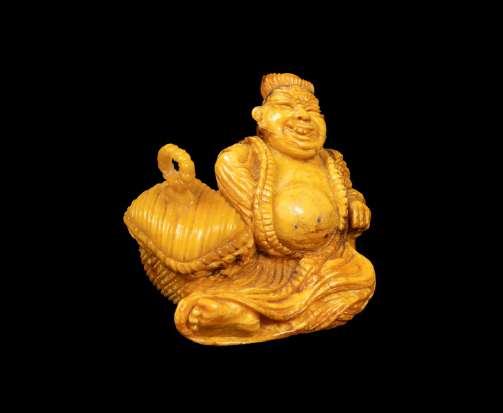
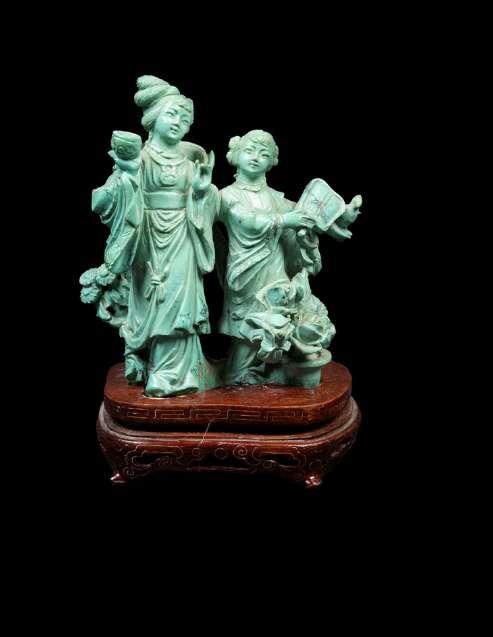

A MALACHITE TRIPOD-CENSER, China, 20th century
h cm 31 x l cm 29
209 € 3.200 / 4.200
Resting on three beast-form legs, the globular body is carved with *taotie* masks, while two lion-form handles at the sides hold loose rings; the pierced cover is surmounted by two lions. Set on a wooden stand.
INCENSIERE TRIPODE IN MALACHITE, Cina, XX secolo
Poggiante su tre piedi a forma di zampa di bestia, il corpo globulare è intagliato con taotie mentre ai lati due anse forma di leone reggono due anelli; il coperchio forato porta due leoni. Poggia su base in legno.
20世纪 孔雀石双狮钮双耳三足炉
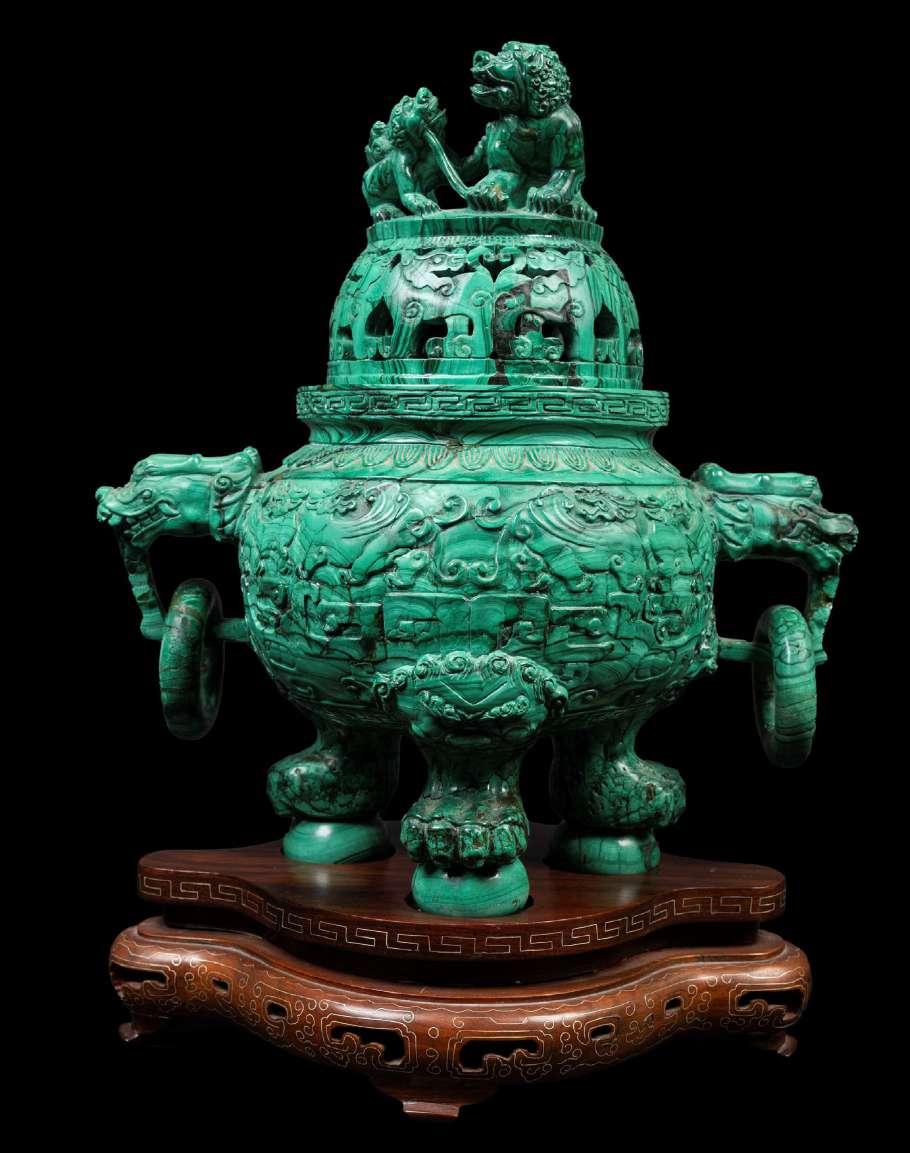
A GREEN JADE BELT HOOK, China, 20th century
l cm 9
€ 500 / 800
Carved in the form of a qilong and surmounted by its young.
FIBBIA IN GIADA VERDE, Cina, XX secolo
Intagliata a forma di qilong e sormontata dal suo cucciolo.
20世纪 玉石龙带钩
TWO HARDSTONE SCULPTURES, China, 20th
century
The larger h cm 19,5
€ 200 / 300
One in lapis lazuli and the other in turquoise, the two sculptures are finely carved, depicting ladies within an intricate floral landscape.
DUE SCULTURE IN PIETRA DURA, Cina, XX secolo
Una in lapislazzuli e l’altra in turchese, le due sculture sono finemente intagliate e raffigurano dame immerse in un intricato paesaggio floreale.
20世纪 两尊传统侍女雕刻摆件
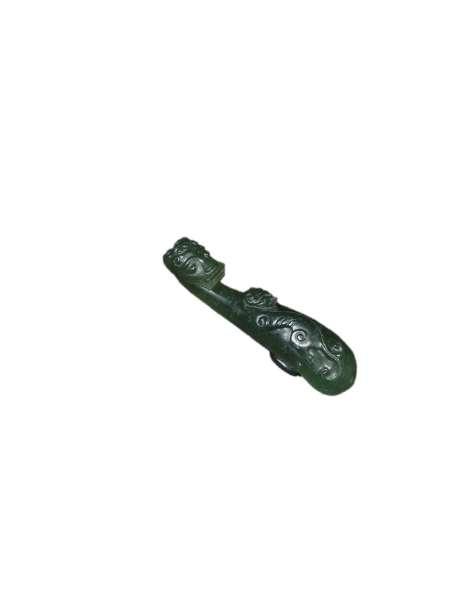
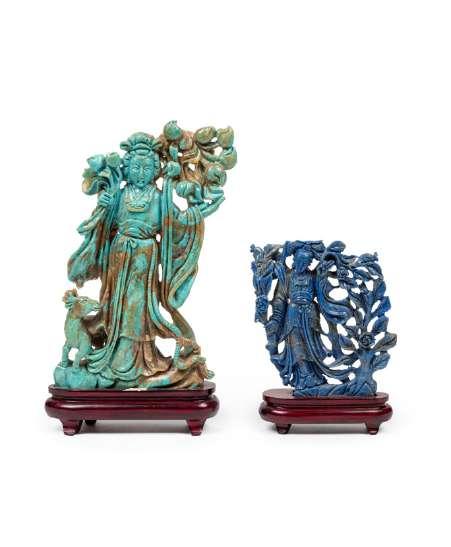
A SILVER AND TURQUOISE NECKLACE,
China, early 20th century
l cm 38
€ 200 / 300
Finely carved with raised floral motifs.
COLLANA IN ARGENTO E TURCHESE, Cina, inizio XX secolo
Finemente intagliato con motivi floreali a rilievo.
20世纪初 银松石项链
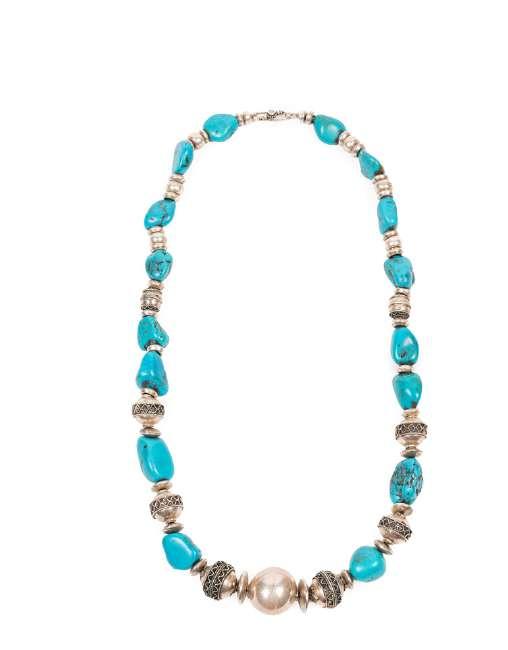
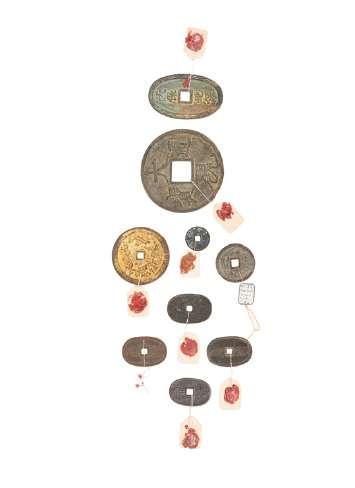
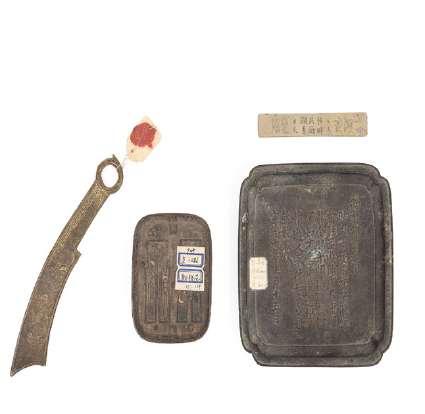
213
NINE
BRONZE COINS, China, Qing dynasty (1644-1912)
d max cm 9
€ 200 / 300
Four circular examples of varying sizes depict inscriptions, Buddhist objects, animal figures, and qilin; five ovoid examples bear inscriptions of auspicious wishes.
NOVE MONETE IN BRONZO, Cina, dinastia Qing (1644-1912)
Quattro esemplari di forma circolare e di dimensioni differenti raffigurano iscrizioni, oggetti buddhisti, figure di animali e qilin; cinque esemplari di forma ovoidale recano iscrizioni di buon auspicio.
清 钱币一组
214
FOUR BRONZE OBJECTS, China, Qing dynasty (1644-1912)
l max cm 17
€ 100 / 200
Two small trays decorated with inscriptions and, on the reverse, a pair of dragons chasing the pearl among four ruyi-shaped clouds; two decorative elements depicting dragons and inscriptions.
QUATTRO OGGETTI IN BRONZO, Cina, dinastia Qing (1644-1912)
Due vassoietti decorati con iscrizioni e sul retro con coppia di draghi che inseguono la perla tra quattro nuvole a forma di ruyi; due elementi decorativi raffiguranti drago e iscrizioni.
清 铜器一组
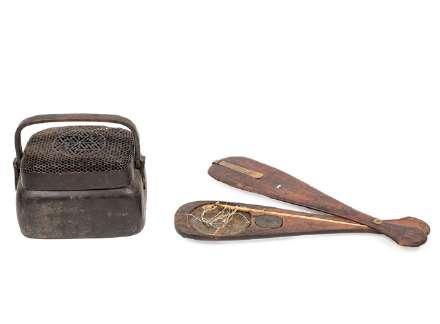
215
A BRASS HAND WARMER AND A WOODEN BALANCE SCALE, China, Qing dynasty (1644-1911)
l cm 16 x h cm 11 x p cm 10 (il braciere)
€ 300 / 500
The hand warmer with a pierced lid centered by a star motif, marked on the base; the balance scale with bronze fittings, complete with an bone pointer and a beam.
BRACIERE IN OTTONE E BILANCIA IN LEGNO, Cina, dinastia Qing, XIX secolo
Il braciere con il coperchio traforato e centrato da motivo a stella, marcato alla base; la bilancia con inserti in bronzo, completa di bastoncino in osso e un bilanciere.
A FAMILLE ROSE PORCELAIN FIGURE,
China, 20th century
h cm 27,5
€ 150 / 200
Depicting an immortal riding a kirin.
SCULTURA IN PORCELLANA FAMIGLIA ROSA, Cina, XX secolo
Raffigurante un immortale su un kirin.
20世纪 粉彩骑麒麟的汉钟离瓷塑
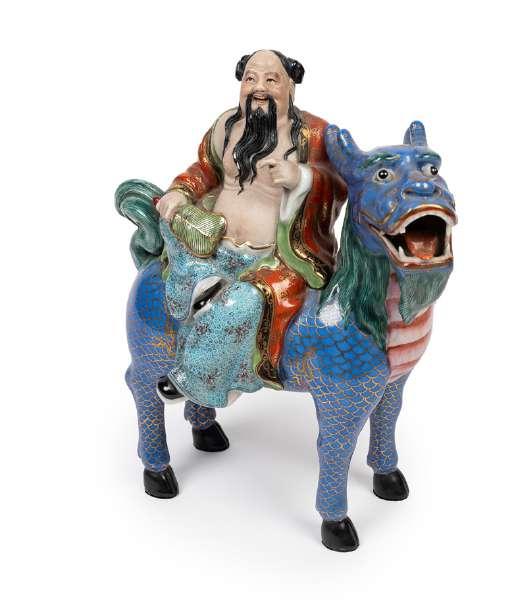
217
A METAL AND KINGFISHER FEATHERS HEADDRESS,
China, Qing dynasty, 19th century
h cm 21 x l cm 18,5
€ 200 / 300
Decorated with dragons among flowers. Glass pearl pendants with pink tassels.
Provenance: Private collection, Liguria.
COPRICAPO IN METALLO E PIUME DI MARTIN PESCATORE, Cina, dinastia Qing, XIX secolo
Decorato con draghi tra fiori. Pendagli di perle di vetro con nappine rosa.
Provenienza: collezione privata, Liguria.
晚清民国 凤冠帽子
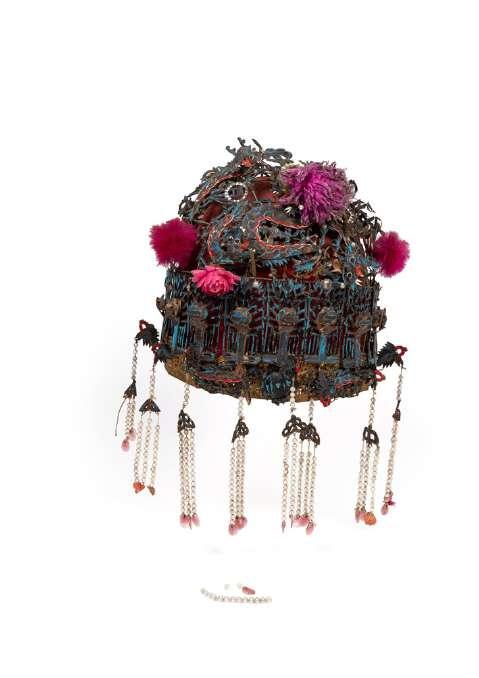
218

FOUR-PANEL LACQUERED WOOD SCREEN, China, early 20th century
h cm 159,5 x l cm 36 (each panel)
€ 500 / 800
Finely decorated on a black lacquer ground adorned with stylized gilt clouds, the panel depicts a spacious courtyard animated by figures among pavilions, trees, and rocks, rendered in relief with mother-of-pearl, bone, and hardstones, against a mountainous backdrop. The upper section is enriched with scholar’s objects and vases in mother-of-pearl and hardstones, set against a background of stylized clouds.
PARAVENTO IN LEGNO LACCATO A QUATTRO ANTE, Cina, inizio XX secolo
Ben decorato su fondo in lacca nera ornato da nuvole stilizzate dorate, il pannello raffigura un ampio cortile animato da figure tra pagode, alberi e rocce, resi a rilievo in madreperla, osso e pietre dure, con sullo sfondo un paesaggio montuoso. La sezione superiore è impreziosita da oggetti da studioso e vasi in madreperla e pietre dure, disposti su uno sfondo di nuvole stilizzate.
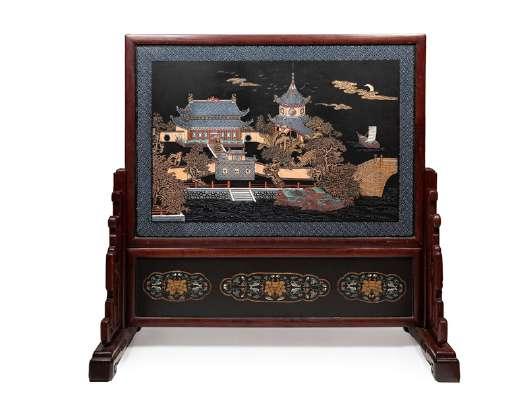
219
A LARGE PORCELAIN AND WOOD SCREEN, China, 20th century
h tot. cm 138,5 x l tot. cm 143,5
€ 800 / 1.000 民国
Depicting a landscape with pagodas, boats, and stylized clouds; the reverse bears a poetic inscription accompanied by archaistic objects.
GRANDE SCREEN IN LEGNO E PORCELLANA, Cina, XX secolo
Raffigurante due guerrieri e due dame in un paesaggio in un pannello riservato, e motivi di loto in un altro pannello riservato.
A WOODEN TABLE, China, Qing dynasty, 19th century
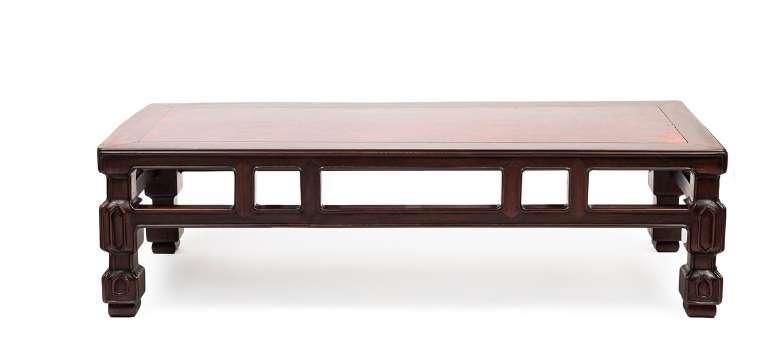
h cm 28 x l cm 99 x w cm 39
€ 200 / 300
With a rectangular top with plain edge, supported on four square legs.
TAVOLINO BASSO IN LEGNO, Cina, dinastia Qing, XIX secolo
Con piano rettangolare a bordo liscio, poggiante quattro piedini squadrati.
清 红木炕桌
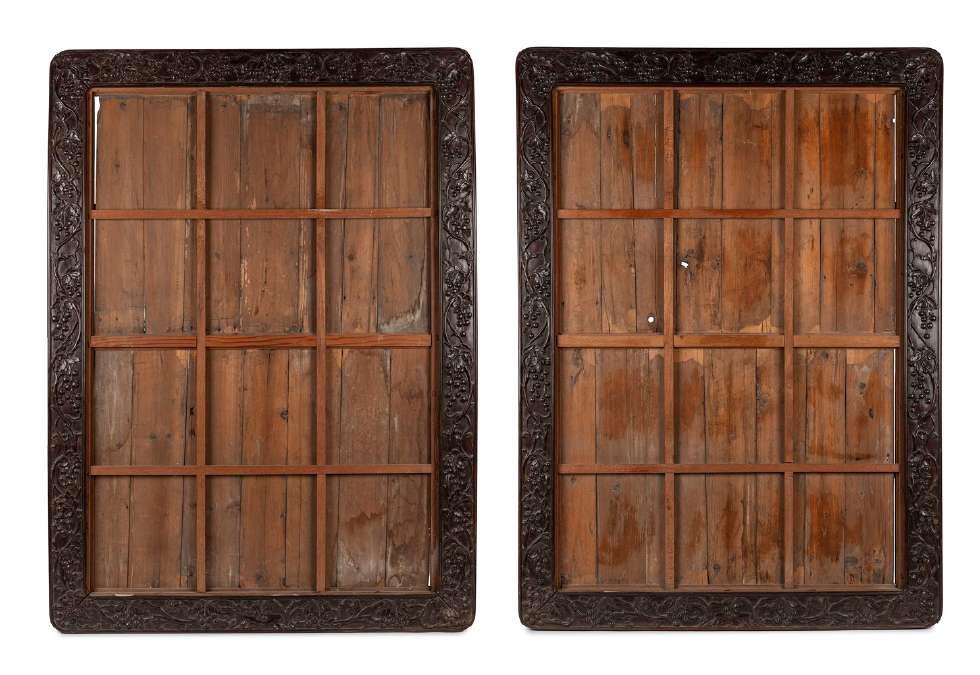
A PAIR OF LARGE WOODEN PANELS, China, Qing dynasty (1644-1911)
h cm 126 x l cm 91,5
€ 600 / 800
Rectangular in shape, with the frame finely carved with floral motifs and vine tendrils.
COPPIA DI GRANDI PANNELLI IN LEGNO, Cina, dinastia Qing (1644-1911)
Di forma rettangolare, con la cornice finemente intagliata con motivi floreali e tralci d’uva.
清 錾刻葡萄纹红木框一对
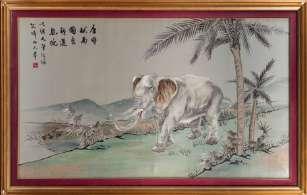

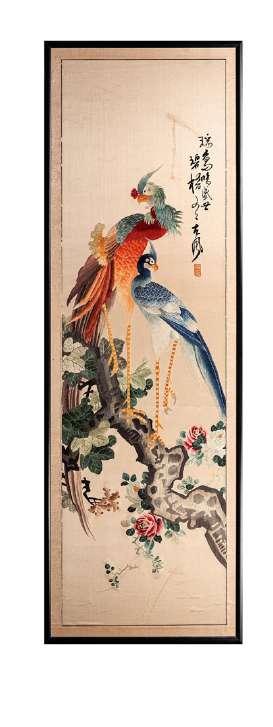
AN EMBROIDERED SILK FABRIC, China, 20th century
h cm 80,5 x l cm 125,5
€ 350 / 500
Finely brocaded, depicting an elephant in a mountainous landscape, with inscription and artist’s seal.
RICAMO SU SETA, Cina, XX secolo
Finemente broccato, raffigurante un elefante in un paesaggio montano; con iscrizione e sigillo dell’artista.
以唐人筆法仿 文峰山人幸
AN EMBROIDERED SILK, China, early 20th century
h cm 144,5 x l cm 68
€ 600 / 800
On a red ground, depicting Shoulao dressed in traditional robes and holding a peach beside He Xiangu shown accompanied by a deer, with a crane in flight in the background. Commemorative inscriptions are embroidered along the sides.
RICAMO SU SETA, Cina, inizio XX secolo
Ricamato a fili policromi su fondo rosso, raffigurante Shoulao in abiti tradizionali con una pesca in mano accanto a He Xiangu vicina a un cervo, con una gru in volo sullo sfondo. Ai lati compaiono iscrizioni di carattere commemorativo
20世纪初 刺绣麻姑献寿图
TWO SILK EMBROIDERED TEXTILES, China, 20th century
The larger h cm 153 x l cm 49,5
€ 500 / 600
They respectively depict two birds on a flowering branch, and a figure riding a kirin surrounded by attendants among flowers.
DUE TESSUTI RICAMATI SU SETA, Cina, XX secolo
Raffigurano rispettivamente due volatili su un ramo fiorito e un personaggio sopra un kirincircondata da personaggi tra fiori.
20世纪 绣品两幅

TWO HANGING SCROLL ON PAPER, China, 20th century
h cm 97 x l cm 22; h cm 32 x l cm 41
€ 300 / 500
Both depicting lakeside landscapes with lotus flowers and birds. Both with inscriptions.
DUE DIPINTI A SCROLL SU CARTA, Cina,
XX secolo
Entrambi raffiguranti paesaggi lacustri con fiori di loto e uccelli. Entrambi con iscrizioni.
20世纪 荷花水鸟写意画立轴/ 汪溶的花鸟画
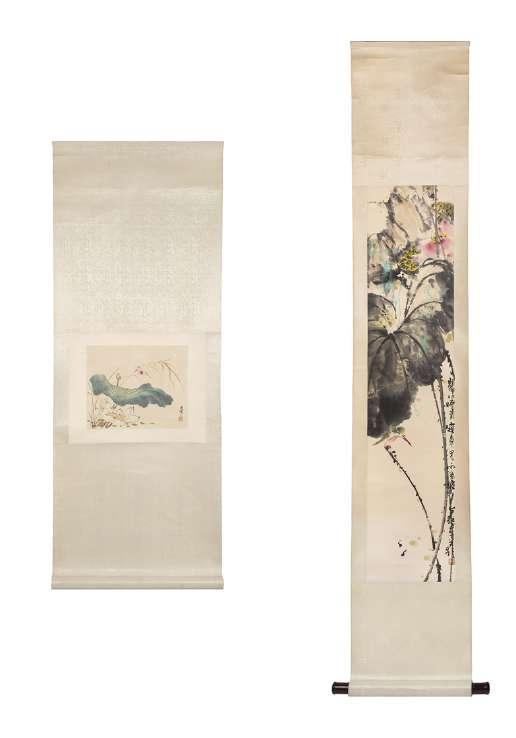
226
GROUP OF FOUR LITHOGRAPHS, China, 20th century
The larger h cm 43 x l cm 33
€ 200 / 300
One depicting a cat; three by the artist Wang Xue-tao, two depicting a spider, roses and a cricket inside a cage, and one depicting a plant with a flower.
GRUPPO DI QUATTRO LITOGRAFIE, Cina,
XX secolo
Una raffigurante un gatto; tre dell’artista Wang Xue-tao, di cui due raffiguranti ragno, rose e un grillo dentro la gabbietta e una raffigurante una pianta con un fiore.
20世纪 中国近现代花鸟画一组 “王雪涛” “高希舜”
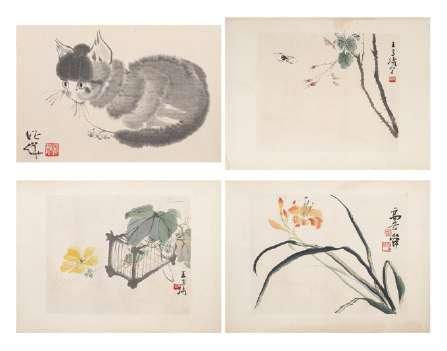
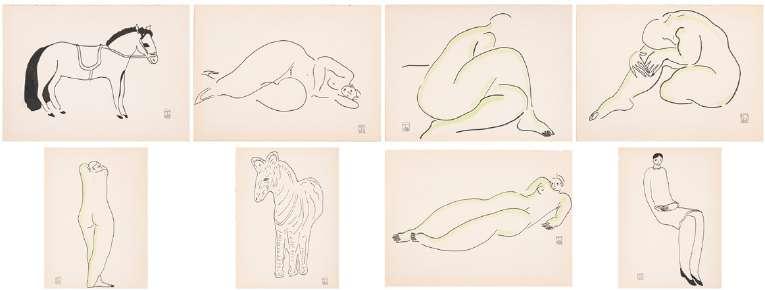
EIGHT
PRINTS ON
PAPER
BY SANYU (1895–1966), China, 20th century
h cm 20 x l cm 27
€ 800 / 1.000
Depicting profiles of women and horses.
OTTO INCISIONI SU CARTA DI SANYU (1895-1966), Cina, XX secolo
Raffiguranti profili di donne e cavalli.
20世纪 常玉(SANYU)版画一套八张
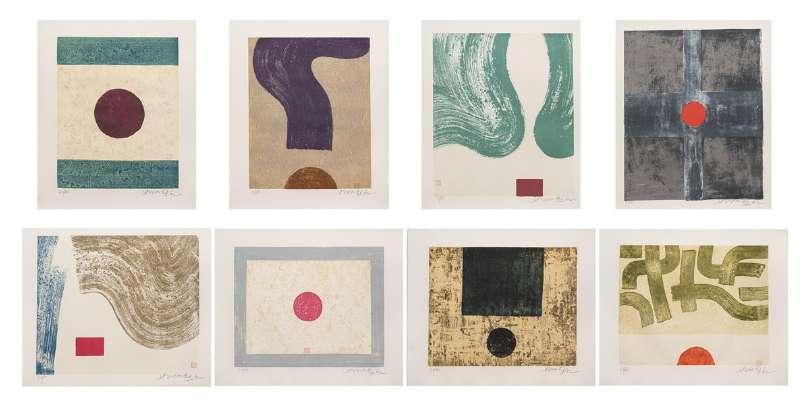
228
HSIAO CHIN, ALBUM OF PRINTS, China, 20th century
h cm 60,5 x l cm 50,5
€ 2.500 / 3.000
Album containing five etchings and three loose lithographs executed in 1962, numbered and signed in pencil; and a black-and-white ink on paper, limited to the first forty sheets of the edition. Example 30/80.
ALBUM DI INCISIONI DI HSIAO CHIN, Cina, XX secolo
Album contenente cinque acqueforti e tre litografie eseguite nel 1962, numerate e firmata a matita; e un inchiostro in bianco e nero su carta riservato alle prime quaranta cartelle della numerazione. Esemplare 30/80. 227
20世纪 萧勤(Hsiao Chin)的版画作品集
A TRADITIONAL TIBETAN DINING SET, Tibet, 19th century
h cm 20 x l cm 27
€ 3.000 / 5.000
The set comprises a silver-inlaid cutlery holder set with hardstones(l cm 21,5), enclosing a finely carved and decorated knife (l cm 30,5) and a pair of rice chopsticks; a bone kapala with silver mounts (l cm 12); a wooden tsampa container repoussé-decorated in silver with dragons, Taoist emblems and Garuda; a wooden flask with decoration matching that of the container (h cm 25); a richly adorned pouch/fire striker, embellished with a refined silver border of clouds and dragons and further set with hardstone flowers (l cm 13,5); and a small box inlaid with hardstones (l cm 8).
SET DA PASTO TIBETANO, Tibet, XIX secolo
Composto da un porta posate intarsiato in argento e incastonato con pietre dure (l cm 21,5), contenente un coltello (l cm 30,5), anch’esso finemente intagliato e decorato, e due bacchette per il riso; un capala in osso con rivestimento in argento (l cm 12); un contenitore tsampa in legno decorato a sbalzo in argento con draghi (d cm 18), oggetti della tradizione taoista e Garuda; una fiasca in legno con il medesimo decoro della scatola (h cm 25); una borsetta/acciarino riccamente decorata con un raffinato bordo con nuvole e draghi in argento e arricchita con dei fiori in pietre dure (l cm 13,5) e una scatolina con intarsi in pietra dura (l cm 8).
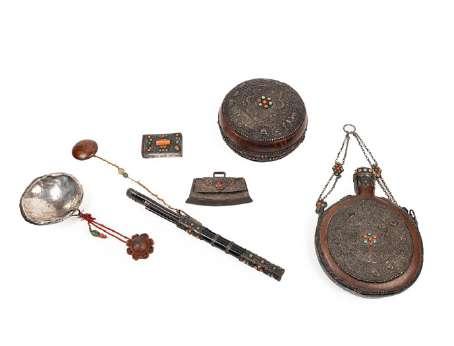
230
A WOODEN SCULPTURE, Himalaya, 18th / 19th century
h cm 31 x l cm 26
€ 500 / 700
Finely carved, depicting Shiva and Parvati seated in a benedictory posture and accompanied by two acolytes beneath an arched shrine surmounted by a figure of Garuda.
SCULTURA IN LEGNO, Himalaya, XVIII / XIX secolo
Raffigurante Shiva e Parvati seduti in posizione benedicente e accompagnati da due accoliti sotto un tempietto ad arco, sormontato da figura di Garuda.
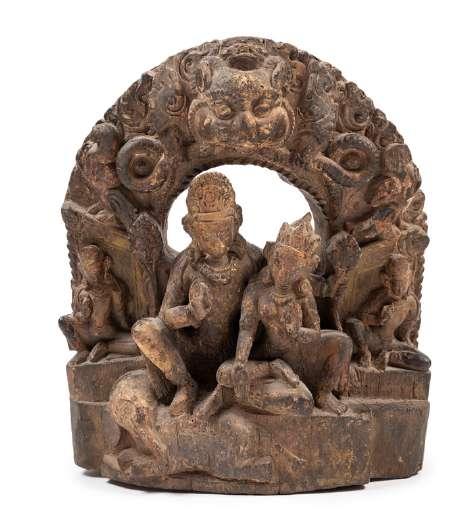
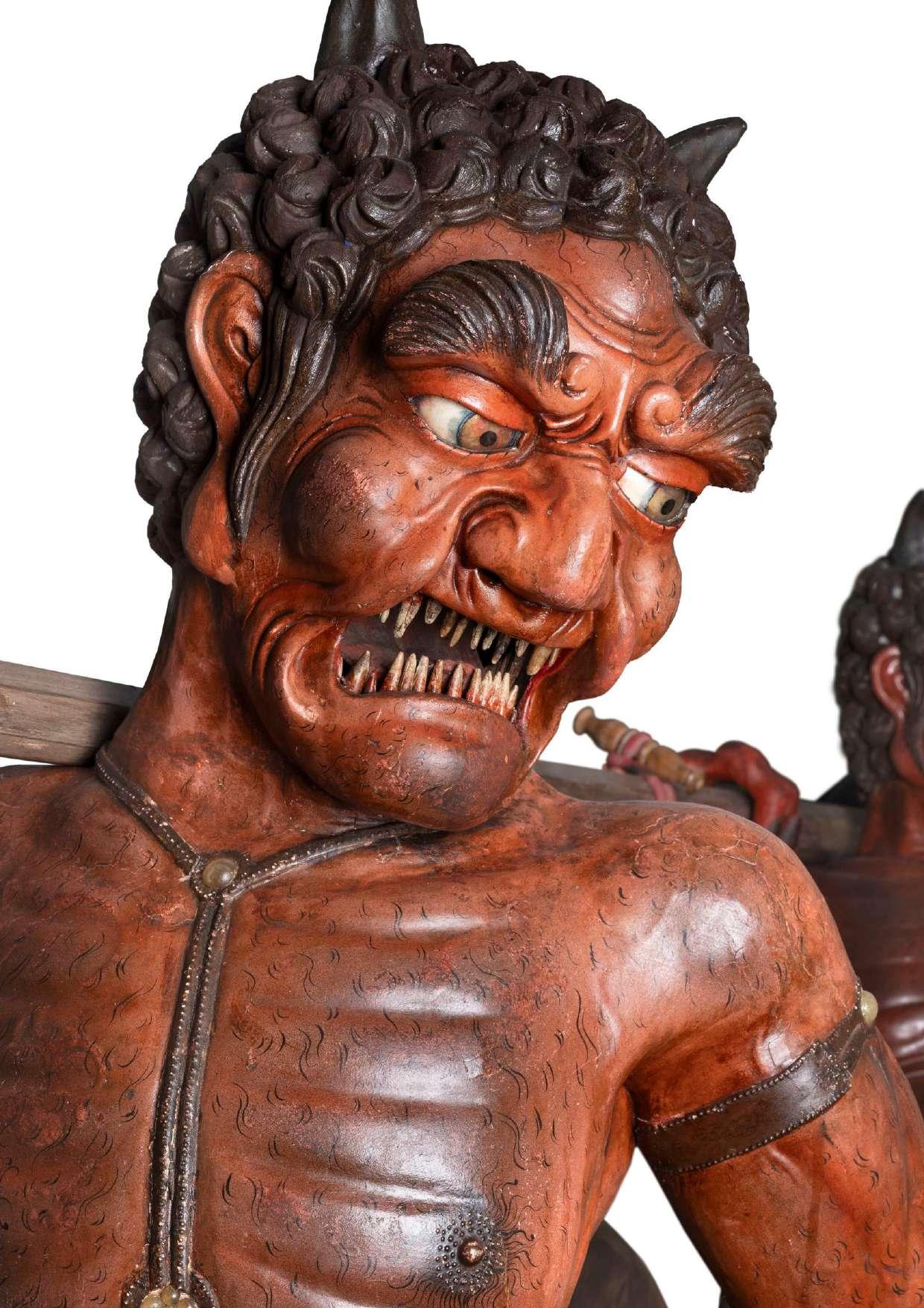
AN IMPRESSIVE LACQUERED WOOD SCULPTURE, Japan, Meiji period, 19th century
h cm 186 x l cm 212
231 € 50.000 / 70.000
Depicting two finely lacquered oni (demons), rendered in vivid red and black tones, with fierce expressions and muscular bodies in motion as they carry a large dora (gong) in a ritual procession. Catalog notes: An almost identical sculpture is in the collection of the Metropolitan Museum of Art in New York, object number 89.4.2016a–e.
ENORME SCULTURA IN LEGNO LACCATO,
Giappone, periodo Meiji, XIX secolo
Raffigurante due oni (demoni) finemente laccati nei toni del rosso e del nero, caratterizzati da espressioni feroci e corpi muscolosi in movimento, mentre trasportano un grande dora (gong) durante una processione rituale. Note di catalogo: Una scultura quasi identica è conservata al Metropolitan Museum of Art a New York, numero di archivio 89.4.2016a–e.
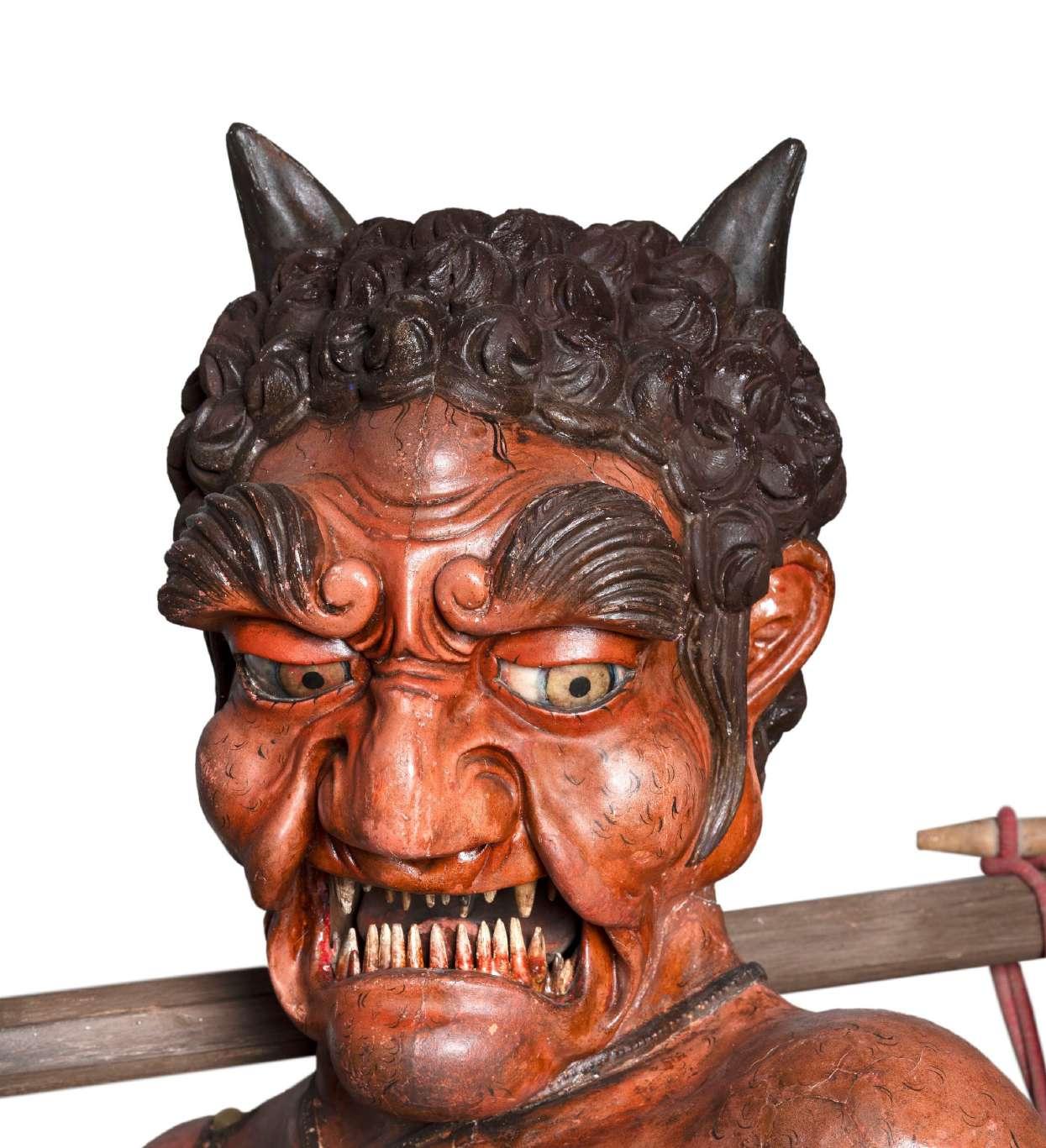
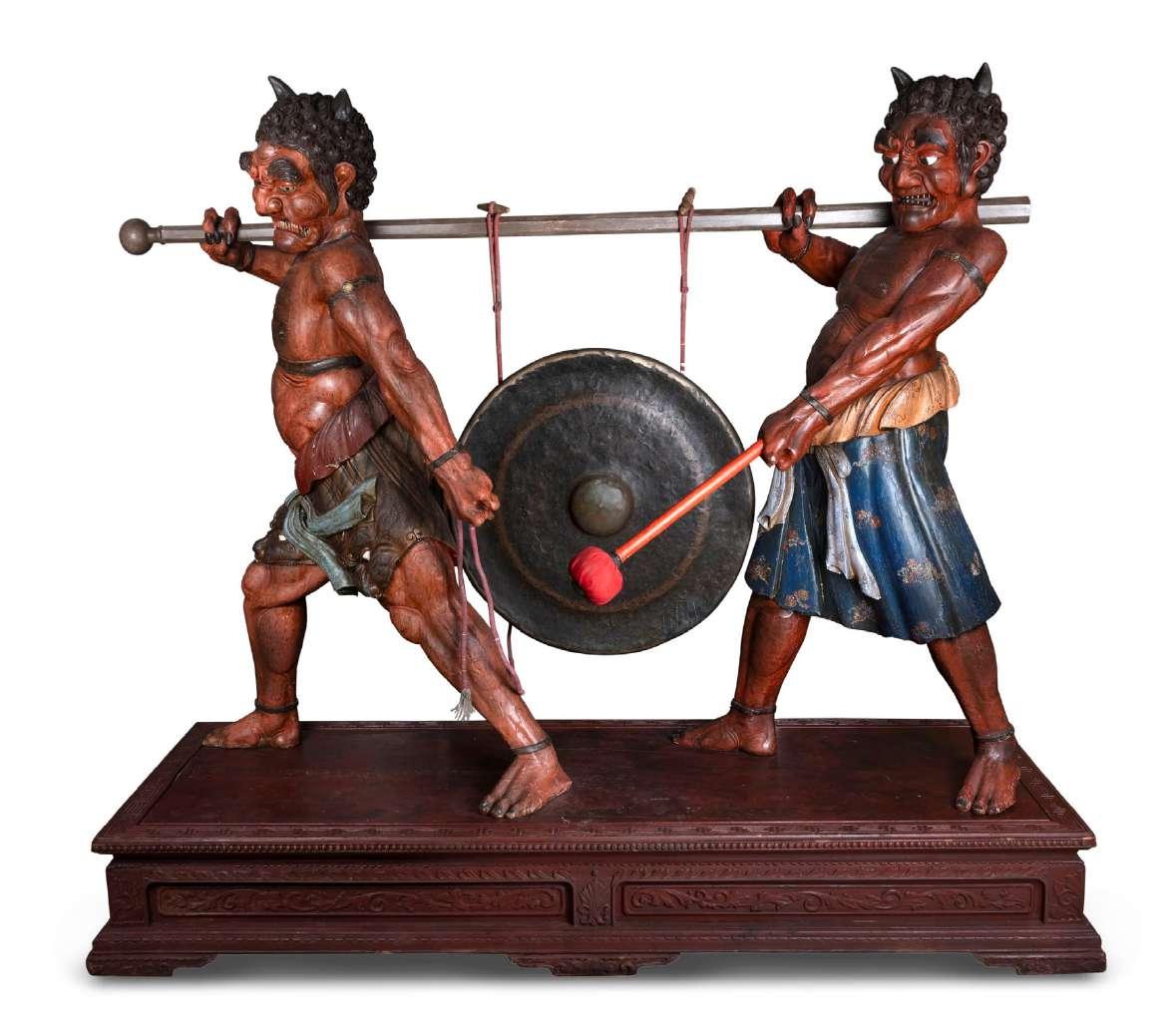
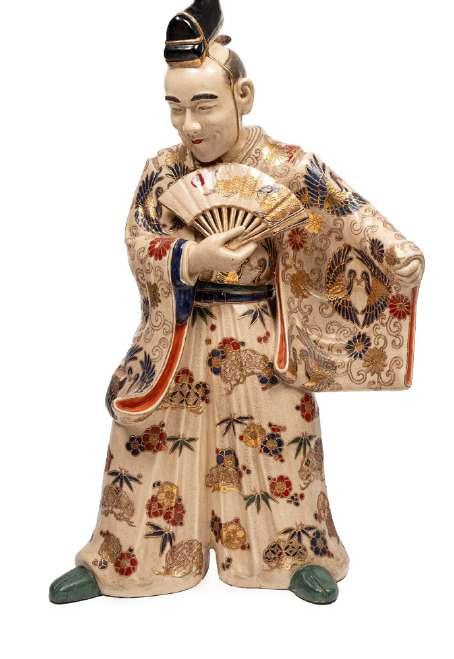
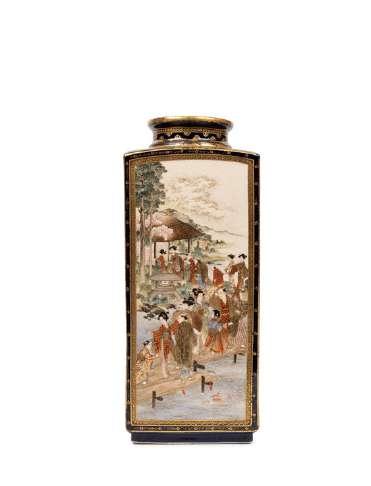

A LARGE SATSUMA FIGURE, Japan, Meiji period (1868-1912)
h cm 94
€ 1.100 / 1.500
Depicting a Noh theater actor, dressed in an elegant stage costume adorned with floral and leafy motifs and flying cranes; in his right hand he holds a sensu (folding fan) decorated with the same motifs as the garment.
GRANDE FIGURA IN CERAMICA SATSUMA, Giappone, periodo Meiji (1868-1912)
Raffigurante un attore del teatro Noh, vestito con un elegante abito di scena ornato da motivi floreali, fogliacei e gru in volo; nella mano destra tiene un sensu (ventaglio) decorato con gli stessi motivi dell’abito.
233
A SATSUMA SQUARE-SECTION VASE, Japan,
Meiji period (1868-1912)
h cm 31
€ 500 / 700
Square in section, with a black ground and gilded decorations, the body features two large rectangular panels, each containing a scene: one depicts ladies in a landscape, the other a naturalistic setting with a cherry tree and sparrows. The remaining two sides, on a black ground with gilded ornamentation, display foliate motifs and butterflies, enriched with three panels featuring figures and floral designs. Signed Ryozan, with the mark of the Yasuda Company and the Shimazu family seal.
VASO IN CERAMICA SATSUMA, Giappone, periodo Meiji (1868-1912)
A sezione quadrata, con fondo nero e decorazioni in oro, il corpo presenta due grandi pannelli rettangolari, ciascuno contenente una scena: uno raffigura dame in un paesaggio, l’altro un ambiente naturalistico con un albero di ciliegio e passerotti. Gli altri due lati, su fondo nero con decori dorati, mostrano motivi fogliacei e farfalle, arricchiti da tre riserve con figure e motivi floreali. Firmato Ryozan, con marchio della Yasuda Company e il marchio della famiglia Shimazu.
234
A LARGE SATSUMA
LANTERN-SHAPED CERAMIC VASE, Japan, Meiji period (1868-1912)
h cm 29
€ 2.500 / 3.500
Decorated within three rectangular reserves with scenes of daily life and naturalistic subjects. signed matsumoto hozan to the underside.
GRANDE VASO IN CERAMICA
DI SATSUMA A FORMA DI LANTERNA, Giappone, periodo Meiji (1868-1912)
Decorato entro tre riserve rettangolari con scene di vita quotidiana e naturalistiche. Firmato Matsumoto Hozan sotto la base.


235
A SATSUMA GOSU BLUE CERAMIC KORO, Japan, Meiji period (1868-1912)
h cm 29
€ 600 / 800
Of truncated pyramidal form, executed with colored and gilt enamels on a light crackled ground with stylized floral decoration.
KORO IN CERAMICA SATSUMA “GOSU BLUE” Giappone, periodo Meiji (1868-1912)
Di forma troncopiramidale realizzato con smalti colorati e dorati su un fondo craquelé chiaro con decoro floreale stilizzato.
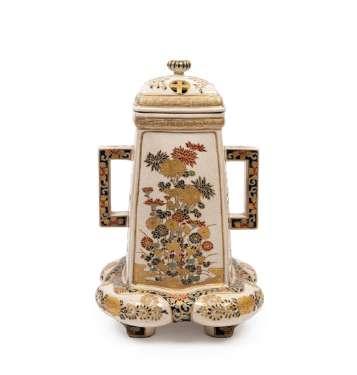

236
A LARGE SATSUMA “THOUSAND CRANES” VASE, Japan, Meiji period (1868-1912)
h cm 63,5
€ 500 / 800
Ovoid in shape with a wavy rim; entirely decorated with the ‘Thousand Cranes’ motif amid gilt clouds.
GRANDE VASO SATSUMA ‘’MILLE GRU’’, Giappone, periodo Meiji (1868-1912)
Di forma ovoidale con orlo mosso a onda; è interamente decorato con il decoro delle ‘’Mille gru’’ tra nuvole dorate.

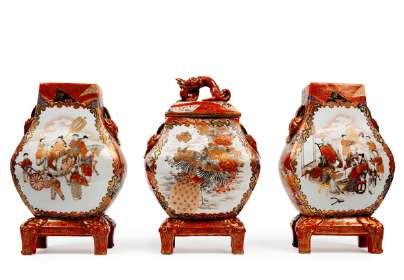

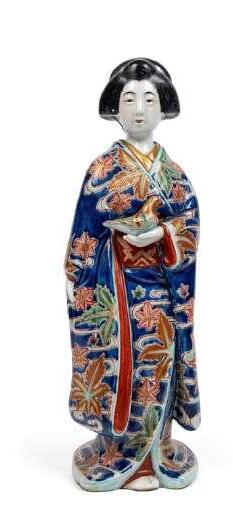
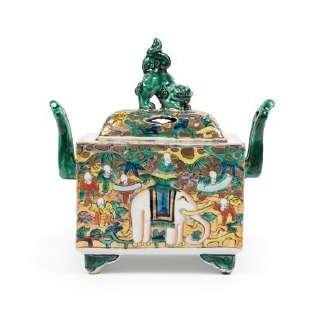
THREE
KUTANI
PORCELAIN VASES,
Japan, Meiji period (1868-1912)
€ 1.200 / 1.400
They rest on a square base enamelled in iron-red with gilt decorations and feature two handles shaped as mask motifs. Both sides are decorated with panels framed by bats, depicting a procession of figures and birds within a naturalistic landscape enriched with peonies and plum blossoms. One of the vases is surmounted by a lid topped with a dragon.
TRE VASI IN PORCELLANA KUTANI, Giappone, periodo Meiji (1868-1912)
Poggiano su una base quadrata smaltata in rosso ferro con decorazioni in oro e presentano due anse a forma di mascheroni. Sono decorati sui due lati con riserve contornate da pipistrelli, raffiguranti un corteo di figure e uccelli in un paesaggio naturalistico arricchito da peonie e fiori di pruno. Uno dei vasi è completato da un coperchio sormontato da un drago.
A
KUTANI PORCELAIN FIGURE, Japan, Meiji period (1868-1912)
€ 150 / 200
Depicting a geisha elegantly dressed in a blue kimono adorned with floral motifs, gently holding a bird in her right hand.
FIGURA IN PORCELLANA KUTANI, Giappone, periodo Meiji (1868-1912)
Raffigurante una geisha elegantemente vestita con un kimono a fondo blu decorato con motivi floreali, mentre tiene delicatamente un uccellino nella mano destra.
A KUTANI PORCELAIN CENSER, Japan, early 20th
The larger h cm 30,5 h cm 30,5 h cm 17,5 x l cm 18
century
€ 200 / 300
Rectangular and bi-arched in section, it rests on four feet shaped as stylised clouds. The body is painted on a gilt ground with figures riding a carp and an elephant, while the lid is surmounted by a green-glazed pho dog.
INCENSIERE IN PORCELLANA KUTANI, Giappone, inizio XX secolo
A sezione rettangolare e biansato, poggia su quattro piedi a nuvole stilizzate. Il corpo è dipinto su fondo oro con figure che cavalcano una carpa e un elefante, mentre il coperchio è sormontato da un cane di pho smaltato in verde.

A LARGE IMARI VASE, Japan, Meiji period (1868-1912)
h cm 54
240 € 300 / 500
The body is richly decorated with floral motifs and cartouches on a gold background, featuring three large polylobed panels depicting: a relief vase of flowers with butterflies, a naturalistic landscape with a tiger and a dragon among stylized clouds, and ladies in a landscape with a flowering tree in relief. The neck is adorned with dragons among clouds on a red background, while the lid is finely carved wood.
GRANDE VASO IN PORCELLANA IMARI,
Giappone, periodo Meiji (1868-1912)
Il corpo è riccamente decorato con motivi floreali e cartigli su fondo oro, comprendente tre grandi riserve polilobate raffiguranti: un vaso di fiori a rilievo con farfalle, un paesaggio naturalistico con una tigre e un drago in rilievo tra nuvole stilizzate, e dame immerse in un paesaggio con un albero fiorito a rilievo. Il collo è ornato da draghi tra nuvole su fondo rosso, mentre il coperchio è in legno finemente intagliato.
A LARGE PAIR OF IMARI VASES, Japan, Meiji period (1868-1912)
h cm 91,6
€ 2.000 / 2.500
Baluster-shaped, the vases are richly decorated on the body and neck with floral medallions, dragons and phoenixes flying among stylized clouds, and large lobed reserves enclosing blooming garden scenes.
COPPIA
DI GRANDI
VASI
IN PORCELLANA IMARI, Giappone, periodo Meiji (1868-1912)
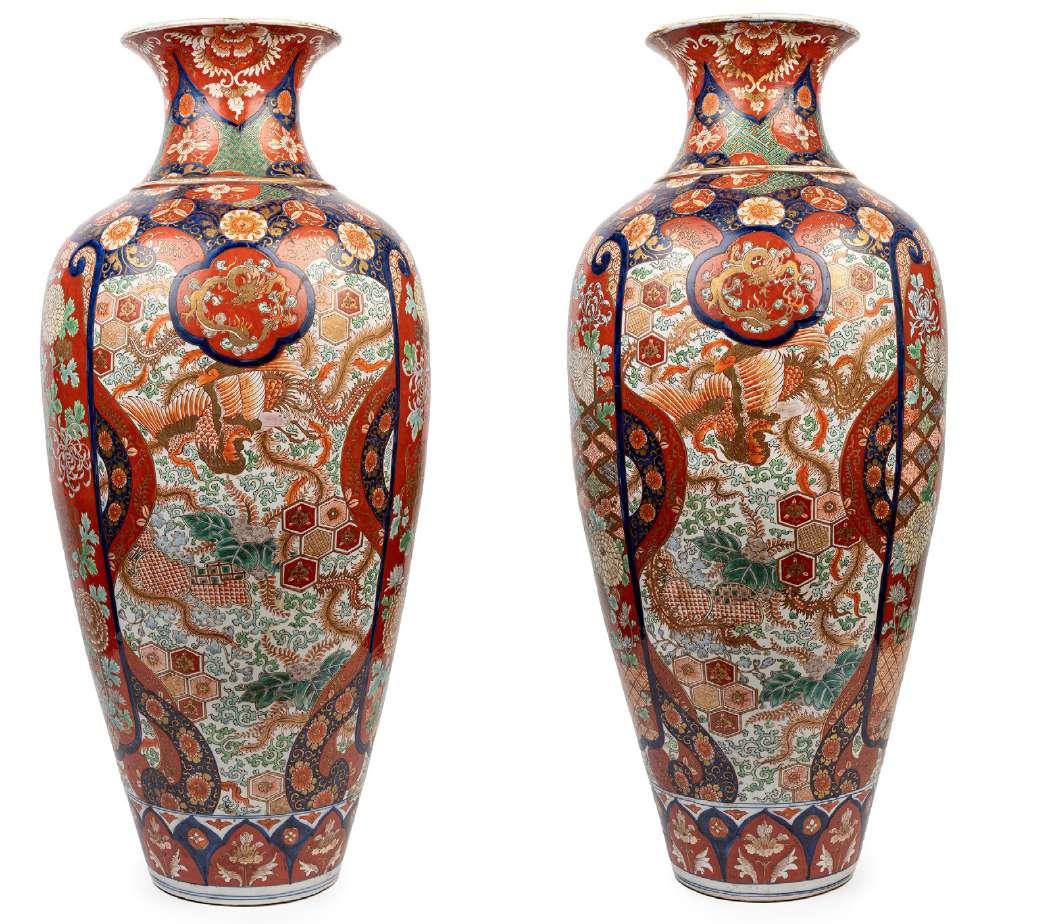
Di forma a colonna di balaustra, i vasi sono riccamente decorati sul corpo e sul collo con medaglioni fioriti, draghi e fenici in volo tra nuvole stilizzate, e ampie riserve lobate che racchiudono giardini fioriti.
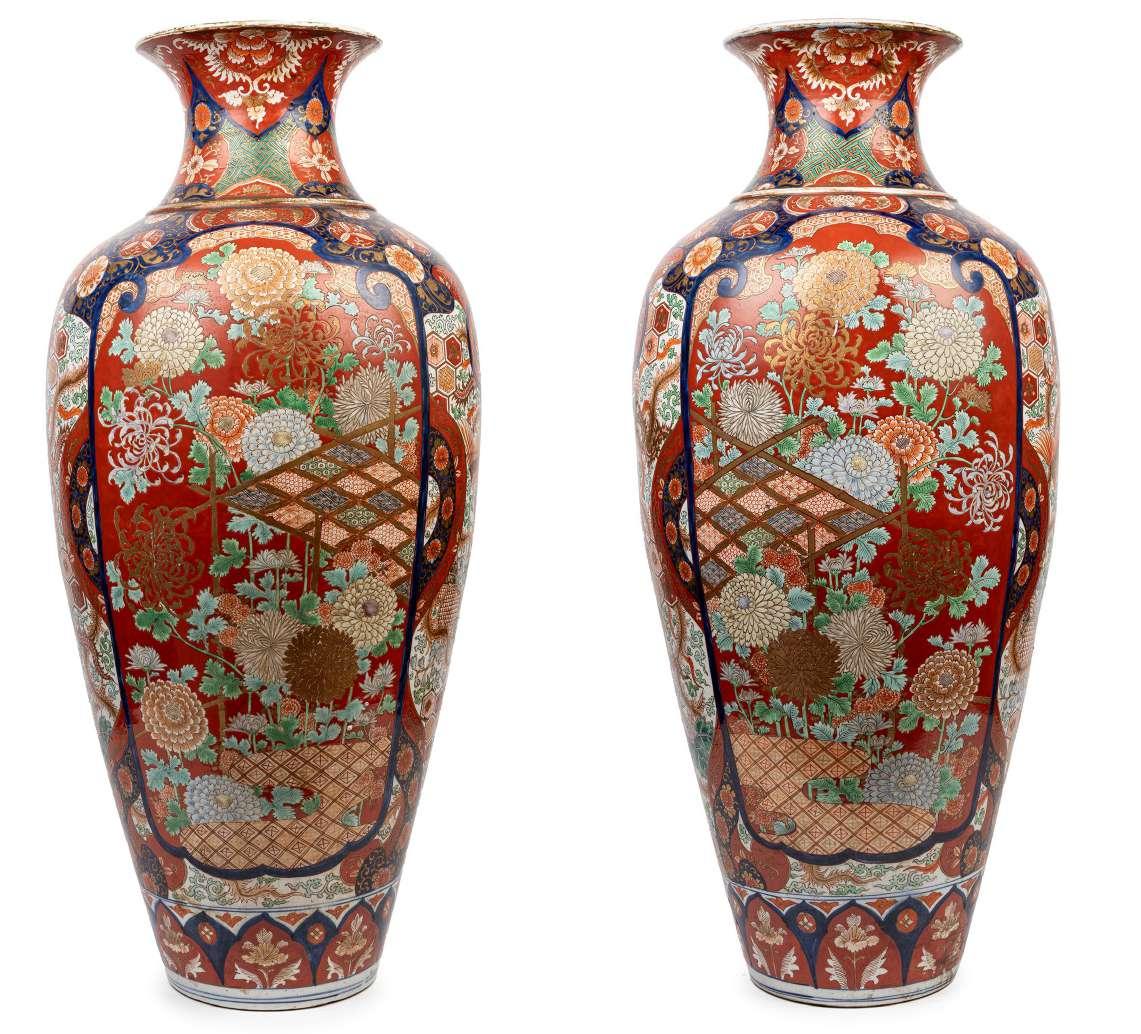

A PORCELAIN OKIMONO,
Japan, Meiji period (1868-1912)
h cm 39
Depicting a shachi koi carp resting on a glazed base simulating bronze, with its mouth open and a sphere on its tongue.
OKIMONO IN PORCELLANA, Giappone, periodo Meiji (1868-1912)
Raffigurante la carpa shachi koi appoggiata sulla base smaltata a simulare il bronzo con la bocca aperta e una sfera sulla lingua. 242 € 1.500 / 2.500
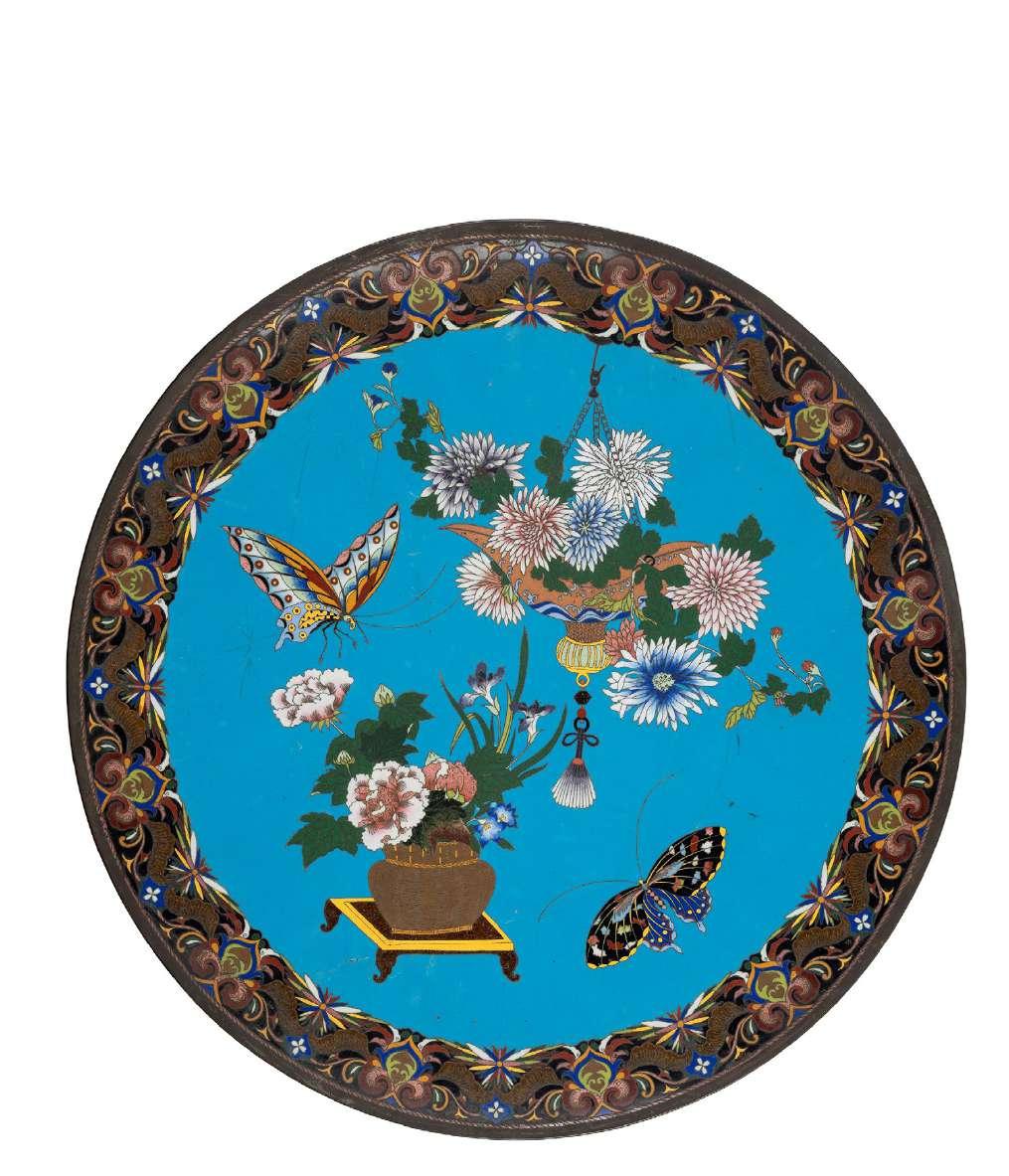
A LARGE CLOISONNE PLATE, Japan, Meiji period (1868-1912)
d cm 62
243 € 300 / 500
Finely enamelled on a turquoise ground, the dish is decorated with a vase and a lantern adorned with peonies, chrysanthemums and foliate motifs, flanked by two butterflies in flight; the rim is embellished with elegant floral designs.
GRANDE PIATTO IN SMALTO CLOISONNÈ, Giappone, periodo Meiji (1868-1912)
Finemente smaltato su fondo turchese, il piatto è decorato con un vaso e una lanterna ornati da peonie, crisantemi e motivi fogliacei, accompagnati da due farfalle in volo; la tesa presenta un’elegante decorazione a motivi floreali.
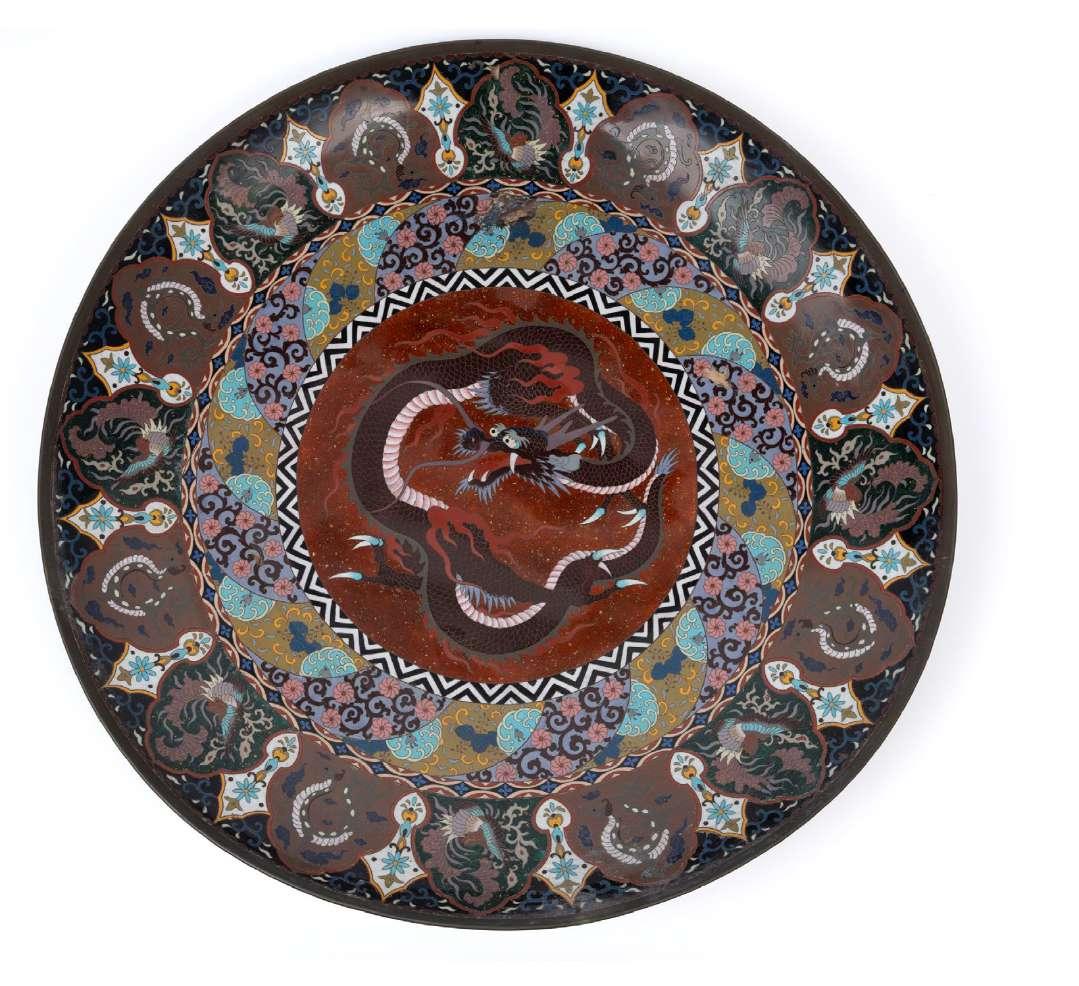
A LARGE CLOISONNÉ CHARGER
IN POLYCHROME ENAMELS AND AVENTURINE STONE, Japan, Meiji period (1868-1912)
d cm 58,5
€ 600 / 800
Depicting a dragon within a circular reserve.
GRANDE PIATTO CLOISONNÉ IN SMALTI POLICROMI E PIETRA AVVENTURINA, Giappone, periodo Meiji (1868-1912)
Raffigurante un drago entro una riserva circolare.
A
PAIR OF CLOISONNÉ VASES, Japan, Meiji period (1868-1912)
h cm 46
€ 300 / 500
Baluster-shaped, the body is painted on a blue ground with panels depicting dragons and phoenixes, surmounted by a band decorated with floral motifs. The upper section is finely glazed with foliate ramages and chrysanthemums, alternating with lobed panels containing birds.
COPPIA DI VASI IN SMALTO CLOSIONNÈ, Giappone, periodo Meiji (1868-1912)
A forma di colonna di balaustro, il corpo è dipinto su fondo blu con riserve raffiguranti dragoni e fenici, sovrastato da una fascia ornata con motivi floreali. La parte superiore è finemente smaltata con ramages fogliacei e crisantemi, alternati a riserve lobate contenenti volatili.
246
A
PAIR OF LARGE CLOISONNE VASES, Japan, Meiji period (1868-1912)
h cm 63,5
€ 500 / 800
Shaped as baluster columns, they feature an elegant decoration on a black ground enriched with gilt scrolls and chrysanthemums. Further adorned with reserves of various shapes enclosing floral motifs, butterflies, birds, and landscapes.
COPPIA DI GRANDI VASI IN CLOISONNÈ, Giappone, periodo Meiji (1868-1912)
A forma di colonne di balaustra, presentano una raffinata decorazione su fondo nero, arricchita da volute dorate e crisantemi. Sono ulteriormente ornati da riserve di varie forme contenenti motivi floreali, farfalle, uccelli e paesaggi. 245

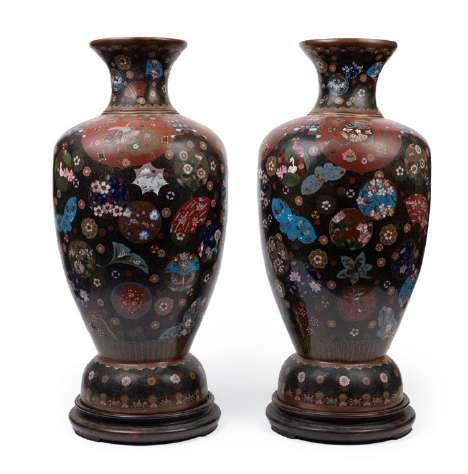
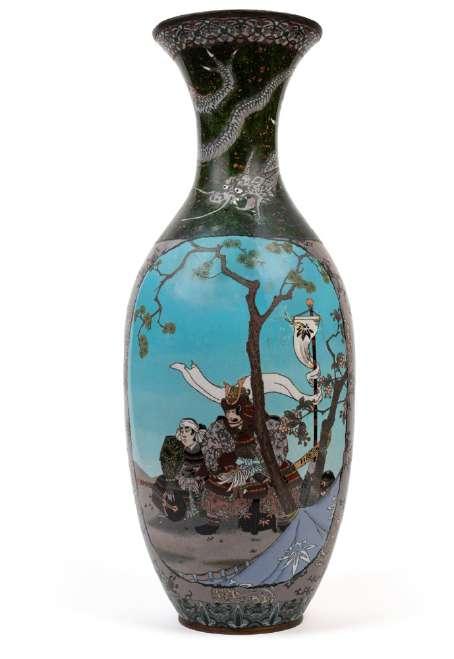
247
A LARGE CLOISONNE VASE, Japan, Meiji period (1868-1912)
h cm 62
€ 250 / 300
Of baluster-column form, the vase has a body enamelled with a grey ground decorated with floral motifs and phoenixes, featuring two large turquoise reserves depicting, respectively, a pond with peonies, chrysanthemums, and cranes, and a scene with samurai beneath a plum tree. The neck is enamelled on a green ground, seamlessly decorated with a three-clawed writhing dragon.
GRANDE VASO CLOISONNÈ,
Giappone, periodo Meiji (1868-1912)
Dalla forma a colonna di balaustra, con il corpo smaltato con un fondo grigio con decori floreali e fenici e con due grandi riserve a sfondo turchese raffiguranti uno stagno con peonie, crisantemi e gru e l’altra con samurai sotto un albero di pruno; il collo del vaso è smaltato su fondo verde senza soluzione di continuità con un drago ritorto a tre artigli.
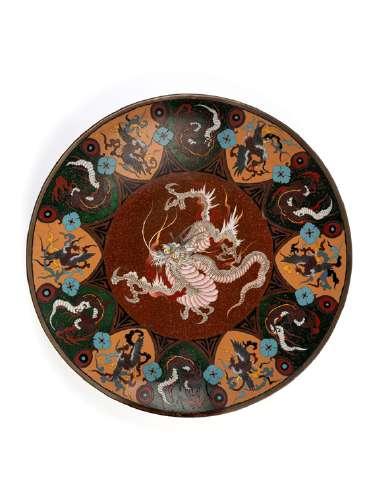
248
A CLOISONNÉ DISH,
Japan, Meiji period (1868-1912)
d cm 36
€ 150 / 200
Centered with a three-clawed coiled dragon on a brown ground, the rim decorated with alternating panels depicting dragons and phoenixes.
PIATTO IN SMALTO CLOISONNÈ,
Giappone, periodo Meiji (1868-1912)
Centrato da un drago a tre artigli avvolto su se stesso su fondo marrone, con la tesa decorata da riserve alternate raffiguranti draghi e fenici.
249
A CLOISONNÉ ENAMEL CENSER,
Japan, Meiji period (1868-1912)
h cm 23,5 (without the screw)
€ 100 / 150
Shaped like a candlestick, it is decorated in multiple bands with floral motifs and stylized clouds. The body, pierced on all sides, features an opening adorned with stylized clouds on a turquoise ground.
INCENSIERE IN SMALTO CLOISONNÉ, Giappone, periodo Meiji (1868-1912)
A forma di candeliere, è decorato su più fasce con motivi floreali e nuvole stilizzate. Il corpo, traforato su tutti i lati, presenta un’apertura ornata da nuvole stilizzate su fondo turchese.
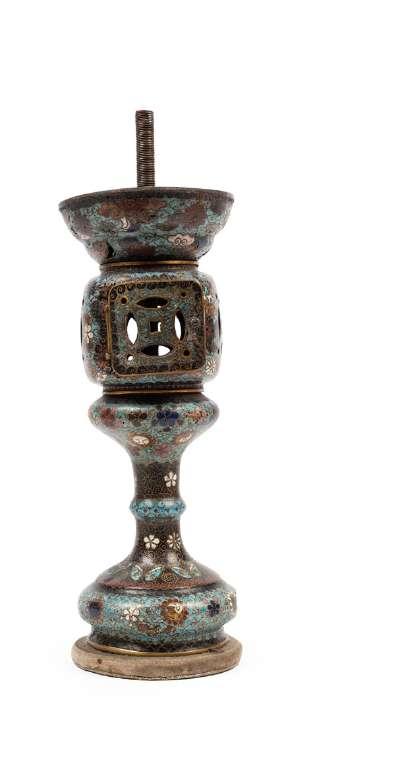
250
A
BRONZE TRIPOD CENSER, Japan, Meiji period (1868-1912)
h cm 18 x l cm 10
€ 2.000 / 4.000
Resting on three stylised feet, the base decorated with leafy scrolls and peonies, the body is flanked by two lingzhi-shaped handles and finely adorned with a floral design featuring butterflies, chased with gilt details. The openwork upper section is enriched with gilt foliate motifs and surmounted by a flower-shaped finial. An inscription is inscribed to the base.
INCENSIERE TRIPODE IN BRONZO, Giappone, periodo Meiji (1868-1912)
Poggiato su tre piedini stilizzati, con base decorata da ramages fogliacei e peonie, il corpo presenta due anse a forma di lingzhi ed è ornato da una raffinata decorazione floreale con farfalle, cesellata con dettagli in oro. La parte superiore, traforata e arricchita da motivi fogliacei con particolari dorati, reca una presa del coperchio a fiore. Alla base reca un’iscrizione.
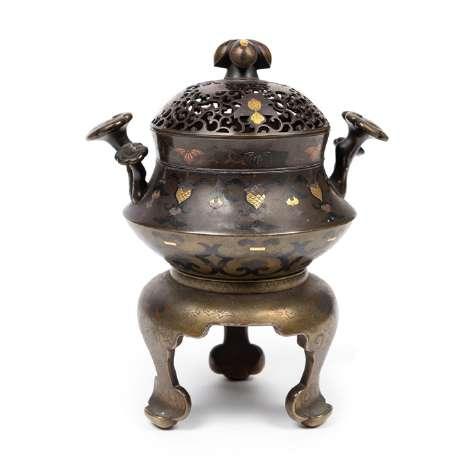



251
PATINATED AND GILT BRONZE OKIMONO, Japan, Meiji period (1868-1912)
h cm 34 x l cm 56,5
€ 2.000 / 3.000
Depicting a finely engraved pheasant, resting on a carved wooden base with floral motifs. signed within a rectangular cartouche.
OKIMONO IN BRONZO PATINATO E DORATO, Giappone, periodo Meiji (1868-1912)
Raffigurante un fagiano finemente inciso, poggiante su una base in legno intagliata con motivi floreali. Firmato entro riserva rettangolare.

252
A BRONZE OKIMONO, Japan, Meiji period (1868-1912)
h cm 44 x l cm 35
€ 2.000 / 2.500
Depicting an elephant fighting with a crocodile. Signed on the underside Atsuyoshi for the Maruki Company.
OKIMONO IN BRONZO, Giappone, periodo Meiji (1868-1912)
Raffigurante un elefante mentre combatte con un coccodrillo. Firmato sulla pancia Atsuyoshi per Maruki company.
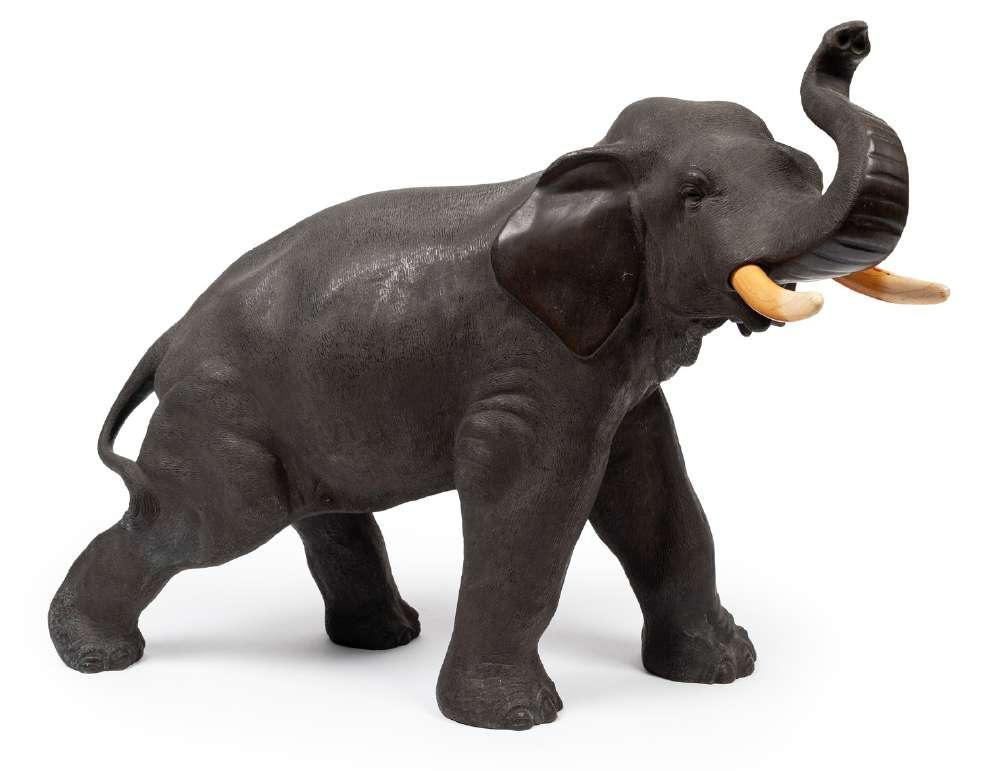
253
☼A BRONZE OKIMONO WITH IVORY DETAILS, Japan, Meiji period, late 19th century
h cm 36 x l cm 48
€ 1.000 / 1.500
Depicting an elephant walking with its trunk raised.
N. CITES: IT/CE/2025/MI/00838”
☼OKIMONO IN BRONZO CON PARTI IN AVORIO, Giappone, periodo Meiji, fine XIX secolo
Raffigurante un elefante in cammino con proboscide alzata.
N. CITES: IT/CE/2025/MI/00838”
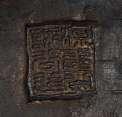


☼A BRONZE OKIMONO WITH IVORY DETAILS, Japan, Meiji period, late 19th century
h cm 37 x l cm 41,5
254 € 1.000 / 1.500
Depicting an elephant attacked by two tigers.
N. CITES: IT/CE/2025/MI/00787
☼OKIMONO IN BRONZO CON PARTI IN AVORIO, Giappone, periodo Meiji, fine XIX secolo
Raffigurante un elefante attaccato da due tigri.
N. CITES: IT/CE/2025/MI/00787”

255
PATINATED BRONZE OKIMONO, Japan, Meiji period (1868-1912)
h cm 26,5 x l cm 60,5
€ 1.000 / 1.200
Depicting the study of a powerful roaring tiger.
OKIMONO IN BRONZO PATINATO, Giappone, periodo Meiji (1868-1912)
Raffigurante lo studio di una potente tigre ruggente.

256
A BRONZE KORO, Japan, Meiji period (1868-1912)
h cm 16,3
€ 500 / 700
Depicting a karashishi with its mouth wide open, facing upward.
KORO IN BRONZO, Giappone, periodo Meiji (1868-1912)
Raffigurante un karashishi con la bocca spalancata rivolta verso l’alto.
257
A BRONZE OKIMONO, Japan, Meiji period (1868-1912)
h cm 61
Depicting standing Daikokuten, the Buddhist deity of fortune.
OKIMONO IN BRONZO, Giappone, periodo Meiji (1868-1912)
Raffigurante Daikokuten, divinità della fortuna del buddhismo, in posizione stante.
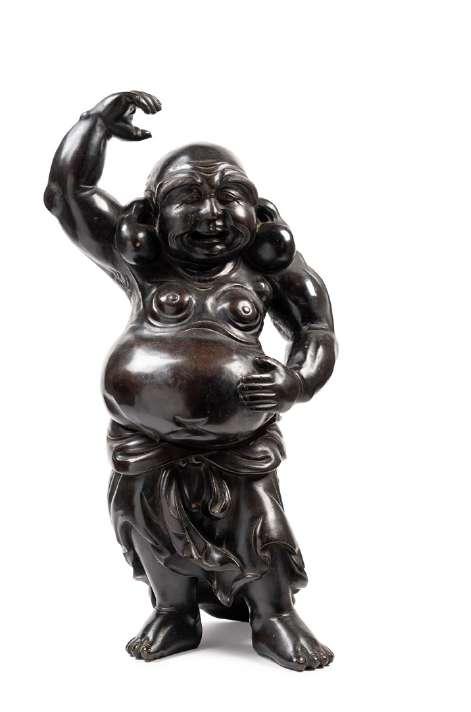
A BRONZE OKIMONO,
Japan, Edo period, 19th century
h cm 28,5 x l cm 39
258 € 400 / 600 € 500 / 700
Depicting a smiling Hotei seated on a six-legged raised base, while three mice play with him.
OKIMONO IN BRONZO, Giappone, Periodo Edo, XIX secolo
Raffigurante un Hotei sorridente, seduto su una base rialzata a sei piedi mentre tre topolini giocano con lui.
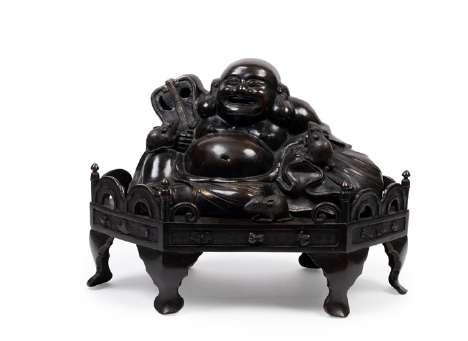


259
A
BRONZE OKIMONO, Japan, Meiji period (1868-1912)
h cm 17
€ 400 / 600
Depicting a smiling Hotei holding his sack filled with all the treasures of the world.
OKIMONO IN BRONZO, Giappone, periodo Meiji (1868-1912)
Raffigurante Hotei sorridente mentre tiene in mano il suo sacco pieno di tutti i tesori del mondo.
260
A SILVER MODEL OF DAIKOKU’S MALLET WITH INSET CLOCK, Japan, Meiji period (1868-1912)
l cm 17
€ 300 / 500
Of traditional form, incised with scrolling flowers and foliage on the handle, while the main body simulates a wood grain effect. The interior inset with a clock made by Seikosha, Tokyo Weight: 667 g.
MODELLO IN ARGENTO DEL MARTELLO DI DAIKOKU CON OROLOGIO INCASTONATO, Giappone, periodo Meiji (1868-1912)
Dalla forma tradizionale, inciso con fiori e fogliame a volute sul manico, mentre il corpo principale simula l’effetto della venatura del legno. L’interno è impreziosito da un orologio realizzato dalla Seikosha, Tokyo. Peso g 667.

261
A SILVER AND MIXED-METAL OKIMONO, Japan, Meiji period (1868-1912)
h cm 46 x l cm 39 x p cm 18
€ 1.000 / 1.500
Depicting the Takarabune (Treasure Ship), with a finely hammered and chased dragon at the prow. The sail, decorated on both sides with gilt swastika-shaped geometric motifs, bears at its center a circular reserve with floral designs. On board are the takarazukushi (auspicious treasure symbols), including three makimono (sacred scrolls), the chōji (clove buds), the kinnō (treasure pouch), and the kakuremino (robe of invisibility). The vessel rests on a base adorned with stylized clouds and waves, animated by gilt turtles.
OKIMONO IN ARGENTO E METALLO MISTI, Giappone,
periodo Meiji (1868-1912)
Raffigurante la Takarabune (nave del tesoro), con un dragone finemente sbalzato e cesellato a prua. La vela, decorata su entrambi i lati con motivi geometrici dorati a svastica, reca al centro una riserva circolare con motivi floreali. A bordo si trovano i takarazukushi (simboli augurali di prosperità), tra cui tre makimono (rotoli sacri), i chōji (gemme di chiodi di garofano), il kinnō (borsa del tesoro) e il kakuremino (mantello dell’invisibilità). L’imbarcazione poggia su una base ornata da onde e nuvole stilizzate, animate da tartarughe dorate.

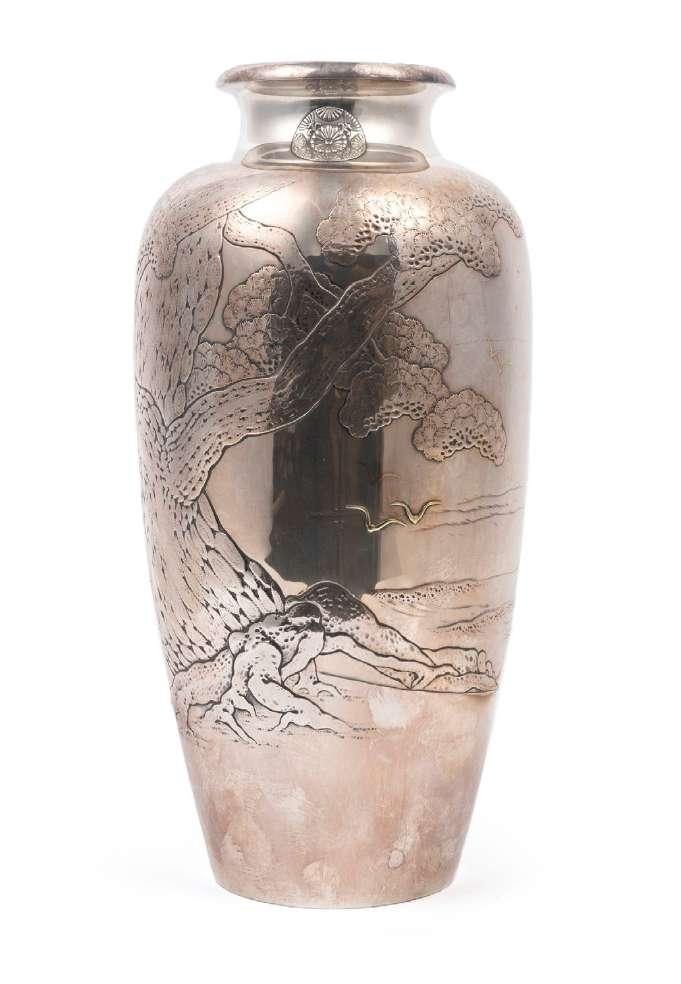
262
A LARGE SILVER VASE, Japan, Taisho Period (1912-1926)
h cm 34
€ 3.000 / 5.000
Of baluster form, depicting a sumptuous pine tree in high relief and finely chased. The front features the chrysanthemum, the imperial symbol. The vase is marked jungin (pure silver) on the base and signed kobayashi and yoshitsugu saku.
Weight g 1919.
GRANDE
VASO IN ARGENTO,
Giappone, periodo Taisho (1912-1926)
A forma di balaustro raffigurante un sontuoso pino lavorato a sbalzo e finemente cesellato. Il fronte mostra il mostra il crisantemo, simbolo imperiale. Il vaso è marcato Jungin (argento puro) sulla base e firmato Kobayashi e Yoshitsugu saku.
Peso g 1919.
A SHIBAYAMA BOX, Japan, Meiji period (1868-1912)
h cm 14 x l cm 11,5
€ 300 / 500
Of circular form, finely chased in the shape of a basket supported by three cylindrical feet, the body elegantly decorated with floral motifs in mother-ofpearl and hardstones, with a lacquered interior. The cover, echoing the decoration of the body, is surmounted by a chrysanthemum-shaped finial. Weight: 331 g.
SCATOLA SHIBAYAMA, Giappone, periodo Meiji (1868-1912)
Di forma circolare, finemente cesellato a guisa di cestino sorretto da tre piedi cilindrici, il corpo è elegantemente decorato con motivi floreali in madreperla e pietre dure, con interno laccato. Il coperchio, ornato con lo stesso motivo del corpo, è sormontato da una presa a forma di crisantemo. Peso g 331.
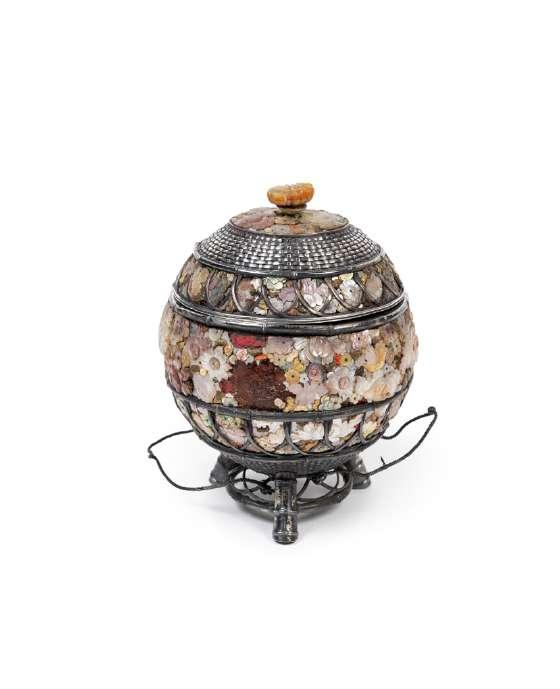
☼AN IVORY KODANSU IN THE FORM OF AN ELEPHANT, Japan, Meiji period (1868-1912)
l cm 26
€ 1.500 / 2.500
Resting on four feet, enriched with refined Shibayama inlay applications.
☼KODANSU IN AVORIO A FORMA DI ELEFANTE, Giappone, periodo Meiji (1868-1912)
Poggiante su quattro piedini, arricchito da raffinate applicazioni ad intarsio nella tecnica Shibayama.
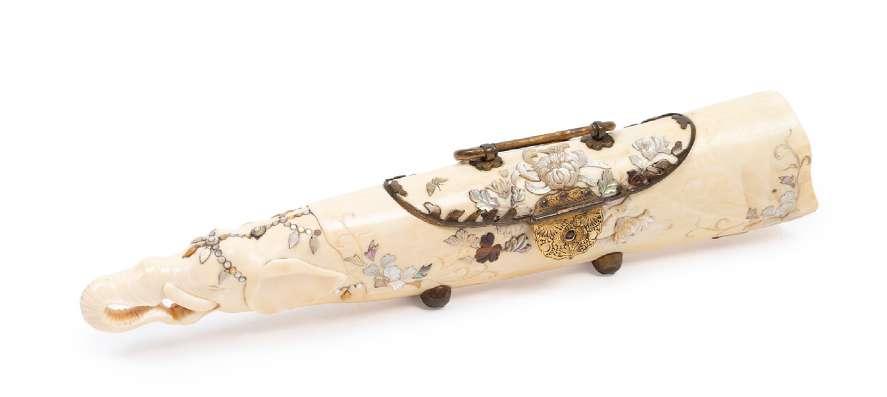

265
A GOLD-LACQUERED WOOD INCENSE TRAY (KOBON), Japan, Meiji period (1868-1912)
l cm 19,6 x w cm 15
€ 500 / 700
With hiramaki-e and shibayama inlays in mother-of-pearl and horn. The reverse in nashiji.
VASSOIO PER INCENSO (KOBON), Giappone, periodo Meiji (1868-1912)
In legno laccato oro con hiramaki-e con intarsi tecnica shibayama di madreperla e corno, retro in nashiji.

266
A RECTANGULAR MURA-NASHIJI
LACQUER TRAY, Japan, 18th century
l cm 19 x w cm 13,2
€ 150 / 200
Of rectangular form, decorated in relief with a scene of children playing in a mountainous landscape with pagodas.
VASSOIETTO IN LACCA MURA-NASHIJI, Giappone, XVIII secolo
Di forma rettangolare, decorato a rilievo con una scena di bambini che giocano in un paesaggio montano con pagode.
A RED LACQUER BOX,
Japan, Taisho Period (1912-1926)
€ 3.500 / 5.500
Decorated in circular hiramaki-e gold lacquer on a nashiji ground with floral and naturalistic motifs. With tomobako.
SCATOLA IN LACCA ROSSA
Giappone, periodo Taisho (1912-1926)
Decorata in lacca oro hiramakie circolare su fondo nashiji a motivi floreali e naturalistici. Con tomobako.
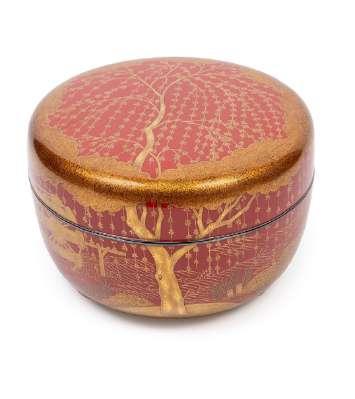
A CIRCULAR BOX IN RIMPA-STYLE LACQUER WITH KINJI GROUND, Japan, Meiji period (1868-1912)
h cm 13,5 x d cm 23 d cm 10
€ 800 / 1.200
Decorated in takamakie and enhanced with mother-ofpearl inlays. the interior is inscribed “Sho Kirin” with the seal “Rin” (after Ogata Kōrin, 1658–1716).
SCATOLA DI FORMA CIRCOLARE IN LACCA STILE RIMPA CON FONDO KINJI, Giappone, periodo Meiji (1868-1912)
Decorata in takamakie impreziosita da intarsi in madreperla. L’interno inscritto “Sho Kirin” con sigillo “Rin” (After Ogata Kōrin Ogata Kōrin (1658–1716).

SUZURIBAKO, Japan, Edo period, 19th century
h cm 4,5 x l cm 24 x w cm 22
€ 1.500 / 2.000
Provided with a tomobako, with rounded and indented corners, decorated in gold lacquer taka-makie and hira-makie with mother-of-pearl flakes, depicting a pair of Manchurian cranes on a nashiji lacquer ground.
SUZURIBAKO, Giappone, Periodo Edo, XIX secolo
Fornito di tomobako con angoli bombati e inflessi decorato in lacca oro taka-makie, hira-makie con scaglie di madreperla raffigurante una coppia di Gru della Manciuria con fondo in lacca nashiji.

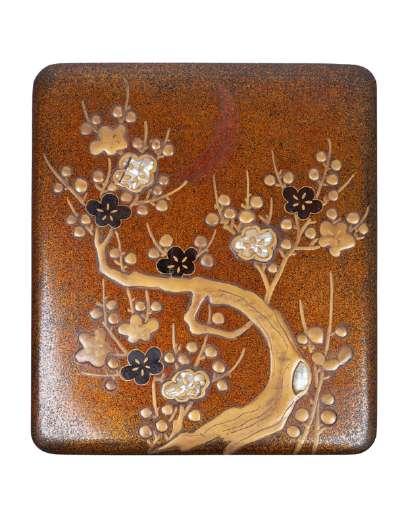
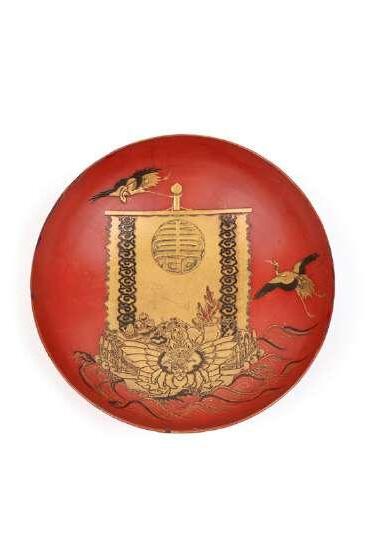
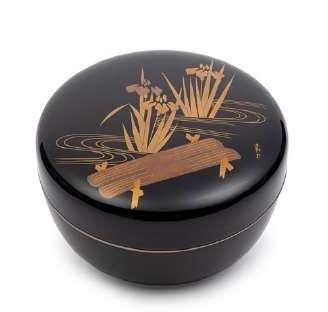
A MAKI-E LACQUER
SUZURIBAKO, Japan, Meiji period (1868-1912)
h cm 4 x l cm 24 x w 21
€ 800 / 1.200
Decorated on the lid with a blossoming plum branch beneath a crescent moon. the flowers, rendered in relief with mother-of-pearl inlays and gold lacquer, stand out against an iridescent nashiji ground. inside, the surface is decorated with a pine-needle motif on a nashiji background and houses the traditional suzuri (inkstone) and suiteki (water dropper).
SUZURIBAKO IN LACCA MAKI-E, Giappone, periodo Meiji (1868-1912)
Decorato sul coperchio con un ramo di prugno in fiore sotto una falce di luna. I fiori, resi in rilievo con intarsi di madreperla e lacca dorata, risaltano su uno sfondo iridescente di nashiji. All’interno, la superficie è decorata con un motivo ad aghi di pino su uno sfondo di nashiji e ospita il tradizionale suzuri (pietra per inchiostro) e il suiteki (contagocce).
A RED LACQUER STAND, Japan,
Meiji period (1868-1912)
h cm 8,5 x d cm 23
€ 400 / 600
Depicting a frontal view of a Takarabune sailing through turbulent waters and two Manchurian cranes in flight.
ALZATA IN LACCA ROSSA, Giappone, periodo Meiji (1868-1912)
Raffigurante un Takarabune visto frontalmente in navigazione tra acque tumultuose e due gru della Manciuria in volo.
A CIRCULAR BOX,
Japan, Showa period (mid-20th century)
h cm 10 x d cm 20
€ 400 / 600
Decorated on a black lacquer ground with a gilt design depicting irises at Yatsuhashi, a motif inspired by the famous screens by Ogata Korin. Signed Gyokuhō saku on the lid.
SCATOLA DI FORMA CIRCOLARE, Giappone, Periodo Showa (metà XX secolo)
Decorata su fondo in lacca nera con decoro dorato raffigurante iris a Yatsuhashi, motivo tratto dai celebri paraventi di Ogata Kirin. Firma Gyokuhō saku sul coperchio.
A PAIR OF BAMBOO STANDS WITH BONE INLAYS IN THE SHIBAYAMA TECHNIQUE, Japan, Meiji period (1868-1912)
h cm 47
€ 600 / 800
Depicting an engraved pair of samurai facing each other.
COPPIA DI BASI IN BAMBÙ CON INTARSI IN OSSO NELLA TECNICA SHIBAYAMA, Giappone, periodo Meiji (1868-1912)
Raffiguranti una coppia di samurai incisi che si fronteggiano.
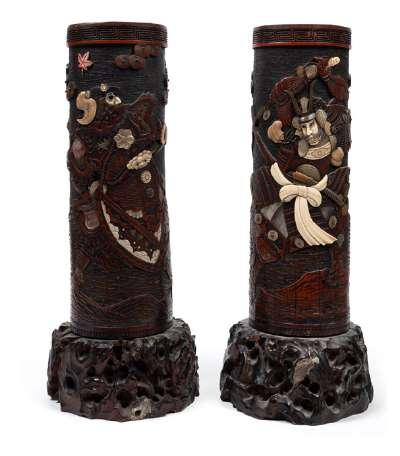
FIVE NETSUKE IN WOOD AND VEGETABLE IVORY AND ONE HORN SCULPTURE, Japan, Meiji period (1868-1912)
The larger h cm 6,5 x l cm 4
€ 450 / 500
CINQUE NETSUKE IN LEGNO E AVORIO VEGETALE E UNA SCULTURA IN CORNO, Giappone, periodo Meiji (1868-1912)
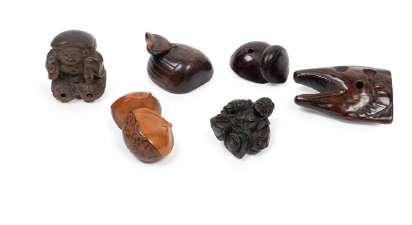
275
AN EROTIC INRŌ (SHUNGA) IN BONE AND FOUR NETSUKE, Japan, Meiji period (1868-1912)
The larger h cm 7,5 x l cm 6
€ 400 / 600
The inrō complete with netsuke and ojime; two netsuke in stag horn and two in polychrome ceramic.
UN INRŌ EROTICO (SHUNGA) IN OSSO E QUATTRO NETSUKE, Giappone, periodo Meiji (1868-1912)
L’inro completo di netsuke e ojime, due netsuke in corno di cervo e due netsuke in ceramica policroma.
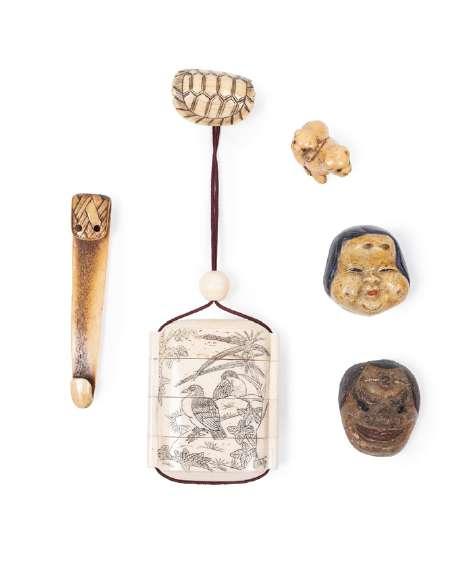
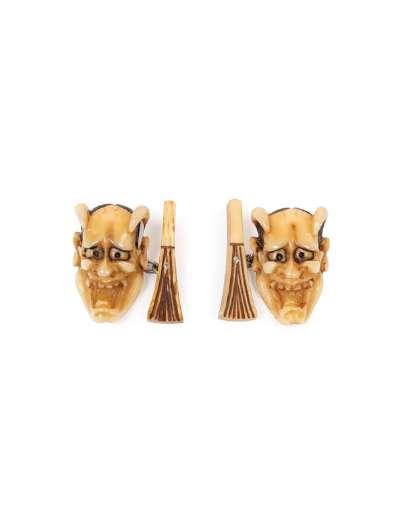
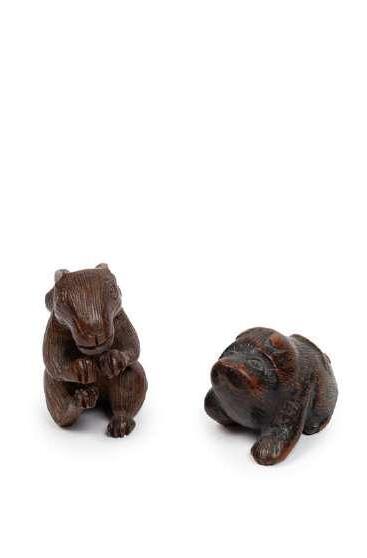
A PAIR OF MARINE IVORY CUFFLINKS DEPICTING HANNYA, Japan, Meiji period (1868-1912)
h cm 2,5 x l cm 1,5
€ 300 / 500
COPPIA DI GEMELLI IN AVORIO MARINO RAFFIGURANTI HANNYA, Giappone, periodo Meiji (1868-1912)
TWO WOODEN NETSUKE, Japan, 20th century
The larger h cm 4
€ 100 / 150
Depicting a rabbit and a boar.
DUE NETSUKE IN LEGNO, Giappone, XX secolo
Raffiguranti un coniglio e un cinghiale.

A BAMBOO AND SILVER PIPE WITH A FABRIC CASE, Japan, Meiji period (1868-1912)
l cm 25
€ 350 / 550
PIPA IN BAMBÙ E ARGENTO CON CUSTODIA IN TESSUTO, Giappone, periodo Meiji (1868-1912)
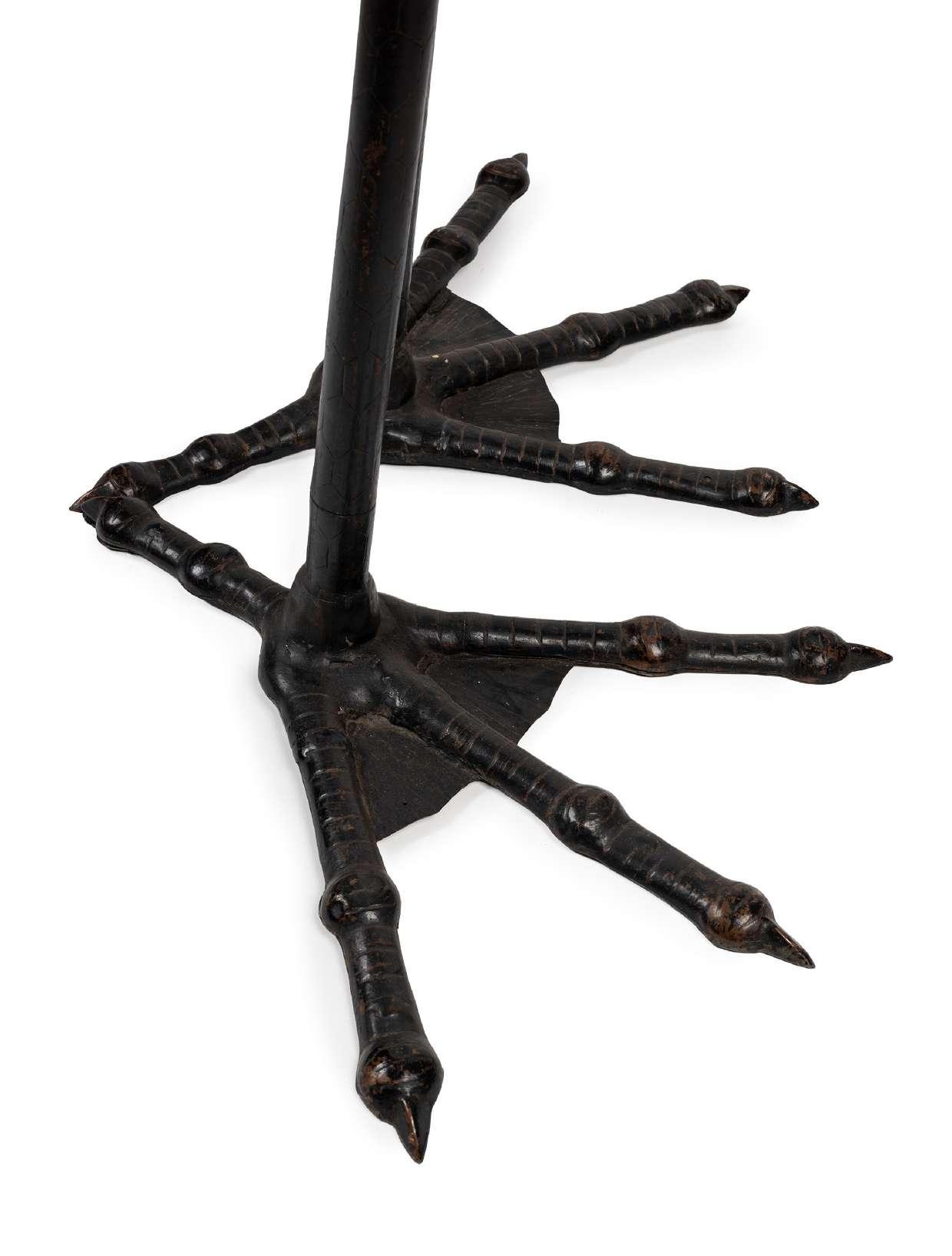
LARGE KUTANI BRONZE
AND PORCELAIN SCULPTURE OF A CRANE, Japan, Edo period, 19th century
h 153 cm
€ 15.000 / 25.000
The sculpture depicts a large crane, its body coated in a glossy white enamel, with the beak, head, and eyes glazed in a rich brown. The plumage of the neck and around the eyes is highlighted with a vibrant underglaze blue, while the finely modelled feathers in high relief transition from white to a delicate blue. The legs, meticulously rendered in bronze, terminate in large webbed feet.
GRANDE SCULTURA IN BRONZO E PORCELLANA KUTANI, Giappone, periodo Edo, XIX secolo
La scultura rappresenta una grande gru, con il corpo rivestito da uno smalto bianco lucido e dettagli del becco, della testa e degli occhi smaltati in un intenso marrone. Il piumaggio del collo e l’area intorno agli occhi presentano un brillante blu sotto coperta, mentre le piume, modellate a rilievo con straordinaria naturalità, sfumano dal bianco a un delicato azzurro. Le gambe finemente modellate in bronzo, terminano in grandi piedi palmati.
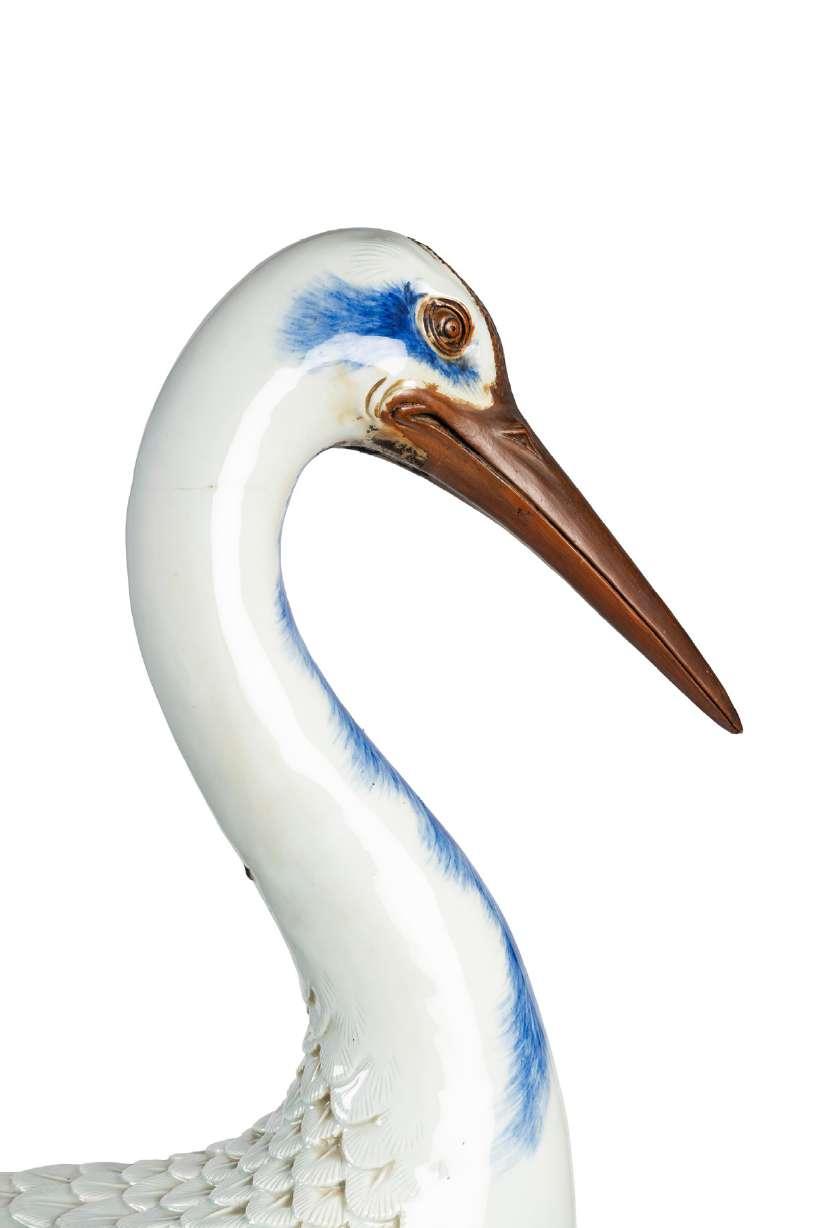

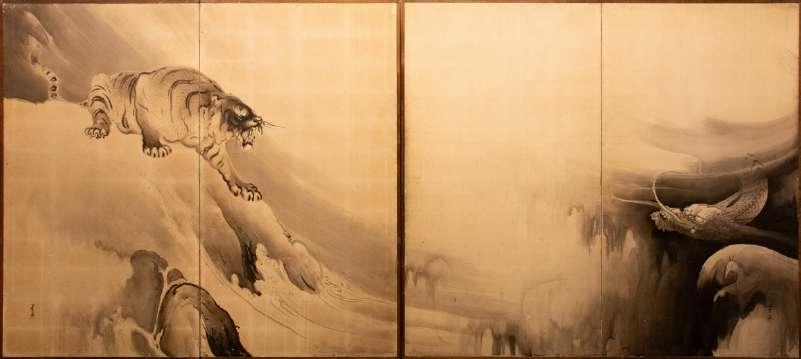
280
A PAIR OF TWO-PANELS SCREENS
Japan, Meiji period (1868-1912)
h cm 170,5 × l cm 377
€ 1.500 / 2.000
Depicting a dragon and a tiger facing each other. Both screens are signed and set in natural wood frames.
COPPIA DI PARAVENTI A DUE PANNELLI,
Giappone, periodo Meiji (1868-1912)
Dipinti su carta con inchiostro sumi-e, raffiguranti un drago e una tigre che si fronteggiano. Entrambi i paraventi sono firmati e la cornice è in legno naturale.
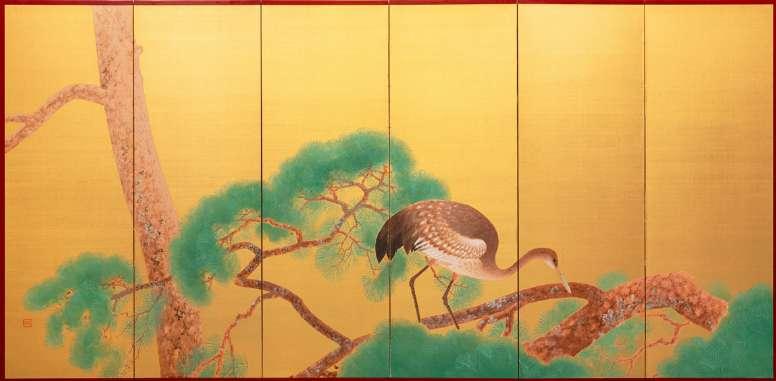
281
A SIX PANEL SCREEN,
Japan, Taishō period (1912–1926)
h cm 137,5 x l cm 278
€ 1.500 / 2.000
Painted on shimmering gold silk, depicting a Manchurian crane perched on a pine (matsu) branch. Red lacquer frame with high-quality metal fittings protecting the corners.
PARAVENTO A SEI PANNELLI,
Giappone, periodo Taishō (1912-1926)
Dipinto su seta dorata scintillante raffigurante una gru della Manciuria appollaiata su un ramo di pino Matsu. Cornice in lacca rossa e ferramenta di alta qualità a protezione degli spigoli.
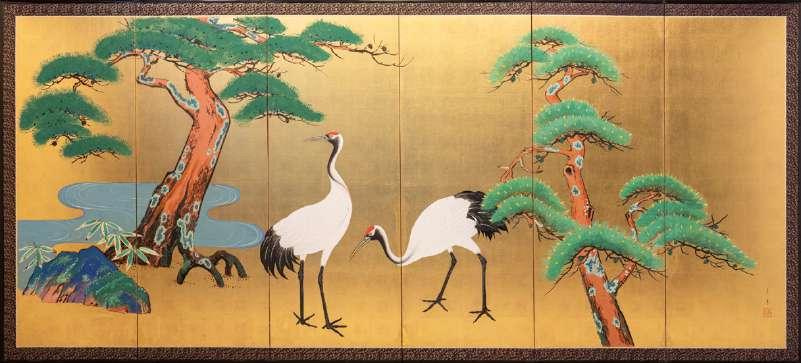
282
FOLDING SIX-PANEL SCREEN,
Japan, Meiji period (1868-1912)
h cm 172 x l cm 379,5
€ 1.000 / 1.200
Depicting a pair of Manchurian cranes and pine trees against a gold-leaf ground. The screen’s frame is finished in black lacquer.
PARAVENTO PIEGHEVOLE A SEI PANNELLI, Giappone, periodo Meiji (1868-1912)
Raffigurante una coppia di gru della Manciuria e pini su un fondo in foglia d’oro. La cornice del paravento è laccata nera.

283
A FOLDING SIX-PANEL SCREEN,
Japan, Edo period (1603-1868)
h cm 172 × l cm 378
€ 1.500 / 2.000
Depicting six dragons, one on each panel, painted on paper and mounted on a gold-leaf ground. Signed with seal. The screen’s frame is finished in black lacquer.
PARAVENTO PIEGHEVOLE A SEI PANNELLI, Giappone, periodo Edo (1603-1868)
Raffiguranti sei draghi uno per ogni pannello dipinti su carta incorniciati su fondo in foglia oro. Firmato con sigillo. La cornice del paravento è laccata nera.
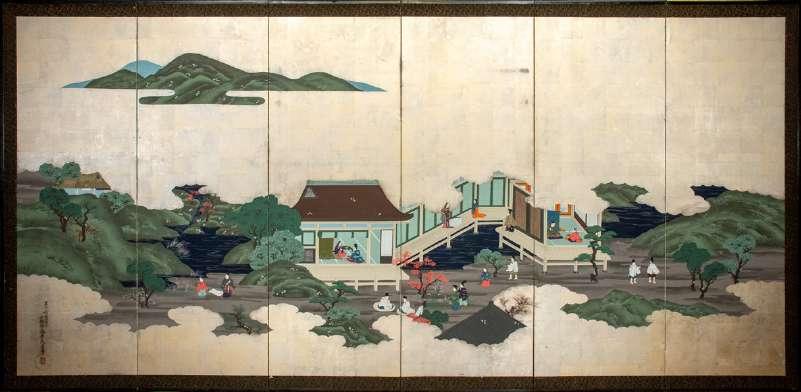
A FOLDING SIX-PANEL SCREEN,
Japan, Meiji period (1868-1912)
h cm 181 x l cm 388
on silver leaf depicting a scene from The Tale of Genji. Signed and sealed at the lower left. The screen’s frame is finished in black lacquer.
PARAVENTO PIEGHEVOLE A SEI PANNELLI, Giappone, periodo Meiji (1868-1912)
Su foglia argento raffigurante una scena tratta dai “Racconti di Genji”. Firma e sigillo in basso a sinistra. La cornice del paravento è laccata nera.
284 285 € 600 / 800
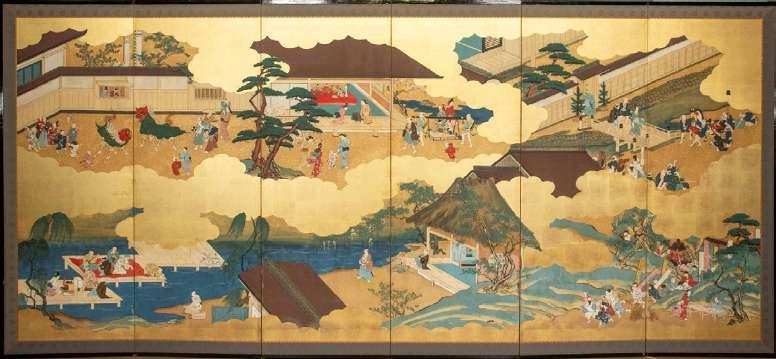
A SIX PANEL SCREEN,
Japan, Meiji period (1868-1912)
h cm 174 x l cm 379
€ 800 / 1.000
Depicting scenes of daily life separated by clouds against a gold-leaf ground. The screen’s frame is finished in black lacquer.
PARAVENTO A SEI PANNELLI, Giappone, periodo Meiji (1868-1912)
Raffigurante scene di vita quotidiana separate da nuvole su fondo in foglia d’oro. La cornice del paravento è laccata nera.
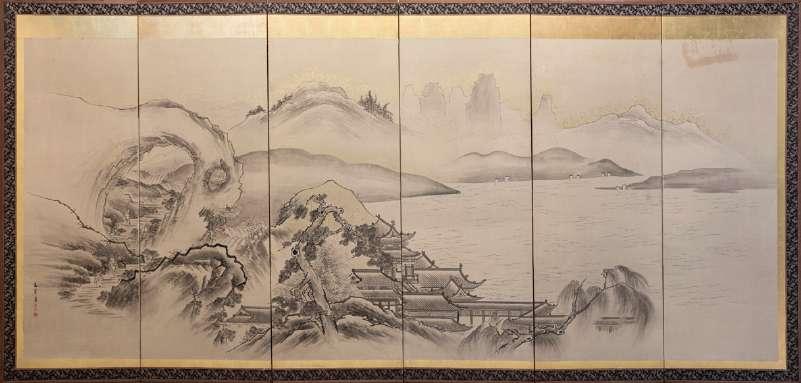
286
A FOLDING SIX-PANEL PAPER SCREEN,
Japan, Meiji period (1868-1912)
h cm 175 × l cm 365
€ 600 / 800
With gilt frame, depicting an elegant landscape executed in sumi-e ink. The screen’s frame is made of natural wood.
PARAVENTO PIEGHEVOLE IN CARTA A SEI PANNELLI, Giappone, periodo Meiji (1868-1912)
Con cornice dorata raffigurante un elegante paesaggio realizzato con inchiostro sumi-e. La cornice del paravento è in legno naturale.

287
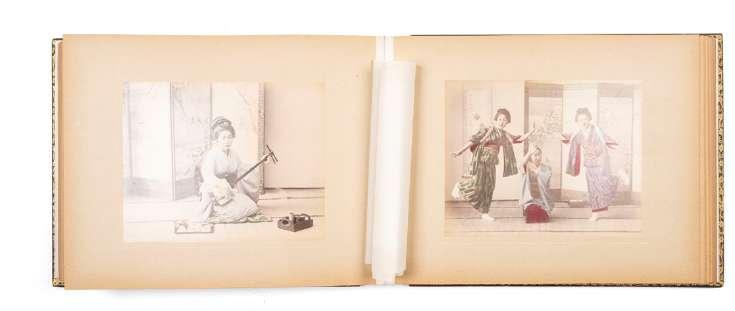
AN HAND-COLOURED PHOTOGRAPHIC ALBUM,
Japan, Meiji period (1868-1912)
l cm 41 x p cm 32,5
€ 200 / 300
With a red lacquer binding centred by a photograph and embellished with elegant floral decorations, the album comprises fifty-one hand-coloured photographic plates depicting landscapes and figures from Japanese tradition.
ALBUM FOTOGRAFICO ACQUARELLATO, Giappone, XX secolo
Con rilegatura in lacca rossa centrata da una fotografia e impreziosita da eleganti decori floreali, l’album comprende cinquantuno tavole fotografiche acquerellate raffiguranti paesaggi e figure della tradizione giapponese.
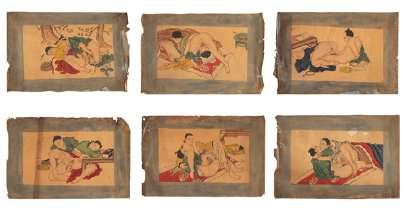
SIX SCROLL PAINTINGS ON PAPER, Japan, early 20th century
h cm 90 x l cm 57
€ 300 / 500
Depicting various erotic scenes.
SEI DIPINTI A SCROLL SU CARTA, Giappone, inizio XX secolo
Raffiguranti varie scene erotiche.

A
PAIR OF UKUYO-E WOODBLOCKS, Japan, Meiji period (1868-1912)
h cm 36,5 x l 24,5 ca.
€ 150 / 200
Titled: “Actors Iwai Kumesaburô III as Jirô Kanja and Azuma Ichinojô I as Sugibae”, by Utagawa Kunisada.
COPPIA DI INCISIONI UKUYO-E, Giappone, periodo Meiji (1868-1912)
Intitolata “Gli attori Iwai Kumesaburô III nel ruolo di Jirô Kanja e Azuma Ichinojô I nel ruolo di Sugibae”, di Utagawa Kunisada.
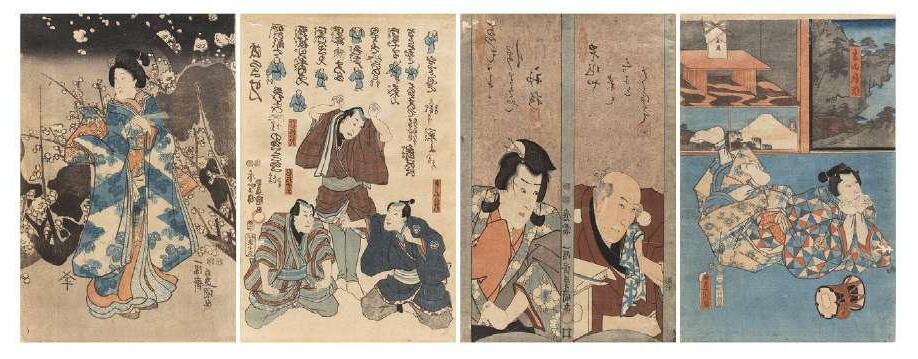
FOUR UKUYO-E WOODBLOCKS, Japan, Meiji period (1868-1912)
h cm 36 x l cm 25 ca.
€ 150 / 250
Four by Utagawa Kunisada: two from the series ‘From the Noh Theater,’ including ‘Morita Kan’ya XI as Shiratayu and Ichimura Uzaemon XII as Sakuramaru’; one entitled ‘A Demonstration of the Game of Ken’.
QUATTRO INCISIONI DI SCUOLA UKUYO-E, Giappone, periodo Meiji (1868-1912)
Di Utagawa Kunisada: due dalle serie “Del teatro del Noh”, tra le quali “Morita Kan’ya XI come Shiratayu e Ichimura Uzaemon XII come Sakuramaru; una intitolata “Una dimostrazione del gioco del ‘ken”.

291
FIVE
UKUYO-E
WOODBLOCKS,
Japan, Meiji period (1868-1912)
h cm 36,5 x l 24,5 ca.
€ 200 / 250
By the master Utagawa Kunisada, from the series ‘Of the Nō Theatre’ and ‘Warriors’.
CINQUE INCISIONI DI SCUOLA UKUYO-E, Giappone, periodo Meiji (1868-1912)
Del maestro Utagawa Kunisada, dalle serie degli “Del teatro del Noh” e dei “Guerrieri”.

292
FOUR UKUYO-E WOODBLOCKS, Japan, Meiji period (1868-1912)
h cm 36,5 x l 24,5 ca.
€ 200 / 250
One from the ‘Courtesan and Riddle’ series by Keisai Eisen; four by Utagawa Kuniyoshi: entitled ‘Nambyō Ryōji,’ ‘Lion Dancer,’ ‘Nakamura Shikan’ from the series ‘No Hana Goninotoko,’ and one from the series ‘Three Naked Men Fighting Over a Hanging Scroll on a Beach.
CINQUE INCISIONI UKUYO-E, Giappone, periodo Meiji (1868-1912)
Una dalla serie “Courtesan and Riddle” di Keisai Eisen; quattro di Utagawa Kuniyoshi: intitolate “Nambyō Ryōji” “Lion Dancer”, “Nakamura Shikan” dalla serie “no hana goninotoko” e una dalla serie “Three Naked Men Fighting Over a Hanging Scroll on a Beach”.
A PAINTING ON PAPER, Japan, Meiji period (1868-1912)
h cm 67 x l cm 49
€ 200 / 300
Well painted with a naturalistic scene depicting a monkey clinging to a cherry tree while gazing at a bird in flight; signed on the right side.
DIPINTO SU CARTA, Giappone, periodo Meiji (1868-1912)
Ben dipinto con una scena naturalistica raffigurante una scimmia aggrappata a un albero di ciliegio mentre osserva un uccellino in volo; firmato sul lato destro.



South East Asian

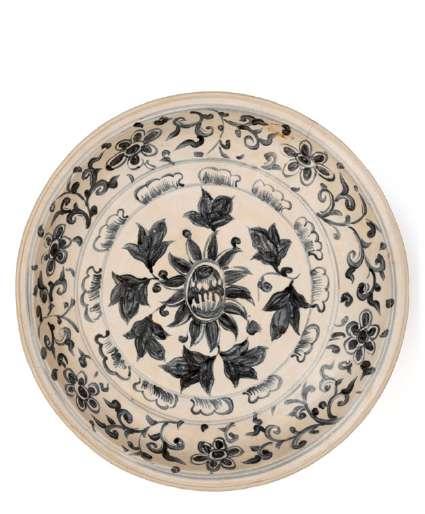
294
FIVE PORCELAIN SMALL JARS,
Indochina, 18th / 19th century
The larger d cm 10,5
295 € 500 / 700
Four decorated in underglaze blue with flowers and animals; one monochrome covered with a brown glaze.
Provenance: Private collection, Tuscany.
CINQUE PICCOLE GIARE IN PORCELLANA, Indocina,
XVIII / XIX secolo
Quattro decorate in blu sotto coperta con fiori e animali, una monocroma ricoperta da uno smalto marrone.
Provenienza: collezione privata, Toscana.
18/19世纪 五个小瓷罐
A LARGE BLUE AND WHITE PORCELAIN DISH,
Vietnam, Lê dynasty (1428-1788)
d cm 37
€ 300 / 500
Well painted on the interior with a scroll of flowers and leaves, and on the exterior with a band of stylized petals.
Provenance: Private collection, Tuscany.
GRANDE
PIATTO IN PORCELLANA BIANCA E BLU, Vietnam, dinastia Lê (1428-1788)
“Ben dipinto all’interno con uno scroll di fiori e foglie mentre all’esterno con una fascia di petali stilizzati.
Provenienza: collezione privata, Toscana.
青花盘 越南 黎王朝(1428-1788)
A BRASS SCULPTURE OF JINA PARSVANATHA,
India, 16th century
h cm 20,5
€ 1.200 / 1.500
Depicting the standing Jina Parshvanatha, shown with the traditional seven-headed cobra behind him, forming a canopy.
SCULTURA IN OTTONE, India, XVI secolo
Raffigurante Jina Parsvanatha stante, raffigurato con il tradizionale cobra a sette teste alle sue spalle che forma un baldacchino.
297
SIX
BRONZE
SCULPTURES,
India, 19th century
The larger h cm 23,5
€ 500 / 700
Depicting two hands of the Buddha, two representations of Vishnu, one Guanyin, and one Jina Parsvanatha.
SEI SCULTURE IN BRONZO, India, XIX secolo
Raffiguranti due mani del Buddha, due rappresentazioni di Vishnu, una Guanyin e un Jina Parsvanatha.
298
THREE BRONZE SCULPTURES,
India, 19th / 20th century
The larger h cm 29
€ 600 / 800
Depicting Vishnu, Ganesha, and Mahavira.
TRE SCULTURE IN BRONZO, India, XIX / XX secolo
Raffiguranti Vishu, Ganesha e Mahavira.
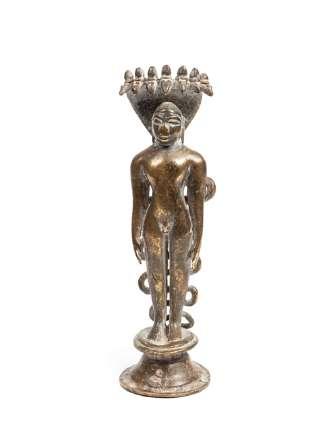
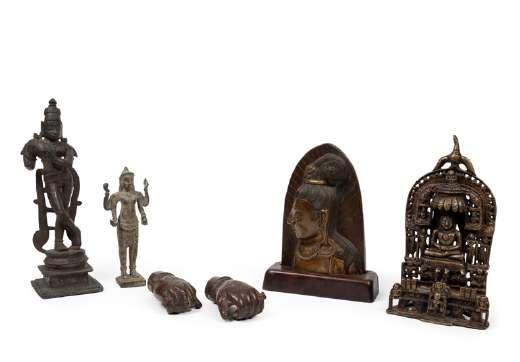
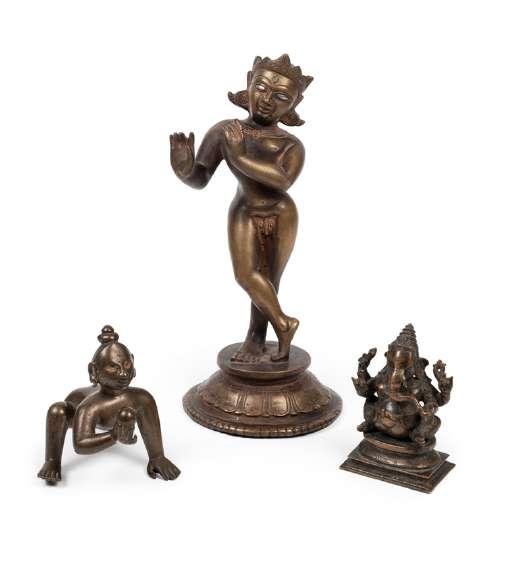
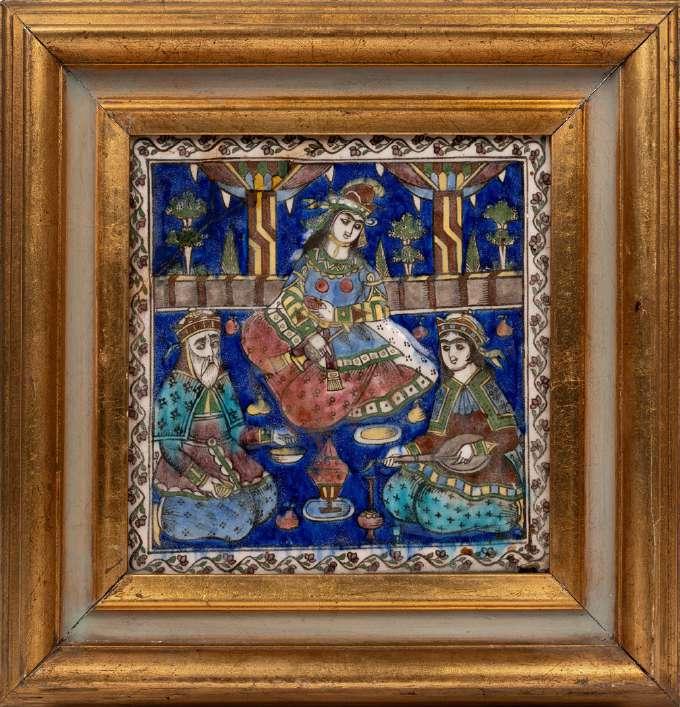
299
A MOULDED QAJAR FAÏENCE TILE,
Iran, Qajar, early 20th century
h cm 22,5 x l cm 22,5
€ 400 / 600
Of square form, moulded and painted in black (for the outlines), cobalt blue, turquoise, copper green, ochre yellow, and manganese purple. The scene portrays a banquet with three figures in relief seated on the ground: an elderly bearded man holding a cup, a young musician playing a sitar or Persian lute, and a richly dressed female figure wearing a long decorated gown, a tunic with multicoloured sleeves and ornamental appliqués, and an elaborate headdress reminiscent of pre-Islamic Persian styles. She holds a globular flask and a small cup, as if pouring a drink for herself and her companions. The floor is scattered with small fruit, possibly quinces or pears, pieces of tableware, and a central cup with a pyramidal lid. In the background, two polychrome columns with flared capitals, draped with wide curtains, frame a lush garden, suggesting that the scene is taking place in an open pavilion within a Persian bāgh. Particularly noteworthy are the details (such as the lady’s headdress, the architectural elements and the tableware) reflecting an engagement with pre-Islamic Persian motifs, in keeping with the Achaemenid Revival style characteristic of the Qajar period.
MATTONELLA IN FAENZA SILICEO MODELLATA E DIPINTA, Iran, Qajar,
inizio XX secolo
Di forma quadrata, con superficie modellata e decorazione policroma dipinta sotto vetrina nei toni del nero (per i contorni), blu cobalto, turchese, verde rame, giallo ocra e viola manganese. La scena raffigura un banchetto con tre personaggi in rilievo seduti al suolo. I due personaggi in primo piano, un uomo anziano barbuto e un giovane imberbe, indossano pantaloni decorati, tunica, corta mantella e copricapo. L’uomo anziano regge una piccola coppa, mentre il giovane è intento a suonare un sitar o liuto persiano. La composizione è dominata al centro da una figura femminile riccamente abbigliata, con lunga veste decorata e un’elaborata tunica dalle maniche policrome e applicazioni ornamentali. Indossa un copricapo complesso, reminiscente della tradizione persiana pre-islamica. Tiene in mano una fiasca dal corpo globulare e collo allungato, insieme a una piccola coppa, suggerendo che stia mescendo una bevanda per sé e per i suoi commensali. Il pavimento è disseminato di piccoli frutti (forse mele cotogne o pere), vasellame e, al centro, una curiosa coppa con coperchio piramidale. Sullo sfondo, due pilastri policromi con capitelli svasati, avvolti da ampi tendaggi, incorniciano un giardino rigoglioso, suggerendo che la scena si svolga in un padiglione all’aperto, in un giardino persiano (bāgh). Degni di nota in questa composizione sono gli elementi iconografici, ravvisabili nel copricapo della figura femminile, nei dettagli architettonici e nel vasellame, che rimandano alla tradizione persiana pre-islamica, in linea con il cosiddetto stile Achaemenid revival tipico del periodo Qajar.

A MOULDED QAJAR FAÏENCE TILE, Iran, Qajar, late 19th / early 20th century
h cm 33,5 x l cm 23,5
300 € 200 / 300
Of rectangular form, moulded and painted underglaze in black (for the outlines), turquoise, copper green, and ochre yellow. The harmonious palette and delicate, naturalistic brushwork make this a particularly fine example of its kind. The convivial scene depicts three male figures in relief, seated on the ground. The central figure, wearing a long robe and bareheaded, is shown pouring, or having just poured, a drink from a long-necked flask into the cups held by his two companions. The floor is strewn with small fruits, possibly quinces or pears, pieces of tableware, and at the centre, a tall, slender-necked vase. In the background, a lush setting filled with flowers and plants, framed by an architectural structure and topped with a copper-green curtain, suggests that the scene takes place in an open pavilion within a garden. The banquet-in-the-garden theme is a cherished subject in Persian and Islamic art, evoking the courtly pastimes of the elite and inspired by the ideal of the Persian garden (bāgh), conceived since antiquity as a vision of paradise on earth.
MATTONELLA QAJAR IN FAENZA SILICEO MODELLATA E DIPINTA, Iran, Qajar, fine XIX / inizio XX secolo
Di forma rettangolare, con superficie modellata e decorazione policroma dipinta sotto vetrina nei toni del nero (per i contorni), turchese, verde rame e giallo ocra. La gamma cromatica equilibrata e la resa pittorica, dal tratto fine e naturalistico, ne fanno un esempio di particolare pregio all’interno di questa produzione. La scena, di carattere conviviale, presenta tre personaggi maschili in rilievo seduti al suolo. Il personaggio centrale, in lunga tunica e privo di copricapo, versa o ha appena versato una bevanda da una fiasca a collo lungo nelle coppe tenute dagli altri due commensali. Il pavimento è disseminato di piccoli frutti (forse mele cotogne o pere), vasellame e, al centro, un grande vaso a collo slanciato. Sullo sfondo, un ambiente ricco di fiori e piante, incorniciato da una struttura architettonica e sormontato da un tendaggio verde rame, suggerisce che la scena si svolga in un padiglione all’aperto, in un giardino. Il soggetto del banchetto nel giardino è un tema iconografico caro all’arte persiana e islamica, allusivo ai passatempi cortesi dell’élite e ispirato all’ideale del giardino persiano (bāgh), concepito come simbolo paradisiaco fin dal VI secolo a.C.
2 DECEMBER 2025

By my signature below, I hereby declare that I have read, fully understand and unconditionally accept, in their entirety and without reservation, the contractual terms and conditions contained in Clauses 1 through 29 (inclusive) of the General Conditions, and agree to be bound thereby.
Absent and telephone biddings
If it is not possible to be present at the auction, Marcopolo s.r.l. may bid on your behalf for the purchase of the lots.
To access this service, which is completely free of charge, you will have to submit the appropriate form that you will find on the website, at the bottom of the catalogue or at our offices with a photocopy of an identity document attached.
Lots will eventually be purchased at the lowest price made possible by the other bids in the room.
In case of bids of the same amount on the same lot, the one received first will take precedence.
Marcopolo s.r.l. also offers its customers the possibility of being contacted by telephone during the auction to bid on the lots offered. It will be sufficient to submit a written request which must be received by 10.00 a.m. on the day of the sale, without prejudice to Marcopolo s.r.l.’s right to request, at its discretion, a deposit for the potential client’s qualification to bid in the auction, which must be received within 3 working days before the date of the sale; Marcopolo s.r.l. therefore invites any potential client to contact the auction house within a reasonable time in order to ensure that no constraints on bidding exist on the lots of his/her interest.
This service will be provided within the limits of line availability at the time and in order of receipt of requests. For bids on lots in which bidders wish to make use of the telephone bidding service, the customer unconditionally accepts from the moment of his or her bidding request for the lot itself the base auction value, and more precisely the first of the two prices indicated in the catalogue and on the website. In the event that no other bids are received during the auction, the lots will be awarded to the person/entity that requested the service even if that person/entity did not confirm their bid by telephone during the auction. Marcopolo is not responsible for any technical problems that may prevent or limit the telephone bidding service during the auctions (see point 9 in General Conditions).
Offerte scritte e telefoniche
Nel caso non sia possibile presenziare all’asta, Marcopolo s.r.l. potrà concorrere per Vostro conto all’acquisto dei lotti.
Per accedere a questo servizio, del tutto gratuito, dovrete inoltrare l’apposito modulo che troverete sul sito, in fondo al catalogo o presso i nostri uffici con allegato la fotocopia di un documento d’identità.
I lotti saranno eventualmente acquistati al minor prezzo reso possibile dalle altre offerte in sala.
In caso di offerte dello stesso importo sullo stesso lotto, avrà precedenza quella ricevuta per prima.
La Marcopolo s.r.l. offre inoltre ai propri clienti la possibilità di essere contattati telefonicamente dur ante l’asta per concorrere all’acquisto dei lotti proposti. Sarà sufficiente inoltrare richiesta scritta che dovrà pervenire entro le ore 10 del giorno di vendita, fatto salvo la facoltà della Marcopolo s.r.l. di richiedere, a sua discrezione, un deposito cauzionale per l’abilitazione del potenziale cliente ad offrire in asta, che dovrà essere ricevuto entro 3 giorni lavorativi prima della data della vendita; la Marcopolo s.r.l. invita pertanto qualsiasi potenziale cliente a mettersi in contatto in un tempo ragionevole con la casa d’aste per assicurarsi che sui lotti di suo interesse non esista alcun vincolo per la presentazione delle offerte. Questo servizio sarà garantito nei limiti della disponibilità delle linee al momento ed in ordine di ricevimento delle richieste. Per le offerte sui lotti in cui gli offerenti desiderano avvalersi del servizio di offerta telefonica, il cliente accetta incondizionatamente dal momento della sua richiesta di offerta per il lotto stesso il valore base d’asta, e più precisamente il primo dei due prezzi indicati nel catalogo e sul sito web. Nel caso in cui non pervengano altre offerte durante l’asta, i lotti saranno aggiudicati alla persona/ente che ha richiesto il servizio anche se questa non ha confermato telefonicamente la propria offerta durante l’asta. Marcopolo non è responsabile di eventuali problemi tecnici che possano impedire o limitare il servizio di offerta telefonica durante le aste (vedere punto 9 in Condizioni generali)
如果无法出席拍卖会,Marcopolo s.r.l.可以代表您出价购买拍品。
要获得这项完全免费的服务,你必须提交相应的表格,你可以在网站上、目录的底部或在我们的办公室找到, 并附上一份身份文件的复印件。
拍品最终将以房间内其他竞标者可能的最低价格购买。
如果同一件拍品有相同金额的出价,先收到的出价将被优先考虑。
Marcopolo
s.r.l.还为其客户提供了在拍卖期间通过电话联系对所提供的拍品进行竞拍的可能性。在不影响 Marcopolo s.r.l.公司酌情要求潜在客户在拍卖会上交纳保证金的权利的情况下,提交书面申请即可,该申请 必须在拍卖日期前3个工作日内收到;因此,Marcopolo s.r.l.公司邀请任何潜在客户在合理时间内与拍卖行联 系,以确保对其感兴趣的拍品不存在竞标限制。
这项服务将在收到请求时的线路可用性范围内按顺序提供。對於競投人希望使用電話競投服務的拍賣品,客戶 從他/她對拍賣品本身提出競投要求的那一刻起,就無條件地接受基本拍賣價值,更準確地說是接受目錄和網 站中所顯示的兩個價格中的第一個。如果在拍卖过程中没有收到其他出价,拍品将被授予要求提供服务的个 人/实体,即使该个人/实体在拍卖过程中没有通过电话确认其出价。Marcopolo不对拍卖期间可能阻止或限制 电话竞标服务的任何技术问题负责。
General conditions
1. These general terms of sale are aimed at buyers and suppliers of Marcopolo s.r.l. (hereinafter referred to as Marcopolo); these terms are available in the Auction Room, listed in the catalog relating to each auction and published on the auction house’s official website www.marcopoloauctions.com/ under the following URL: https://www.marcopoloauctions.com/uk/purchases-and-sales/condizionigenerali.asp . Taking part in auctions implies full acceptance of these terms, without any exceptions or reserves. Buyers and sellers are required, if requested, to sign these terms prior to entering into any contractual commitments.
2. Nature of the agreement: Marcopolo s.r.l. operates in the name and on behalf of the legitimate owners of items offered at auctions: it does not oblige nor acquire rights in its own right and the effects of the agreement occur directly between the buyer and seller. Marcopolo does not assume any obligation or liability other than those deriving from its status as agent and with the reservations and clarifications set out below in respect of sellers, buyers or third parties.
3. Sellers’ identity: Marcopolo protects the confidentiality of sellers’ identity and personal data; it is not obliged to provide this information to successful bidders, except in cases where a dispute concerning the purchased item arises. This without prejudice to the possibility of processing personal data for the purposes in the context of Anti-Money Laundering.
4. Warranties: Marcopolo makes no warranty regarding the attribution, authenticity or provenance of the items offered for sale; the consignor is the sole party liable. Accordingly, the buyer agrees to purchase the item as is and hereby waives any claim or dispute relating to inspections, analyses or further investigations beyond those carried out or ordinarily feasible with the means and information provided by the auction house. The buyer releases the auction house from all liability and acknowledges the consignor as the only responsible party. The consignor assumes all warranties and liabilities relating to the item, including, but not limited to, title, provenance, condition and marketability of the goods consigned for sale.
5. Estimates: The estimates provided in the catalog are expressed in euros, serve solely as an indication, may be modified at any time, and are not suitable to generate any form of prediction regarding the final hammer price.
6. Description and display of items: Presentation, descriptions and photographs of items contained in the auction catalog and on the portal www.marcopoloauctions.com, despite being expressions of the best knowledge and skills of experts appointed by Marcopolo’s, their sole purpose is to identify lots. Under no circumstances shall any incompleteness or errors in descriptions or, in particular, the failure to identify defects or imperfections (such as: breakages, restorations, deficiencies or substitutions), constitute grounds for claims or disputes subsequent to the sale. In order to allow buyers to examine each individual lot and to personally verify its properties, each auction is preceded by an exhibition open to the public for at least two consecutive days, according to the times shown on-site and published on the auction house’s official website www.marcopoloauctions.com and in accordance with any limitations imposed by the Authorities on health protection. The exhibition is therefore intended to allow the examination of the condition and quality of the items, as well as to clarify any errors or inaccuracies in the catalog. The buyer undertakes to examine the lot prior to purchase to verify its conformity with the catalog descriptions and, if necessary, to seek the opinion of a trusted expert to confirm its authenticity, provenance, attribution, date, age, cultural origin, and condition. Prior to the launch of an auction, the Sales Manager will be available to provide any useful explanations regarding items which, upon agreement with Marcopolo, can be examined by any means of investigation that do not cause damage to them and that do not affect the possibility of being examined by other interested parties. Buyers who make one or more bids without a prior personal inspection of the lot, but bid based only on photographs, the catalogue description and the form published on the website www.marcopoloauctions.com, do so at their own risk. It must be understood that, unless otherwise specified, all items sold at auction are used and in such conditions as sold, with all possible defects and imperfections that may arise, such as breakages, restorations, deficiencies or substitutions. Therefore, following a purchase during auction, claims are not admissible based on the state of conservation, classification, description, dating, attribution of purchased items, or due to defects, even if hidden, except for cases of malicious or intentional concealment by a seller. Antiques by their very nature may present restorations or modifications, such interventions can in no case be considered as hidden or latent defects. The state of mechanical operation of items is not guaranteed by the auction house and buyers purchase them at their own risk, without reserves and waiving all exceptions.
7. Licenses, authorizations and permissions: Sellers and buyers are required to strictly comply with the law, including international laws, governing the sale, purchase and holding of items placed at auction. In order to respect of l. 150/92 and subsequent amendments and additions, objects featuring parts or components made of ivory, as well as of species protected by the CITES convention, are provided with a certificate attesting the production and the manufacturing before 1947. Marcopolo’s, its agents
or its staff cannot be held liable for any damages incurred by buyers due to the import of goods which are prohibited or limited by their country of origin.
8. Restrictions on the circulation of certain goods: Buyers are required to comply with all applicable laws and regulations regarding items subject to notification, with particular reference to Legislative Decree No. 42/2004. This legislation governs the export of Cultural Goods outside the territory of the Italian Republic, while exports outside the European Community are additionally subject to the provisions of EC Regulation No. 116/2009 of December 18, 2008. The export of items is regulated by the aforementioned legislation as well as current customs and tax laws. Under no circumstances can Marcopolo be held responsible for the failure to obtain a certificate of free circulation for a given item, for restrictions arising from the notification of a declaration of cultural interest, or for the exercise of the right of preemption on behalf of the Italian State. Marcopolo therefore disclaims all liability towards buyers in relation to any export restrictions on awarded lots. The failure to obtain the aforementioned authorizations cannot justify the cancellation of the purchase or non-payment.
9. Registration of auction participants: In order to ensure that the existing provisions in the context of Anti-Money Laundering are fulfilled, anyone interested in taking part in the auction must register, providing Marcopolo with the information and documents deemed necessary to identify them, including: residence, shipping address, email, telephone number, copy of a valid identity card or passport, tax code, VAT reg. number and bank account details. At the Auction House’s discretion, a security deposit and additional information or references may be requested from buyers. The above documentation can also be sent by email to the following address info@marcopoloauctions. com. Data sent will be processed in compliance with EU Regulation 2016/679 (GDPR). Customers will be required to send updated documentation if documents expire. Registered users will be issued a personal identification number or code which is necessary for submitting bids. Please note that for security purposes, Marcopolo’s premises are subject to video recording. Telephone calls e.g. telephone bidding may also be recorded.
10. Taking part in auctions: Taking part in an auction is possible by making bids in the room, depositing or submitting written bids or by telephone or on-line communications. Written bids received before the opening of the tender must contain clear information on the lot and the price offered. Written bids shall be made at the minimum possible price with reference to other bids and at the reserve price. The purchase of lots by a person to be appointed or the transfer to third parties of lots won is not permitted.
11. Telephone bidding service: Marcopolo offers its customers a telephone bidding service. Customers who wish to be phoned during auctions to a previously notified telephone number previously for one or more lots of interest, can request this in writing by email at info@marcopoloauctions.com, or by filling in the Bid sheets included in each Marcopolo’s catalogue or which can be downloaded from the website at www.marcopoloauctions.com. For bidding on lots where bidders wish to make use of the telephone bidding service, the customer unconditionally accepts from the moment of his request to bid for the lot itself the basic auction value, and more precisely the first of the two prices indicated in the catalogue and on the website. In the event that no other bid is received during the auction, lots will be awarded to the person/entity that requested the service even if the latter has not confirmed their bid by telephone during the auction. Marcopolo reserves the right to record telephone bids and assumes no responsibility for any technical issues that may prevent or limit the telephone bidding service during auctions.
12. Bids through web applets or third-party platforms: It is possible to submit bids, after registering and entering personal data, also through the website www.marcopoloauctions.com and the relevant web applet or by means of third-party web platforms. Bids submitted as above imply the unconditional acceptance of these general terms. Users who take part in auctions through the web applet of the website www.marcopoloauctions.com or third-party platforms are aware that during the auction about 100 lots are auctioned per hour: therefore, the correspondence of data on bids shown by the web applet of Marcopolo or by third-party web platforms with any increasing offers made in the Room cannot be guaranteed, with the consequence that the latter may be higher and prevail. The Sales Manager present in the room is the only party entitled to ratify rising bids during auctions.
13. Use of the website and telephone and on-line services: The use of the www.marcopoloauctions. com website is free and takes place at the user’s risk. Marcopolo, its agents or staff cannot be held liable for damages or inconveniences due to problems related to the use of the website www. marcopoloauctions.com nor due to technical problems related to telephone lines or internet connection, or for the non-execution of bids submitted by telephone or on-line. It is forbidden for users of the website www.marcopoloauctions.com to use the site itself and the relevant services for illicit or purposes contrary to these contractual terms. Marcopolo reserves the right to exclude, at its sole discretion, any user from accessing the website www.marcopoloauctions.com and relevant services. All equipment made available by Marcopolo on the website www.marcopoloauctions.com and by means of the relevant services (including: texts, graphics, photographs, advertising images, etc.), is protected, even criminally, by the current Italian copyright law. Marcopolo cannot be held
liable in any case for issues and damages suffered by customers due to links to third-party sites on the www.marcopoloauctions.com platform or for damages deriving from the use of third-party platforms.
14. Exclusion from auctions: The Sales Manager, at his sole discretion, has the right to exclude from participation in the auction persons who may disrupt its normal exercise as, by way of example but not limited to the following: parties who interfere, who trade in the room, who are late in making payments, regardless of the reason, due to Marcopolo or that have a dispute open both in court and out of court, or those who have been convicted of crimes concerning trade or patrimony.
15. Auction mode: Individual lots are sold to the highest bidder, for cash and in Euro. Bids on the increase during the bidding process cannot be less than 5% of the previous bid. Any purchase offers for a price lower than the auction’s reserve price (which, if not further specified, shall never be lower than the minimum bid price), may be considered only outside the auction and after that, at the sole discretion of Marcopolo and prior written consent of the seller or owner. Lots are awarded by the Sales Manager who ratifies their award. Disputes regarding the priority or timeliness of bids are decided on the spot, at the Sales Manager’s discretion. In the event that two winning bids are equivalent, the assignment of the lot to one of the two bids is at the Sales Manager’s discretion. In all cases of dispute, it remains understood that the Director of Sales may cancel disputed transactions and repeat an auction, in the same auction session or in the one immediately following it, for a starting price equal to the highest bid received in the room or in writing and not disputed.
16. Changes to lots: The Sales Manager has the right to withdraw lots from the auction, change the order of lots, merge multiple lots among those for sale, or divide items already catalogued as single lot into several lots, establishing new prices generated by these initiatives.
17. Auction fees and ancillary charges: Auction fees, equal to 28% (twenty eight percent) of the price reached at auction or expressed in the written purchase bid, VAT included, must be added to the purchase price that results from the event. In addition, any additional tax and / or ancillary charges shall be borne by the purchaser. Any duty, tax or rate, as well as any cost to export or import the purchased goods will be charged to the buyer.
18. Terms and methods of payment: Payment of the auction price and auction fees for lots awarded, with the relevant ancillary expenses, must be made within 7 days from the end of the auction, upon issuance of invoice notice in paper or digital format. The payment of precious goods must be done within the day ensuing the awarding. Buyers present in the room must make payment of the purchase price, auction fees and relevant ancillary expenses immediately following the award of an item. The transfer of ownership of awarded property is finalized at the time of payment of the purchase price, auction fees and relevant ancillary expenses. In the event of non-payment or late payment, Marcopolo may at its sole discretion (having informed the seller) exercise one or more of the following remedies: (a) proceed legally in order to request the compulsory execution of the obligation to conclude the agreement; (b) cancel the sale of the lot and sell it through auction or private treaty, charging the defaulting bidder every greater cost and damages and withholding any advance payments received for this purpose; (c) reject future bids from the buyer or render such bids subject to payment of a deposit. In all cases of non-payment or late payment, lots will remain in storage at Marcopolo Auction House at the successful bidder’s risk and expense, until sold or collected by the seller. Unless specifically agreed with the Seller, the precious objects that cannot be kept on storage constitute an exception. Foreign buyers are required to pay Italian taxes on the service (V.A.T).
19. Collection of purchased lots: Purchased goods must be collected at Marcopolo within 48 hours of payment of the invoice notice referred to in section 15 above at the buyer’s expense and risk. Precious objects can be collected in person the day ensuing the auction: afterwards they will be sent via insured shipping by the Mailboxes at the buyer’s expense. If the buyer pays the purchase price and buyer’s expenses but fails to collect a purchased lot within thirty calendar days of the auction, the lot will be stored at the buyer’s expense (and risk) at Marcopolo or with a third party. If a purchased lot is paid for but not collected within six months of the auction, the buyer authorize Marcopolo, having given notice to the buyer, to arrange a resale of the item by auction or private sale, with estimates and reserves at Marcopolo discretion. The proceeds of such sales, less al costs incurred by Marcopolo, will be forfeited unless collected by the buyer within two years of the original auction.
20. Lot shipments: Marcopolo does not ship the lots. If required, the service can be assigned to an external shipping agency that has an agreement with the Auction House; the buyer will have a direct relationship with the agency, also in the context of releasing the invoice that includes costs for administration, packing, labor, shipping and insurance and has to be paid immediately.
21. Shipping by the buyer: In a situation where the carrier is identified by the buyer, it is the latter’s responsibility to immediately notify the identity to Marcopolo; the buyer is also required to issue specific written clearance to Marcopolo for delivery to a courier of purchased lots, without prejudice to the need to have all the necessary authorizations for transporting and exporting individual items.
22. Courier packaging: Marcopolo reserves the right to provide the shipping agency with any information
and recommendation on the lots’ packing procedures. The goods shipped outside Italy must be provided with a commercial invoice indicating value and type of goods.
23. Damage to shipped goods: Marcopolo will not be liable for any damage suffered from the goods after the delivery to the shipping agency. All packing and handling is at the buyer’s risk.
24. Nature of auctioned goods: All goods placed at auction must be considered as used and supplied as antiques or as products to be repaired and refurbished in accordance with and for the purposes of Art. 3 paragraph 1 lett. e) of Italian Legislative Decree 206/2005 (Italian Consumer Code) and subsequent amendments.
25. Exclusion of the right of withdrawal: Pursuant to Art. 59 of Italian Legislative Decree 206/2005 and subsequent amendments the right of withdrawal with respect to any lot are excluded.
26. Extension of sales terms: These general terms apply, to the extent compatible, also to any subsequent purchases following the auction of lots not awarded.
27. Changes to the general terms: Marcopolo reserves the right to modify these terms and conditions at its own absolute discretion, at any time and without prior notice. Auction participants shall be liable for checking updates published according to the procedures set out in point 1.
28. Protection of personal data: Pursuant to Article 13 of Legislative Decree No. 196 of June 30, 2003 (“Personal Data Protection Code”), Marcopolo informs that the personal data provided will be processed primarily using electronic, automated, and/or video recording means (in compliance with methods and tools designed to ensure the security and confidentiality of the data) for the following purposes: (a) to fulfill obligations related to its services, (b) to manage relationships with sellers and buyers (e.g., administration of sales proceeds, invoices, shipments), (c) to conduct checks and evaluations of the auction sale relationship and related risks, (d) to comply with tax, accounting, legal obligations, and/or provisions issued by public authorities, and (e) to send advertising and informational materials from Marcopolo via automated systems, such as email, fax, SMS, or MMS.
29. Jurisdiction: Any dispute concerning the application, interpretation or breach of this agreement shall be referred to the exclusive jurisdiction of the Court of Milan.

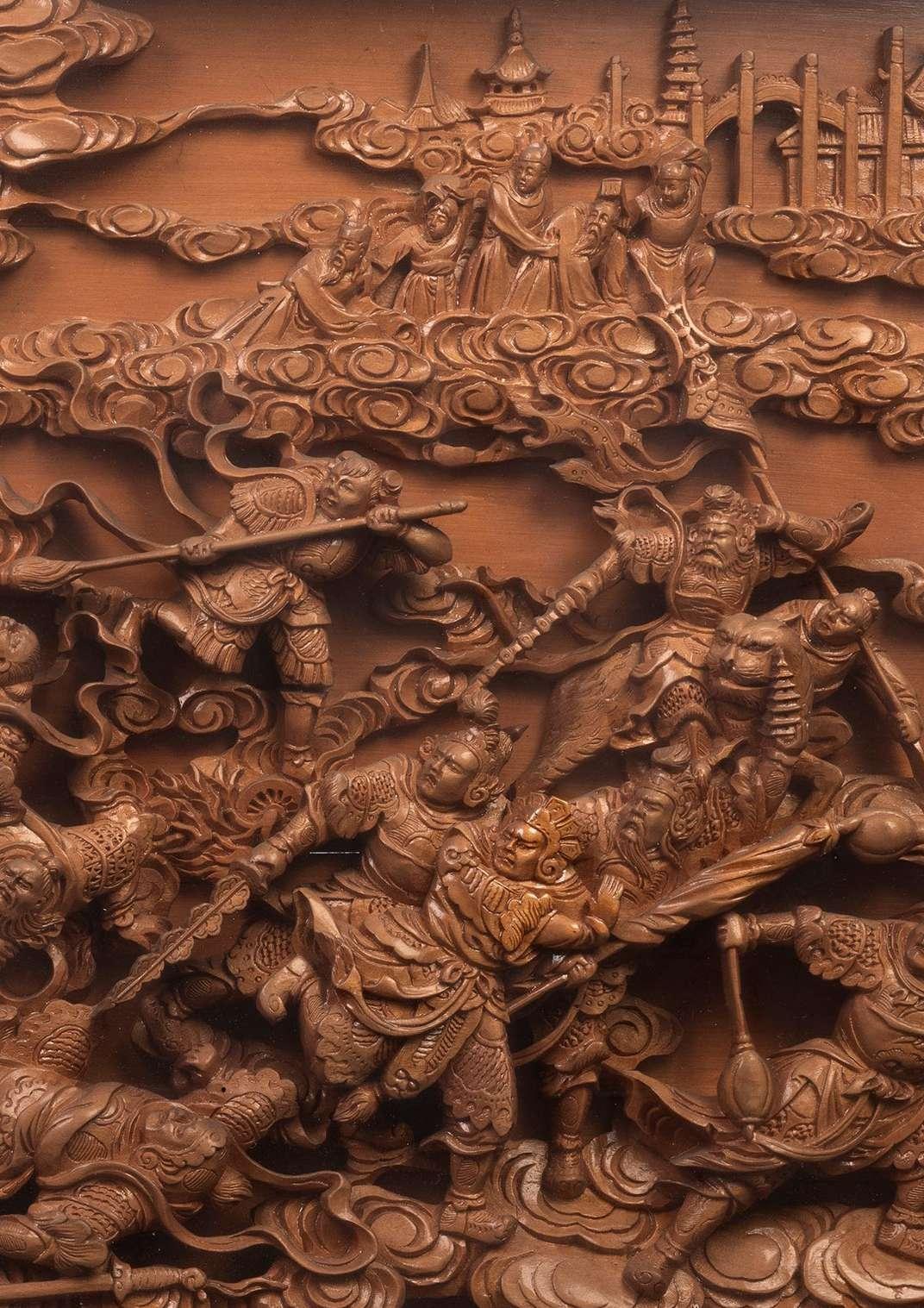
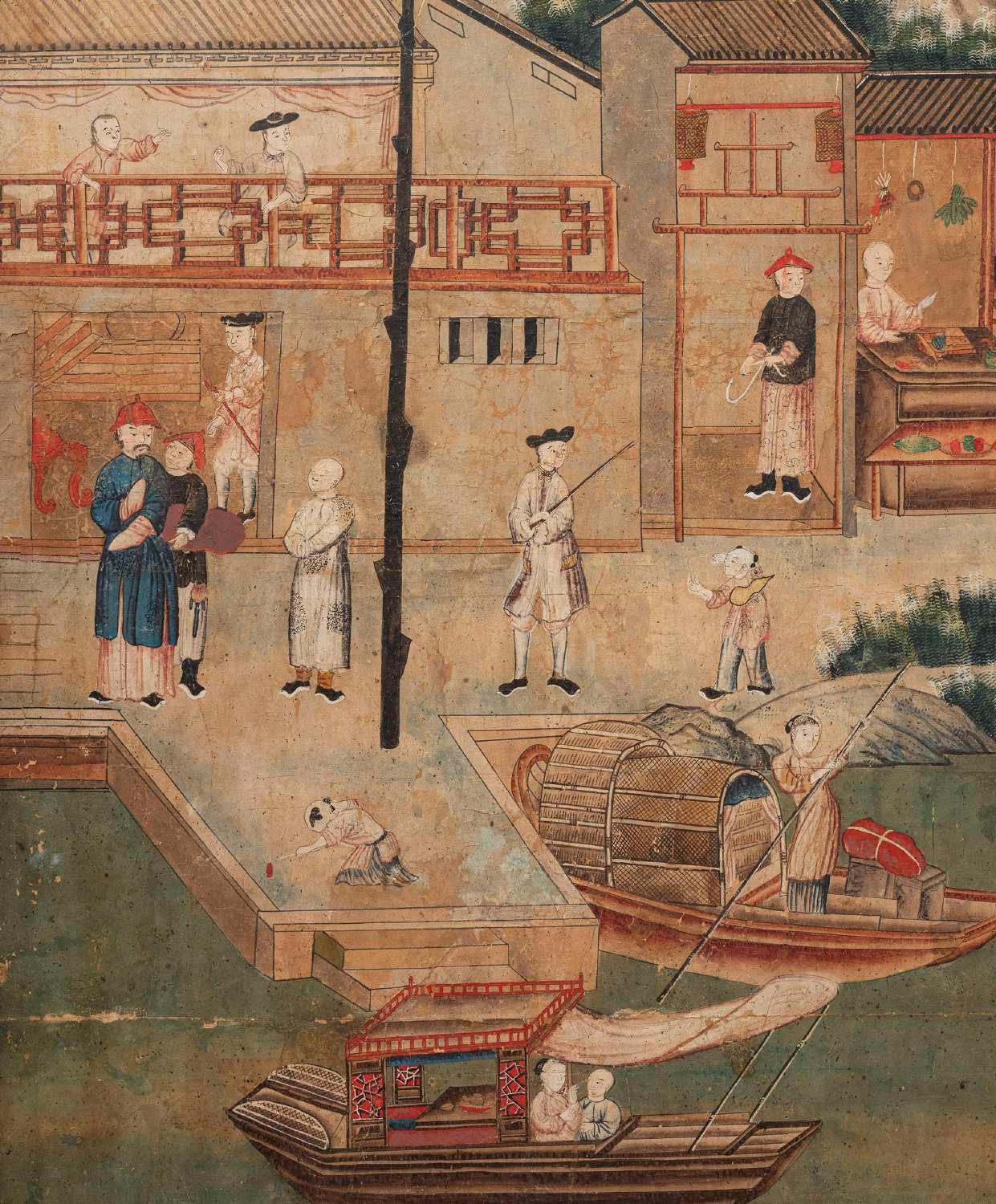
East to West - From Italian Homes
10 Dicembre 2025, Milano
With “East to West – From Italian Homes”, Marcopolo Asian Art presents a new auction format that celebrates this elegant, cultured, and profoundly Italian blend: an aesthetic journey across Asia, Europe, and the Mediterranean, through works of art and furnishings collected from the bourgeois residences of our country.
The auction will feature:
• objects in Japonisme, Chinoiserie, and the European Islamic style,
• furnishings and works linked to the Grand Tour,
• historic design and collectible modernism,
• decorative arts from both East and West, all selected with the same rigor we have always dedicated to Asian art.
